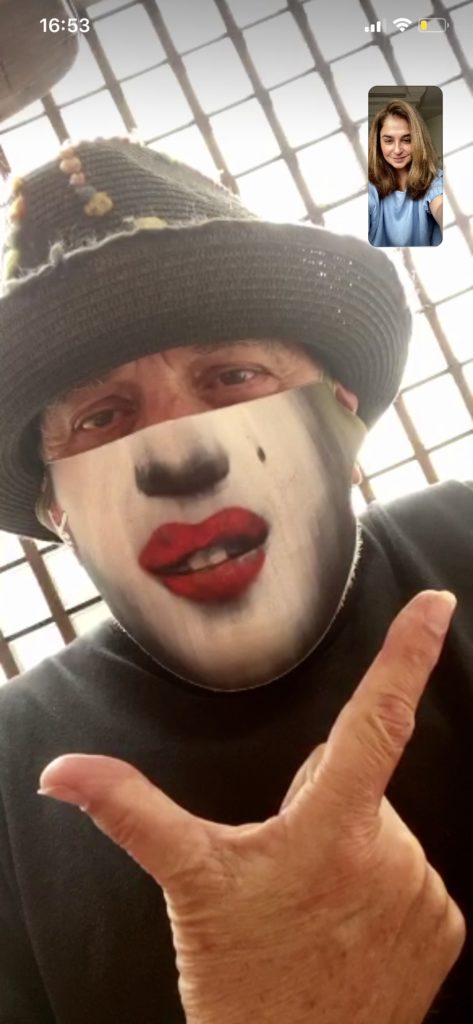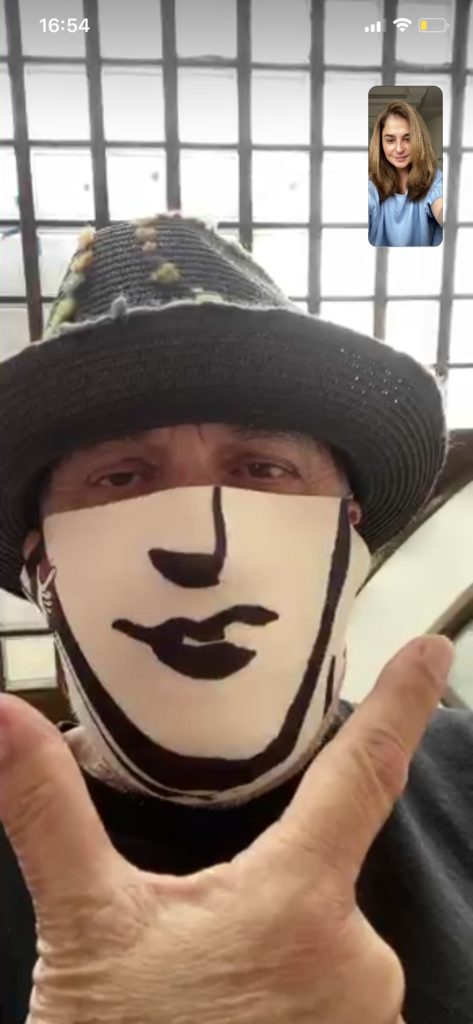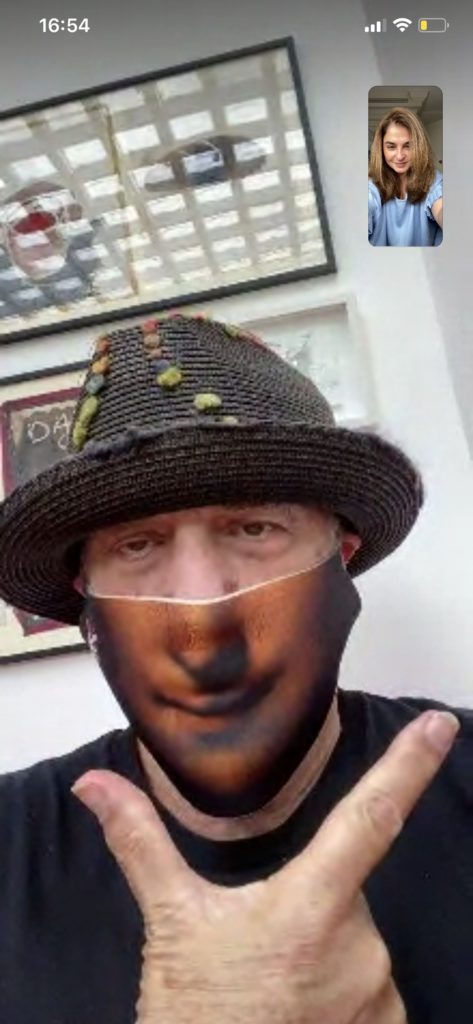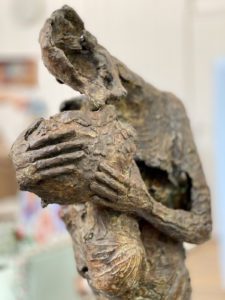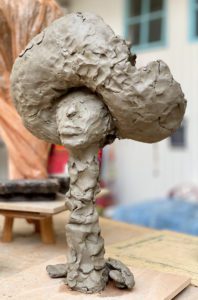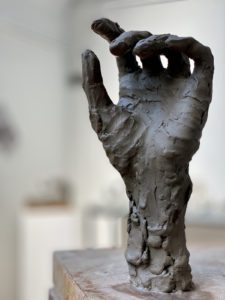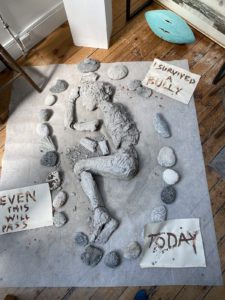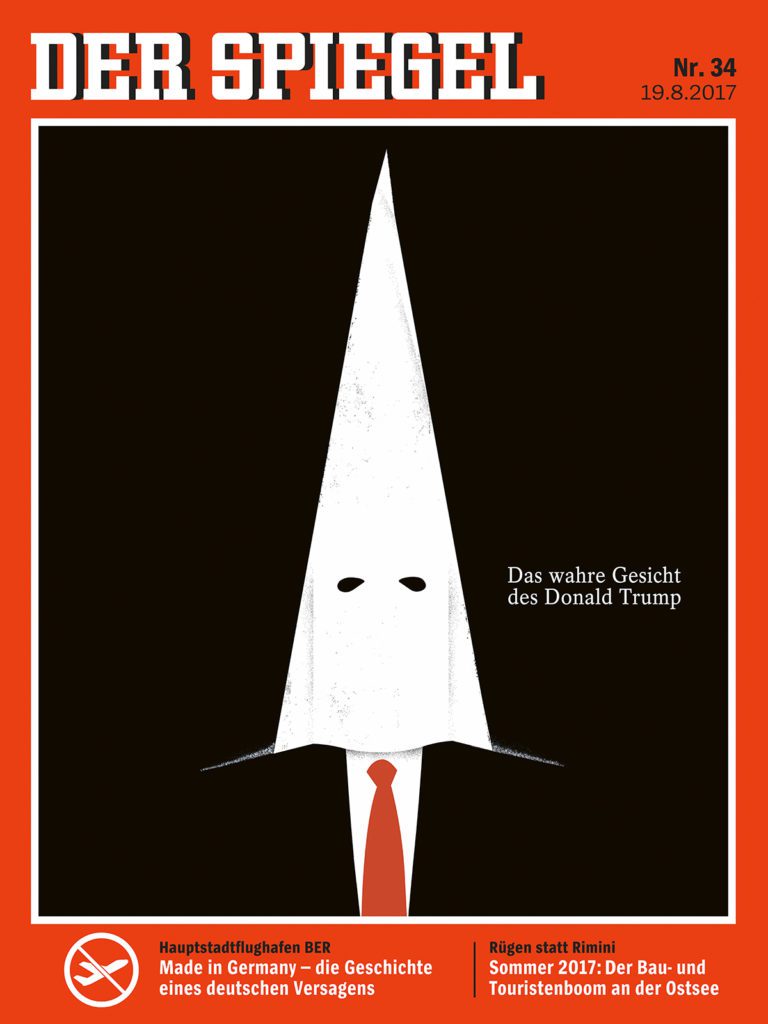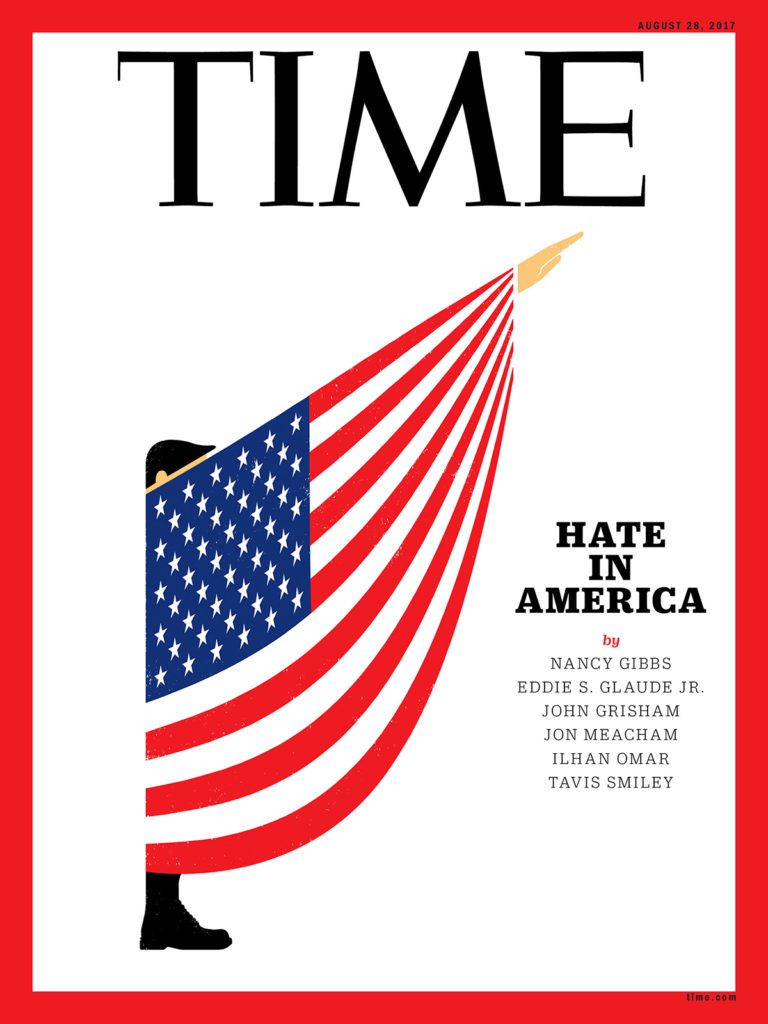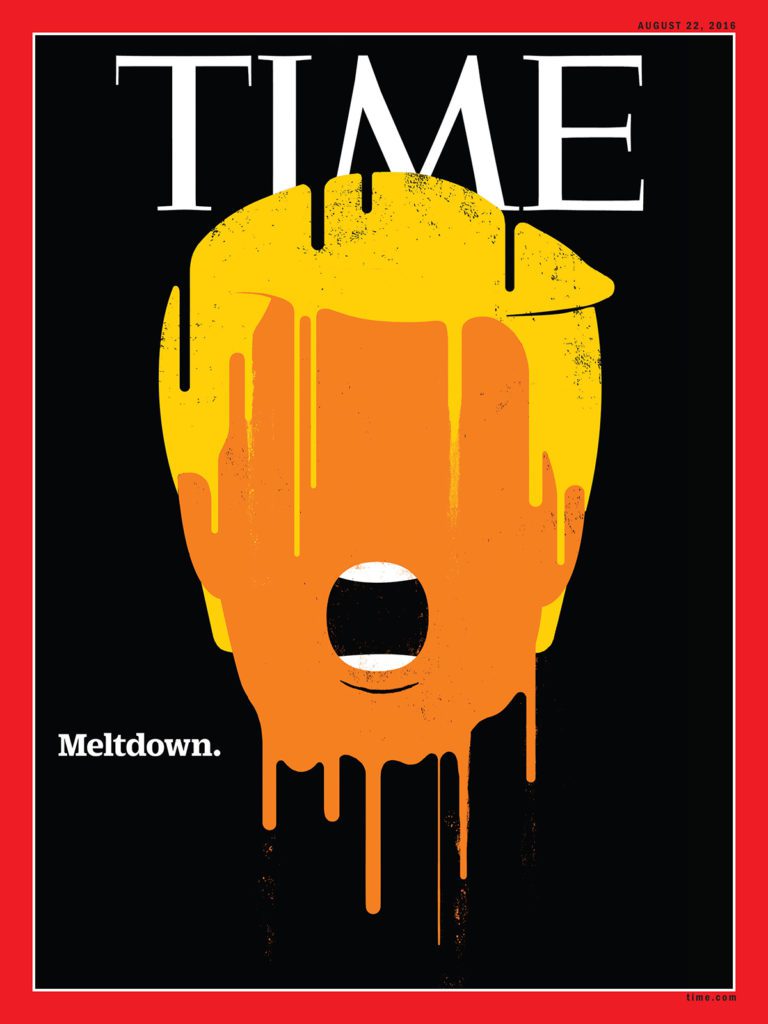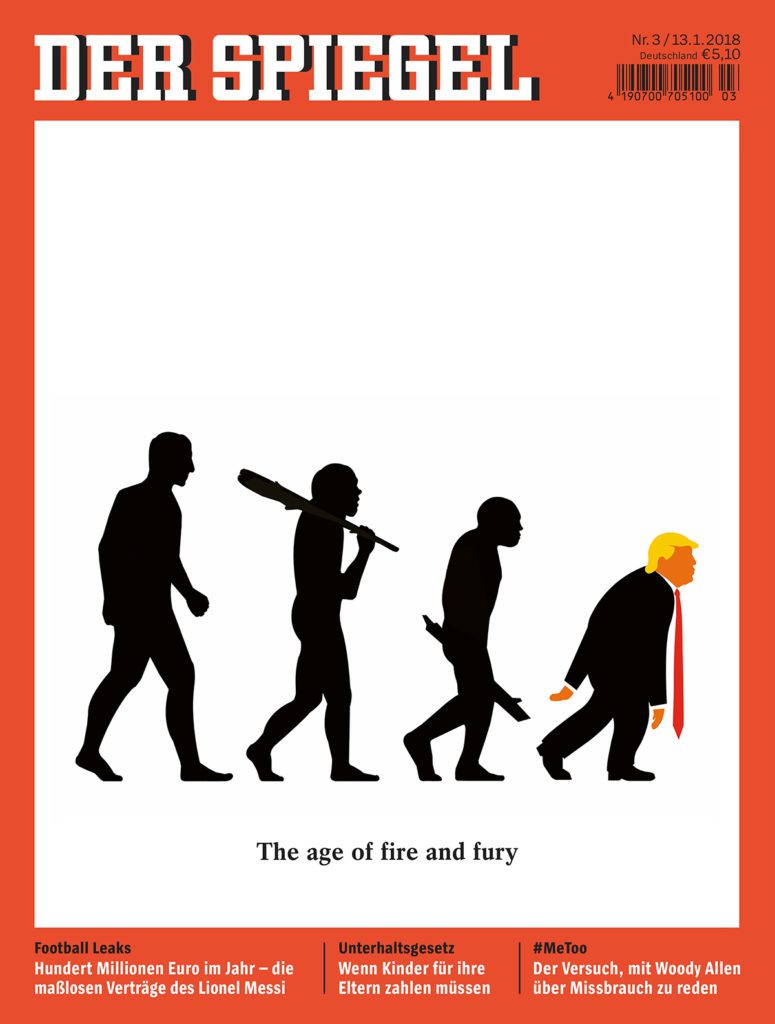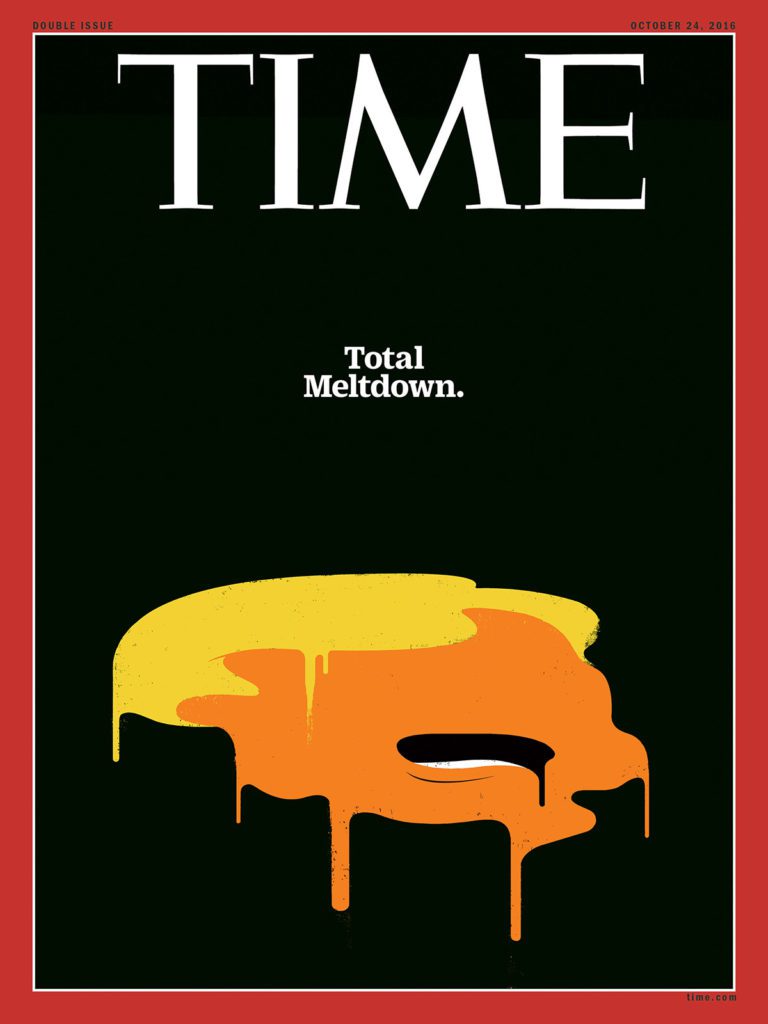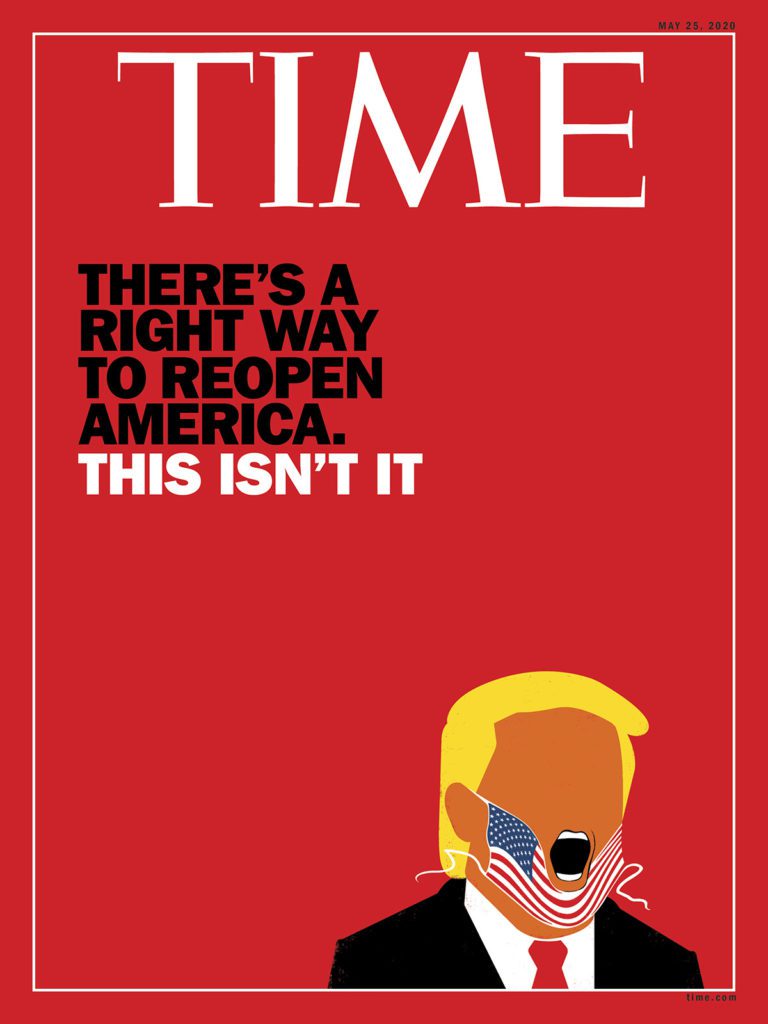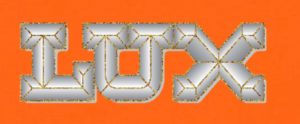
Some of the world’s greatest artists photographed in lockdown by Maryam Eisler
LUX Contributing Editor and artist Maryam Eisler has been photographing some of the world’s greatest artists over FaceTime and WhatsApp for LUX. As the project evolves, our online exhibition Confined Artists – Free Spirits: photographs from lockdown by Maryam Eisler will grow, accompanied by musings from the likes of Marina Abramovic, Larry Bell, George Condo, Eric Fischl, Ilya and Emilia Kabakov, Marilyn Minter, Shirin Neshat and Laurie Simmons. Below, LUX Editor-in-Chief Darius Sanai introduces Maryam’s brilliant and original oeuvre, and Maryam herself muses on her inspiration, after which we present her works in all their raw and un-retouched digital glory.
The lockdown around the world is having an unprecedented effect on every aspect of human life. Many people have lost their jobs or have seen their businesses imperilled. Others feel helpless as they see the suffering and sacrifices around them.
In such times, the raison d’etre of creativity and artistry comes under scrutiny: who can have time for anything unrelated to the clear and present danger caused to humankind by these strands of self-replicating RNA?
But creativity is part of what it is to be human. Somewhere in our DNA (itself a complex remake of the same nucleic acid that is coronavirus) is a program for the unique human desire and ability to create art, and appreciate aesthetic, for its own sake. Some of the greatest artistic creations in our history, from the temples of the Nile to Picasso’s Guernica, have emerged from horror and hardship. Artists cannot stop creating, even if the art world, that very contemporary construct, has temporarily stopped working.
When Maryam Eisler, one of our contributing editors, called me with an idea, a couple of weeks into lockdown, I knew it would be worth listening to. An artist and author, Maryam is the archetypal peripatetic global art world citizen: born in Iran, educated in France and the States, resident in London.
Maryam said she had started a project photographing her favourite artists as screenshots on FaceTime and WhatsApp. I said it would be an honour to run her project as an online exhibition, and also in the pages of our summer 2020 print edition. The project gained momentum, to what you see here today: some of the most celebrated artists in the world, captured in a casual moment, on a phone, and unedited. A true sign of our times. Over to you, Maryam.
Darius Sanai, Editor-in-Chief, LUX magazine
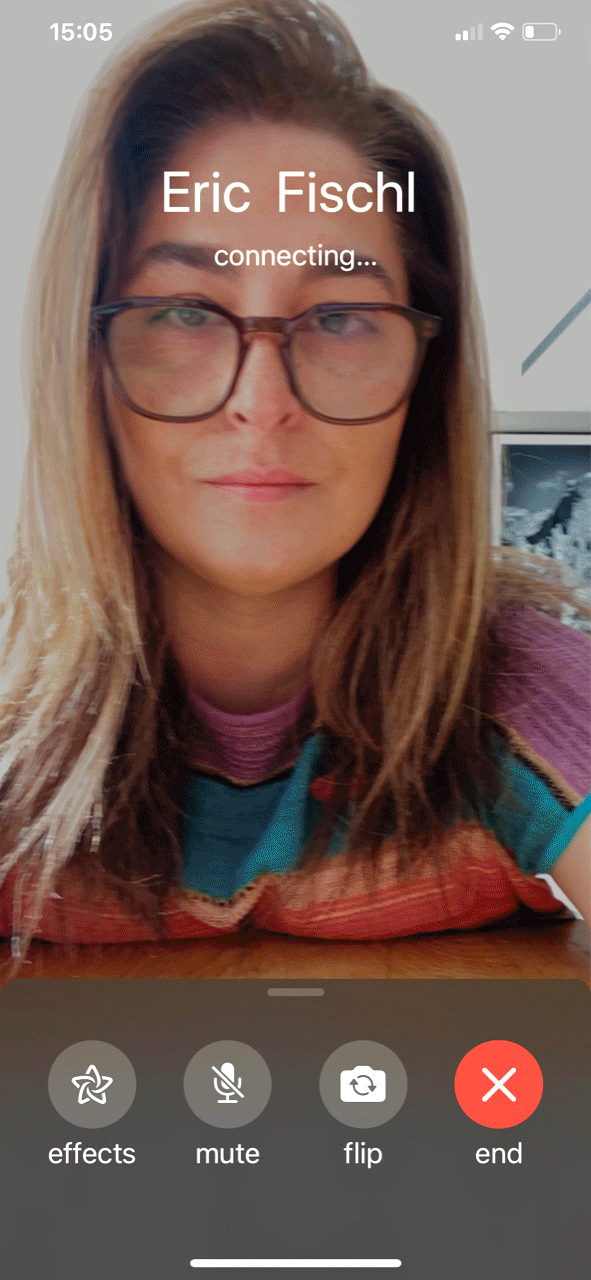
I woke up on April 1st 2020 to another Groundhog Day determined to initiate an original creative endeavour, out of confinement.
Art and photography are my greatest passions, so I decided to freeze-frame this epic moment in history, by inviting visual artists to share their thoughts and wisdom for a larger community of spirits, similarly confined in space and time, but not in mind.
Artists have always been visual philosophers and recorders of history. Today, more than ever, they have the potential to give heart and inspiration, where needed and desired.
As such, I have had the privilege to ‘virtually’ photograph these searching minds, presently bound by their private and intimate spaces. For this series of artist portraits, although limited physically by social distancing guidelines, I was aided by technology, and so I used FaceTime and WhatsApp to capture my subjects, in mind and in soul, with careful prior planning and dialogue – sometimes sharp, and at times blurry, bound by the realities of WiFi logistics. Intimate and searching moments, frozen in history.
This has been an emotional journey, given the extraordinary challenge humanity is facing. It has also been a personal journey of rediscovery, into what makes each one of us tick; what makes us rise in the morning and fall into slumber at night, and where we go, and what we do, in between. It is in times such as these that Malraux’s Human Condition and Sartre’s Existential Anguish take a whole new dimension of their own.
It is my hope, that these images and accompanying poetry, reveal very personal, delicate and emotional moments; honest and forthright, direct and inspiring, intermingled with the pain of sorrow borne by each one of us, for threats new and unforeseen. But most importantly, it is my sincere belief that these are messages of hope and renewal.
What seems to be a common thread in all of the interviews, is the desire for us all to come together, to seek a better self, and to make a better world. One depends on the other, and our futures on them both. Setting aside differences and individual prejudice is vital, if we are to survive this moment in history, and face the future challenges which no doubt await us.
Artists and activists, thinkers and doers, we can each make our contributions by widening the streams of positive thinking and action. Life is complicated enough, let’s try for a little cheer with a creative bent.
As my favourite poet and song writer Leonard Cohen wrote: ‘There’s a crack in everything, that’s how the light gets in’.
And the light will get in. Of that, I have no doubt.
Maryam Eisler
London, April 10, 2020
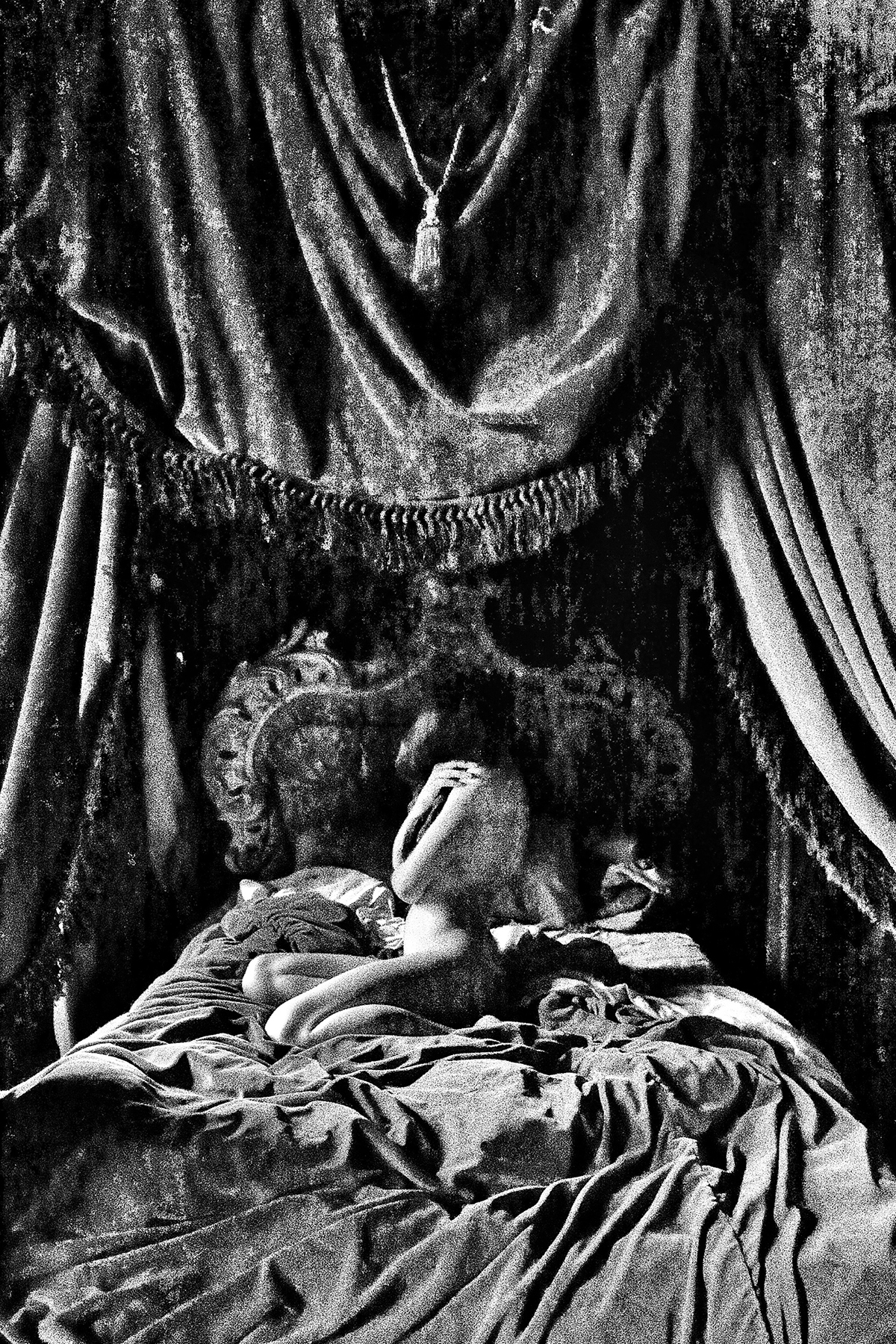
A closing letter from the artist, Maryam Eisler:
‘Confined Artists – Free Spirits : Photographs from Lockdown’ : 163 artists; 163 FaceTime portraits and diary entries; 90 days in duration; 48 cities and 25 countries. This is the backdrop to the daily dialogue I have had with the artists in question, between April 1, 2020 and July 1, across Europe and Africa, the US and South America, Asia and the Middle East. The journey has now come to an end, at a time when humanity has had no choice but to stop and take a pause, as we all fight the same invisible force – each one us, with a different perspective.
This has been an epic saga for me personally, and I would like to express my sincere thanks to LUX magazine who have generously given me the digital platform to conduct and share this experience with you all. Most importantly, I would like to extend my gratitude to all 163 artists who accepted to be part of this seminal voyage. It has been a privilege to be on the receiving end of their inner thoughts and raw emotions. Thanks also to all the wonderful friends who helped me open doors and hearts, across the globe. Personally, I am indebted to the process itself, as it gave me purpose, routine and creative intent, at a time of social and political uncertainty, a time of dis- ease and existential anguish.
History has turned on its head, in the most unexpected of ways, entirely unimaginable a year, or even a decade ago. All landscapes, from the medical to the political, from the economic to the social and the philosophical, are being reshaped, as we sit, locked away in mind and space. As dolphins have returned in throngs to the canals in Venice, reclaiming their original habitat, and unprecedented bird songs have delighted us all at dawn, with their potent symphony, dark sounds of sirens and pounding chants of anger and dismay demanding social change have inversely and simultaneously filled our streets and public spaces.
Covid-19 has been the invisible catalyst to this turmoil, but with unexpected twists. Events in the last month have unfurled banners and given platform to long-festering issues leading to mass political and social movements across the globe. The power of pent-up emotions, triggered by long endured injustices, have burst the damn of indifference. One man’s cruel death witnessed by social media, has turned America on its axis, and made common cause with worldwide eructation. The irony here is that nature’s virus, no doubt a direct result of man’s own greed, has shamelessly attacked the human respiratory system. Choking from nature and choking from injustice have gradually morphed into one, under a worldwide banner of “I can’t breathe”.
Who would have guessed that my attempt at mood-capture, through artistic expression, would have dovetailed into such potent dialogue? There is irony and paradox, visibly shaming us all. We are indeed all made of the same clay, yet walls of steel have self-erected between us throughout history. Now is the time to take a hammer to such divides.
Nature has sent us, over time, long signalled warnings, and we have consciously chosen to be blind to their dangers. It is time to wake up and draw inspiration from humanity’s newfound heart beat. We must listen to it, feel it and question it. Most importantly, we must take charge and agitate for positive change.
As to art, well, it has never determined the course of history, but it can oil its thinking process. It is therefore supremely comforting to see how art and history have once again come together at this crucial moment, to project a different kind of light onto the dark shadows that contemporary politics, race relations, social tribalism and economic injustice have cast over us all.
Maryam Eisler
Written in confinement,
London,
July 1, 2020
‘Bird chant at dawn, April 20, 2020’ by Maryam Eisler
Opposite image: ‘Solipsistic Embrace’, 2020 by Maryam Eisler
CONFINED ARTISTS – FREE SPIRITS
An exhibition created by Maryam Eisler and hosted by LUX magazine
Portraits are presented chronologically, in the format of a lockdown diary
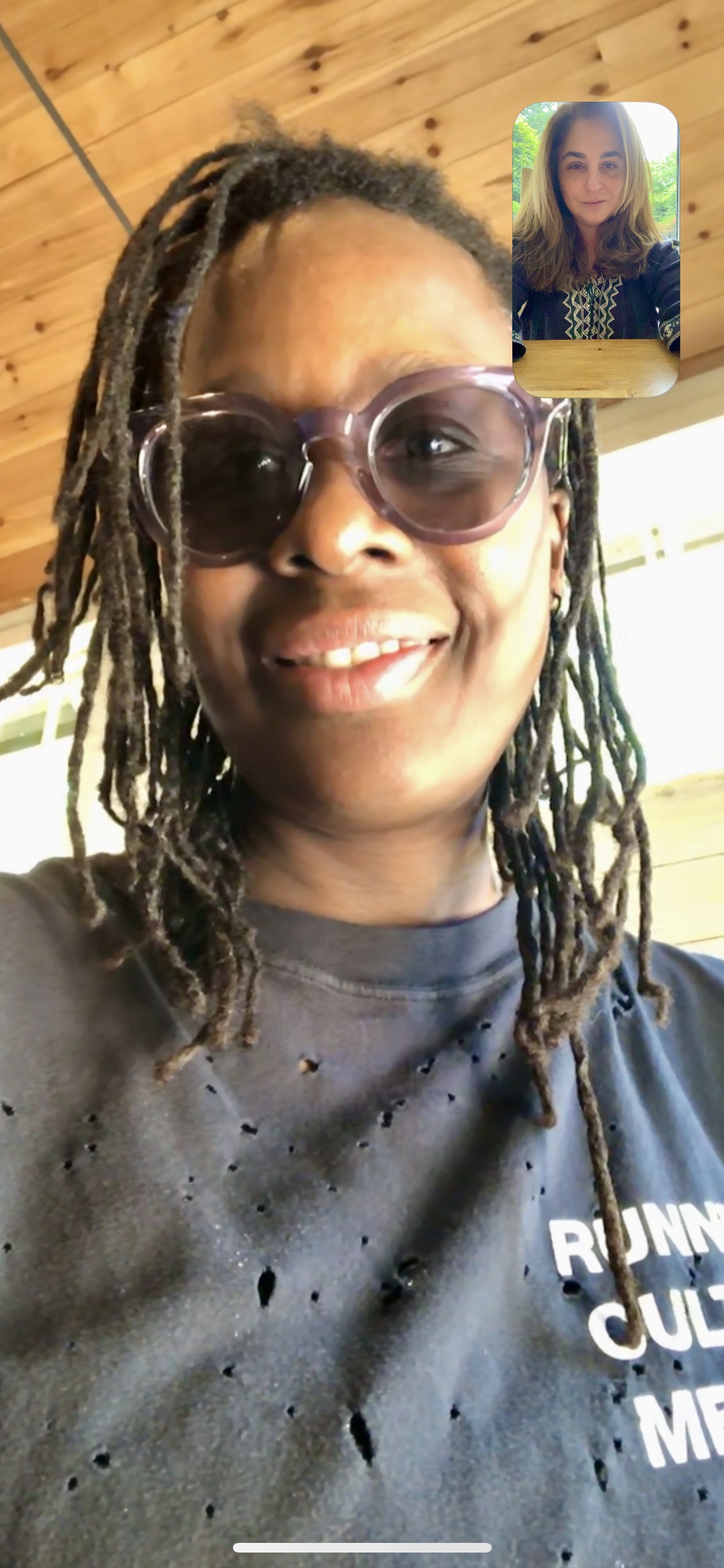
Mickalene Thomas
June 30, Connecticut, Home/Studio
Breath is the bridge that connects life to consciousness, and unites your body to your thoughts……Thich Nhat Hanh
Mama, I Can’t Breathe….George Floyd uttered politely, as he was being murdered, 9 mins before his traumatic death. I’m trying to make sense of this incident during this respiratory viral pandemic – COVID-19 -, a disease that disrupts our breathing. It’s no coincidence that a pandemic which has forced the four corners of the world to globally shelter in place for months, has erupted and united many into protest.
Black Lives have always mattered. They mattered when Black mothers cried for their black and brown babies who were shot down unjustly by police, months before COVID-19. Many of these Black mothers, aunts, sisters, cousins, wives, lead the fight, but they are still invisible, as they are the most disregarded people in society. Say her damn name!
Breonna Taylor
Rekia Boyd
Kayla Moore
Alexia Christian
Mya Hall
Miriam Carey
Gabriella Nevarez
Shantel Davis
Melissa Williams
LaTanya Haggerty
Kendra James
Sandra Bland
Shelly Frey
Kathryn Johnston
Danette Daniels
Tanisha Anderson
Michelle Cusseaux
Pearlie Golden
She Reese Francis
Kyla Moore
Natasha McKenna
She émue Proctor
Kyam Livingston
Aiyana Stanley-Jones
Tarika Wilson
Meagan Hockaday
Janis has Fonville
Yvette Smith
Rosann Miller
Sonji Taylor
… and so many more.
Other deaths uttered the same powerful words “I CAN’T BREATHE” whilst under blatant evil hands. The power of Floyd’s death lies in its universal timing; we are all globally quarantined, both metaphorically and literally; and, we are forced to change our habits and our breathing- (space, life, rhythm). The rhythm of the human breath needs to be looked at more profoundly – as these words resonate and penetrate our soul.
So now we think about normalcy. The world has changed. We all have changed. What is the new normal?
I’m filled with ambiguous emotions like most people today. Now, it’s time to create, to reflect and to plan for the uncertain future.
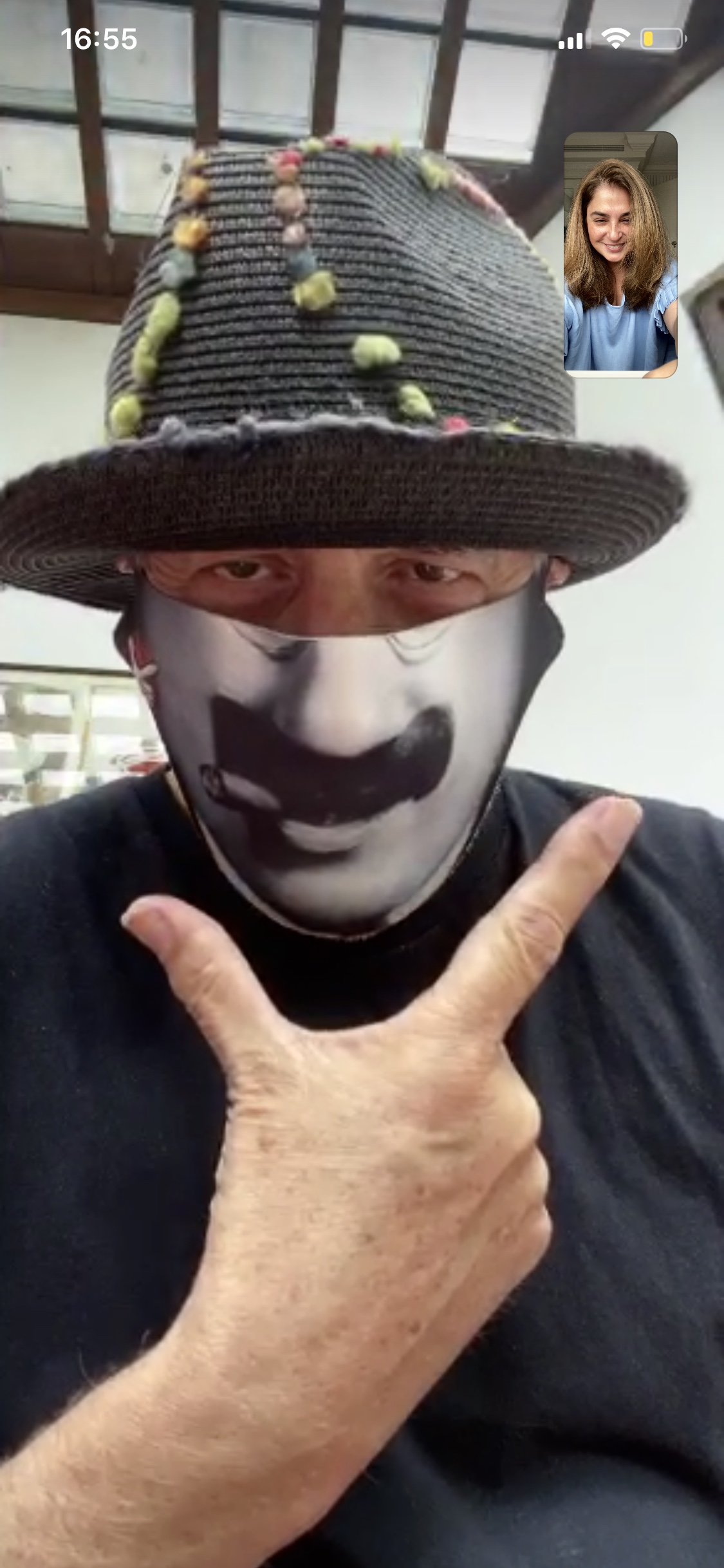
Ron Arad
June 30, London, Studio
From the first days of the lockdown we were sucked into a project we started: Smile 4 Carers. The idea was to raise money for frontline workers and make people smile by putting art (bottom part of portraits opposite & below) on face covers. Check out Smile 4 carers on Amazon, Instagram and Facebook.#smile4carers #ronarad

John Stezaker
June 30, St. Leonards-on-Sea, East Sussex, England, Home
“The disaster takes care of everything”
(Lockdown)…..frees us from the obligation to act or think.
What is shocking to me is how little my life has been changed by lockdown and to realise how much of my life is normally spent inside and on my own.
Looking out of the window of my studio is like any other summer’s day except that the sky is free of vapour trails and the sea is sparkling and unusually clear.
“The disaster ruins everything, all the while leaving everything intact.”
Disaster is always outside, beyond, that which is most separate.
Disaster addresses us from a future which it threatens to eliminate.
“There is no future for the disaster just as there is no time and place for its accomplishment.”
“To think the disaster is to have no longer any future in which to think it.”
“The disaster is its imminence”.
The beaches are starting to fill again as lockdown is showing signs of being eased. Children are playing in the rockpools. Adults are picnicking on the beach. There are swimmers out at sea.
“We are passive with respect to a disaster, but the disaster is perhaps passivity.”
Vast murmurations of herring gulls are forming a vortex out at sea. Perhaps they are rediscovering their instinctual collectivity out there within the rhythms of the oceans now that individual scavenging has become so limited inland.
As people venture out they seem unusually aware of the natural beauties around them. The focus of their camera phones seems to have momentarily shifted from themselves to the world around them.
All quotes from Maurice Blanchot’s “Writing of the Disaster”
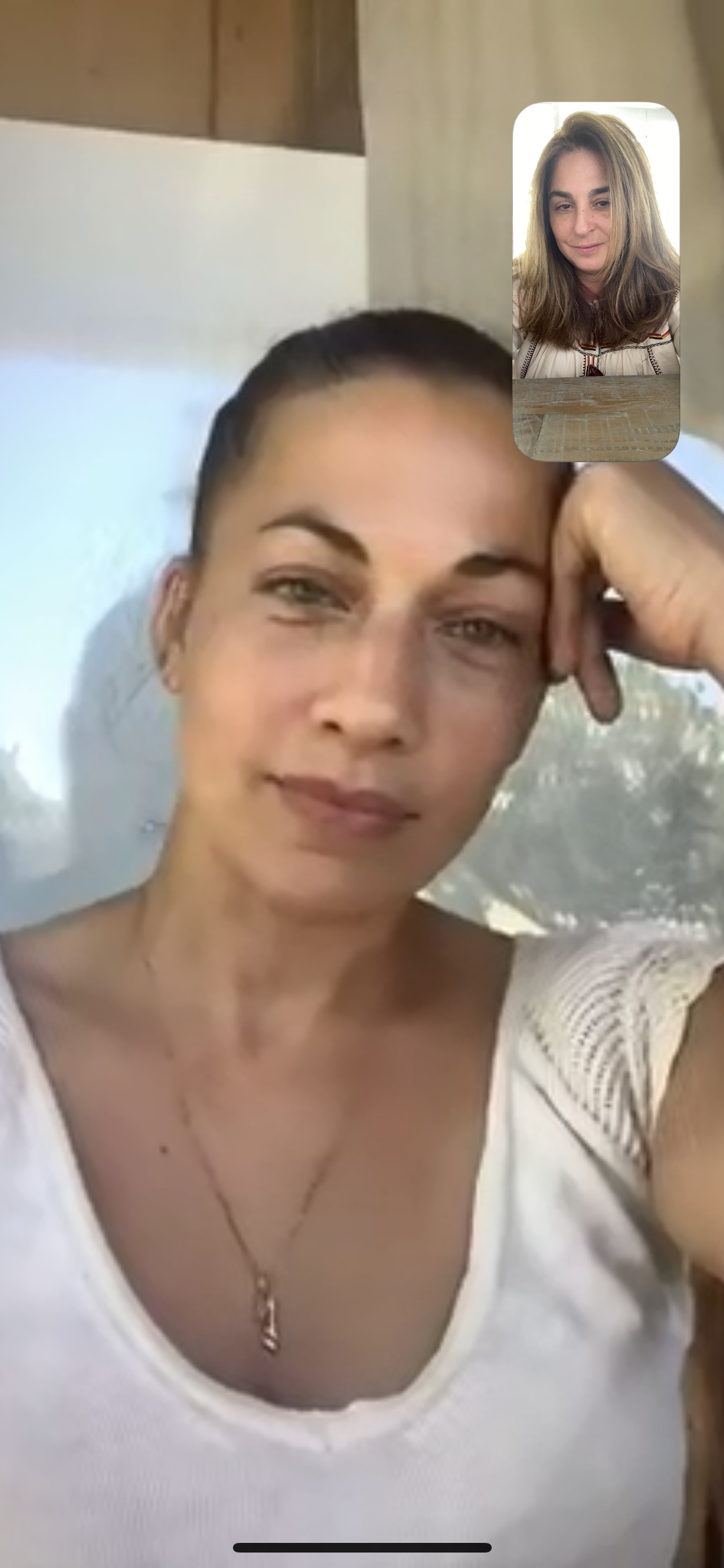
Aria Isadora
June 30, Brooklyn, NY, Home
Our lives changed very quickly with the Coronavirus. There had been a quiet murmur from overseas; next, I was not working and instead, homeschooling my three children. We embraced it as best we could. The daily goal was to stay healthy and have fun. It was the break I had actually always wanted, yet it came with a completely different set of guidelines and ramifications. I had started a project connected to the current conditions and it was well underway; there was more murmur and more chatter…only this time, protests were forming, and just like that, things changed again.
Perhaps the Covid-19 pandemic has been a perfect storm. Had people not been unemployed, restaurants not been closed, travel not been at a standstill and all available content consumed, I do not think the current movement in support of Black Lives would have gained the same momentum it currently has. This is a movement that has always been here, but it has finally managed to get everyone’s attention and start demanding and creating change. If I was not a photographer, I would still be marching; I would still be on the front lines. My ancestors were enslaved in this country, and this movement is something I have believed in my whole life.
The first day of the protests, my children were very concerned. They are scared of the police, and they were confused as to why I was deciding it was fine to participate in protests and be surrounded by people after months of lockdown, designed for their safety. I knew there were risks for me, and for them, but I also felt it was a moment for them to learn, that even when there is risk involved, you can feel stronger than fear, and that you have to fight for what is right and for what you believe in. Within a few days, we all fell into a new rhythm of me going out and shooting for hours on end. They were incredibly supportive of my documenting the protests. It gave them strength and confidence, and in turn that was what I needed to keep going.
The day I captured this particular photo (below), the protests had already grown in numbers and in momentum. It was the first time I noticed a big presence of press photographers. I left the George Floyd memorial in Brooklyn and walked over the Brooklyn Bridge, so that I would be able to photograph the protestors as they were approaching Manhattan. You can have ideas for photos, but in protests, you have zero control over the outcome. You are there to document what is happening, in the moment. Your job is to tell that story, not your own. The majority of the press photographers seemed to retreat further to the Manhattan side of the bridge and set up there. I stayed and waited because I knew I wanted to photograph them from the beginning, and I also wanted to march with them across the bridge. The brothers from the Alpha Phi Alpha fraternity led the way, and their powerful singing and chanting carried us and moved us over the bridge, almost as swiftly as their feet did. I can still remember their voices as well as the feeling of walking backwards on the wooden bridge planks. There were about five thousand people marching behind them, all coming from the memorial. That moment is when I felt the strength and the power of the people.

Brooklyn
6.04.20
Brothers from Alpha Phi Alpha leading the way from the George Floyd memorial to Manhattan, here on Brooklyn Bridge. #BlackLivesMatter
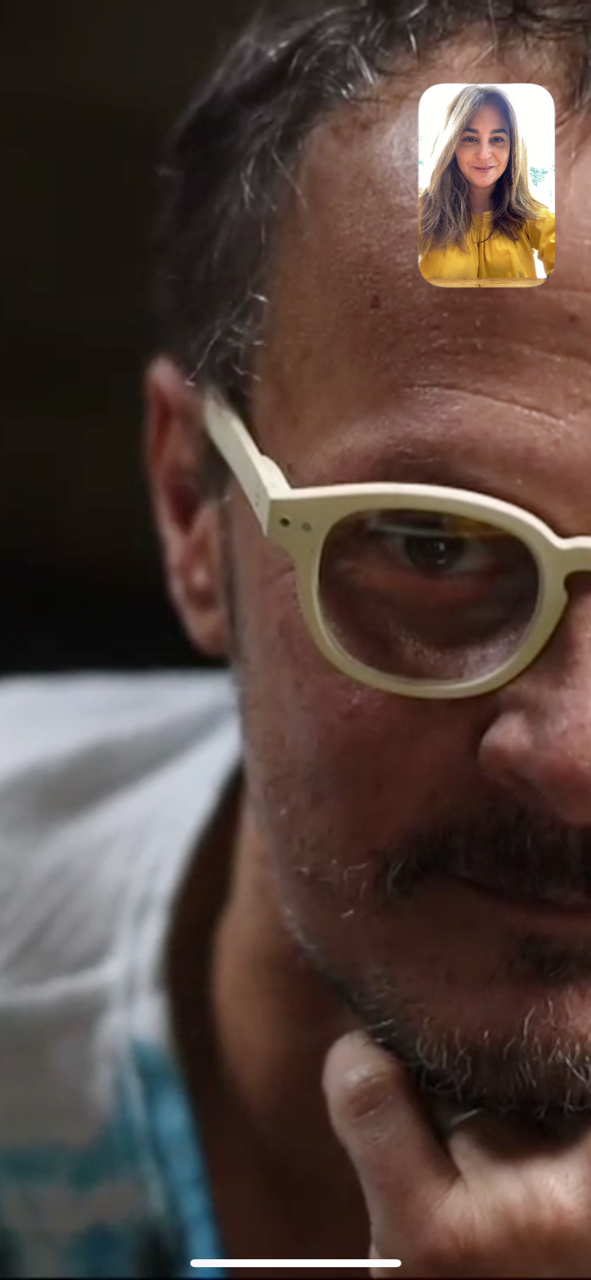
Jonathan Yeo
June 30, London, Home
Personally, lockdown has affected my work in unexpected ways, much of it positive. This sudden pause – from the endless spiral of meetings, repetitive travel, the circus of exhibitions and openings, catalogues, talks, interviews – has freed up time for exploring new ideas and making things. I’m conscious of being far more risk- averse, and afraid to experiment with new ideas when exhibition deadlines are looming. Freedom from such constraints will hopefully have encouraged many artists to take greater risks in a free and undemanding environment.
I have always painted from photographs as well as from life. Since I’ve been unable to see them in the flesh, I’ve learned to paint whilst I talk to my sitters on digital live platforms. I can observe them animated and alive, and it is interesting for me to look at the movement on their faces, in a way that describes their personalities best. Going forward, I will adopt and keep this new approach in my painter’s toolkit, no doubt. I’ve also spent more time looking at and experimenting with new technologies, in particular VR and machine learning.
On a macro level, the times have afforded us all with extraordinary, yet unevenly distributed individual experiences. No-one asked for this nor expected it. For some, it has come as a welcome treat. I feel incredibly lucky to have had a garden and my teenage daughters here during this time; I can only imagine how hard and demanding it must have been on parents who had to home school their younger children in constrained spaces.
Over the last couple of years, I’d been working on a project around the risks of data abuse and facial recognition. For a while, the world has been set against a background of polarised politics and extremism, exacerbated by data and social media manipulation, and so the recent protests did not come as a total surprise, especially after such a prolonged period of separation from normal life. It still feels early to make long term assumptions, but what matters is the underlying message behind it all, and hopefully, lasting positive change will come out of the protests.
There’s a great deal more to play out before normal life can resume, but I’m optimistic that in the long term, this will be remembered as a time of extraordinary innovation, creativity and social change.
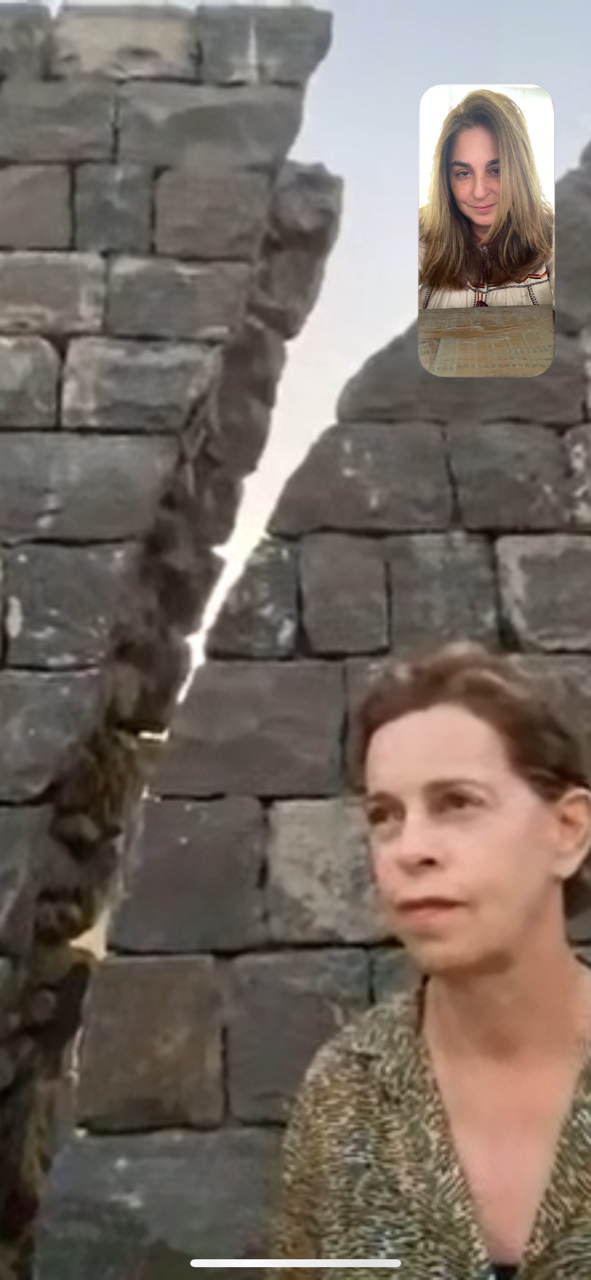
Michal Rovner
June 30, Old Road to Jerusalem, Israel, Home
At the end of February I was invited to a talk with Hans Ulrich Olbrist at Ivory Press in Madrid. At lunch, I was asked, ‘Where will you go next?’
‘In a few days I fly to Rome,’ I said, ‘for a talk with the director of the Maxi, then to New York, and then to the Venice biennale.’
Norman Foster said, ‘Michal, you should not go to Rome now!’
Elena Foster said, ‘I think there will be a pandemic.’
I told Carmen Gimenez that I have extra masks and gloves.
Carmen said, ‘There is no Corona in Spain.’
‘I’ll take it, just in case,’ I said.
I sent a message to Germano Chelant asking how it was in Milano. He said he was at the Guggenheim Bilbao and everything was fine.
A few days later, in Israel I had to be isolated because Corona burst out across Spain. Flights to Italy from Israel were canceled, Flights to NY were canceled.
Just before the lockdown, wild dogs from the desert who were in danger came to stay with me. That night a major storm arrived, and seven old cypress trees fell down. I spent the days watching the field changing. At night I walk in the field with my wild dogs. I feel in their movements that they are not aware of the lockdown, but I sense the density and weight of many undetected details all over.
At the end of April, in a hospital in Milano, Germano Chelant died from Covid-19.
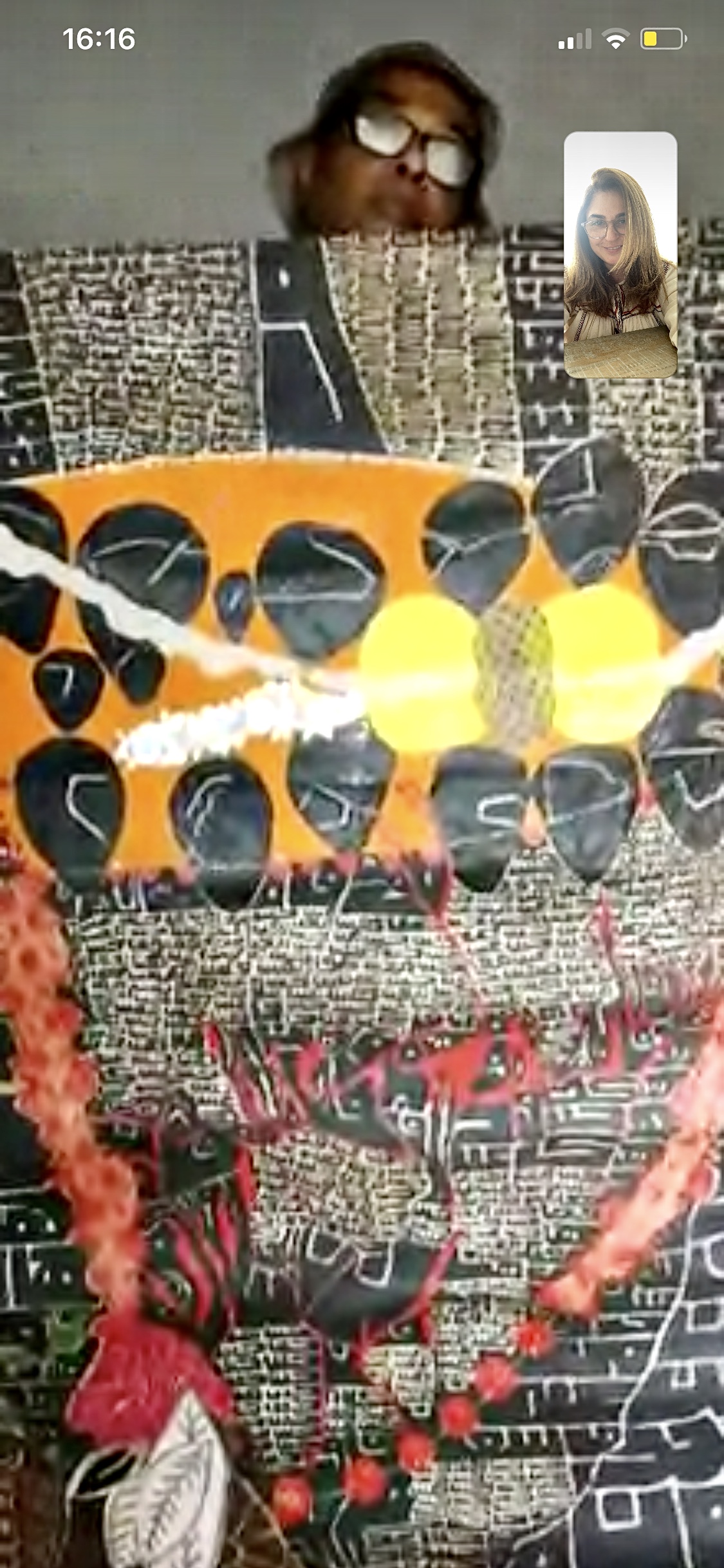
Fathi Hassan
June 28, Edinburgh, Scotland, Studio
THE DESERT
Below the humid clouds of the desert lies a silent sweeping of sand, and this is what I see.
Names. Names that have been carved out by the whispering of sacred words. Many people may see them as merely words and letters, but it is not so for me. They are pointers to the place where the subconscious flowers tear at rationality; they embroider and nurture the human heart. A strange and wonderful gift, as mysterious as the desire for motherhood, guides the hand in an echoing weave, stitch after stitch. A name written and adorned becomes a beautiful rose bejewelled with saintly dreamers who do whatever they can for us to erase pain and anger, and transform our insecurities and fears into joy and love. Above the rigid demands of the intellect, there is intuition, which allows us to become forgiving and to see the infinite in everything. It can take us to the unreachable, where dreams are timeless. Bright stars and the umbilical moon wait to gather us up. Our names are that which make us unique. They are the first sounds we hear, a voice calling to us by which we know who we are. It is time to extinguish rancour and to courageously step forward to where love, hidden and eternal, waits. Beyond our name, nothing must belong to us, and we must belong to nothing.
Fathi Hassan 2020
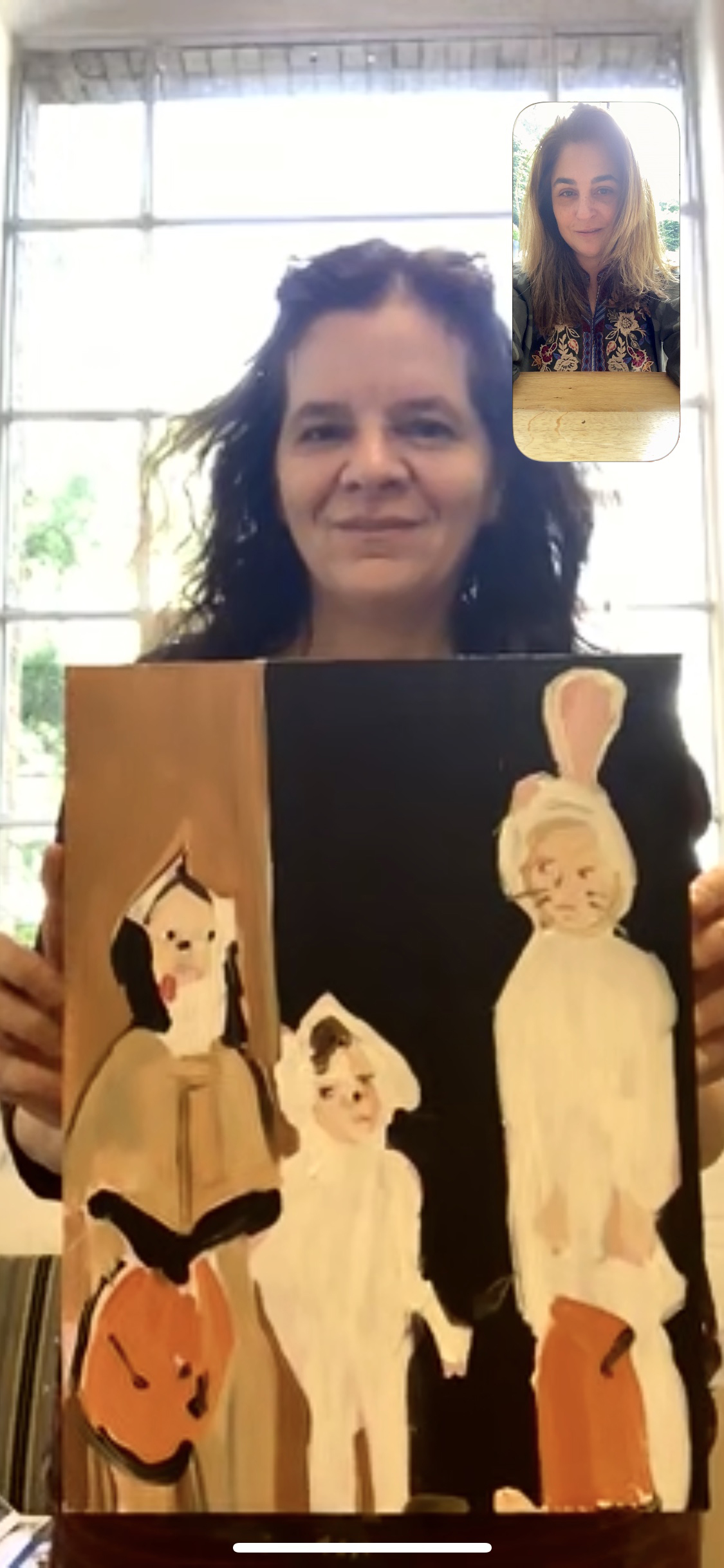
Chantal Joffe
June 28, London, Studio
Before lockdown I had been working on a group of paintings of my Mum, some of her after her cataract operation and so on, but during lockdown when I could only see her in her doorway, it struck me that I would like to paint her as she had been at different periods in her life. This painting (opposite) is me and my two older sisters wearing Halloween costumes that she had sewn for us in the early 70s. It was good to remember her as a woman so full of energy and love that she would sew these for us whilst doing a linguistics MA at night; it was also a good distraction from lockdown itself to travel through time in my paintings.
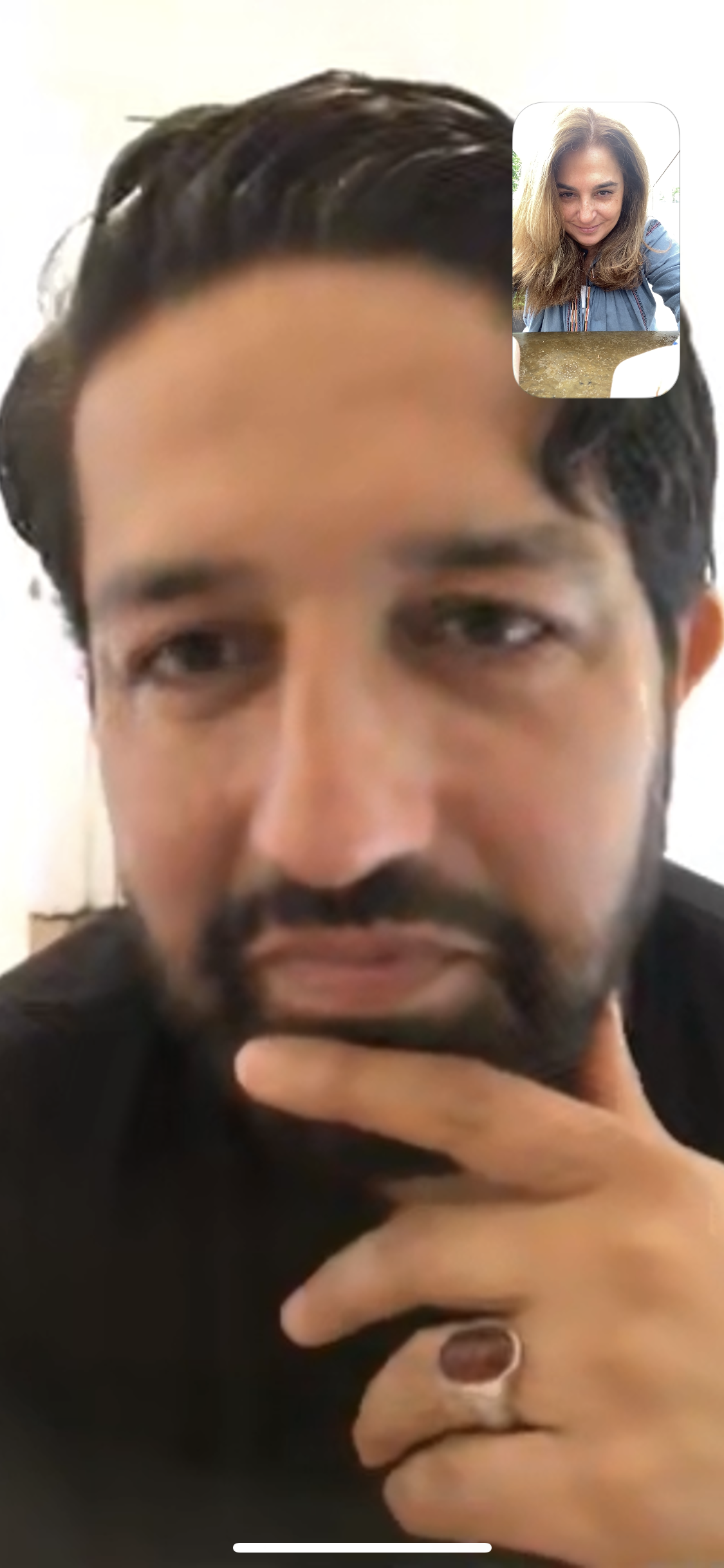
Osman Yousefzada
June 28, London, Home
I am still Black!
Since coming of age in the 90s, and then moving to London, I searched for the migrants, in their post-colonial manifestations. They inhabited the capital city of the once Great Empire. I looked for representations of myself in these People of Colour. On the streets, and in the pavilions of pride – the outskirts of the park, where there were segregated tents – POC or sometimes they called it World Music. Here, Chromatic bodies collided. These were our spaces, where the beats of Hip Hop, Reggae, Rai and Bhangra seamlessly fused into the torrent of vibrations of The Other and their admirers.
This was a different colour, from the migrant working classes in the ghetto, who looked inwards for safety. These were the people I had grown up with, who came to build a new life, sacrificing themselves, so that their offspring could jump into a better social and economic strata, as immigration stories go. Some who came, like my parents who couldn’t read or write, hoped their children would be able to join letters to form words, that they would cement their understanding from right and wrong, and learn the codes. As illiterates, they felt unworthy, so they kept their necks bowed down. This sacrificial turbo boost, would normally take a generation or two to come forward, but with their sweat, blood and hard work came insults, and spit, and broken bones, and deaths that white fascists, their former masters rained upon them. In case they forgot who they were. Some became the Model Minority, and some just sat at the bottom, looking up at the necklace of injustice, that grew heavier around their neck.
In these pavilions of pride, resided the fruits of former natives. I had heard stories from elder siblings, cousins and uncles, of when Malcolm X came to visit, and also when Mohammed Ali visited them again and again in Birmingham, standing next to them in the mosque; this wasn’t Birmingham Alabama. This was Birmingham, England. For some reason, the center of Great Britain – a city of a thousand trades, had attracted these luminaries and princes so their voices could be heard, not only by the Afro Caribbeans, but also by the South Asian diaspora. All lived side by side, as the underclass. From here, they united, and fought together as BLACK, under banners of the UNITED BLACK YOUTH LEAGUE, and various iterations of Political BLACK, along with their inspirational newsprints. They fought together on racism, equality, pay, immigration, housing, education, and the opening of opportunities to those who had been former subjects. The BLACK art movement was a united front against racism by Asian and Afro-Caribbean artists, culminating in the groundbreaking show at the Hayward Gallery called ‘The Other Story’.
Inadvertently, the tried and tested manoeuvres of divide rule came to play, when the government tried to encourage integration by handing out money. Separate cheques for each group. Separate pots for the Afro-Carribbeans, the Africans, the Indians, the Pakistanis, and the Bangladeshis. You each had your own pot, and separately, the noise you played wasn’t as loud as when you played together. I am still Black, and that is the colour of my politics.
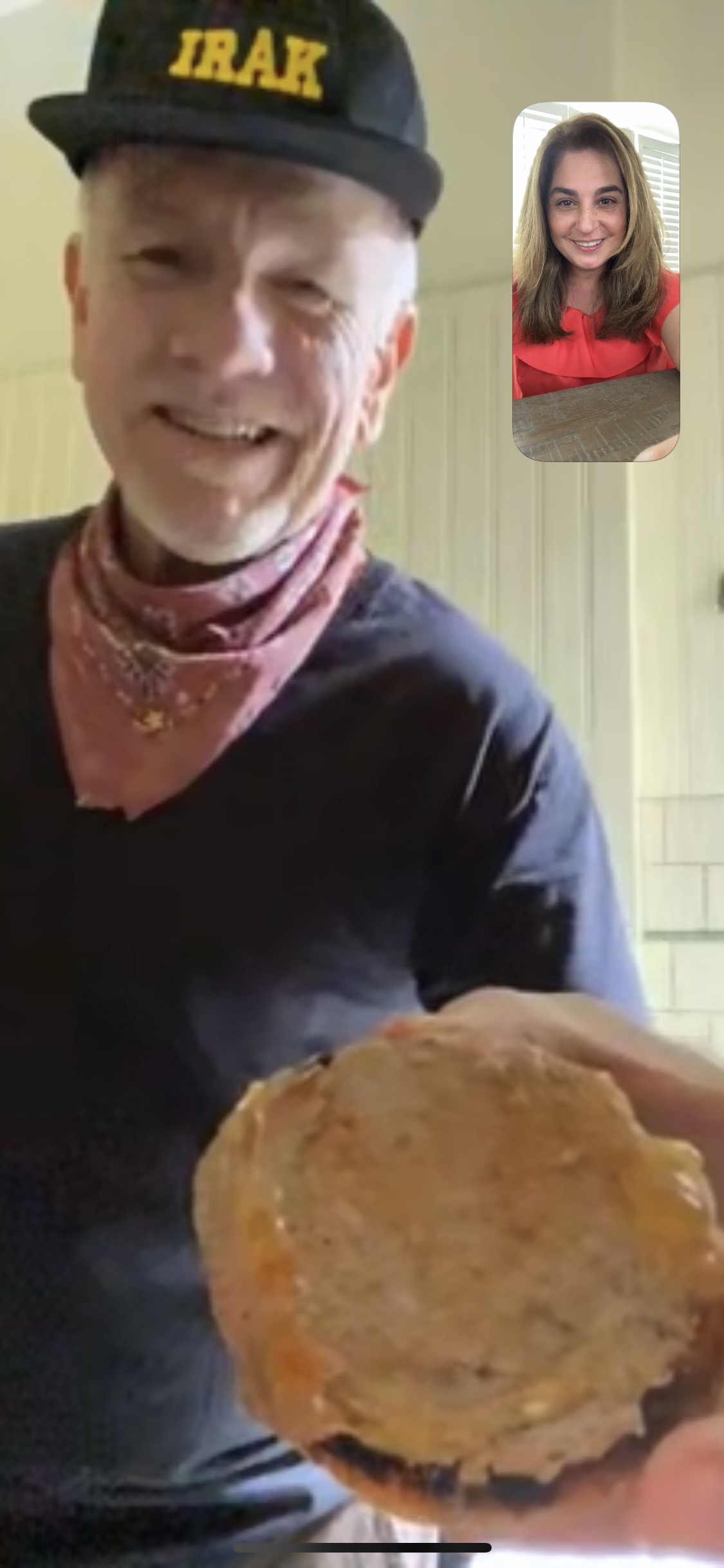
Jack Pierson
June 25, Ridgewood, Queens, New York, Studio
The Stroll is more than Walking the Dog.
Doing the Stroll is finding ceremony in the studio away from home—or the home within my studio.
One imparts ritual to the activities after waking up.
One finds routines just to lose them, and return to them again.
Walking the same streets becomes walking different parts of the sidewalk, walking an hour early, an hour late—or on the opposite side of the street just to see the same place differently.
It’s everything at once, and in one thing, everything.
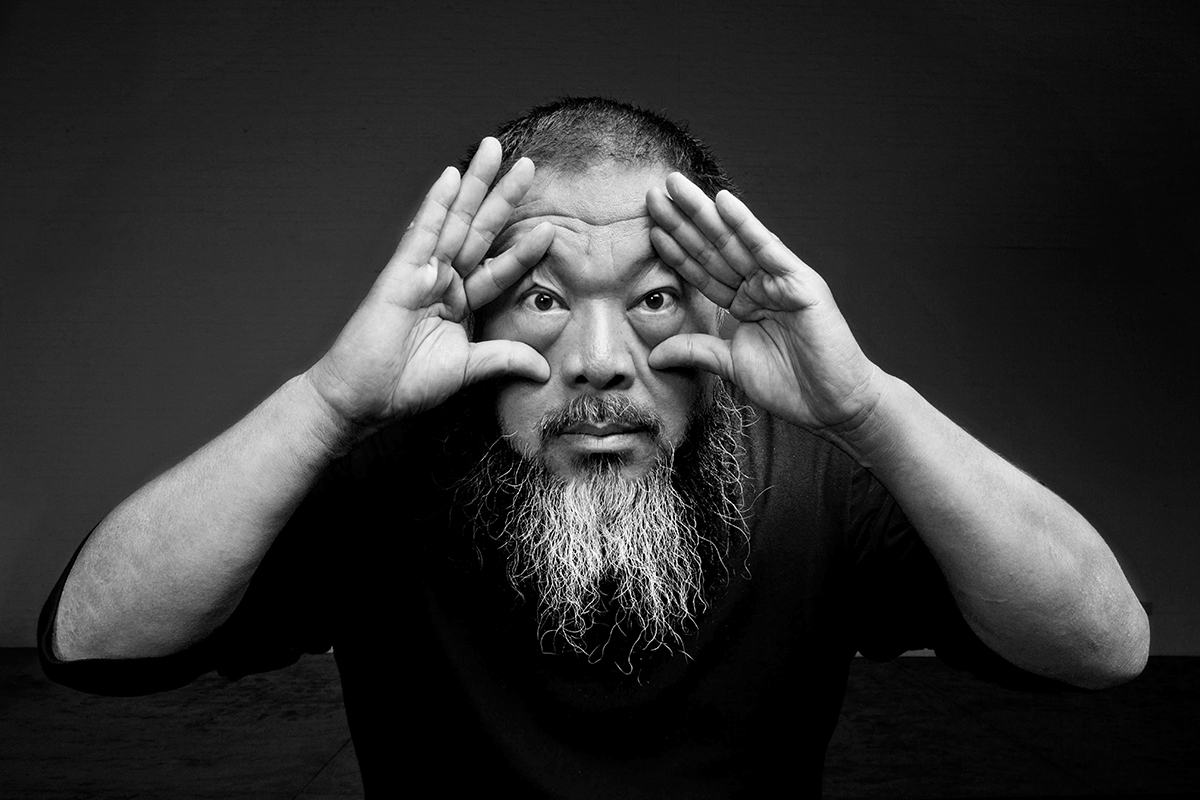
Ai Weiwei
June 23, Cambridge, England
The COVID-19 pandemic is a humanitarian crisis. It challenges our understanding of the 21st century and warns of dangers ahead. It requires each individual to act, both alone and collectively.
It is not enough to reflect on the new conditions and while away the time without fully inhabiting this moment. Actualising one’s inner need to participate gives life during COVID a new meaning. This is why I am always involved. I refuse to accept any part of life as a complete loss.
Our small individual act becomes powerful when they are part of the social response. An individual wearing a mask makes a gesture; a society wearing masks combats a deadly virus. And a society that wears masks because of the choices of individuals, rather than because of the directive of authorities, can defy and withstand any force. No will is too small and no act too helpless.
—Ai Weiwei
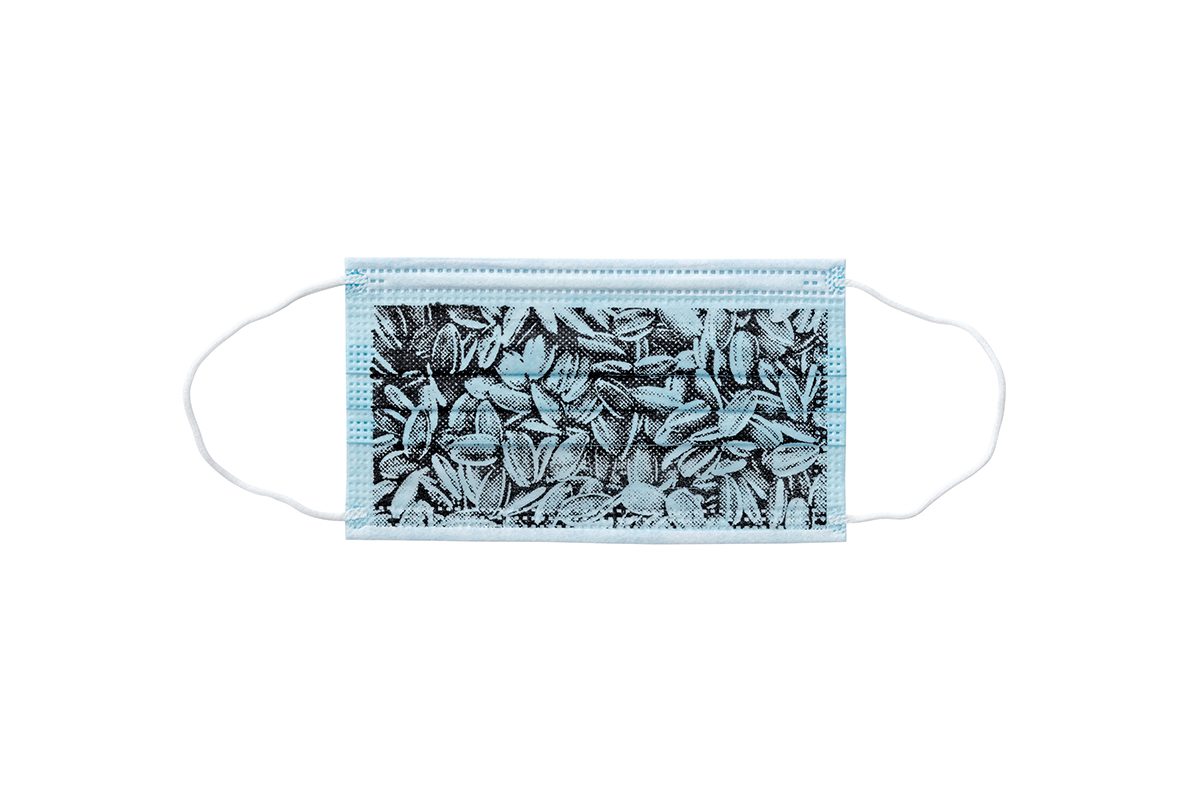
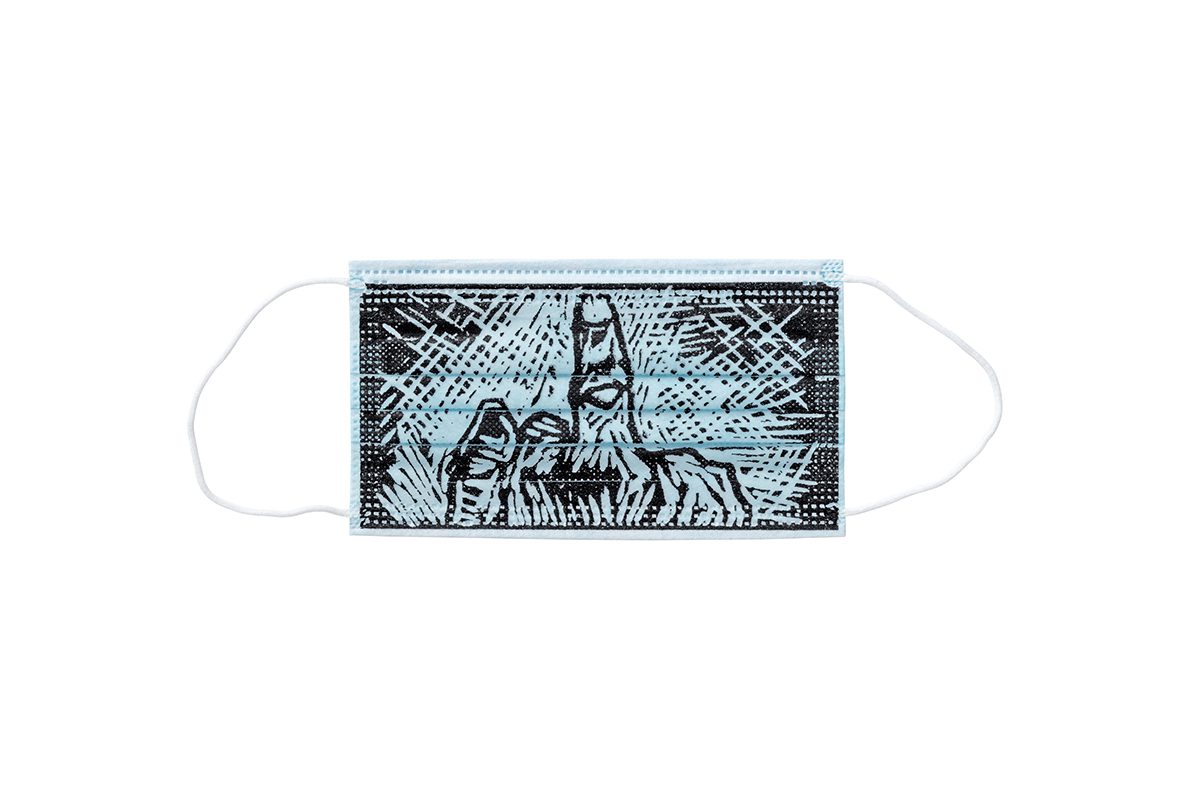
Here and above: Ai Weiwei MASK are face masks hand printed with iconic images selected from Ai’s life-long campaign for freedom of speech and individual rights. The artist will donate all proceeds from the masks, which are sold through eBay for Charity, to benefit equally three organisations: Human Rights Watch, Refugees International, and Médecins Sans Frontières/Doctors Without Borders.
Opposite: Ai Weiwei. Photo credit: Ai Weiwei Studio
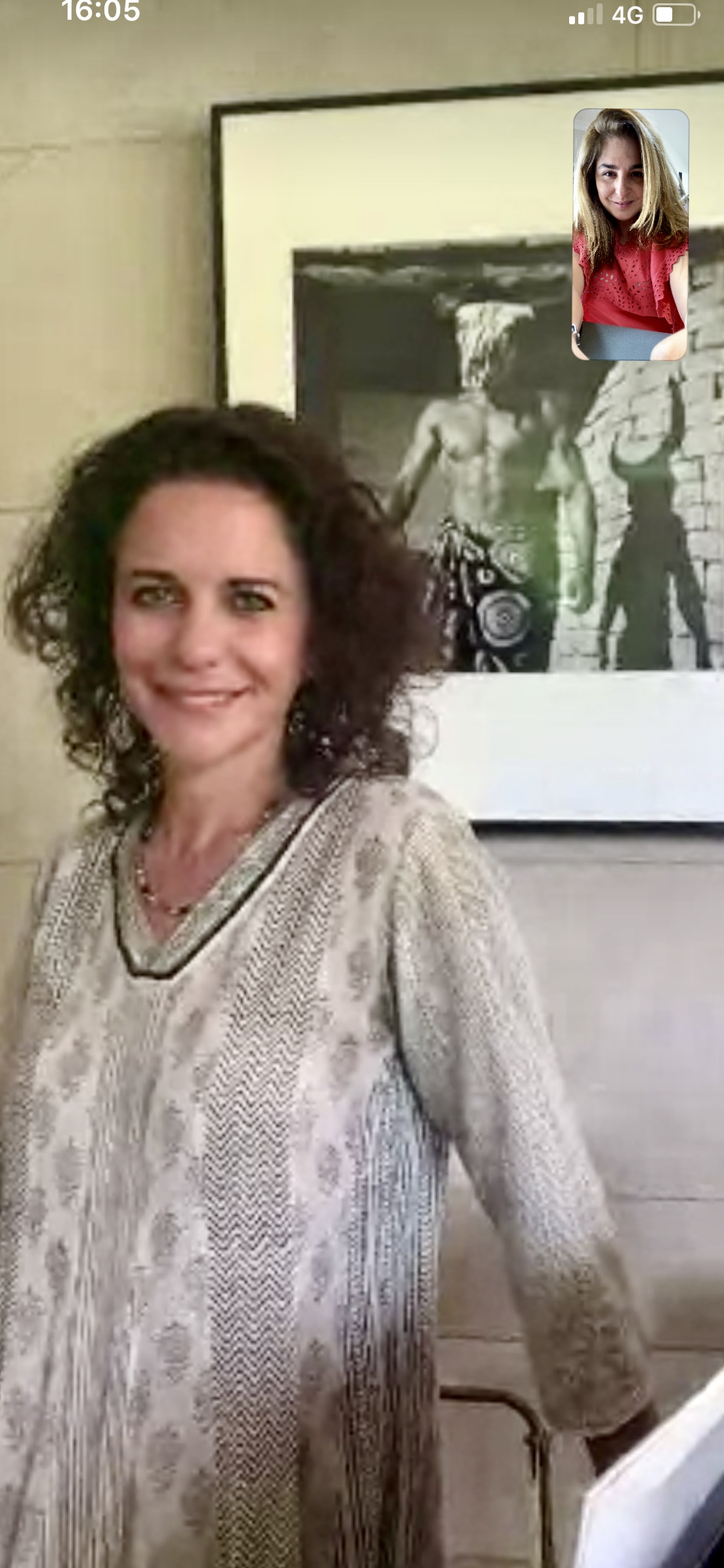
Camilla Douraghy
June 23, St. Gallen, Switzerland
Since the Lockdown, I have been spending a lot of time going through piles of film that I have taken over the years. It has been good looking at them with a new eye, as some photos only have shown their relevance later.
In particular, I keep coming back to my ‘Ariadne and the Minotaur’ series shot in Zimbabwe. I was drawn to the walls of greater Zimbabwe as the back drop to the Greek myth of the Minotaur. I wanted to photograph a new interpretation of this ancient myth.
Only once I was in Zimbabwe did I learn that when it was under Rhodesian rule, the magnificent fortress was denied its heritage. It was taught in school that the massive walls could not have been built by sub saharan Africans; rather, they were attributed to foreigners from the north like the Phoenicians or the Egyptians.
Nowadays, we know that this fortress was built by local kings who had become rich whilst trading; it was later occupied from the 11th to the 13th century AD. This was mulling in my mind after my shoot, as we were walking down the main street in Harare and the Zimbabwean artist Shorai, who had helped me with the decorations on the skull said, ‘You know this is really weird for me to walk down this street with you.’
‘Why?’ I asked.
‘When I was a kid, I was not allowed to walk on the same side of the street as a white woman; I had to get off the side walk!’
What a crazy idea…how completely and positively wrong.
All these conversations and encounters have been coming back to me as I watched with horror the countless videos of violence and atrocities committed against black people in recent weeks in America. This reminded me of my experience in Zimbabwe and how they too were denied their pride and heritage by the British. Learning about the racial tensions in Zimbabwe had surprised me at the time, but I realise now, that in my own ignorance, I had neglected to fully recognise the deep and destructive force that is racism in my own country.
America is experiencing a cultural shift, one that I believe is long overdue. People all over the country are rising up and challenging the old narratives and saying enough is enough to centuries of systemic racial oppression. I believe that denying people their heritage and recognition for their contributions is insidious and destructive to the very core of a people. The time has come to recognise and celebrate the countless contributions of black people in the U.S. and beyond. Seeing more and more people around the world not only learning to recognise this and but also willing to do something about it has inspired me to no end.
@kamiladardonyah
camilladouraghy.com
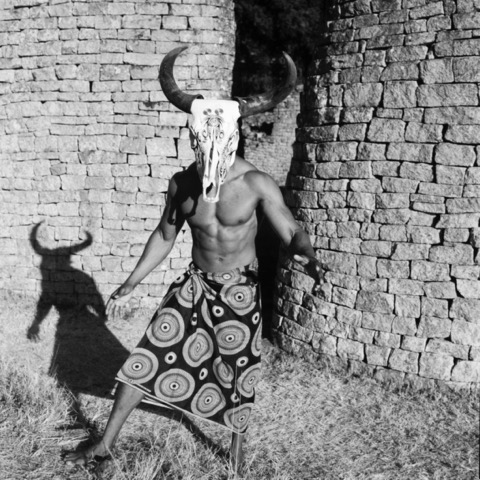
‘His Shadow’ from Douraghy’s ‘Ariadne and the Minotaur’ series
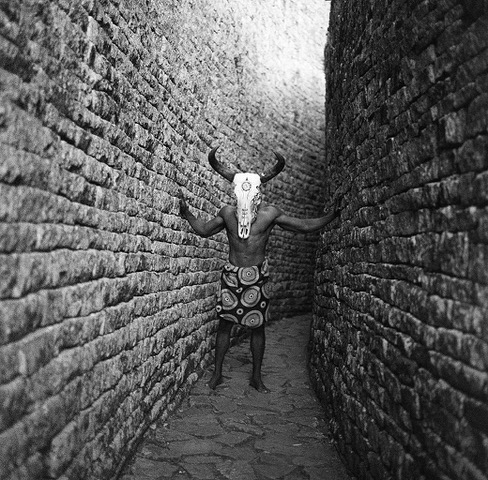
‘He awaits inside’ from Douraghy’s ‘Ariadne and the Minotaur’ series
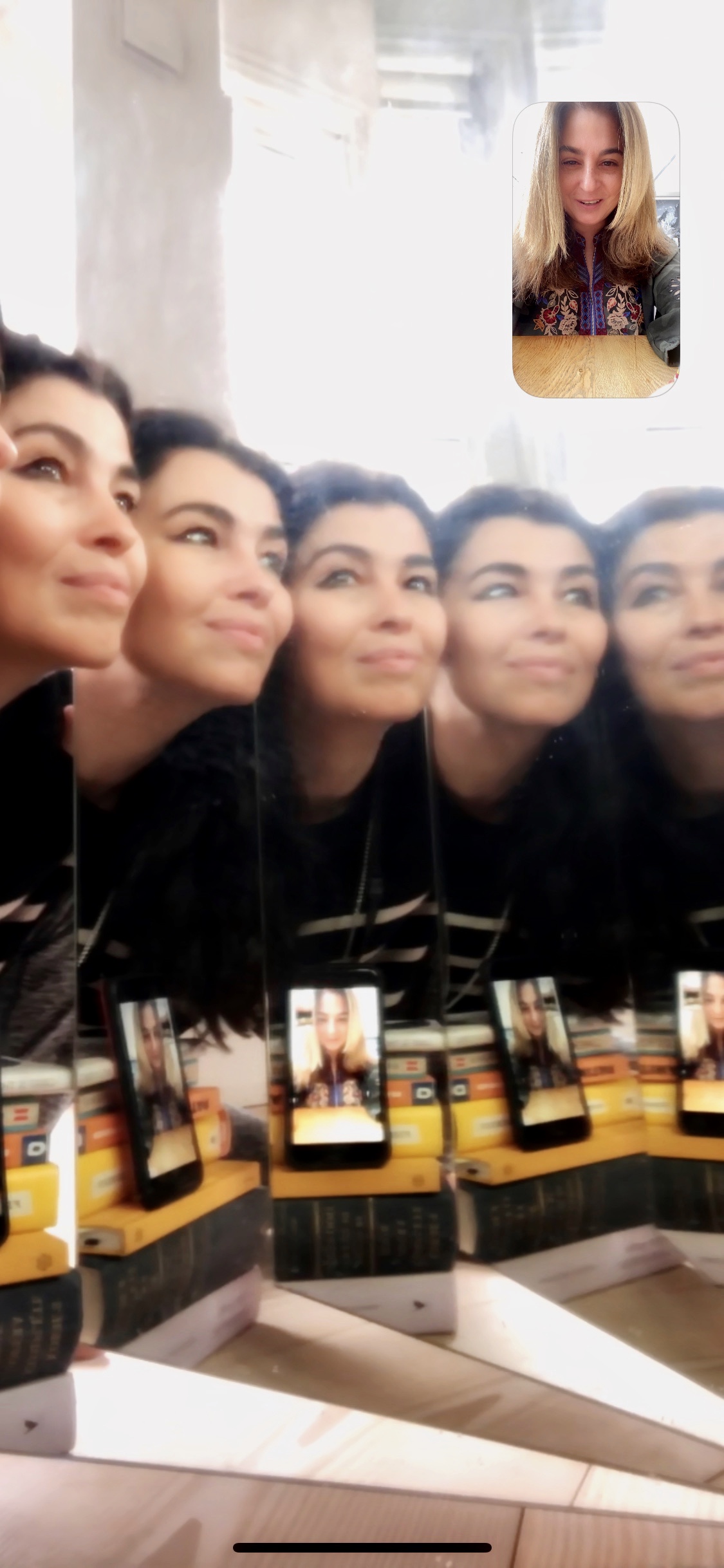
Es Devlin
June 23, London, Studio
As Arundhati Roy wrote:
‘The pandemic is a portal.’
I have been treasuring the times when I am able to see it through this lens.
A metaphor that has helped me express the quality of this period is sitting in the optometrist’s chair and having different lenses placed before your eyes – some bring clarity, some bring chaos.
I’ve learned to submit to and observe the feeling that each lens brings: some hopeful for the change this period may bring, some daunted by the pain it will certainly inflict.
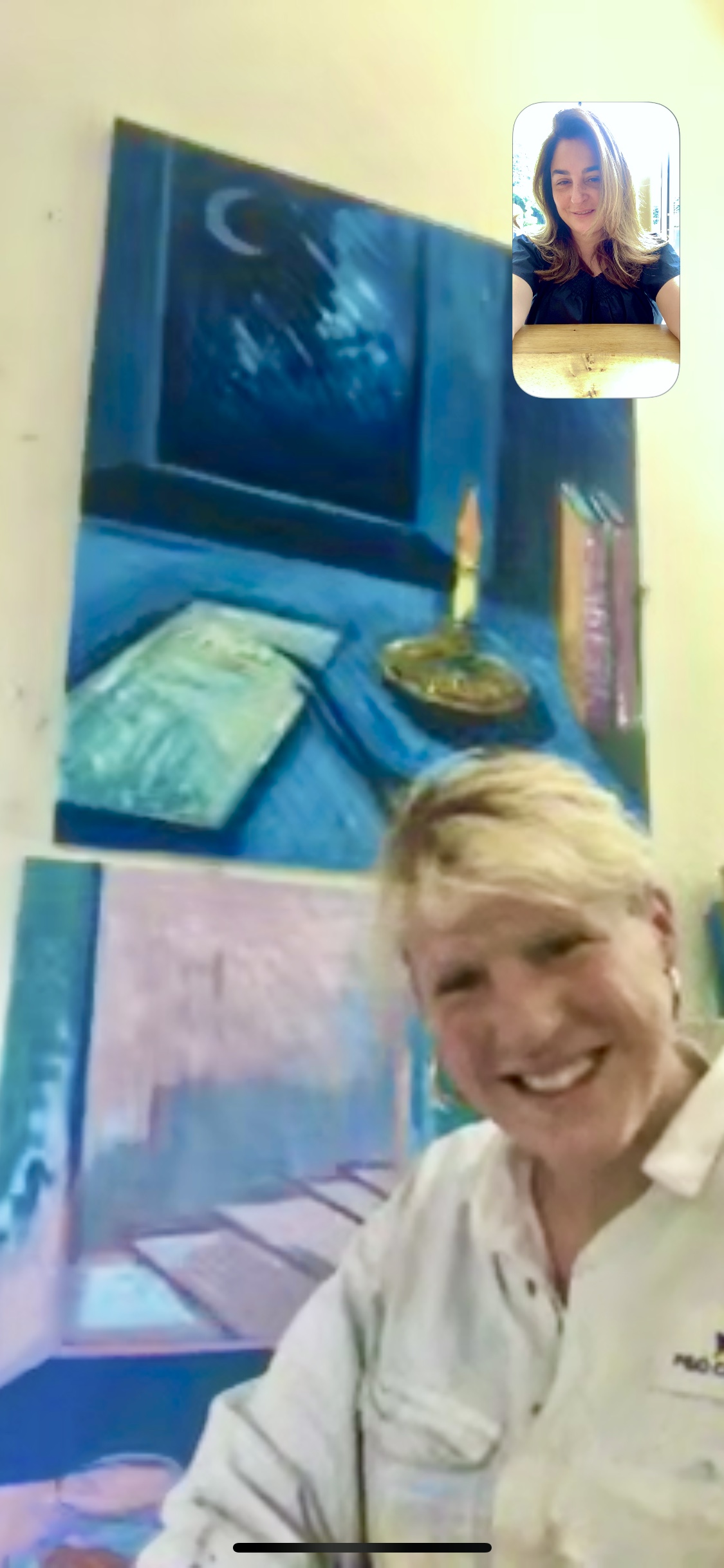
Nancy Cadogan
June 18, English countryside, Home
In October last year, I started working on a project about John Keats and his final days in Rome, when no one knew about Covid 19. Then, during a site visit to the museum, the pandemic broke and the world turned upside down. This circular notion of sitting myself in confinement, as we all have been, making work about Keats’s period of confinement before his premature death in 1821 of tuberculosis, has been remarkable. His greatest fear was that no one would know who he was, and so had inscribed on his headstone: ‘Here lies one whose name was writ in water’.
We all have our private life, the life of the mind, and our public one, how we interact with others. And in Keats’ poetry, we see that imbalance between physical confinement and mental freedom. It is this which I find fascinating. I was trying to explore this theme in my last show, Mind Zero, through a blue faced avatar. But this time takes it to a new level.
This period of the last few months has just underlined and amplified a sense of what the young poet and his friend, Joseph Severn, must have been facing. One where the light is outside! I hope, that my own confinement has allowed for a greater understanding and will provide more layers to the onion of a painting. Confinement isn’t easy, and clearly does not really suit us humans, our fears cannot be calmed, our anxieties not abated, and things can be emotionally volatile. And yet all the while, the body sits.
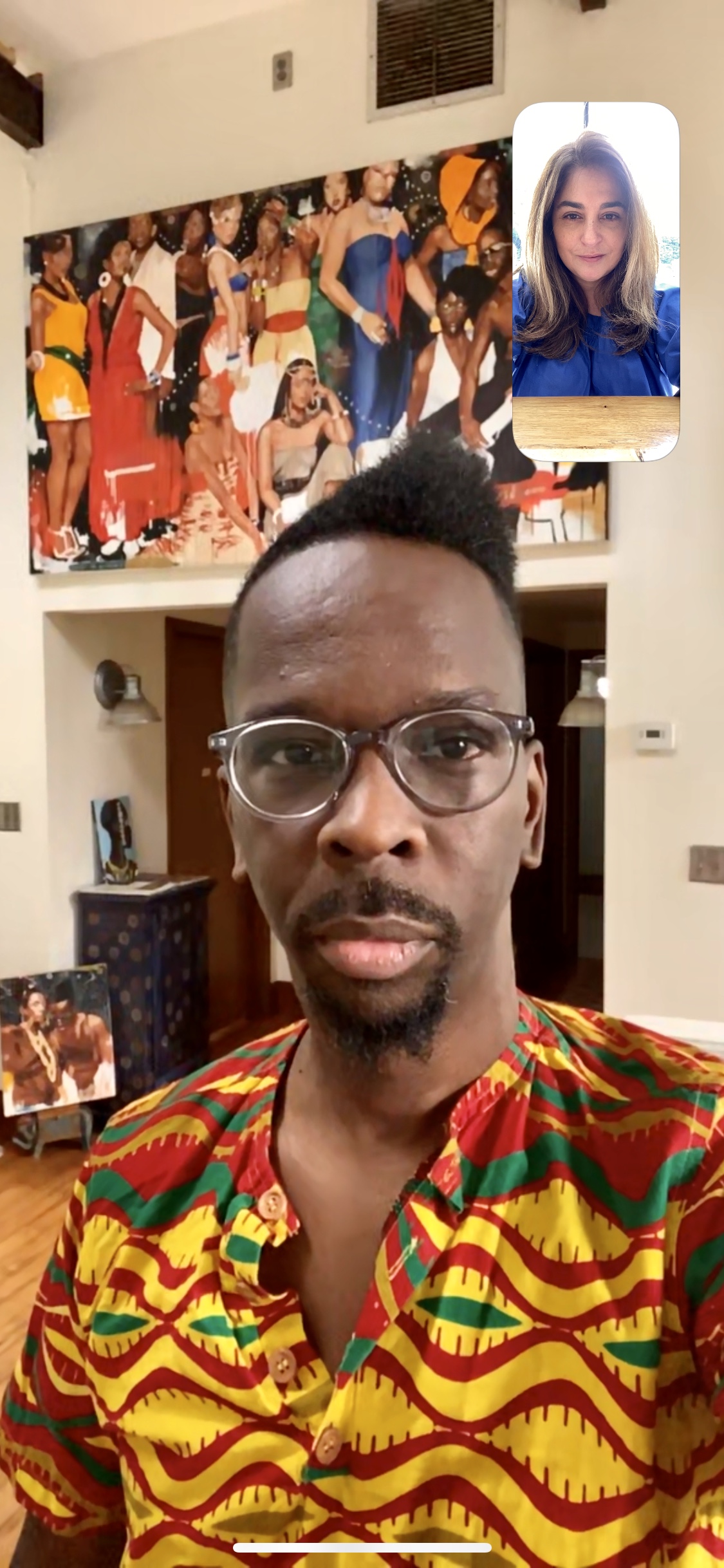
Fahamu Pecou
June 18, Atlanta, Georgia, Home
Diary Entry part 2
Whereas danger is real, fear is not. Fear is rooted in the unknown and unknowable. We are most afraid when we sense a loss of control. But the truth is, we never have as much control as we believe we have and herein lies the danger. We are made to believe that systems and “leaders” are imbued with powers beyond our own. We often go along with ideas and beliefs that feel wrong in our gut, but rather than be discomforted by objecting, we acquiesce. We are seeing more than ever, that those same systems and same leaders are just as fragile, flawed, and frightened as we are around establishing and maintaining control. I have been inspired greatly by the events of this past year. Everything we’ve seen and experienced has worked to expose the cracks and fissures in culture and society that we’ve sought and found safety in. And many of these spaces have offered safety to the few at the expense of the many. With each crack and each piece of the system that crumbles away, we come closer to the dawn of a new day and new way of life. One rooted in the reality of our collective humanity. One no longer predicated on division and derision based on race, or sexuality, or gender, or language, or ability. We move closer to a world where we get to see one another and more importantly see ourselves as reflections of one another. When we abandon fear we can prepare for the inevitable dangers informed with compassion, empathy, and understanding. As uncertain as these days have been, I am certain that our tomorrows will be brighter because we are growing together. As ugly as these times have been, they are preparing us to craft with beauty those days yet to come.
May 14, Atlanta, Georgia, Home
Diary Entry part 1
I’ve been doing a Twitter engagement I call “Stream of Conscious” which essentially is a Trumpian tweet storm of my thoughts at a particular moment. Today’s was in fact about the impact of COVID, but more broadly, about 2020 and all that has been exposed. One of those passages, I’ll share here as it is relevant to the quote request:
2020, despite all its trauma and sadness, has also been an awakening. We all aspire to have 20-20 vision. Now we have it and it does little to elevate us if we avert our eyes from fear of seeing the truth about ourselves – however ugly it may be. Now is not the time to bury our faces. Neither should we attempt to forget the painful realities laid bare before us. I urge you… I implore you… look, and look unblinkingly. 2020 is not out to “get us”… it’s only shown us what is and what can be. 2020 vision comes with a responsibility. One can not merely “look” without also SEEING. We’ve been mostly blind, eyes wide shut. But now that we’ve seen, we must do the work to become… become focused, become more, become responsive, become better. James Baldwin is quoted as saying: ‘Not everything that is faced can be changed, but nothing can be changed until it is faced.’
So with that I say, Thank you 2020! Your lessons will not be forsaken… and never forgotten.
create like a god.
command like a king.
work like a slave.
love like a mother.
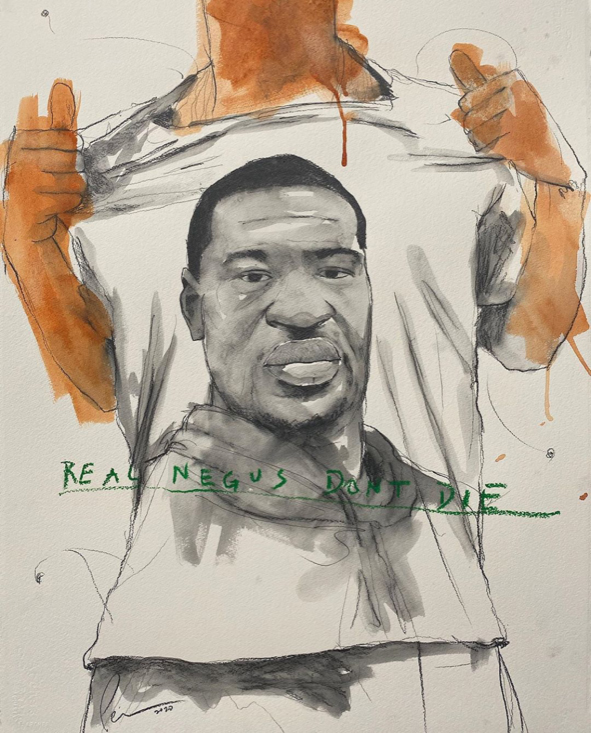
‘Real Negus Don’t Die: Why We Stand (For George)’, 2020
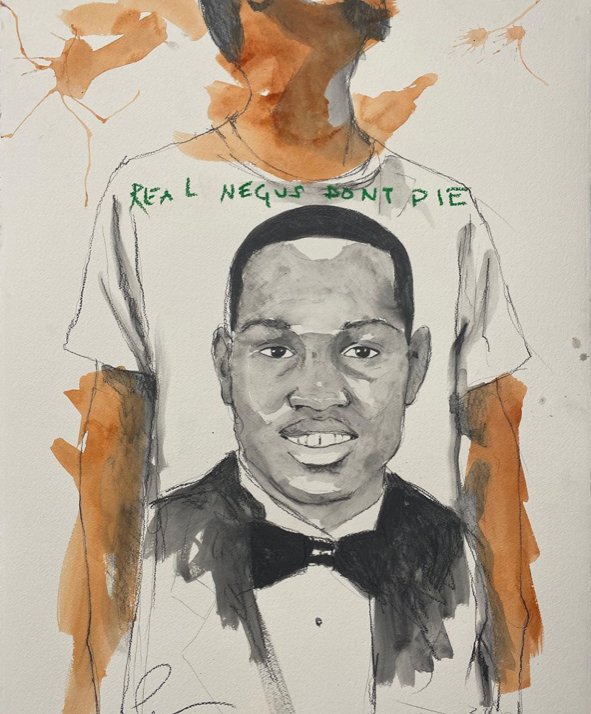
‘Real Negus Don’t Die: Run4Life (For Ahmaud)’, 2020

‘Real Negus Don’t Die: Shero (For Breonna)’, 2020
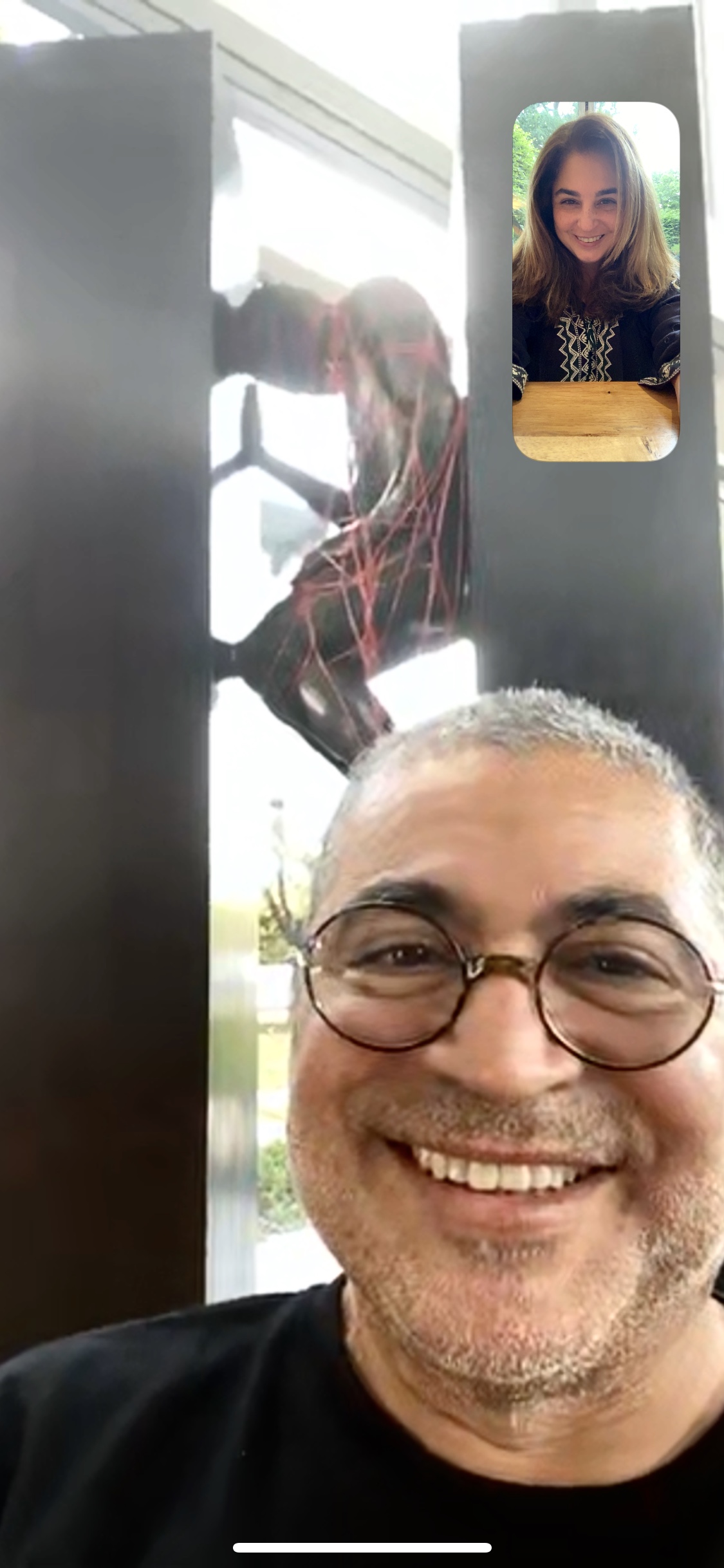
Mahi Binebine
June 17, Marrakesh, Morocco, Studio
At home, we say, ‘When you take distance from things, you get close to the essential’.
For some people, confinement has been synonymous with real suffering. For others it has meant freedom, creation and creativity. The latter applies to me. Having said this, artists are confined for life. Many live, dare I say, like recluses. So much takes places within their mind and their soul, and, as such, confinement doesn’t really change much for them, in their day to day. As far as I am concerned, never have I felt more happy than I have over these past few months.
Ordinarily, it takes me two years to write a novel. I wrote my recent tome in just four months, whilst in confinement. ‘Pas de Deux’ is its title. I usually see my daughters two or three times a year; they are now with me, at home, until September.
In normal times, I spend half my life in airports, in train stations, and in hotels. Not anymore. Now, I spend time with my own tribe. I practice sports. I drink less. Sheer happiness!
This crisis has served as a magnifying glass; it has highlighted a global state of societal consciousness, across the globe. Inequalities, environmental disasters, exaggerated consumerism. All of it prioritised, over quality of life. As, humans, we have, perhaps, now understood how interconnected we all are, and how we should be looking at improving our civilisation, into one which will be more prudent, more resilient.
Humanism should not be viewed as a naff concept nor is it a waste of time. We should all dust off the word carefully, and give it back the lustre it so deserves.
***
On dit chez nous : « S’éloigner de tout rapproche de l’essentiel »
Pour certains le confinement est vécu comme une véritable souffrance en raison des nombreuses restrictions qu’il impose. Pour d’autres, il est plutôt synonyme de liberté́, de création et de créativité́. C’est mon cas. Cela étant, les artistes sont confinés à vie. Ils vivent en ermites, si j’ose dire. Ils sont toujours enfermés car tout se passe à l’intérieur d’eux-même. Le confinement ne change pas grand-chose. Pour ma part, je n’ai jamais été aussi heureux que pendant ces derniers temps.
D’ordinaire, je mets deux ans pour écrire un roman. J’ai bouclé le dernier en quatre mois. « Pas de Deux » en sera le titre.
D’ordinaire, je vois mes filles deux ou trois semaines par an, je les ai à la maison jusqu’au mois de septembre.
D’ordinaire je passe la moitié de mon temps dans les aéroports, les gares de train, les hôtels… plus maintenant. Je vis parmi les miens, je fais du sport, je bois moins d’alcool… Que du bonheur !
Cette crise a été un miroir grossissant de l’état de nos sociétés mondialisées, des inégalités, du désastre écologique, de la logique consumériste au détriment de la vie. Les humains ont peut-être compris qu’ils sont interdépendants, qu’il leur faudrait construire une civilisation plus prudente, plus résiliente.
L’humanisme n’est pas une notion ringarde, désuète. Il faudrait dépoussiérer ce mot et lui redonner l’éclat qu’il mérite.

Hofesh Shechter
June 17, London, Home
Time without space, is like
soul without a body.
I want my body back.
Trailer to ‘ Grand Finale’ , a show we toured in the last three years:
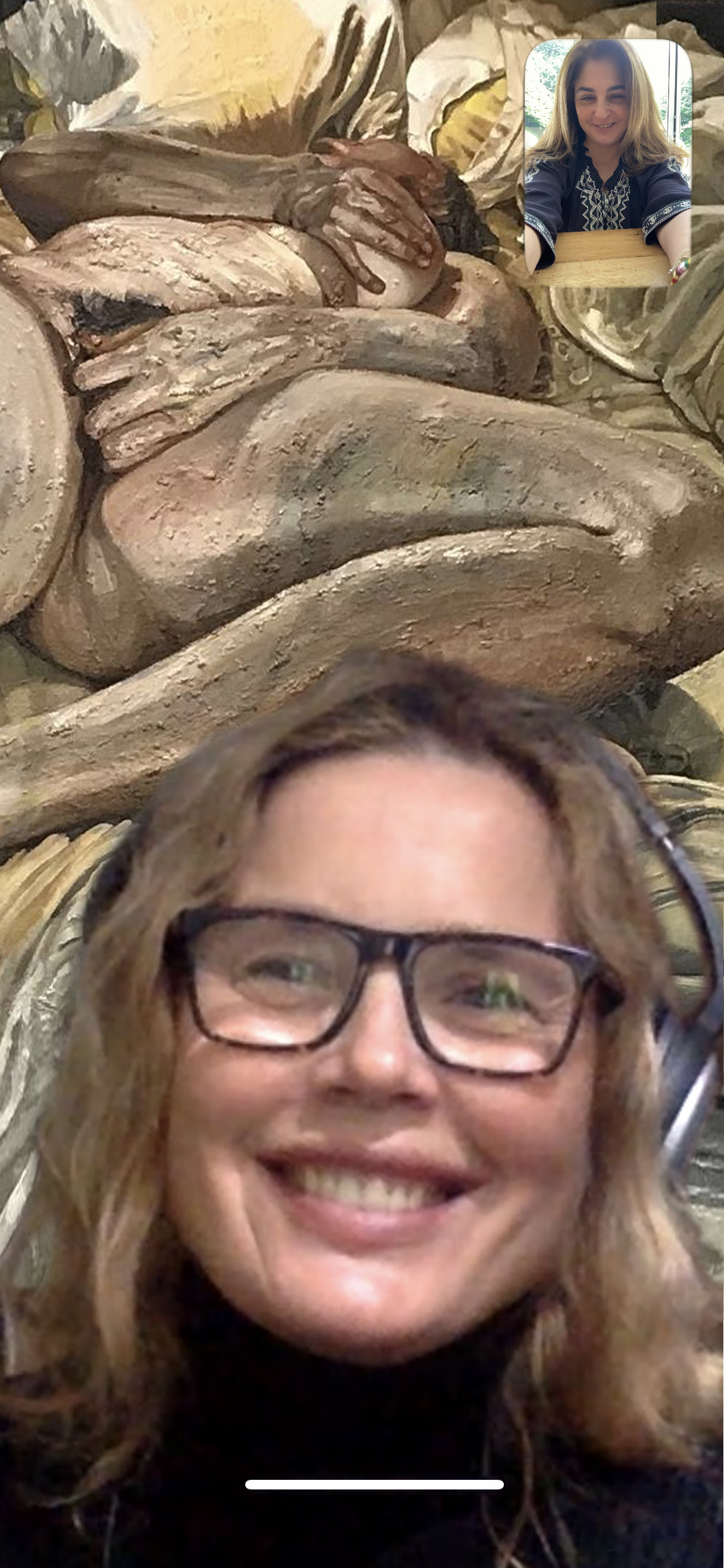
W.K.Lyhne
June 17, London, Home
‘What, if some day or night a demon were to steal after you into your loneliest loneliness and say to you: “This life as you now live it and have lived it, you will have to live once more and innumerable times more; and there will be nothing new in it, but every pain and every joy and every thought and sigh and everything unutterably small or great in your life will have to return to you, all in the same succession and sequence—even this spider and this moonlight between the trees and even this moment and I myself.”
…’ (1) Nietzsche is asking us not to take the idea as true but to ask ourselves what we would do if the idea might be true. Our first reaction would be utter despair: this which we call the human condition is too painful and the thought that one must relive, all our errors, an infinite number of times, is unbearable.
But he suggests, that suppose we embrace it as something that we desire? That, would be the ultimate expression of a life-affirming attitude: to want this life, with all its pain and boredom and frustration, again and again. Miles Aldridge talked about this exactly in this very forum, about boredom reminiscent of his 1970s childhood leading to new discoveries and pleasures.
I’m interested in the concept of this container called home. The place to which we return to, leaving the trace of our existence pressed into the surfaces. We use it, take it for granted, consider it a place to leave behind or ignore, but ultimately, it’s the only something when there is nothing. When disgraced politicians screw up and are spat out of a glamorous and fast-paced public life, they talk of going ‘home, (“to spend more time with their families”)’. I read once a Michel de Montaigne essay I wanted to quote here (to write this I’ve skim re-read Montaigne, never a waste as he is so entertaining, and can’t find the text), but here it is as I remember it: we are born in a bed, move into a room, a home, a village, a city, out into the world, busy and full of our affairs, then at the end of life, our existence condenses again – the town, the home, the room, the bed. The flesh of the fabric that accompanies our unconscious existence at home, where we are now sequestered, is what is currently interesting me. The weight of the bed that holds us, to which we nightly return and occupy at our most vulnerable. The weight, the pleasure, the pain carried immanently within the flesh of the fabrics that describe and contain this eternal return.
I’m currently working in a back bedroom. I’m working on what I see, fabrics in their wear from touch, painted on cotton rag paper, which is all I have to hand. The oil from the paints leaches out in a stain and the paper becomes worn and bobbly, all speaking to the materiality of the subject. Britten bought a harp manual and a book of poems in Halifax, Nova Scotia, when his boat stopped for refuelling, on his way back to Europe after some years in America. With it he composed what I think is his best work, A Ceremony of Carols. This sequestration allows for such serendipity to flourish.
(1) Nietzsche, F, concept of the Eternal Return in Die fröhliche Wissenschaft (1882) and also in Thus Spoke Zarathustra and Beyond Good and Evil (1887)
(2) Bakewell, S, How to Live: A Life of Montaigne in one question and twenty attempts at an answer (2011)
Below video: Confutatis by W.K. Lyhne
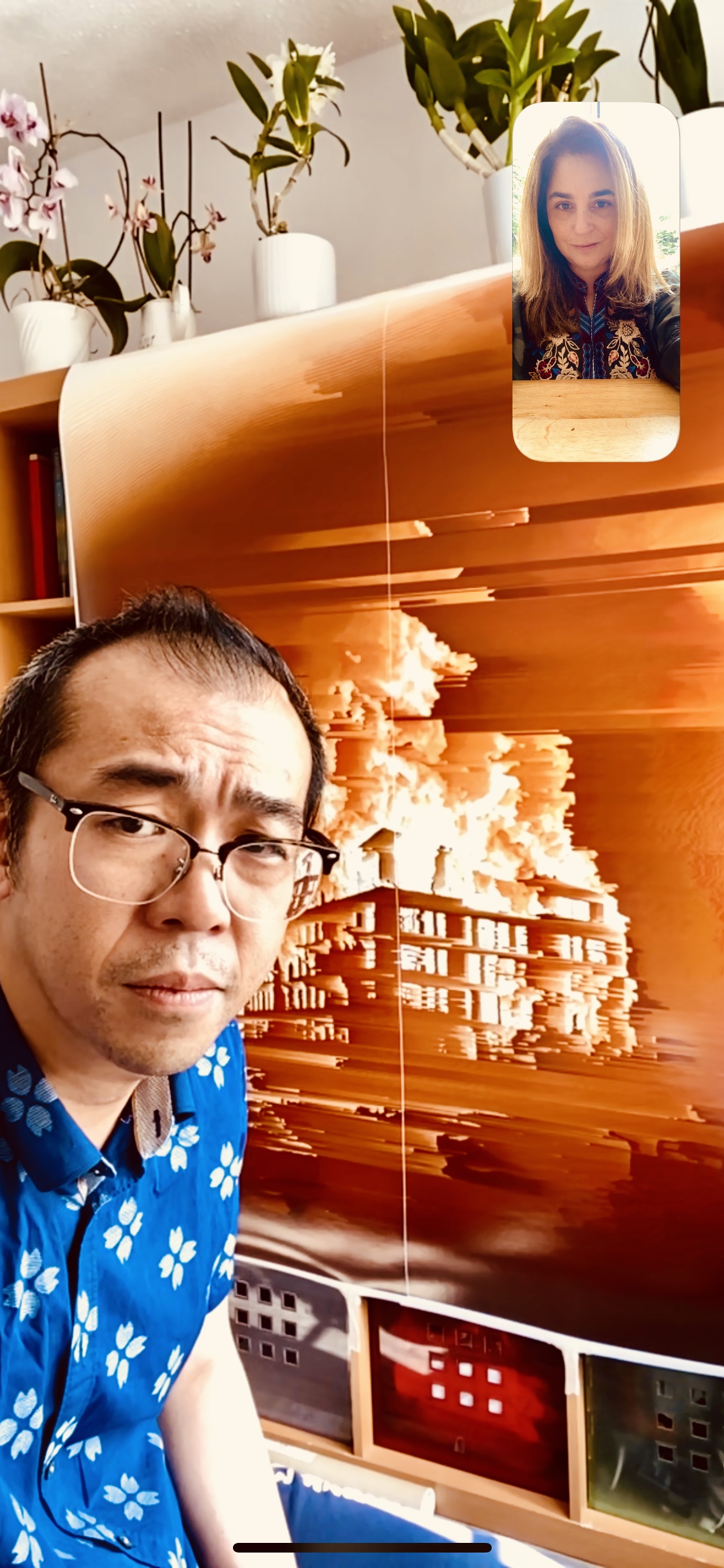
Gordon Cheung
June 16, London, Studio
I am a British-born Chinese artist who believes in bearing witness to our histories by making art. In these extraordinary times, our lives are profoundly transformed and offer a focal point for positive change. Making art about our histories is to mark it as a moment to understand its roots of how it came to be, its current emotive power and responding to what future we might want.
“China Virus” is a name propagated by the Trump administration in reference to COVID-19 that stokes anti-Chinese racism, spiking hate crimes against Asians. History has shown us the dehumanising dangers of fascist leaders who racialise viruses for political gains. The diseases and leaders are different, but we have been here before. True leadership would unite humanity to fight against the pandemic and reach out a helping hand rather than point and blame.
Covid-19 lockdown has inspired me to reach out to collaborate with artists through projects such as the #artistsupportpledge on social media as well as to raise money for charities helping the victims of the virus. I am working with Toronto-based Chinese-Canadian artist Karen Tam on an ongoing research project to chronicle and celebrate under-recognised Overseas Chinese in history who fought to overcome systemic racism. Remembering the positive achievements of those who came before us helps to counter negative stereotypes, shape who we are and inspire future generations.
I watched in horror, like many others around the world, the indiscriminate killing of George Floyd who became the current 2019/2020 pinnacle of over 1400 killings of mostly poor people of colour per year by US police. Along with the surreal mishandling of the pandemic by the richest and most powerful nation in the world, it has shown us a broken system. Meanwhile, the US Federal Reserve printed trillions of dollars and anonymously gave it to corporations to artificially skyrocket their own stock prices despite record unemployment rates beyond those of the Great Depression. It’s an unprecedented transfer of wealth to the upper echelons of society and dilution of purchasing power for the poor. It is unsurprising to see the tinder of anxiety explode into flames of protests.
I hope we will be able to reflect and act on how we might improve and value the vital importance of our healthcare and economy for the benefit of the majority of people. Otherwise, we are doomed to repeat history. We have seen from those on the frontline who are saving our lives, that it takes enormous resilience to overcome a global pandemic. The human spirit in the face of adversity is incredible to witness.
Recognising beauty in these turbulent times is the premise of my collaboration with Los Angeles-based Martin Klipp, President of Beyond Art Creative. We are launching a plan to present a series of seemingly idyllic American landscapes. Captured on smart phones’ cameras from around the US during the COVID-19 isolation, the images are juxtaposed and repurposed using a technique that reorders the pixels into a ‘digital sands of time’ that underscores the impending dark undertow of personal and political turmoil echoing the fragility of the situation across the world. In these emotionally turbulent times we need moments of beauty to lift our souls; a breath of tranquility. In isolation we can find peace before moving forward to create the future we desire.
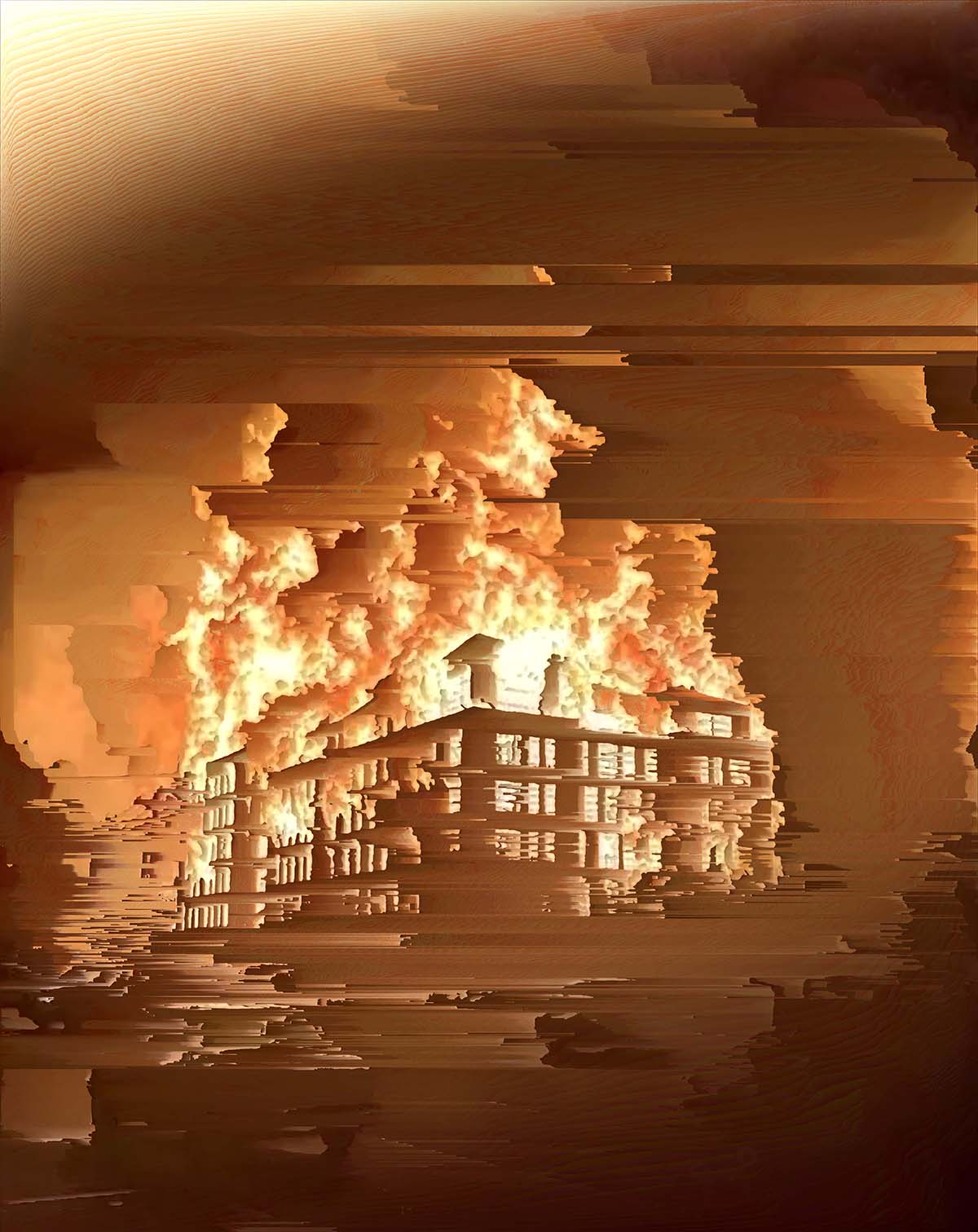
30 May 2020 Minneapolis (History Glitch) by Gordon Cheung. Note: The artist released a small edition of this image on Friday 26th June with all proceeds going to a Black Lives Matter charity.
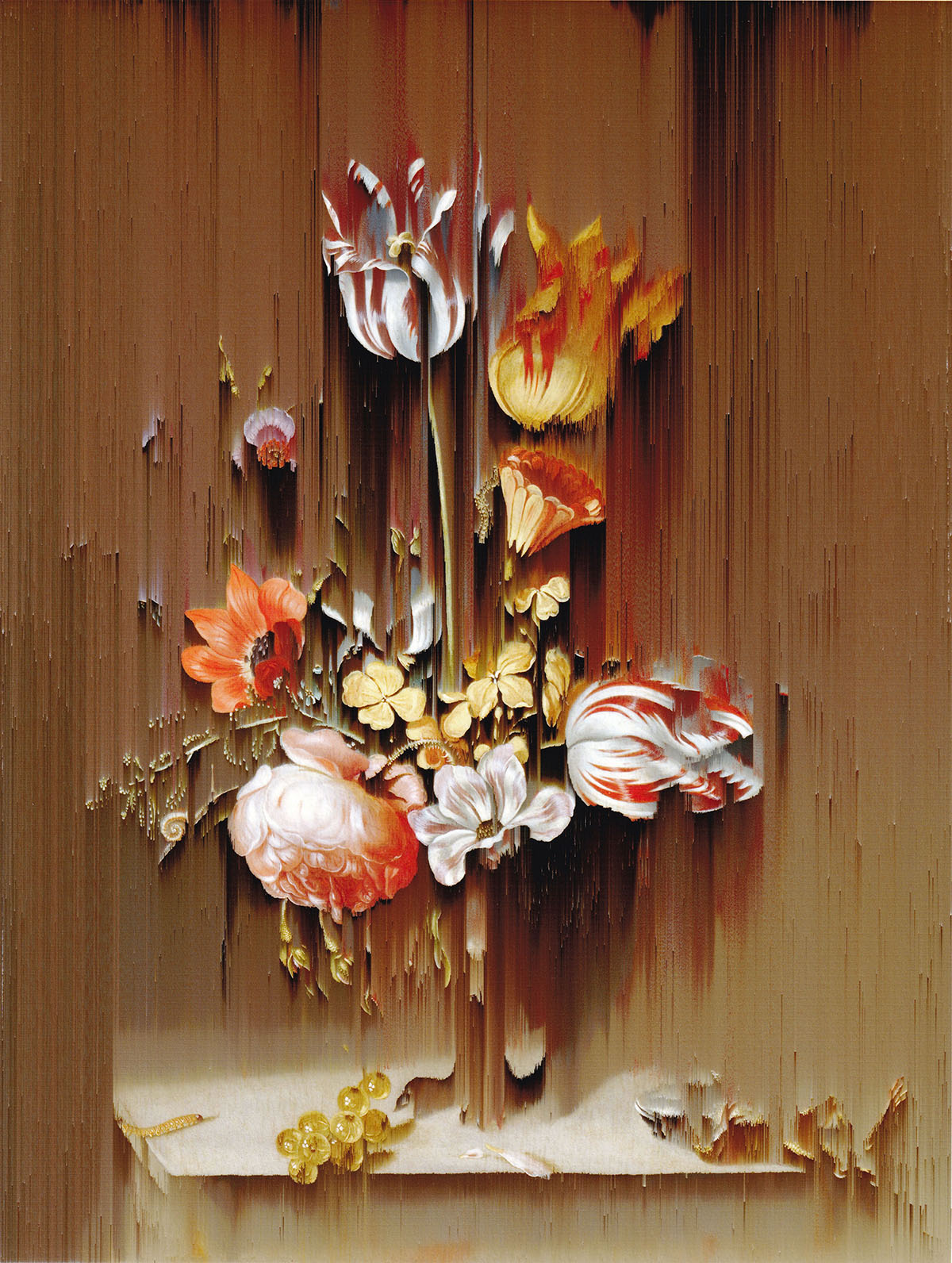
New Order Still Life with a Vase of Flowers and Dead Frog Jacob Marrel 1634
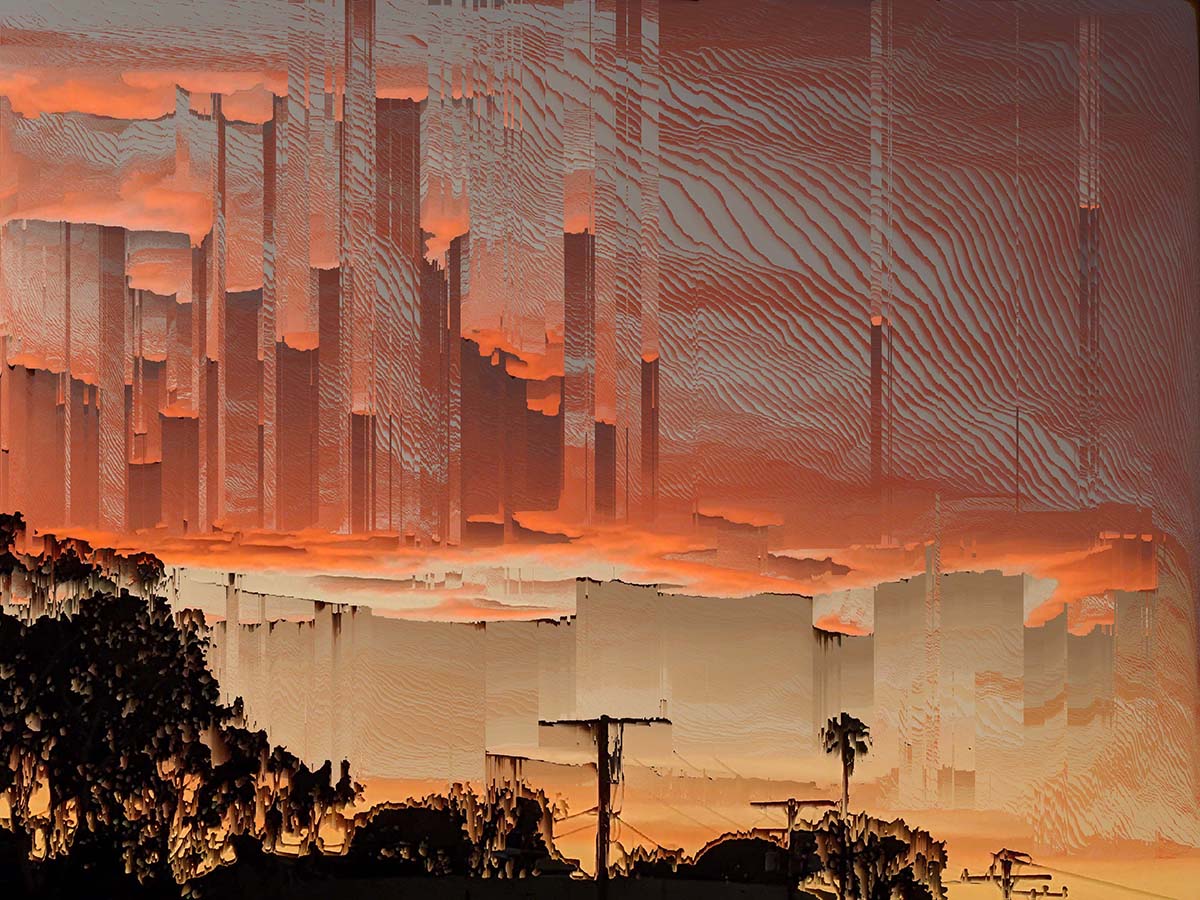
Martin Klipp Image
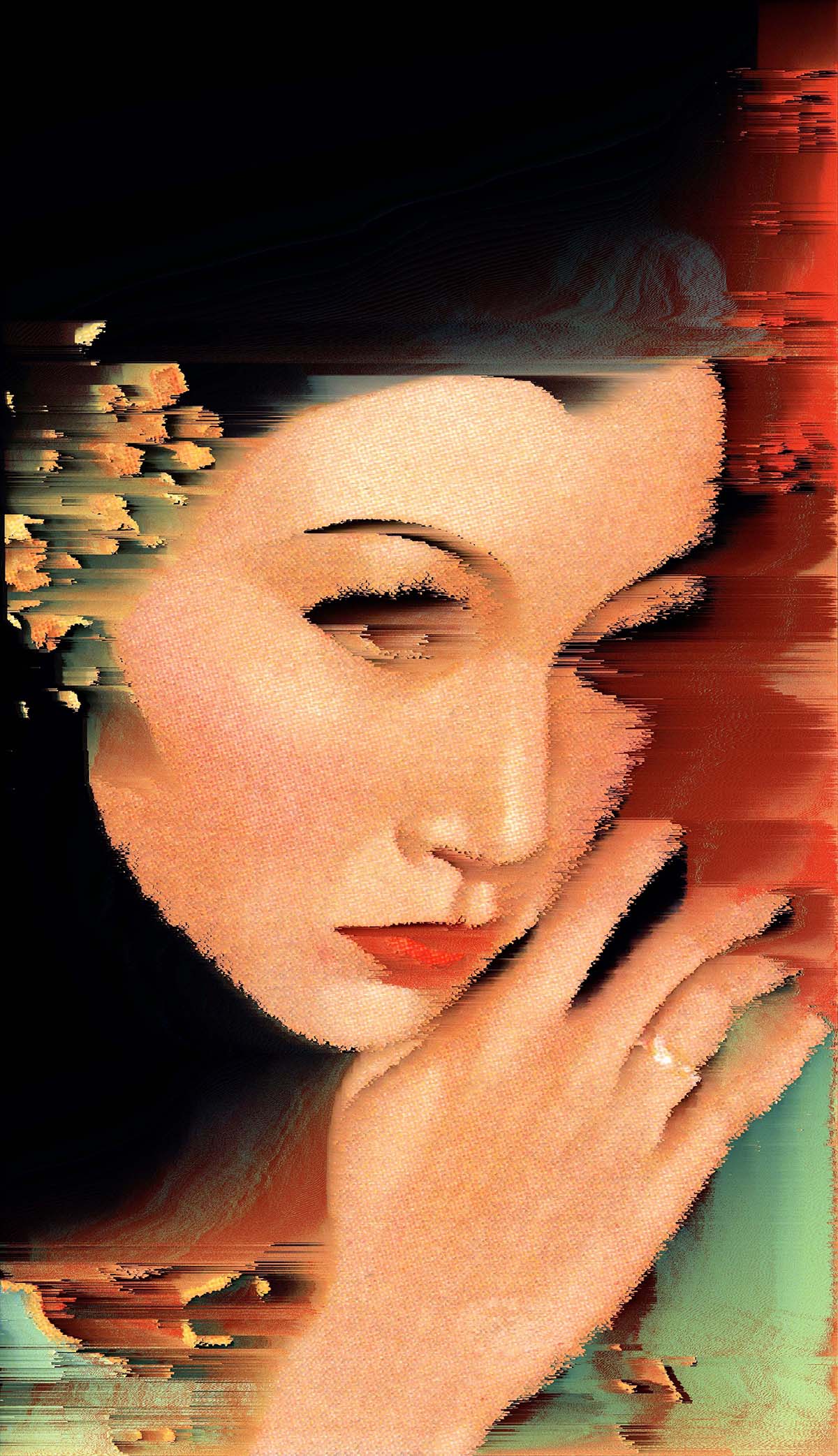
Anna May Wong
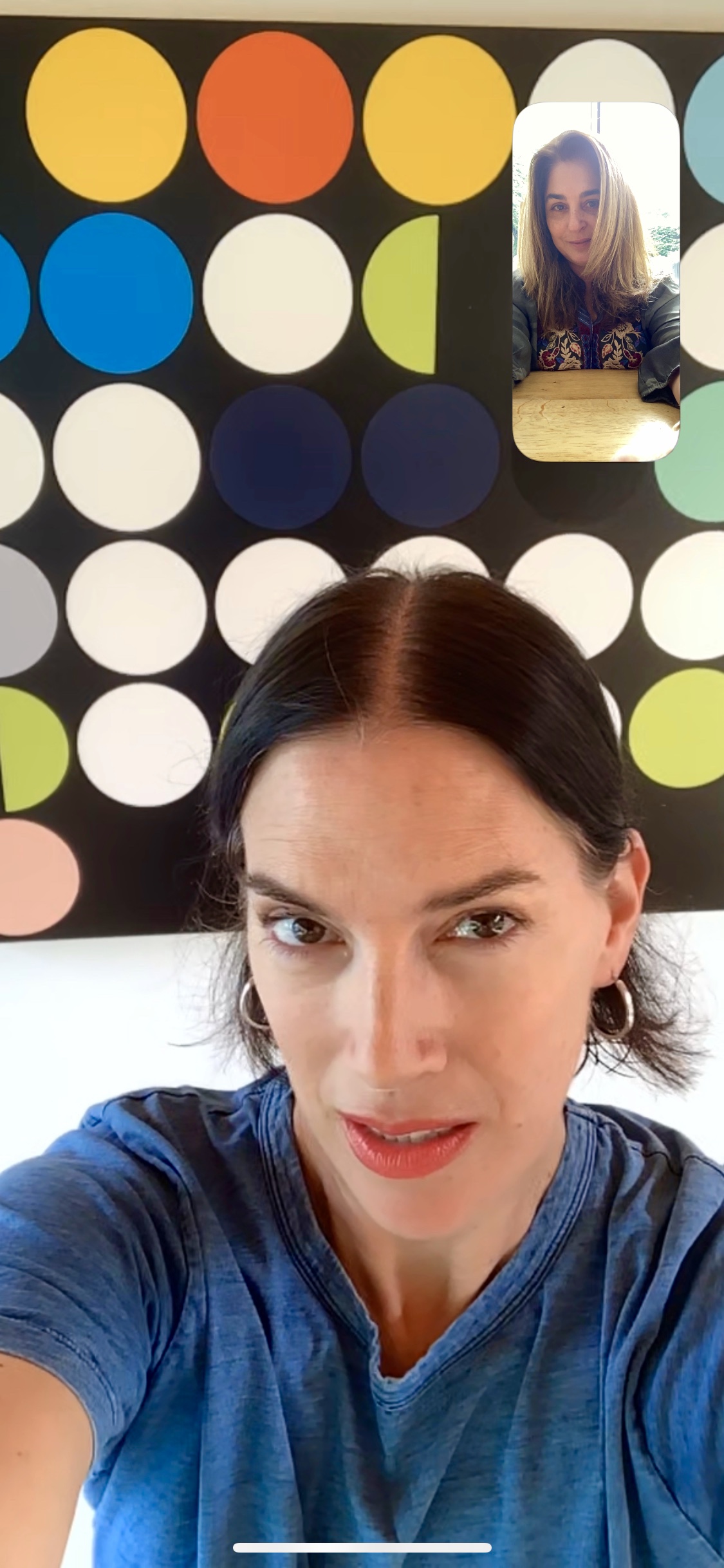
Sarah Morris
June 16, Martha’s Vineyard, Massachusetts, Home
I am now displaced from my life in New York. You could say voluntarily so but that would deny the strength of this situation. There is reckoning that seems to have been long in the making. A disbelief or denial of Science, a failure to see climate change as real, a failure to see inequality as harmful and systemic. So here we are, suspended in our making or to put it another way I am reimagining my future or our future and what it should look like and feel like. It is powerful that in the face of a global pandemic the collective voice of dissent eliminates fear. So does creativity. That voice is so strong and so visceral I want to capture it in my paintings. Everything comes back to it…. An interior voice, a voice we know that cannot be ignored, cannot be overlooked. A warning. This voice is social and political at its core and it gives me direction.
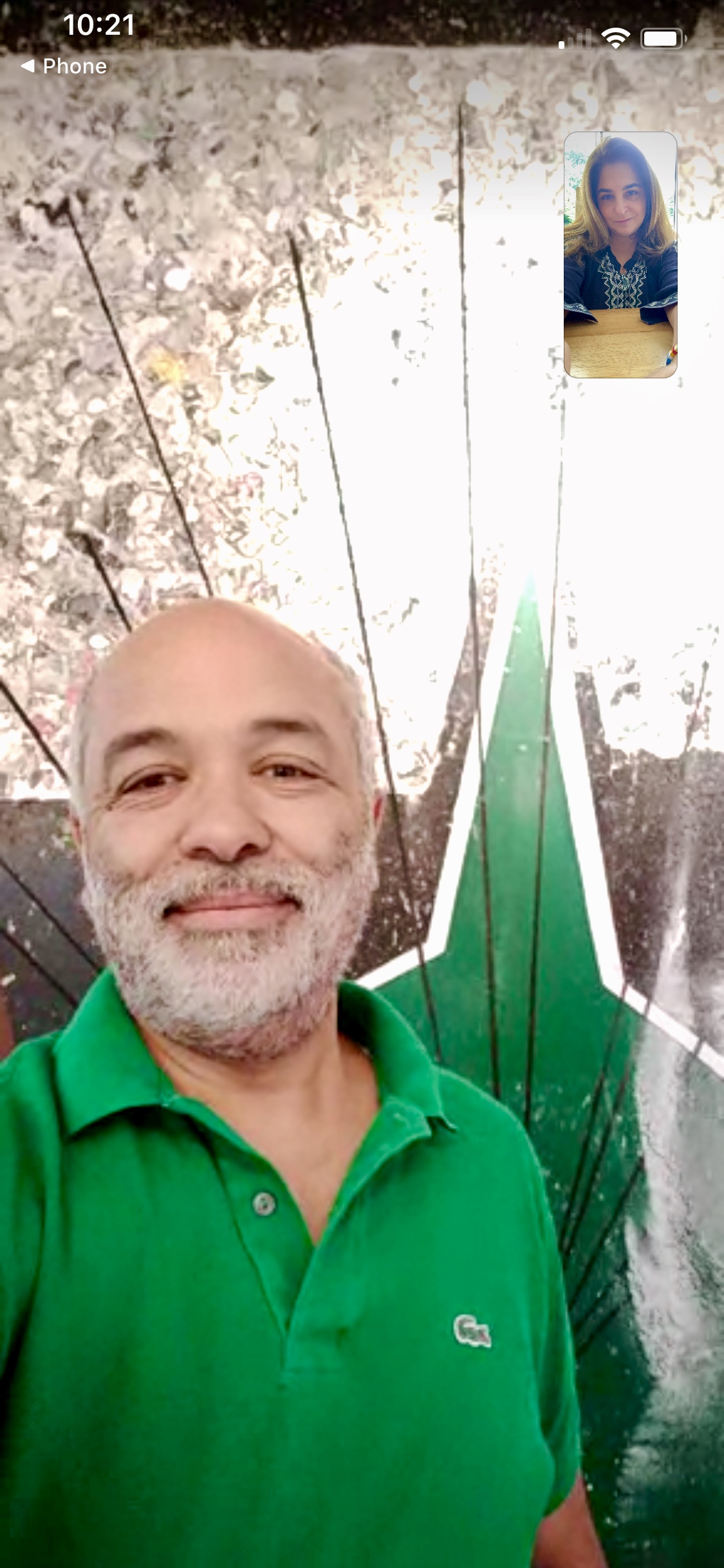
Mohamed Mourabiti
June 16, Marrakesh, Morocco, Studio
This multi-pronged crisis spanning across health, society and politics, has taught me fundamental lessons, not only as an artist, but most importantly, as a human being: that we must give back to Mother Earth, that we must reconnect with her, touch her and protect her. This is my driving force, above all today, as it should be that of all with whom we share our beloved planet.
Since the dawn of time, Mother Earth has propelled us forward, and she has protected us along the way. It is now our duty to protect and nourish her in return. Mankind, with all its greed, has over exploited, abused and ransacked her, causing imbalance and malaise.
We have indeed deeply hurt our planet, and in doing so, we have hurt ourselves and we have hurt each other. Our aim today should be to repair the damage we are responsible for, each in our own individual way, so as to reconcile humankind with its surrounding environment. Personally, I have begun the cycle of change, through meaningful dialogue with artists as well as with activists.
This crisis should serve as a catalyst for grassroots change. This is the hope I carry with me today. Our species’ survival depends on it.
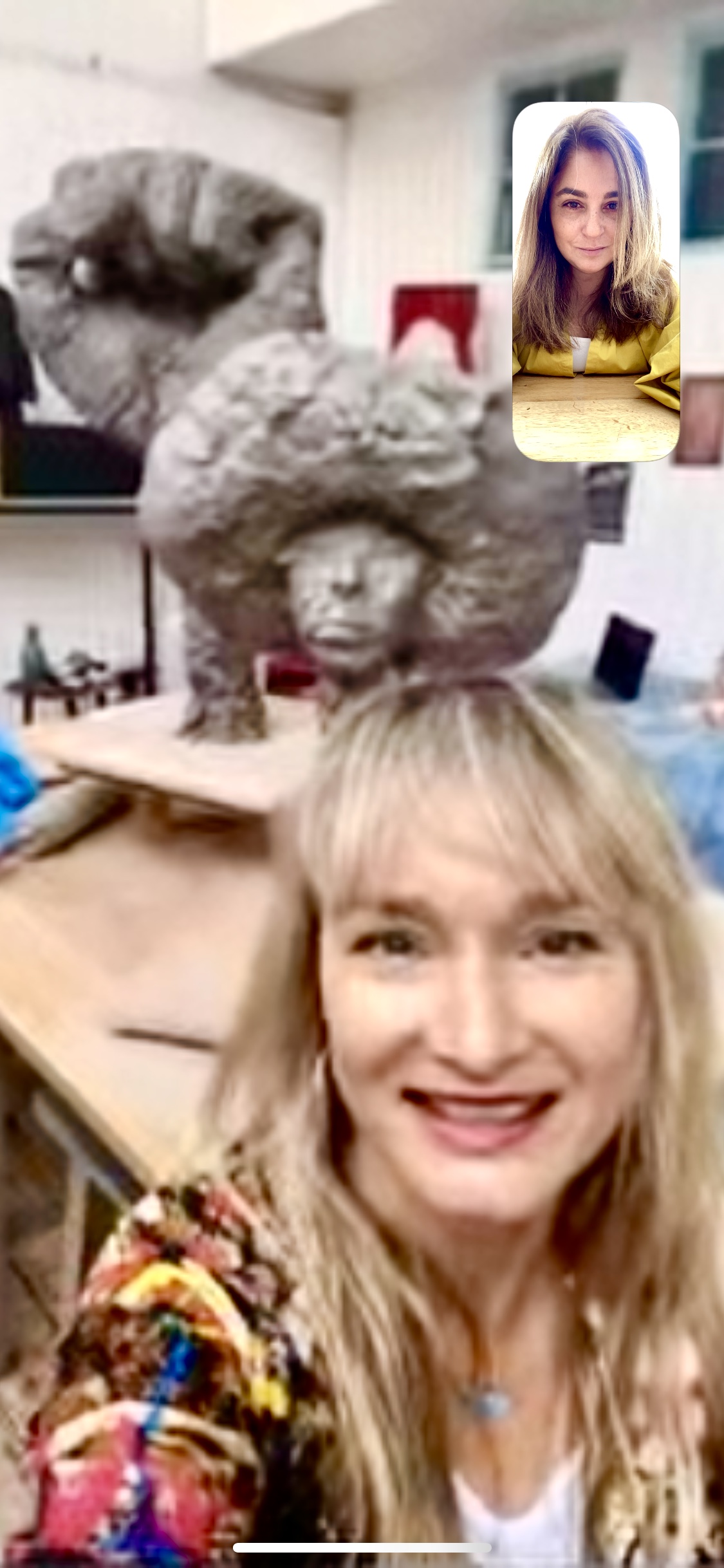
Karolina Woolf
June 9, London, Home
The ‘hand’, in recent months, has taken centre stage in my work and thinking. Don’t touch your face. Don’t touch surfaces. Don’t touch your loved ones. Don’t touch, period. During this last week, however, the symbolic value of the hand has shifted further afield, from being a victim of the virus, to becoming a powerful force in the Black Lives Matter movement. Raised clenched fists have emerged in response to the disproportionate police brutality experienced by the black population in the United States, and is now making its way across the pond, to the UK, where I reside – although I am of Czech origin.
The fist has a long standing symbolic value in the history of black power, as an act of collective resistance. In 1966, the Black Panther Party, founded by Huey P. Newton and Bobby Seale, used the fist as a symbol of black liberation in conventions and in rallies. And in the 1968 Mexico Olympic games, American sprinters Tommie Smith and John Carlos, both of whom received medals, each raised their fists wearing black gloves, while the national anthem played during the medal giving ceremony. They were both told off by the US American Olympics committee for having violated sportsmanship standards. Nelson Mandela, upon his release, after 27 years in jail, also raised his fist, triumphantly.
During the last few days, as a white privileged female artist, I have realised that I do not know enough about the Black Lives Matter movement; I have now made it a personal prerogative to learn more about its history and its roots.
Angela (Davis) came to me while I was watching documentaries and educating myself on the subject matter. She spoke to me, in more ways than one. And suddenly, the chance sculptural pairing of her head alongside a strong black clay fist took on a whole new meaning, as if by magic. I guess it was just meant to be. A confluence of global thoughts and energy, finding their way into my life and into the lives of my children, through the medium of my own two hands. I am now awake. I will now listen. I will now act.
- Margot & Rudolf, Bronze 60cm
- Angela, clay, 70cm
- Hand study
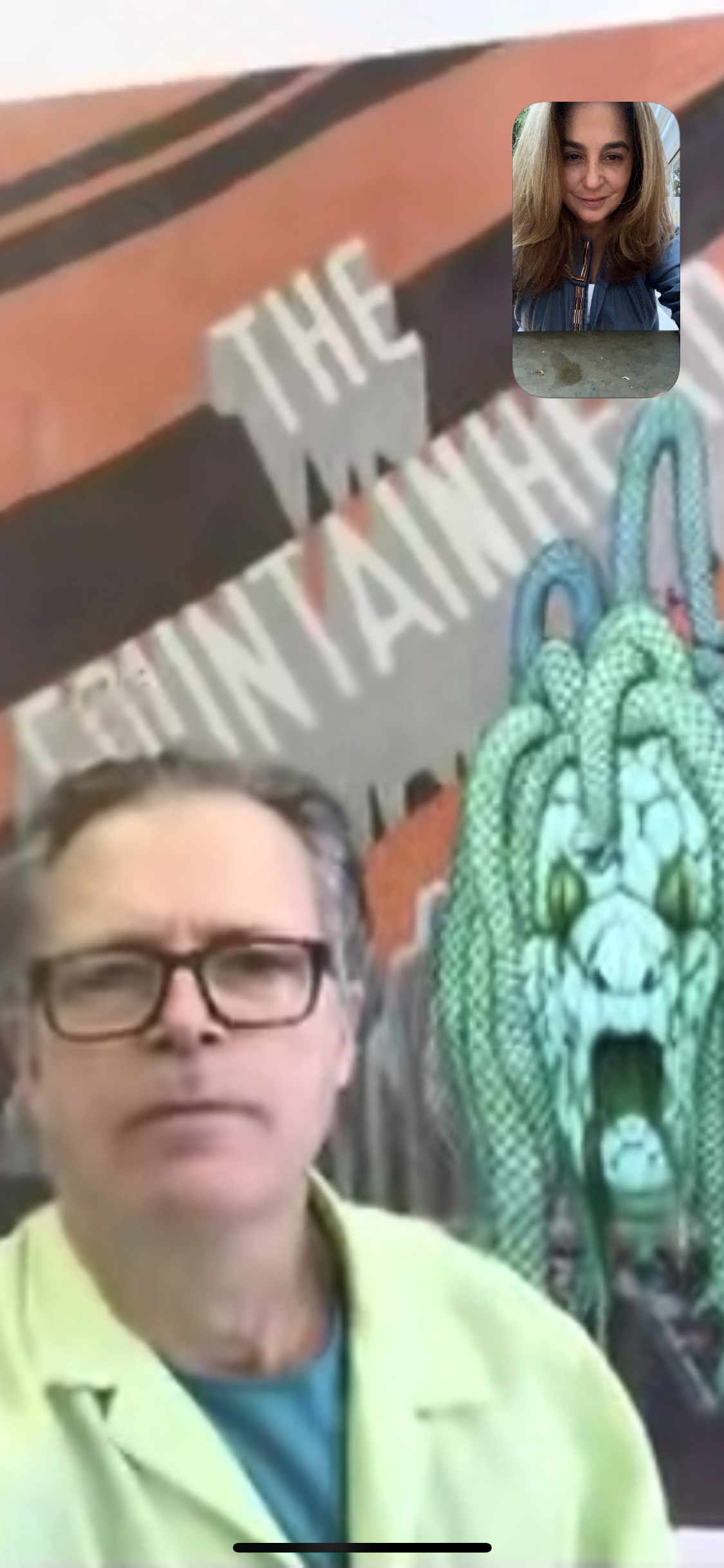
Jim Shaw
June 7, California, Home
It’s very hard to sum up one’s thoughts about what’s happening, since events are unfolding so fast that what we think reality is today might well be wiped out by events tomorrow.
Trump has governed by creating crises, then pretending to solve them, and is faced with a series of unintended consequences he has no control over, other than to mime control. And that’s the good part.
While I am too old (67, part of the Covid target audience) and too aspergerian to effectively take part in mass demonstrations, I can be inspired by the size and endurance of the protests and vigils that are happening these days. In the past, I’ve been awed, as huge crowds of citizens gathered in eastern European capitals, managing to change their governments; I knew this couldn’t happen in the US, as the country is built on keeping everyone so busy, so ambitious or so indebted that they couldn’t afford to take that much time away from their work/careers to effect change. But Covid opened the door, with so many people out of work and not caring about a career of teleconferencing (if they’re lucky enough to still have work). The dystopian/ conspiracy theorist in me, however worries about the hoovering and facial recognition software that will be put to use to find the “perpetrators” in those crowds, in order to take away their voting rights, or worse. All those Silicon Valley techno-libertarians who bought survival bunkers in New Zealand can flee the crowds whom they fantasise coming (with pitchforks and torches) to get them. This feels like a preview of the Silent Green future we’ve been promised, and my fear for many years has been that the totalitarians would seize upon the moment to enact martial law, if they haven’t already. But, weirdly, at this moment, it looks like Trump, Putin and Bolsonaro are all failing too publicly to survive…let’s hope it’s not a mirage. For me, the only thing making Trump better than Bush/Cheney, is that he hasn’t started a war to get re-elected (yet). He may have started a civil war, though.
In the early days of the Covid lockdown, I was personally experiencing a certain mellowness I hadn’t felt in years. Los Angeles was quiet and the streets were drivable, the air breathable. All that made our city a hell hole normally, turned out to be a bit of an advantage in a pandemic (hard to use mass transit, spread out living quarters, endless sunlight). I was still methodically working, but the shows and art fairs that were the presumed destinations of my works were being cancelled or delayed, and I was feeling a sort of retirement rhythm in my life, but soon, requests for online fairs and digital content began to flow in and eventually, it was back to semi-normal deadline worries with all the complications of social distancing added in. Then, with George Floyd’s murder, on the heels of so many other racial atrocities and so many social disparities laid bare by Covid, it all slowed down again, with time to reassess. Maybe things will get back to normal, but normal sucked. I’m glad that young people have the energy to take matters into their own hands, but beware all the Steve Bannons and Steven Millers of the world: smart people on the left tend to lean towards college careers, whereas on the right, there are lucrative think tanks and Fox News. Many minds are working to free us from all the damage they imagine was unleashed by the Frankfurt School because we can be assured they are also combing through the laws to obstruct progress and rejiggering their philosophies to retake the advantage.
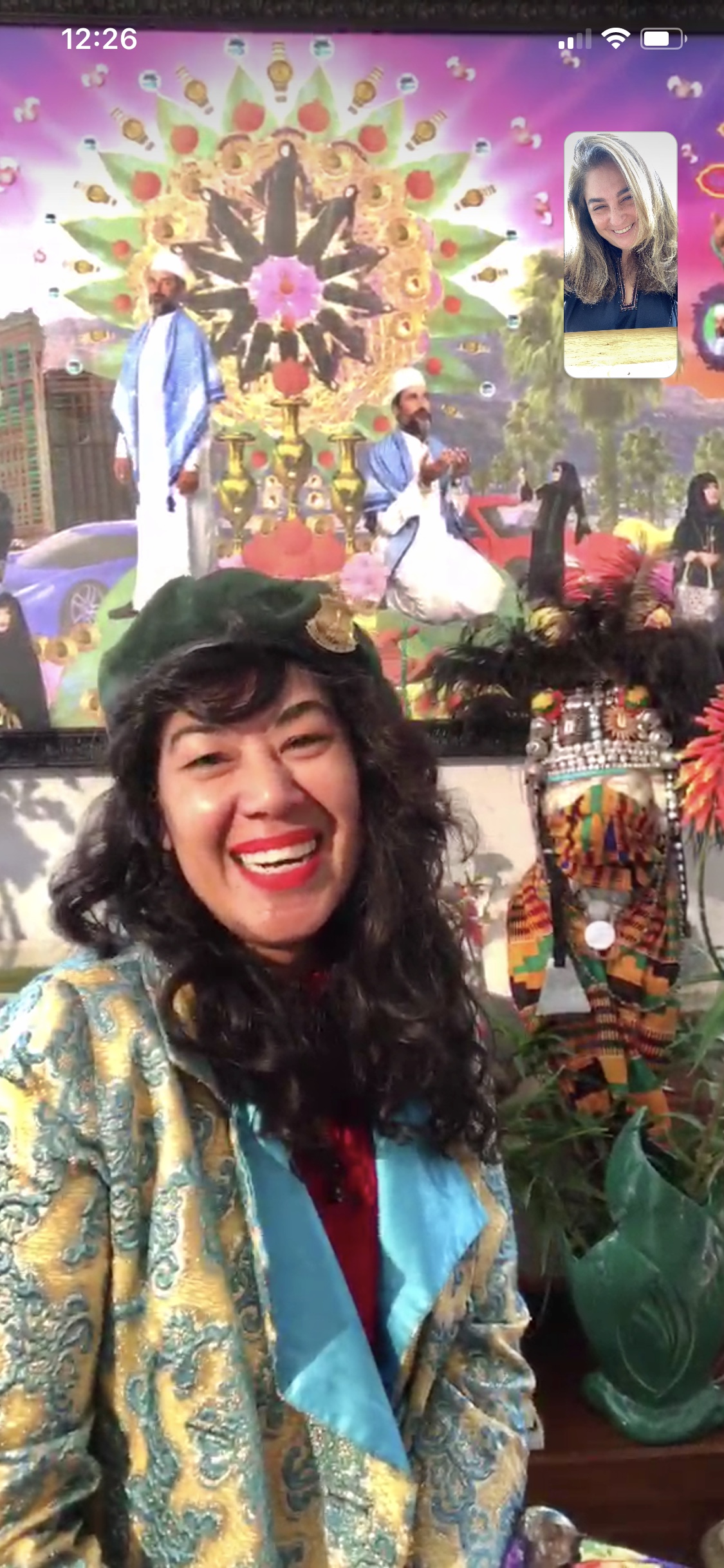
Thania Petersen
June 6, Cape Town, South Africa, Studio
I CAN’T BREATHE
The last words uttered by a dying man.
The words penetrate my skin and seep deep into my soul,
Transcending time, overshadowing pain.
Death and DIS-EASE lurks.
I vomit the trauma carried in our mothers bellies onto the streets and realise that her life mattered
That my life matters
That this life does NOT matter.
We have been sacrificed to instil and uphold a system that suffocates us
We will now sacrifice ourselves to take it apart so
OUR CHILDREN CAN BREATHE
DEATH IS LIFE AFTER ALL.
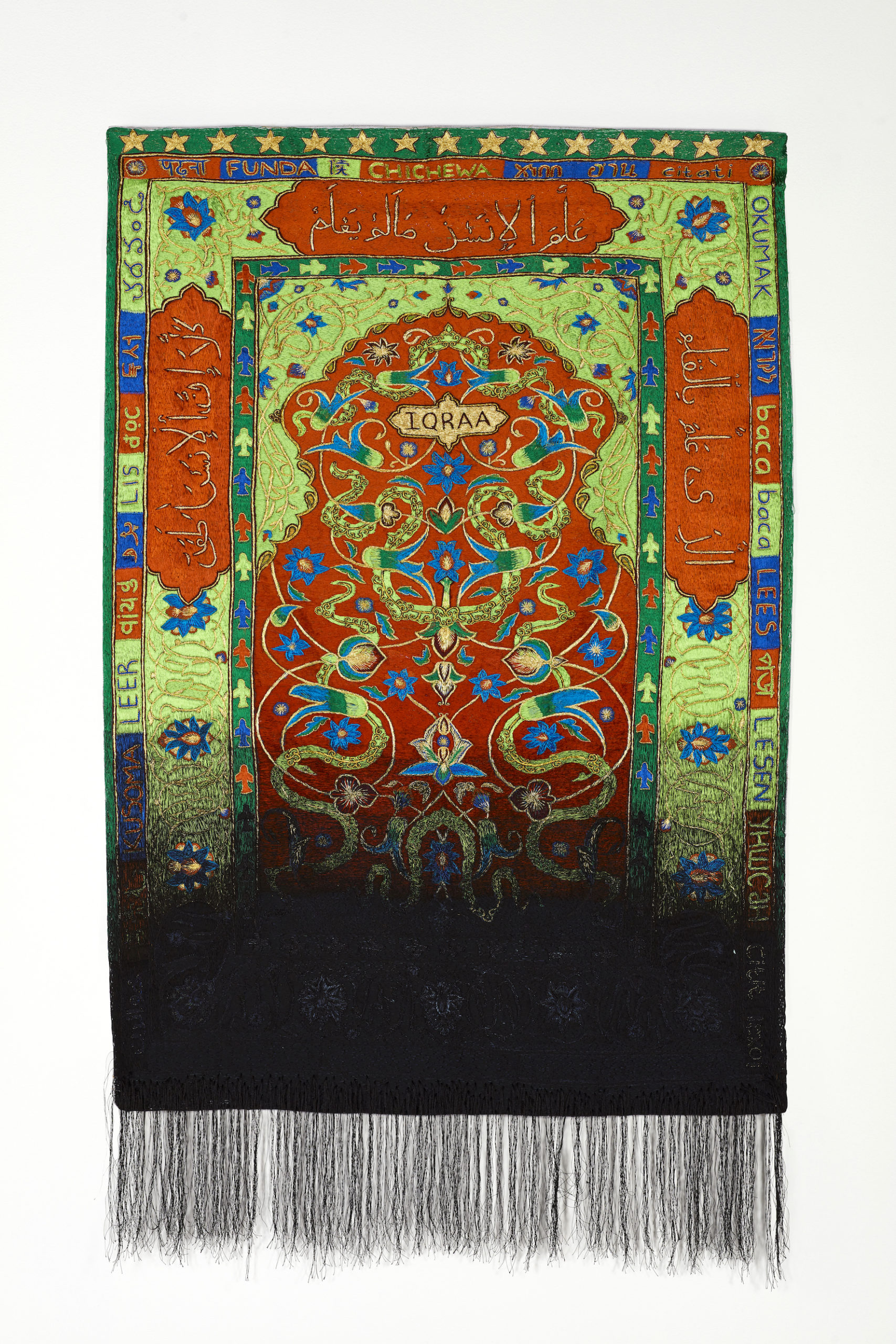
Petersen’s prayer mats are the mediums through which she considers the lethal infiltration of extreme religious dogma. What is distinctive about these mats is the way in which black thread seeps into a joyful, colourful landscape. Her solution is education: ‘We must learn to read,’ she says, ‘we must interpret the world in a more beneficent and inclusive manner.’
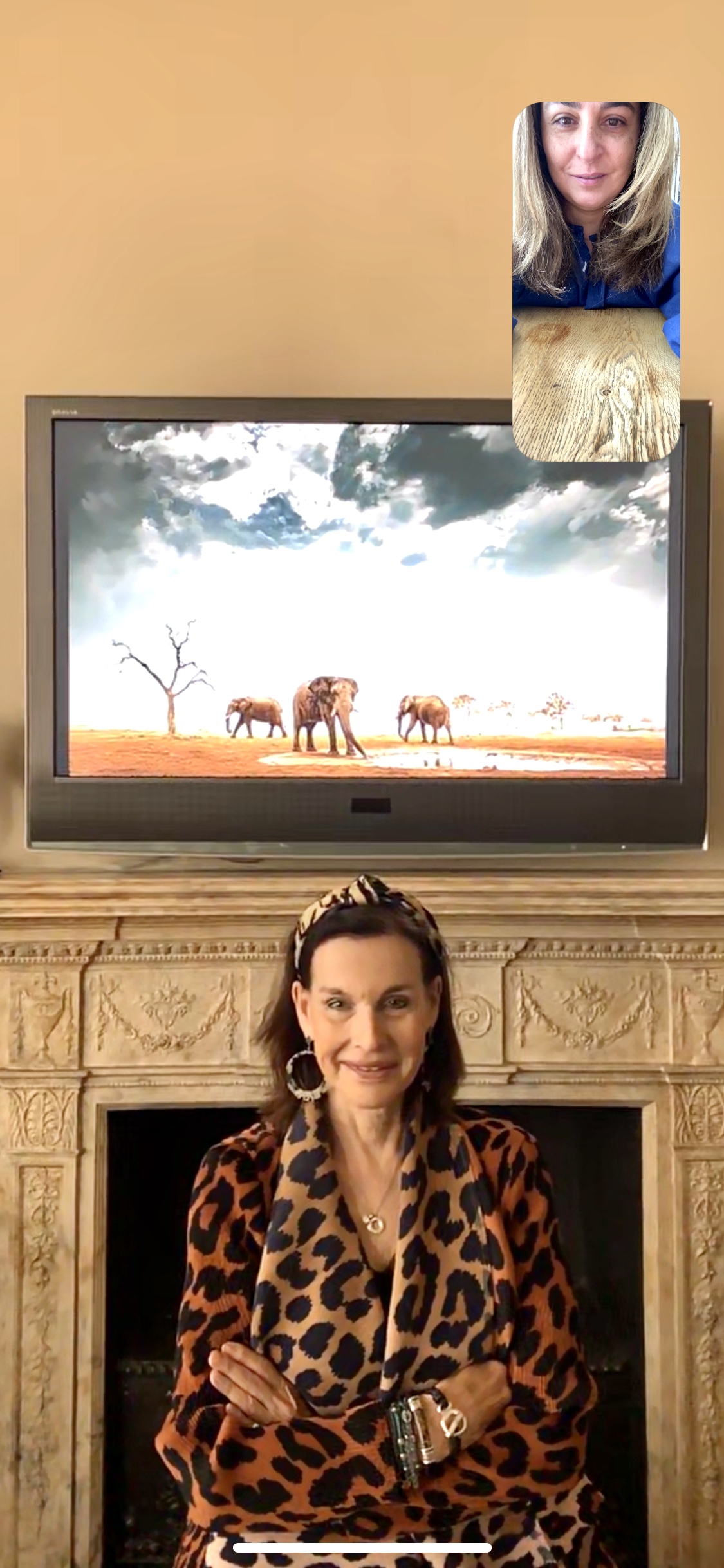
Michou von Beschwitz
June 6, London, Home
I have always felt a deep affinity and connection with animals, which is why I chose to specialise in wildlife photography for the last decade.
Covid-19 has drawn attention to the precarious balance between humans and the natural world. The wet markets, where it is said to have originated, are hell on earth for animals. I cannot help but see the virus as nature’s revenge – forcing us back indoors so she can inhale and exhale freely without our heavy presence for a while. I am happy that Mother Nature is getting a breather. Saying that, I look forward to getting out into the most fascinating and remote corners of our big wild world again, and tracking some of the magnificent creatures that roam the planet.
With reference to this image in particular, I pray that Africa’s National Parks can survive what has been an immediate and staggering overnight loss of income. Due to food shortages, the poaching of wildlife has dramatically increased.
@michouvonbeschwitz
michouvonbeschwitz.com
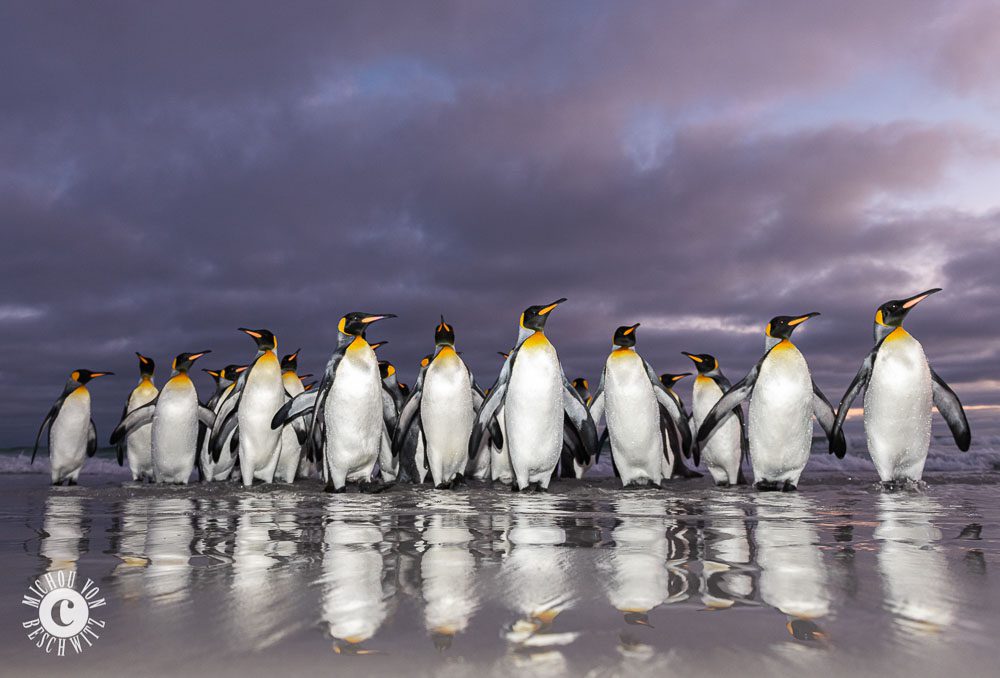
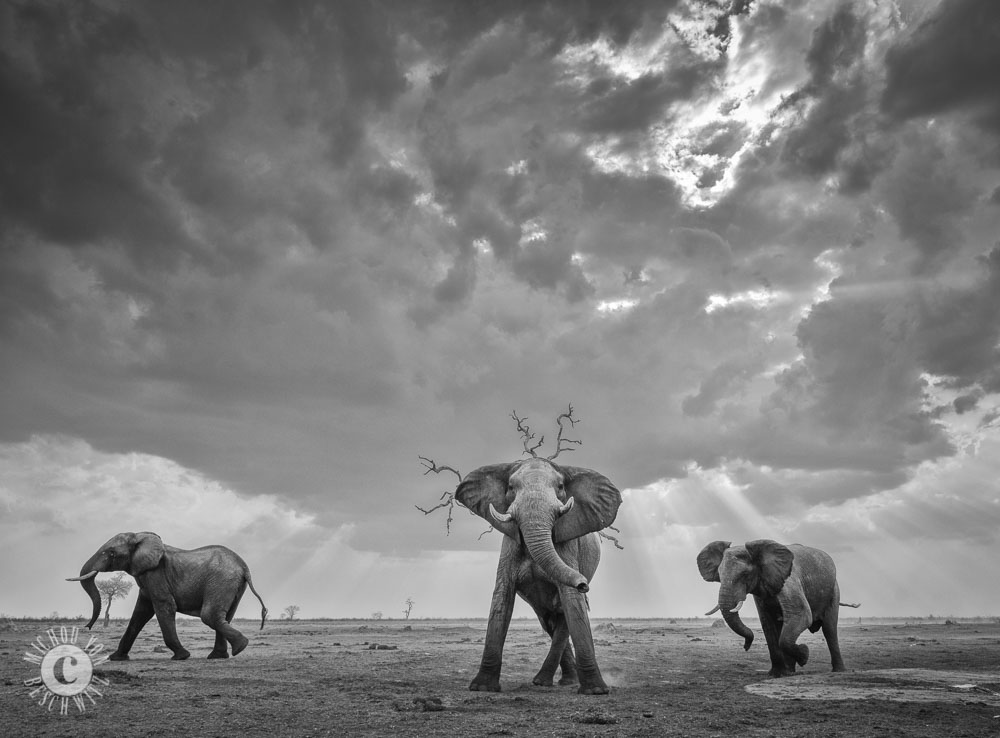
Three elephants pose for the camera in Savute, Chobe National Park, Botswana
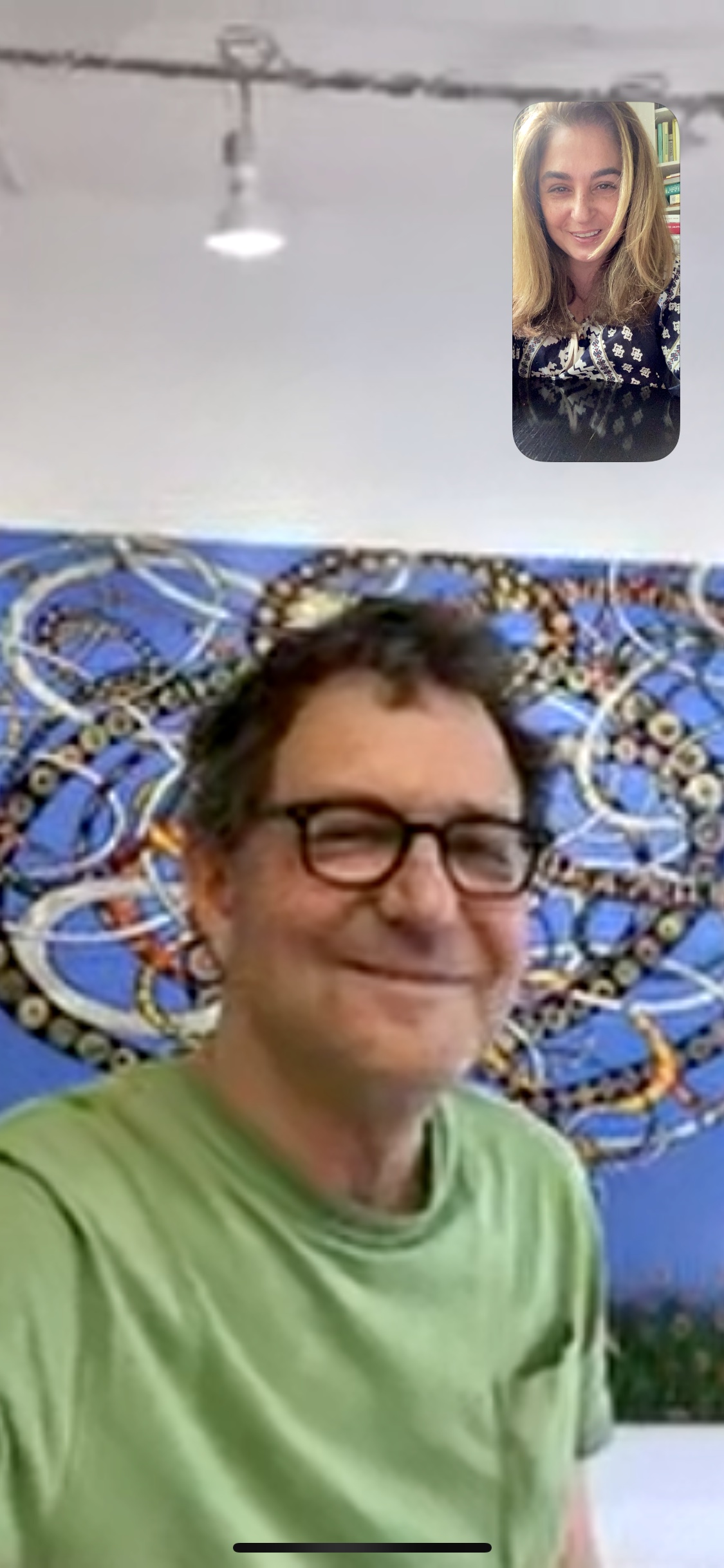
Fred Tomaselli
June 4, East Village, New York City, Studio
Before Covid, I was working night and day in my East Village studio towards a show at James Cohan Gallery that was supposed to open on May 8th. The work consisted of large resin-collage paintings that incorporated news text from our ongoing global emergency. I was attempting to wrestle with the friction between the aesthetic play in the studio and the greater pathologies outside of it. By early March, my studio assistant had fled to Vermont, and New Yorkers were ordered to stay at home.
I quickly gathered a few art supplies and set up a bedroom studio in my East Williamsburg home. While it had been a year or so since I had worked with the front page of the NY Times, I could not ignore what was happening. The resulting drawings are both a deep dive into, and an escape from the current situation. It was a real shift to what I was working on just before everything went crazy, but it feels necessary to be working through this while events unfold. Even though I’ve been working almost every day, it’s been slow, but the 10 or so drawings I finished will most certainly be part of my show, should it open in September (I’ll believe it when I see it).
During this time, I was riding my bike to the East Village studio every few days, but it was mostly for the exercise, or to pick up some art supplies. I’m just now getting back to the studio on a more regular basis. I’m attempting to complete some of the larger pieces I was working on before Covid and rioting turned everything upside down. I’m rewarming to these works from the “before times”, but after almost three months away, I feel the need to take a few left turns in these works. I’ve also been attending some of the protests and tending to my garden, while continuing to work at home on the NY Times bedroom drawings. All of these activities, together, are helping me stay sane in this unprecedented time.
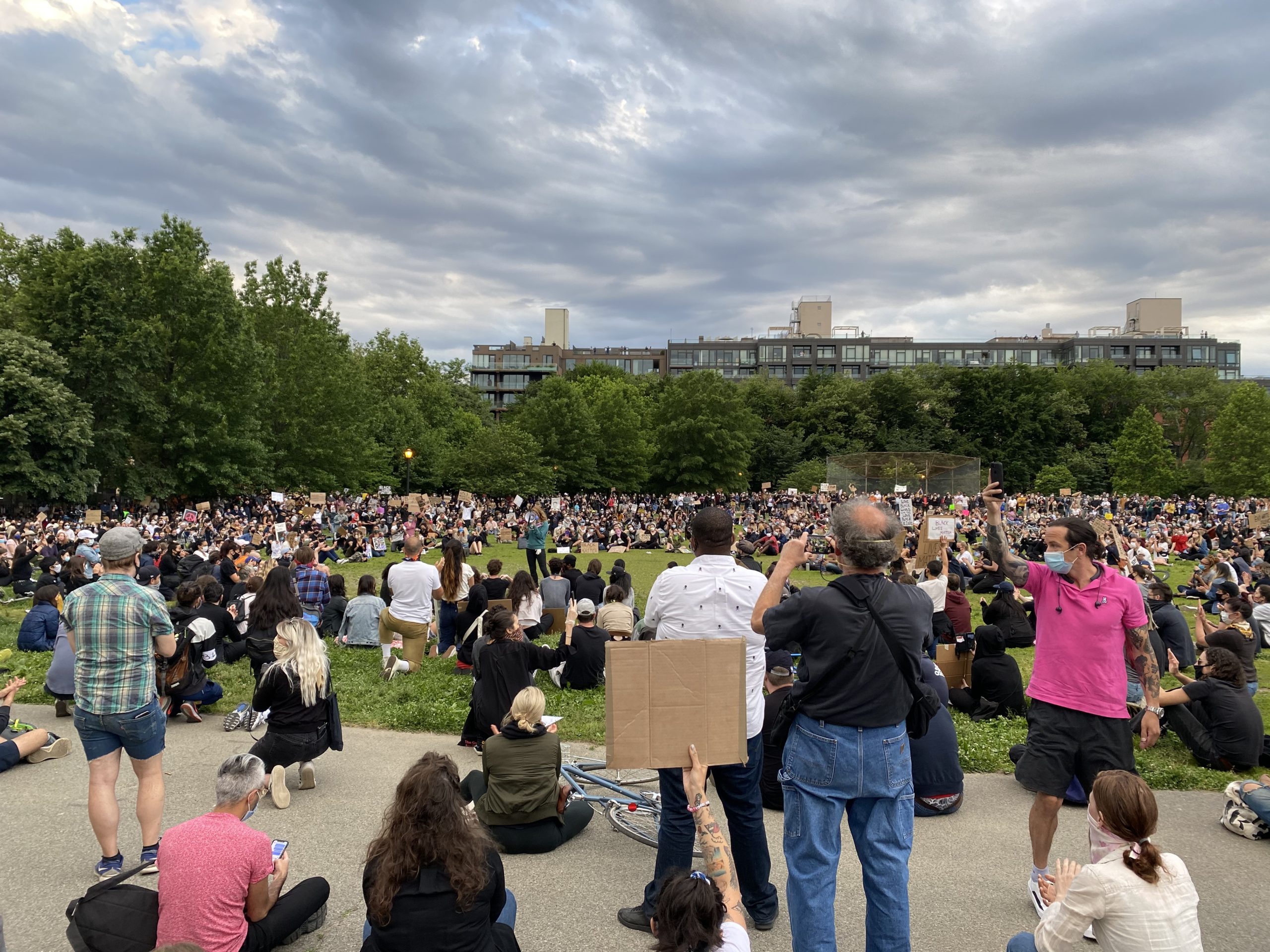
A silent protest last night in our local park.
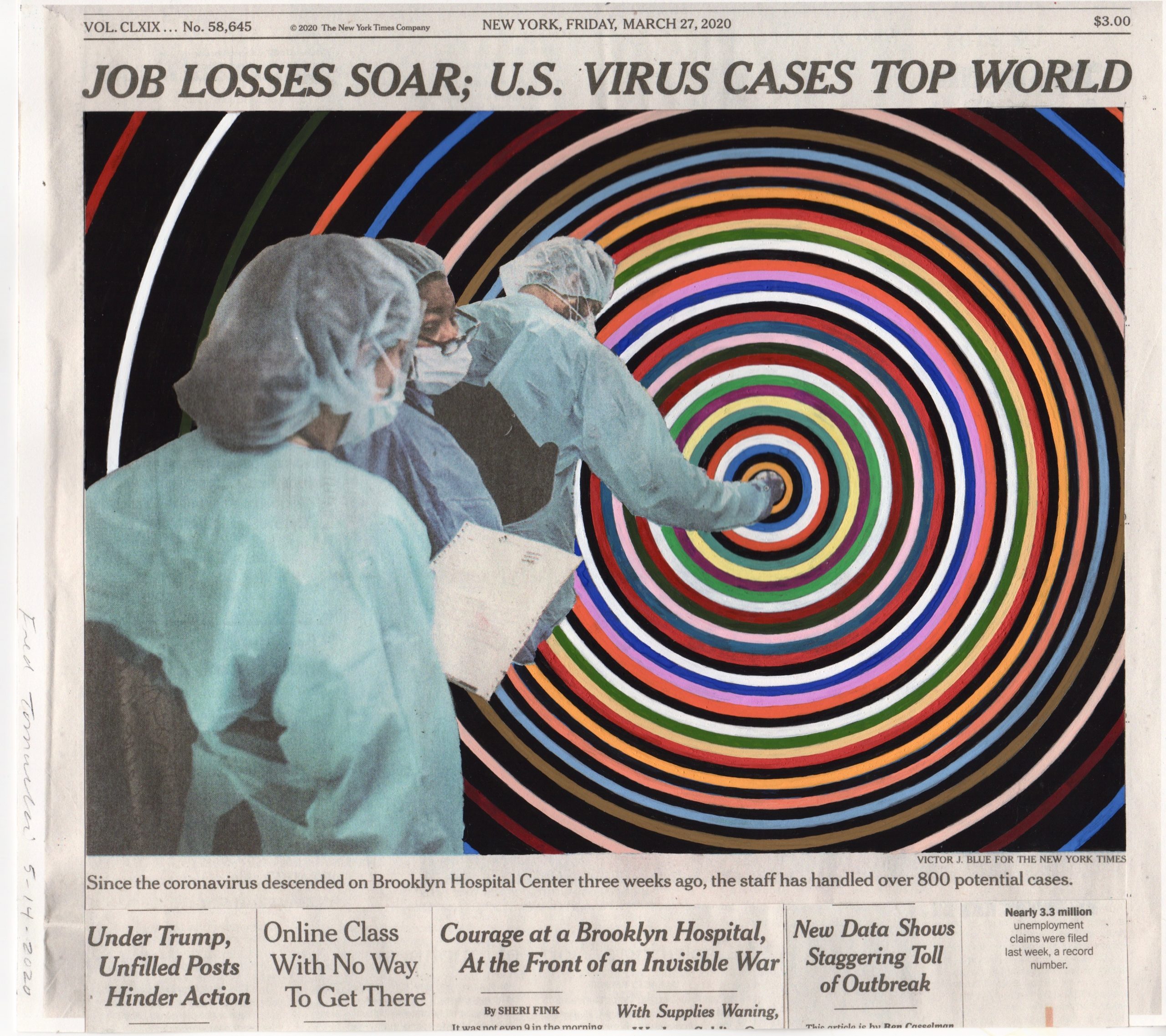
March 27, 2020, 11×12”, gouache, collage and archival inkjet print on watercolour paper.
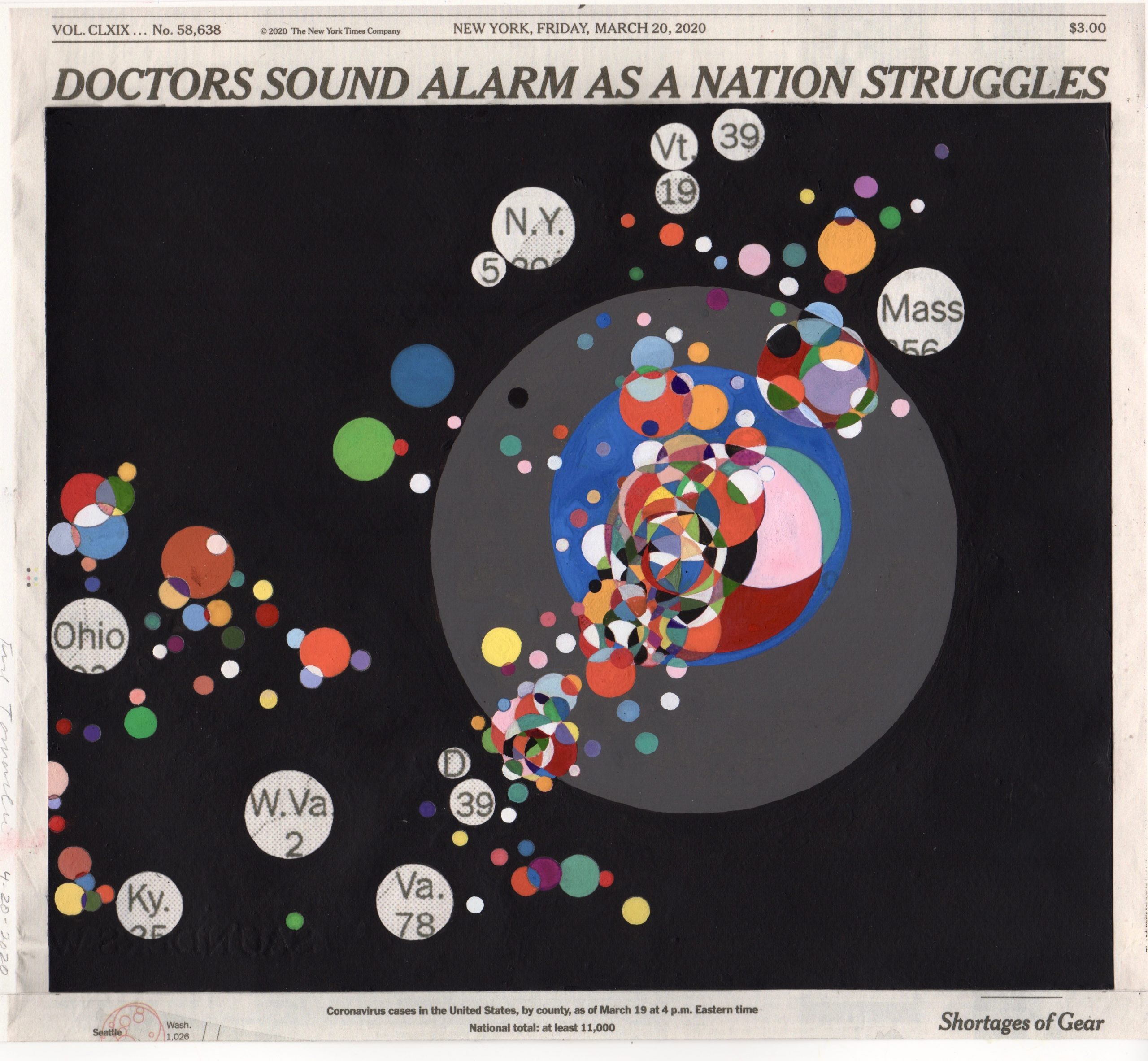
March 20, 2020, 11×12”, gouache, collage, archival inkjet print on watercolour paper
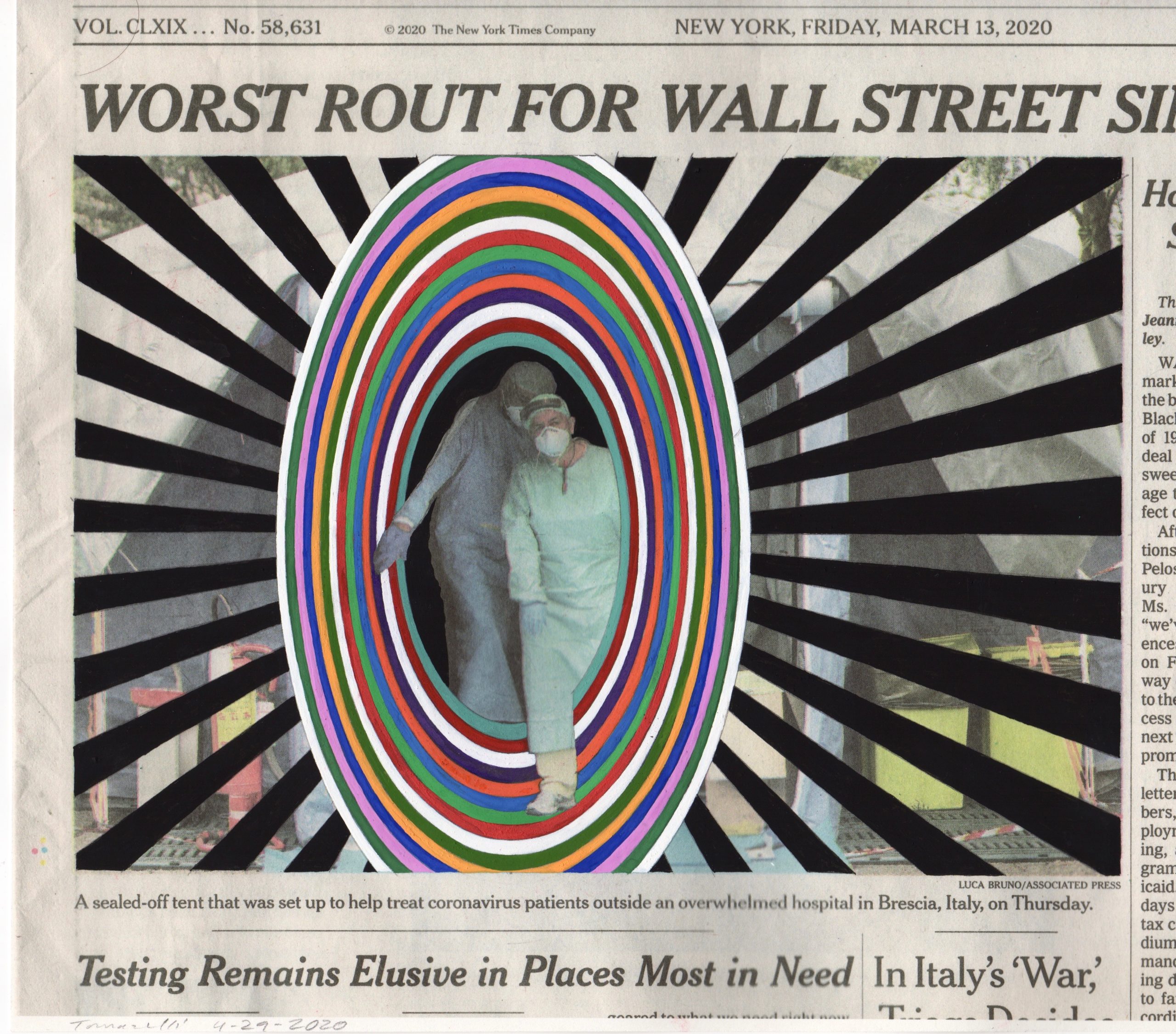
March 13, 2020, 11×12”, gouache, archival inkjet print on watercolour paper


Chris Levine
June 4, London, Home
Fear.
Anxiety.
Dis ease indeed.
The crazier the world, the more we need refuge.
We can’t go outside…then let’s go inside.
Deep inside.
Meditate don’t medicate, and this too shall pass.
Real peace is within. We can do without.
@chrislevine_light
chrislevine.com

#Compassion screen print produced by #JealousGallery (portrait of the Dalai Lama) to raise funds for the @trusselltrust which supports 1200 food banks nationwide in the UK.
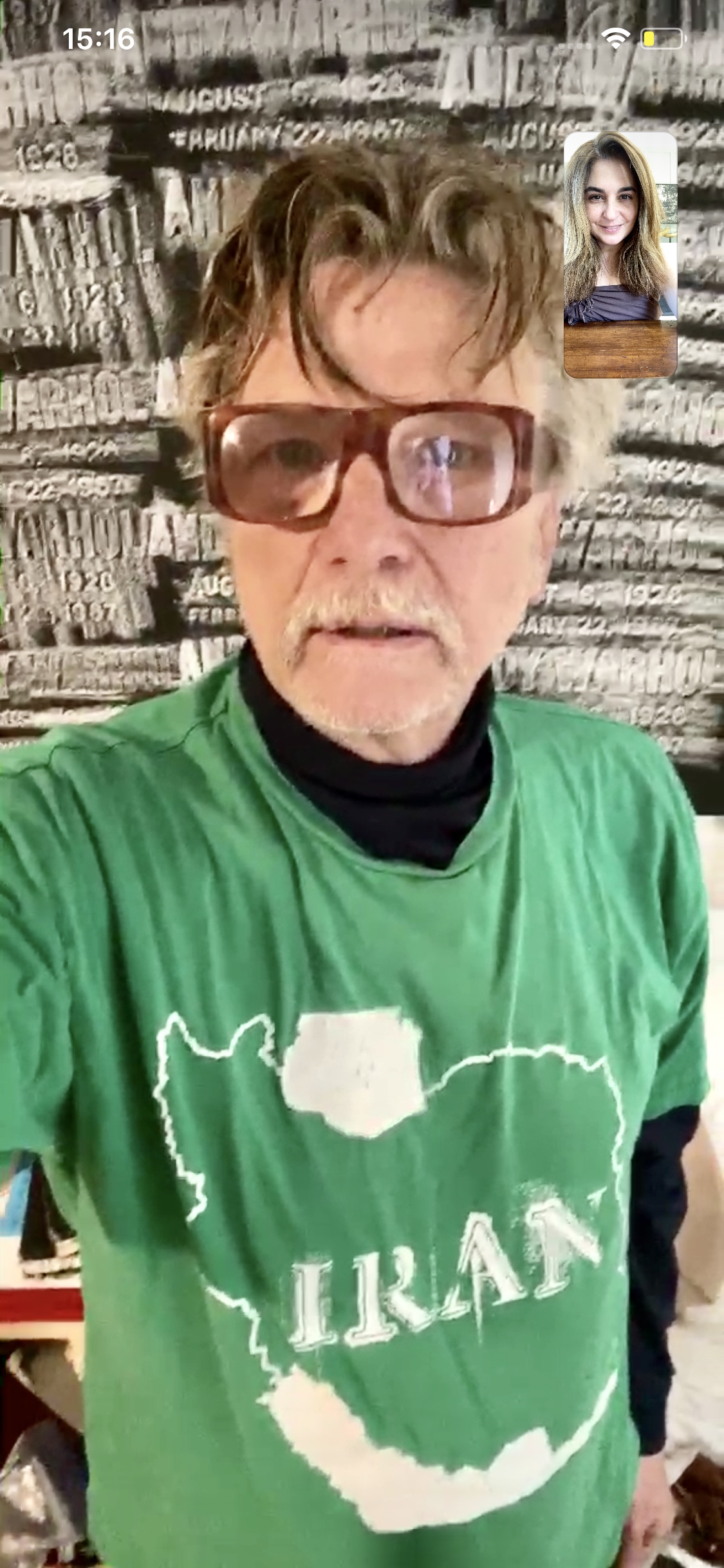
Scott Covert
June 3, Harlem, New York, Home
There are too many people on the planet. It was 1804 when the population reached one billion. Two hundred years later, we have over seven and a half billion people. We are a fast spreading infection covering the earth.
We don’t even know what Earth is. I bet it’s more like riding on the back of a turtle than what you would have thought.
She’s not happy.
Look at her skin.
She’s a mess.
Her polar caps are melting.
A powerful polar shift and….everything will be cleaned up… swish, and we’ll all be gone!
This plague that stopped the planet, is it going to kill me? Do I need to be tested? For what? Does anyone know anything? It’s not on surfaces anymore, it’s airborne. Should I wear a mask? It hides your identity from surveillance cameras and it’s being polite so as not to compromise people. It reminds you not to touch your face. If you want to protect yourself from the virus, I would suggest the full Burqa. All women and men should all be under the veil. BAGISM!! Google ‘ Bagism’. John Lennon, Yoko Ono, The Dick Cavett Show. Liza, you’re right, the world goes round and round and round. We will all be under the Burqa, safe from germs and taking a step to end misogyny in the Middle East. Women should be taking over the the world, right?
This quarantine has made me see this little machine in my hand under a new light. I just squeezed out an astrologer, Roland LeGrand of ABLAS. With a name like that, I listen. He talks about the year Twenty Twenty. And then your sign, this year, which has an alignment with Saturn, Pluto, Jupiter in Capricorn. Oh oh, whatever that is; he makes the second half of twenty twenty, Helter Skelter, imagine that!
Trump is marking his place in history. He wants to make it as large as it can be. How he will change history… This coming election will be entertaining. It would have been sensational if Oprah ran against him. It’s a question of ratings – who wins?
O 2020! OPRAH 2020. The graphics would have been spectacular.
The Black Vote? Back in 1917, oops, I mean 2017, down in Alabama, for some sort of special vote for a senator. African American women came out to vote for Doug Jones, a Democrat and he won. So today, I feel President Trump is a great threat to our democracy. Tell me what he had to talk about privately with Putin, and the rocket man in North Korea. We are sort of dependent on the African Americans to vote for our freedom, right?
We got Old Joe Biden.
Good Old Joe.
Should get Stace Abrams as Vice President, and she can figure out REPARATIONS, for African and Native Americans. That would be nice; it’s about time.
Then, I found out about the locusts in North Africa going round and round. Then, I saw the sky rip in half, pulling along the rosy tips of dawn, over a butchered horizon. Then the UFOs appeared, filling up the sky. They are gold, encrusted with cut jewels, leaving trails behind as they moved. They look like Hindu temples. Architectural gorgeousnesses with terraces and lush gardens, floating. Something is telling me these next six months are going to be very interesting.
Death becomes me. I make these large abstract paintings, and each brushstroke is a lifetime. As you recognise the lives I use, you will understand that in order to make these large abstractions, I had to travel all over the planet. I sneak into cemeteries, creating my printing press on the grave. When you stand in front of the painting, I hope you appreciate the time you are spending, looking at my work.
Scott Covert at work at Houdini’s grave at Machpelah cemetery in New York:
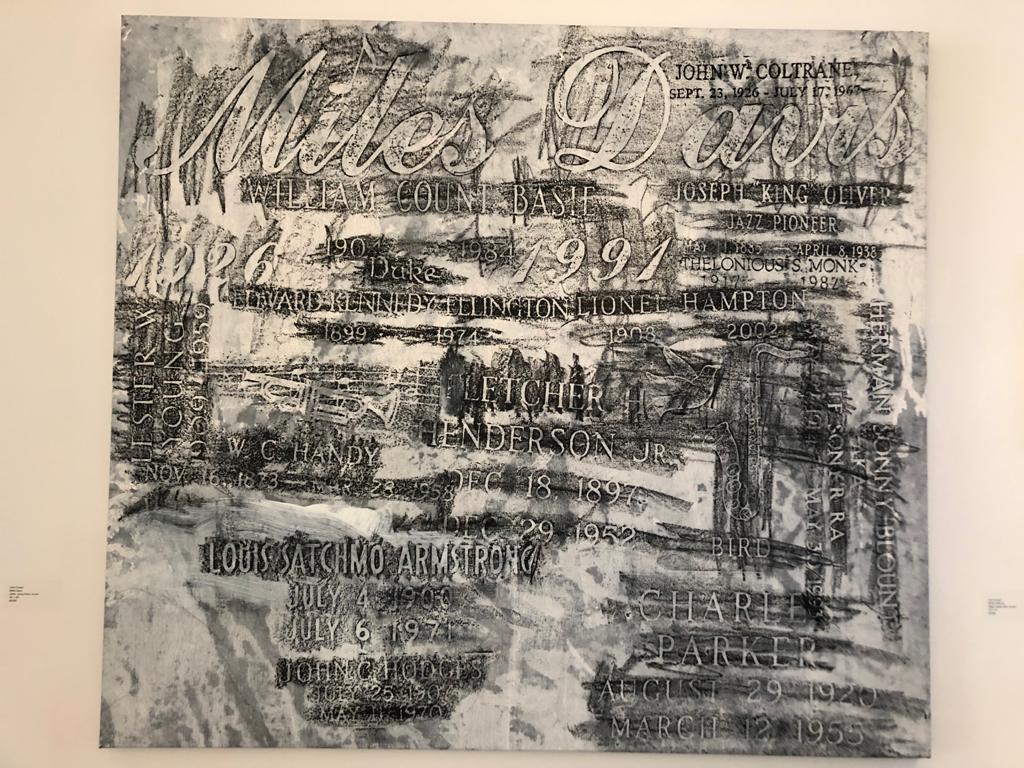
‘Jazz ‘ artwork by Scott Covert with a listing of the dead cast (composed of imprints from the various personalities ‘ tombstones): Miles Davis, John Coltrane, Count Basie. King Oliver, Duke Ellington, Lionel Hampton, Thelonious Monk, Lester Young, Sun Ra, Fletcher Henderson, W. C. Handy, Charlie Parker, Louis Armstrong
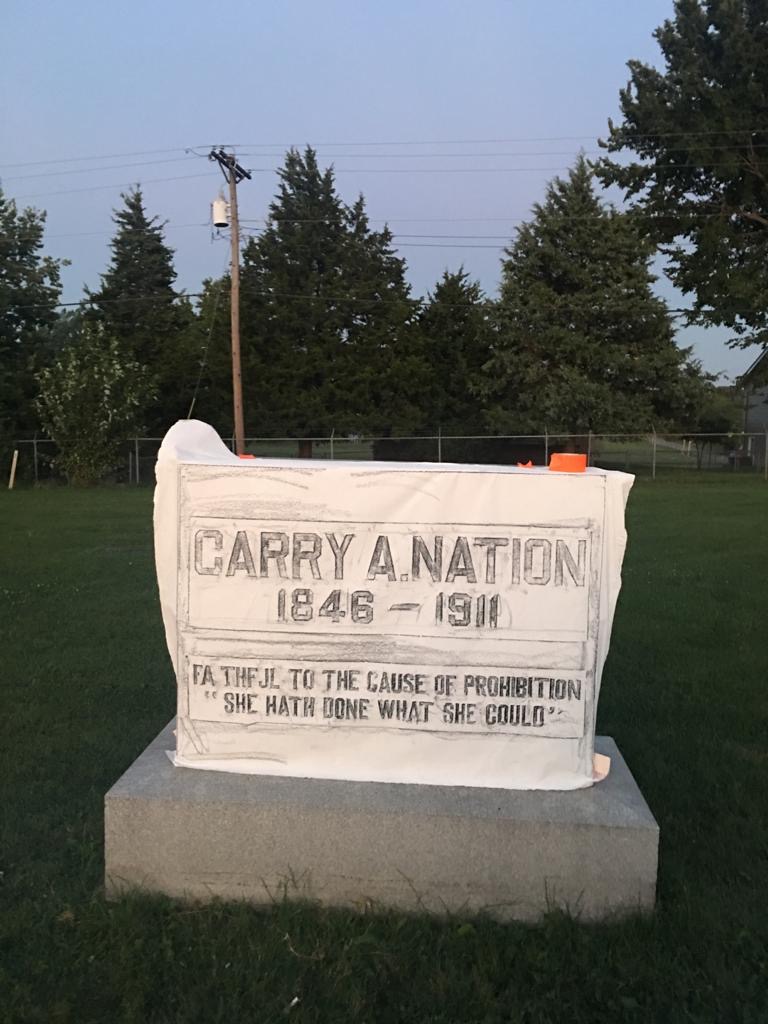
Carry a Nation. Tombstone of an abolitionist. Image by Scott Covert
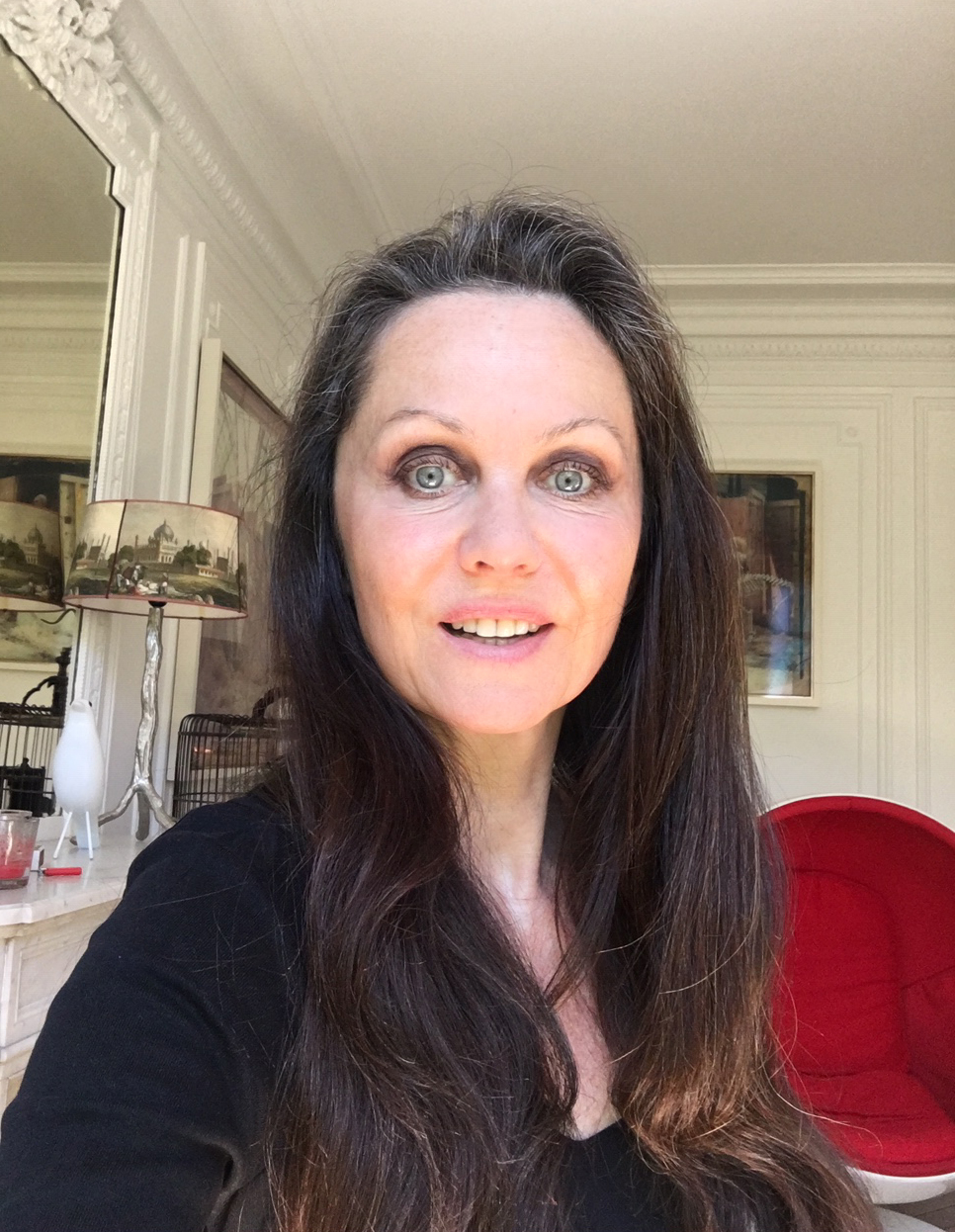
Cathleen Naundorf
June 3, Paris, Home
Back to normal? Was how we lived before considered normal?
Higher, faster, more! That was then. Now, our whole system is collapsing.
As humans, we have realised that nature is stronger than us.
Personally, the lockdown has not been a big deal for me. For fifteen years, I was a travel photographer, and I shared my life with ethnic groups all the way from Amazonia to Siberia onto Kazakhstan.
I have experienced both the plague and yellow fever quarantines.
Isolation, disease, simple living and social distancing have all been part of my life routine.
Lockdown was simply time off, a break to re-evaluate my life, and to think about creativity as well as new projects, all the while listening to birds singing on Parisian roofs.
These are historic times! A first in my memory of human existence, when the world actually stood still. Even the industrialised nations were forced to shut down. For far too long have humans interfered with nature. It’s time to take a step back. The signs were in the making for years. Many chose to ignore them and turn a blind eye; personally, I saw them with my own two eyes throughout my travels in all four corners of the world. This slowdown and sudden silence offer a new chance to safeguard humanity. It is clear that this beautiful blue planet called Earth will exist, with or without us, so it is up to us to take action, if we wish to live with and on it. The preservation of the human race resides in our own two hands.
Back to normal? No, thank you. Not for me. It is now time for change and new horizons.
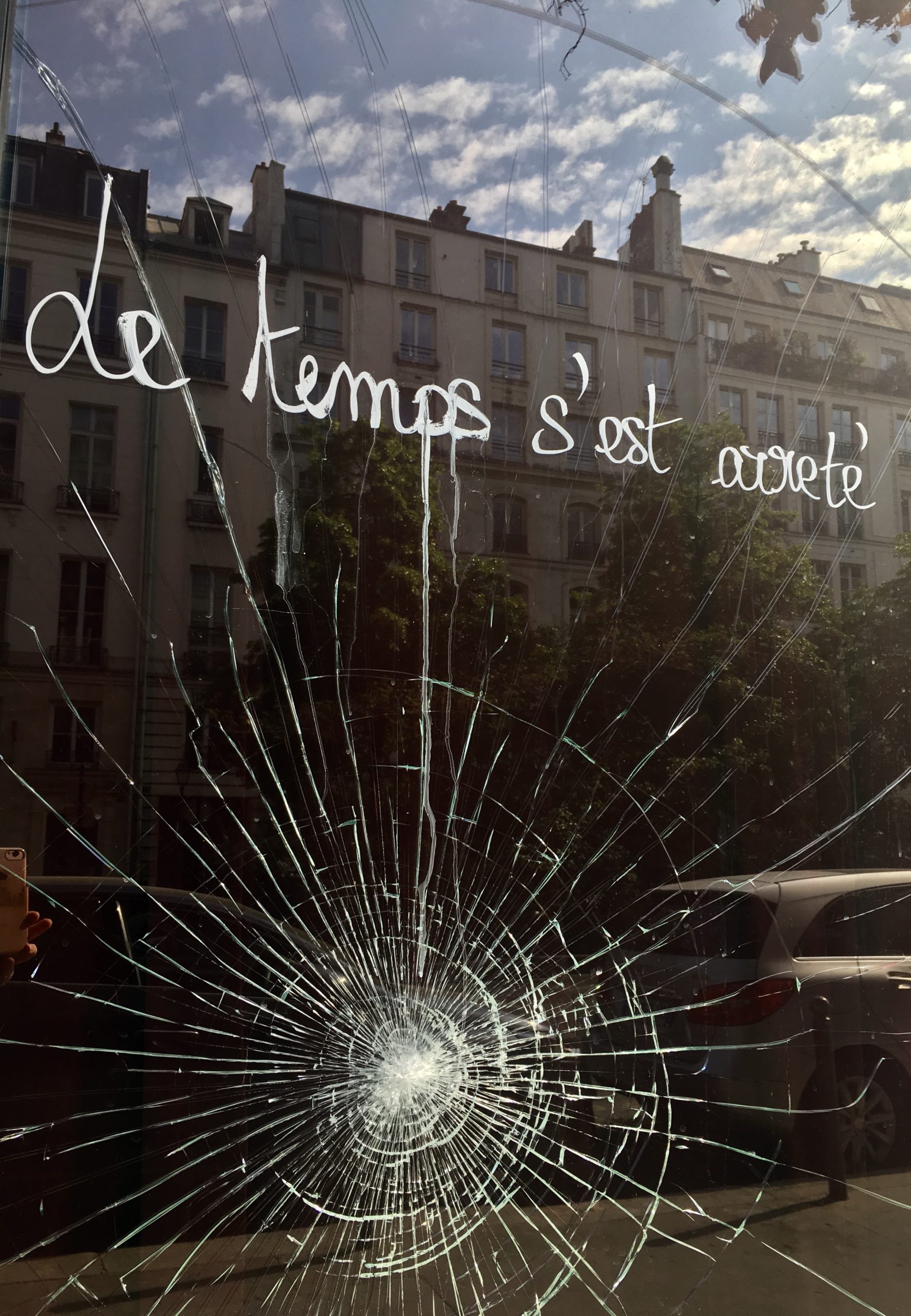
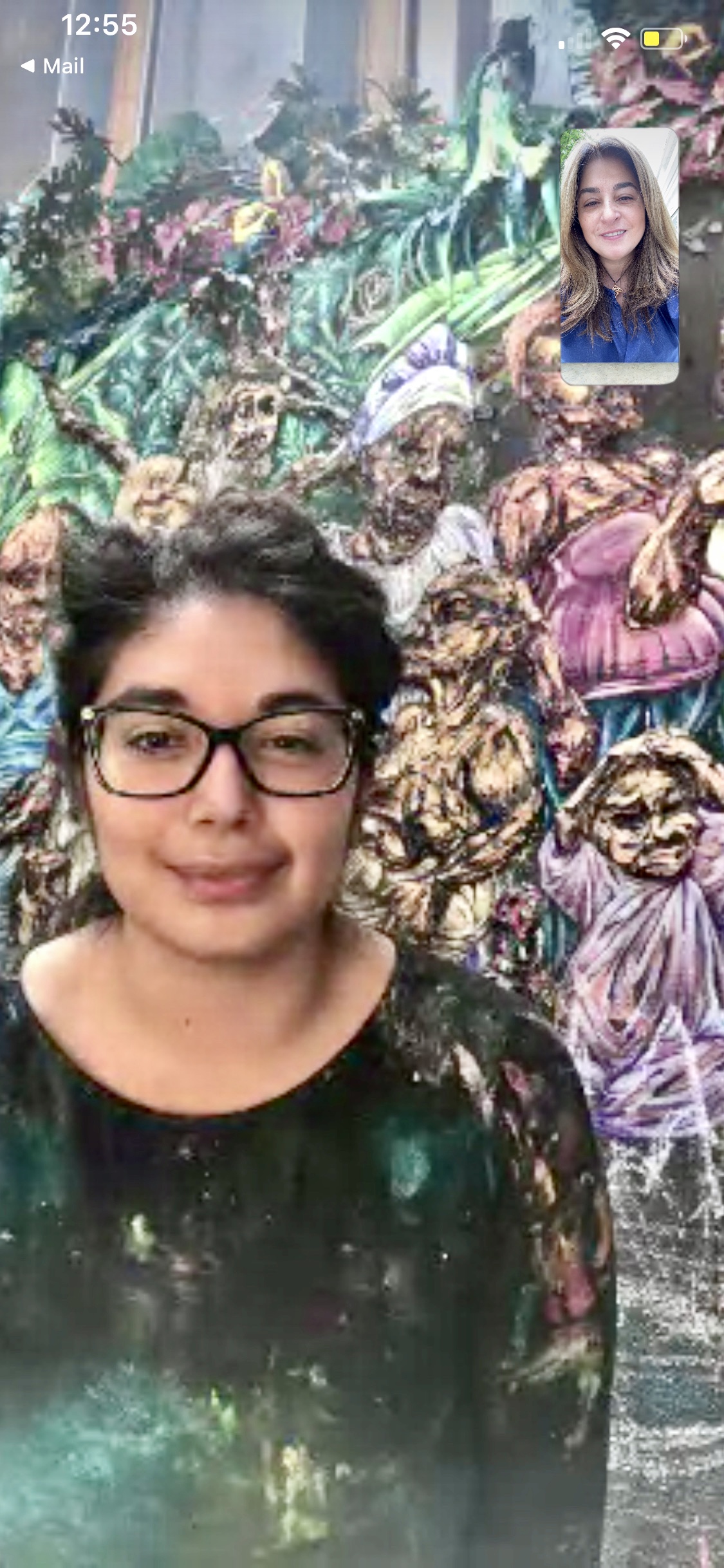
Raquel van Haver
June 3, Amsterdam, Studio
This piece is written in English by a translator after a visit to a lady I met during my last trip through the Amazon in Colombia. Our translator, Anton Bolivar Salvador, has since died of Corona because the whole caring system in this region boils down to one hospital which services 800,000 people. And the whole place is corrupt; you have to pay for a hospital bed. He was such a great guy.
The lady who sang these lyrics for me is a Huitoto woman leader, and I connected with her while researching female leadership in the Colombian region, connecting the stories with my personal history, thoughts, dreams and ideas. She is like an advisor, and she is also part of the indigenous guard.
I came alone,
When time is dangerous,
So much thunder
I came alone,
With a lot of lightning,
I came alone
Although the time is dangerous,
I came alone
@raquelvelascomartinez
raquelvanhaver.com
Huitoto woman chanting:
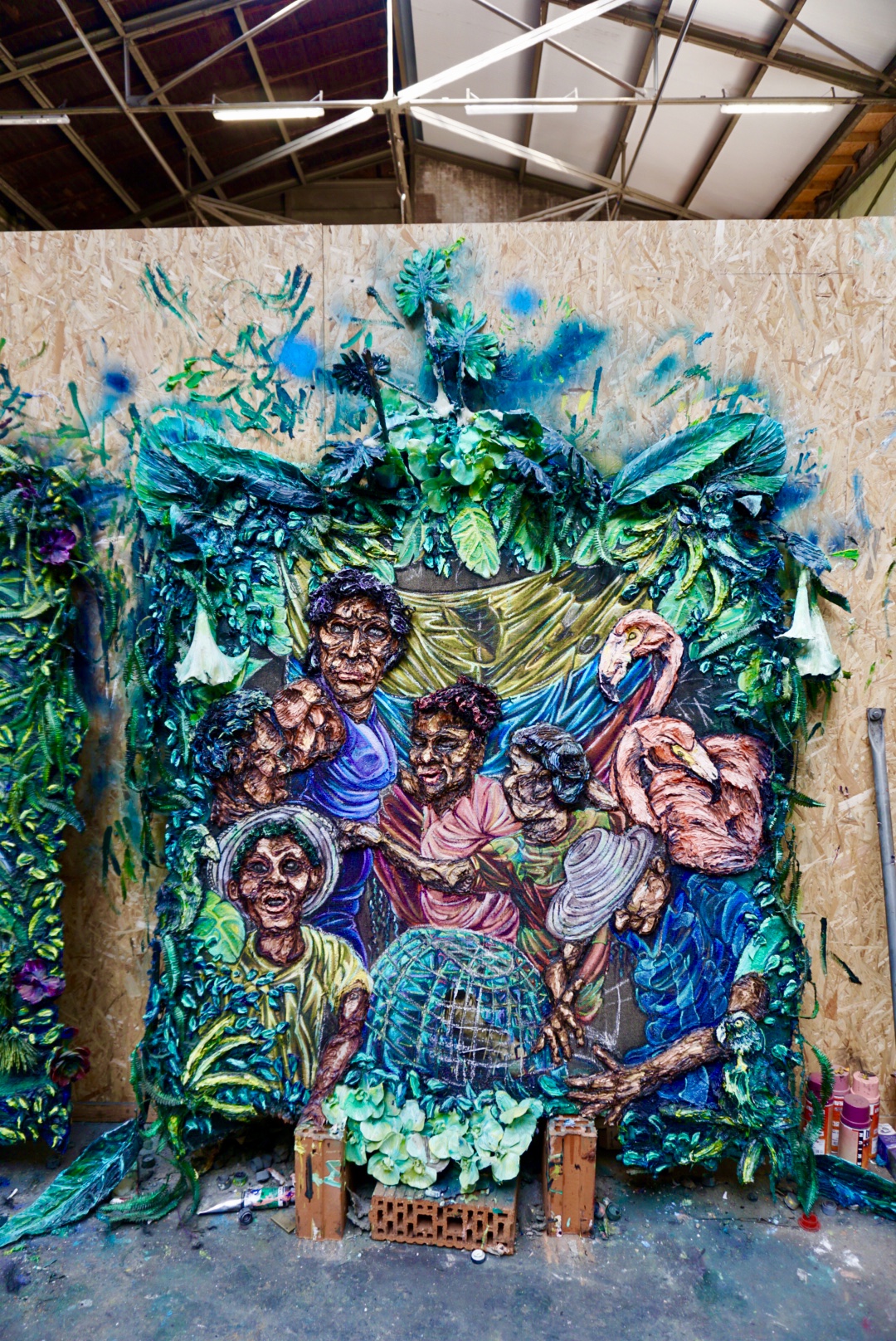
Oil on burlap with plastic flowers, raisin, paper, metal, bricks, chalk, charcoal and fake hair, 2019-2020. From the Amo a la Reina painting series which talks, in a mystical way, about leadership, womanhood and the transhistorical connection, as well as issues relating to the flora and fauna, migration, NGOs and holding on to new and old norms, values and culture.
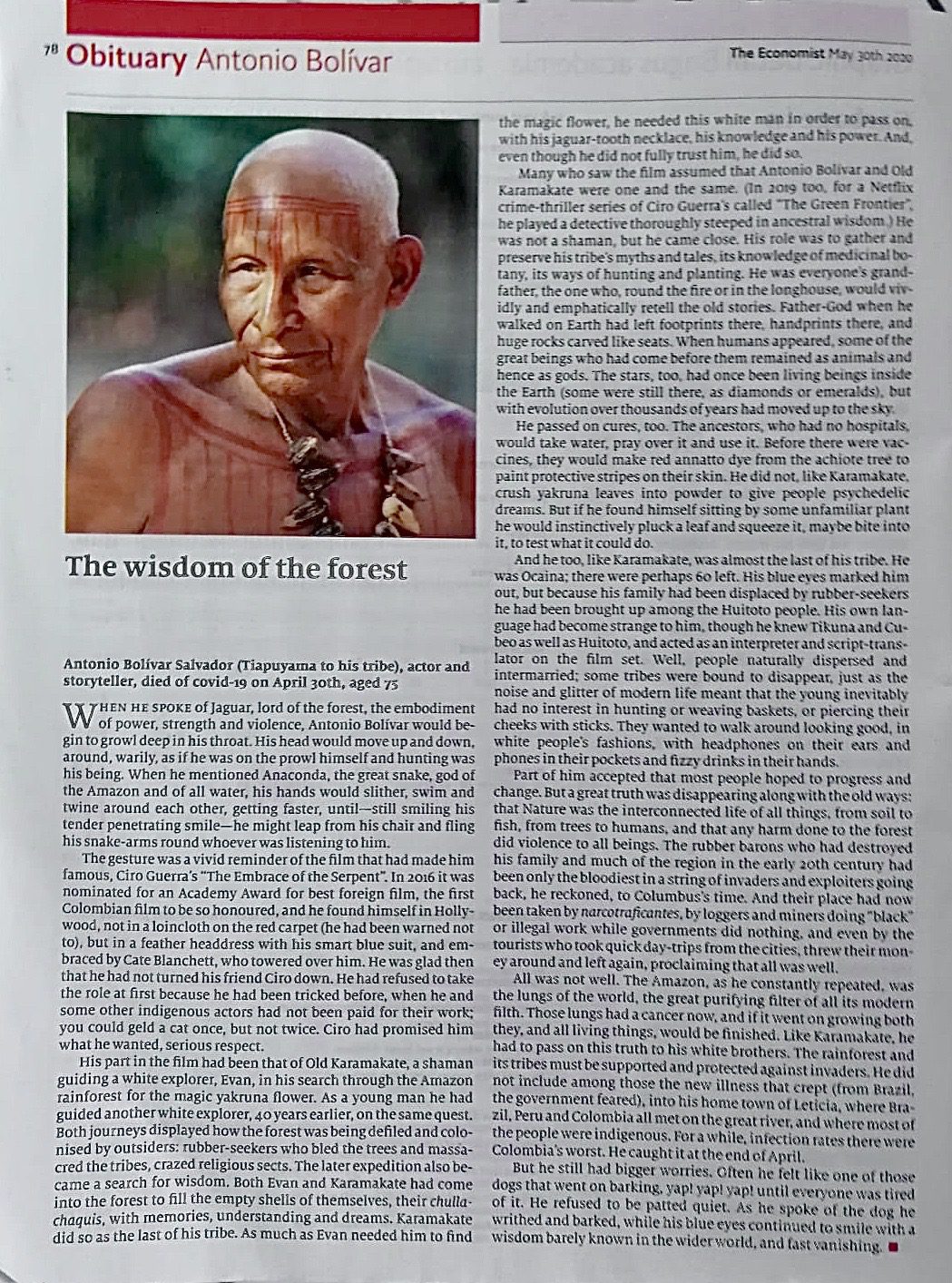
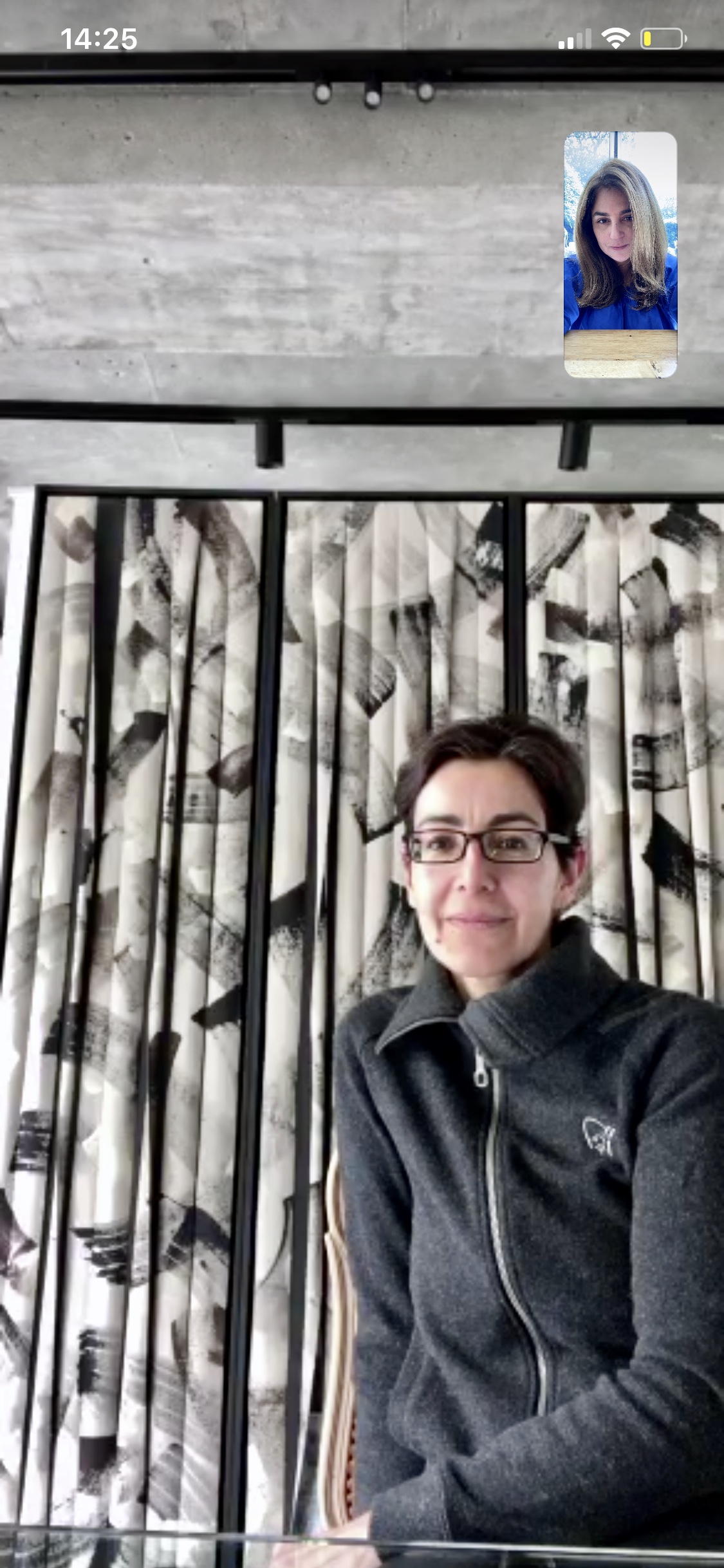
Azadeh Ghotbi
June 2, London, Home/Studio
2020 is a tipping point year! We must do all it takes to reduce social and racial inequalities, and take better care of our planet and its people.
How ironic that something sub-microscopic and invisible to the naked eye has turned into a formidable giant magnifying glass for us all to peer through!
I see the Coronavirus as a magnifier that’s made our weaknesses more glaringly visible: over-exploitation of natural habitat, over-dependence on global outsourcing and just-in-time production, systemic under-investment in health services, ever-increasing income disparity and reliance on an underclass to keep the system going, unsustainable consumerism, and re-emergence of nationalism at a time when international coordination would have been most optimal. If only we had in us the humility, wisdom and foresight to heed the necessary lessons. We need a new vision.
On a more personal level it’s as if my own gaze has been changed by an invisible lens. I can’t help but intuitively flag any still or moving image that includes a human being as Pre-Covid vs. Post-Covid. I instinctively capture abstracted reflective images each time I leave the safety of home. What the lens seems to always avoid is looking at anyone’s eyes! I’ve called the photo series “Lockdown Lens: Vision 20/20”. Unbeknown to me, even my style of painting looks to have been impacted. Interestingly, it took an external set of eyes to point it out. I sent a picture of a recent work to someone I know well the other day. What immediately caught his attention was how the brush marks appeared strikingly different as if more blunt and agitated.
Images from Lockdown Lens: Vision 20/20 by Azadeh Ghotbi:
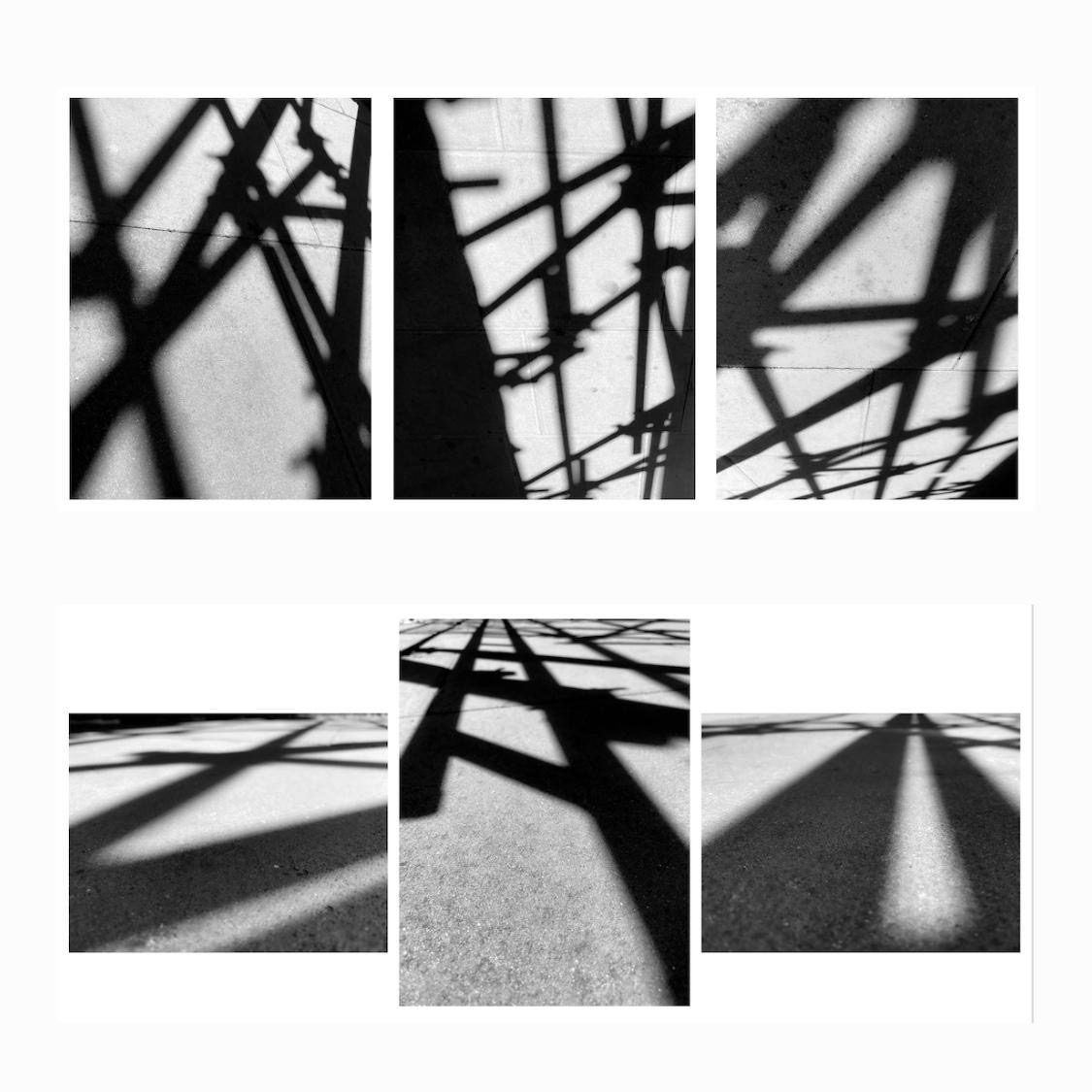
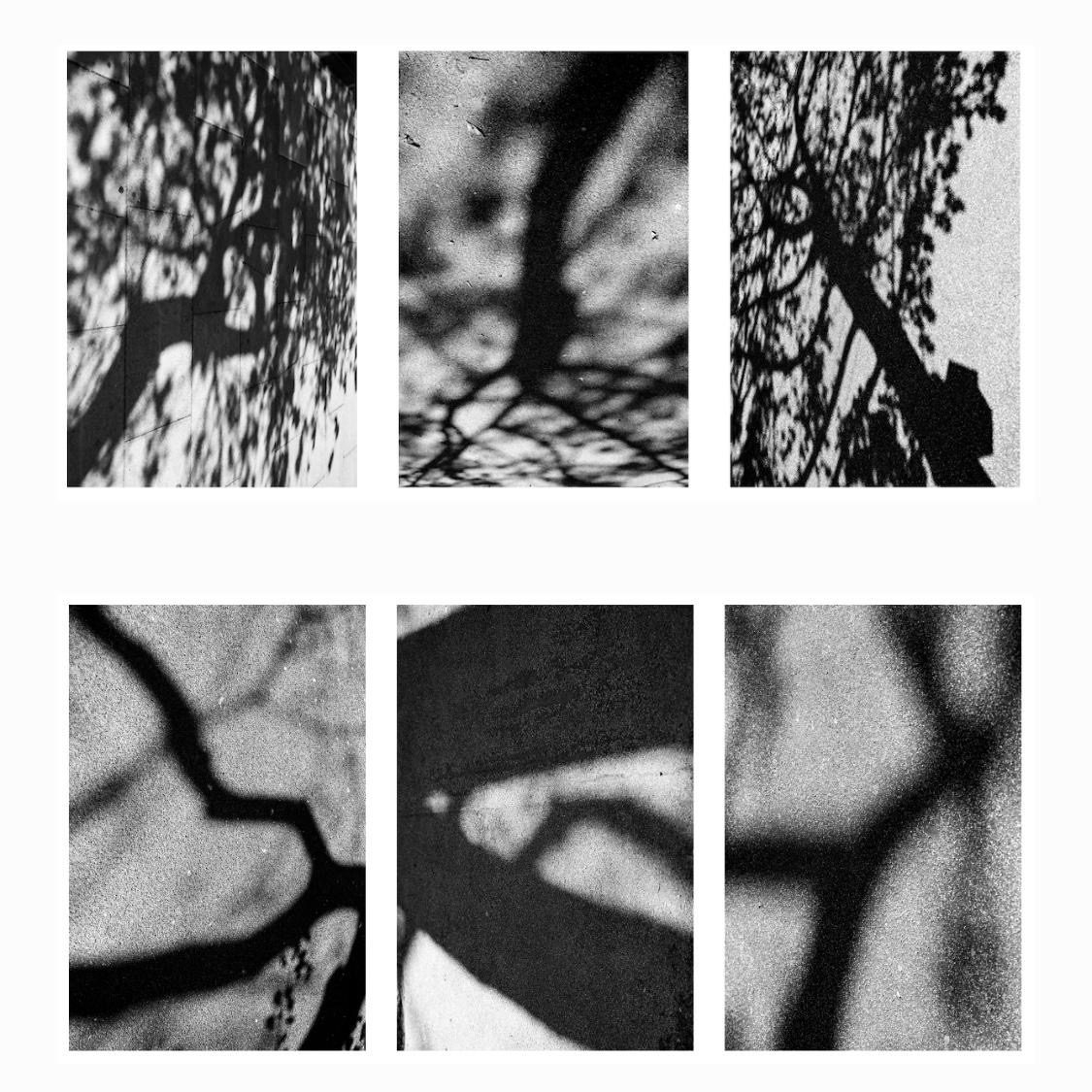
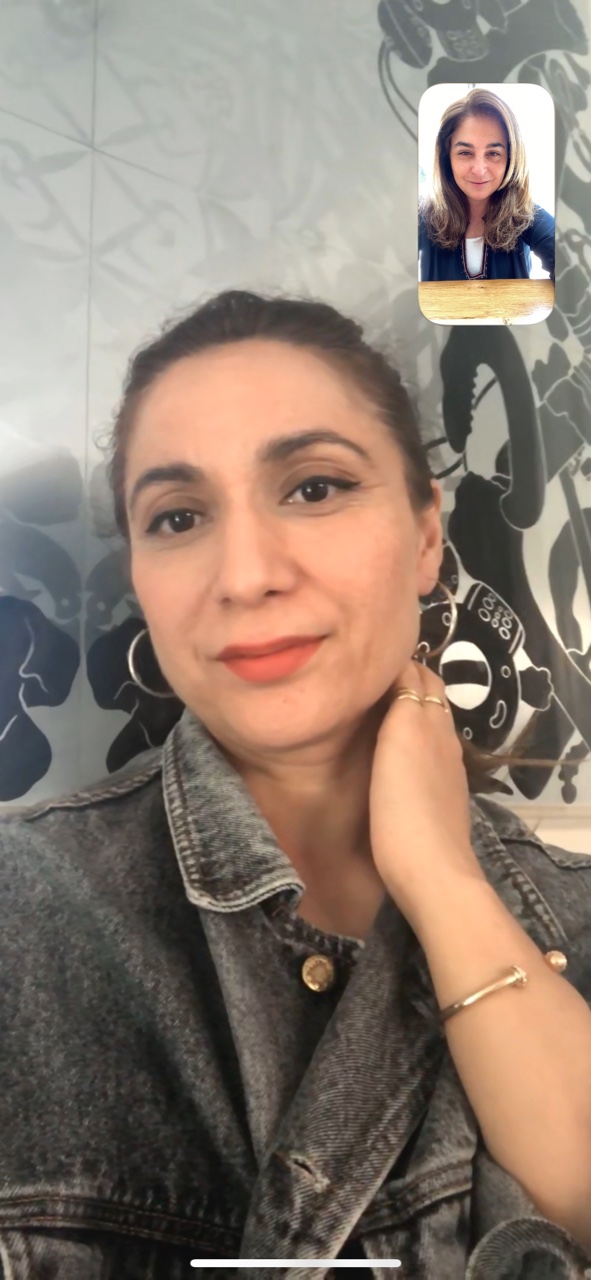
Faiza Butt
June 2, London, Home
Ironically, self-isolation is not new to most artists. Most artists work as solo practitioners and their ideas and concepts can be in isolation to mainstream society. Considering that, the social isolation has not had a major emotional or physiological impact on my state of mind. However, the collective uncertainty and disruption of routine have created moments of reflection.
These times are, once again, a reminder of our fragility as humans. Somehow when survival comes into question, every other struggle and strife becomes petty.
As a diasporic artist, I am used to changes and a transient state of existence. My work has been a reflection of the human condition and has addressed our vulnerability in the past. It has thrown open the disparity in economic and social systems around the world. The issues of excess and privilege are at the forefront of our minds. How privileged are those that CAN quarantine.
The notion of privilege, power, and its abuse takes us towards current demonstrations in the US, which have a profound affect on me. It appears someone has to lay their life, each time, to snap us out of our placidity towards discrimination. I am deeply touched by the emotional vigour of the protestors and the range of symbolic idea, through which they express themselves. Kneeling in honour of George Floyd has to be my favourite. ‘Nothing is more powerful than an idea whose time has come,’ Victor Hugo.
These extraordinary times have reminded us of our collective faith as mortals and our sense of responsibility towards each other and our planet.
I believe I may address concepts that affect us humans collectively, more, and focus on the universality of issues that the current uncertainty has revealed. Perhaps it’s too early to assess if it has had a life changing impact on me, I believe it will reveal itself in time. One thing is for sure: nothing is forever.
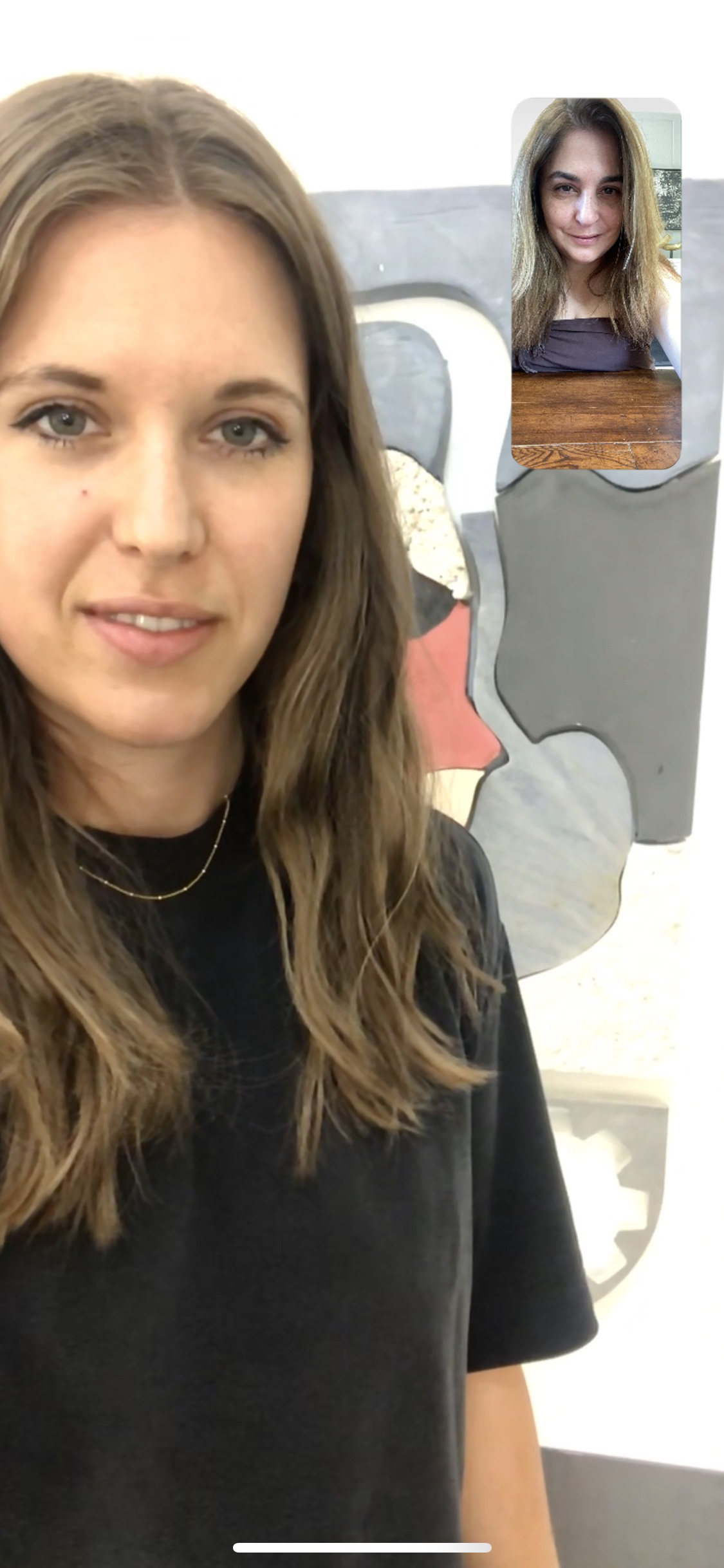
Holly Hendry
June 2, London, Home
Head sludge, treacle time, flat space, lead head, and lots of Nots: not knowing, not doing, not working, not being present, not going out, not being able to focus, not coping, not checking emails, not watching the main news channels. I think the Nots are important to help think about what we need to do – and that list is massive.
I have been thinking about hunger stones a lot recently – an inscribed stone that acts as a hydrological landmark, embedded into rivers during 15th Century droughts to mark the water level, as a warning to future generations that they will have to endure hardships if the water sinks to this level again. The pandemic is our hefty, stoney warning sign which has made visible what is most urgent.
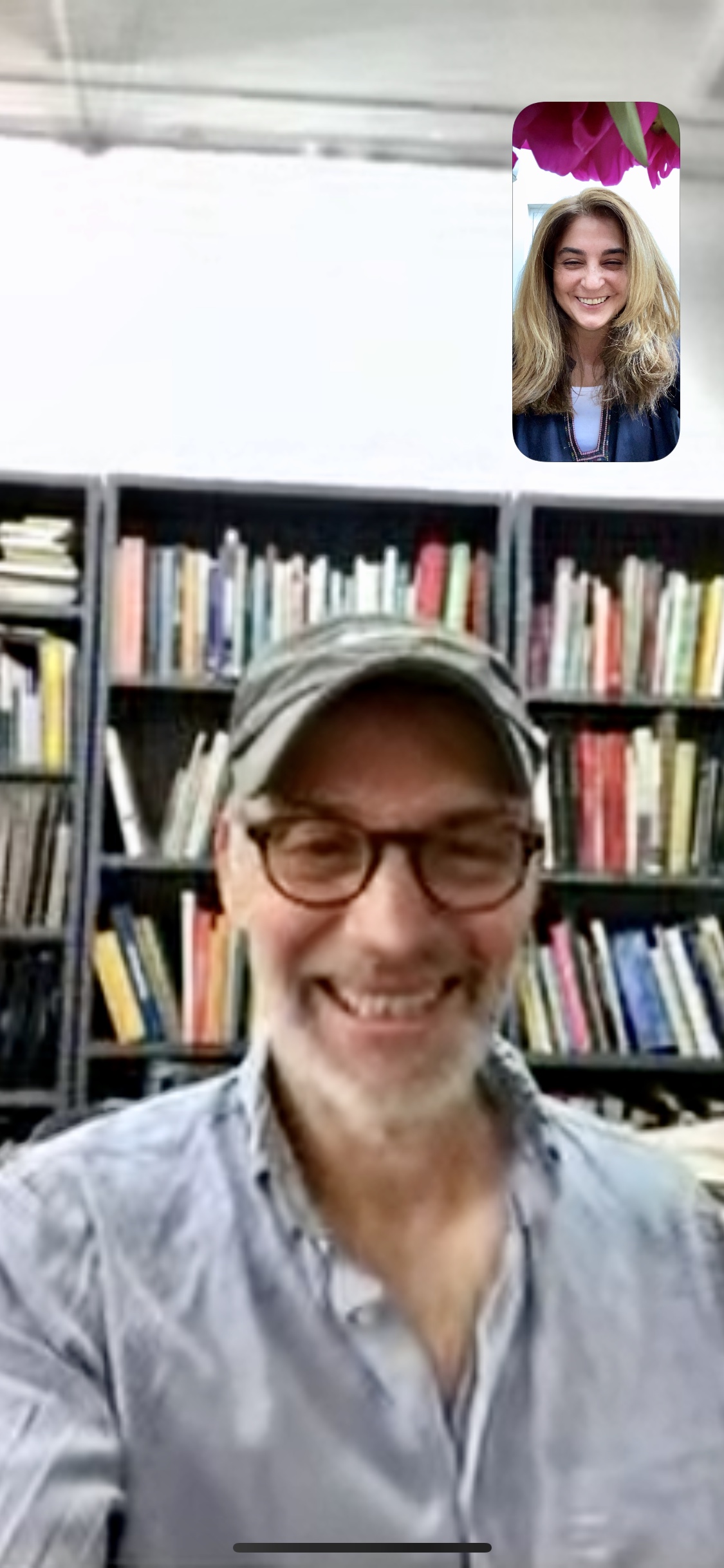
Wayne Gonzales
June 1, Chelsea, Manhattan, Studio
I’ve mostly managed my pandemic experience by trying to stay in the moment. But, in recent days, my focus on self-preservation seems a distant memory. It was shocking, but not surprising, to see the video a week ago of another blatant and brutal murder by police of an unarmed black man, George Floyd. And it’s stunning to see so many people, mostly young and peaceful, break quarantine and take to the streets to demand social justice and accountability. This afternoon our lawless, sadistic would-be-dictator president used military force to remove peaceful protesters from Lafayette Square in DC, so he could deliver a speech to assure peaceful protesters he’s on their side, preach law and order, and threaten the country with military force before strolling to St. John’s Church for a photo op with a prop Bible. The danger of the pandemic is still here, and I hope the protests are not a catalyst for waves of new infections in the coming weeks. We’ve got a lot of work to do and now is the time to stand in solidarity and listen to black people. BLACK LIVES MATTER
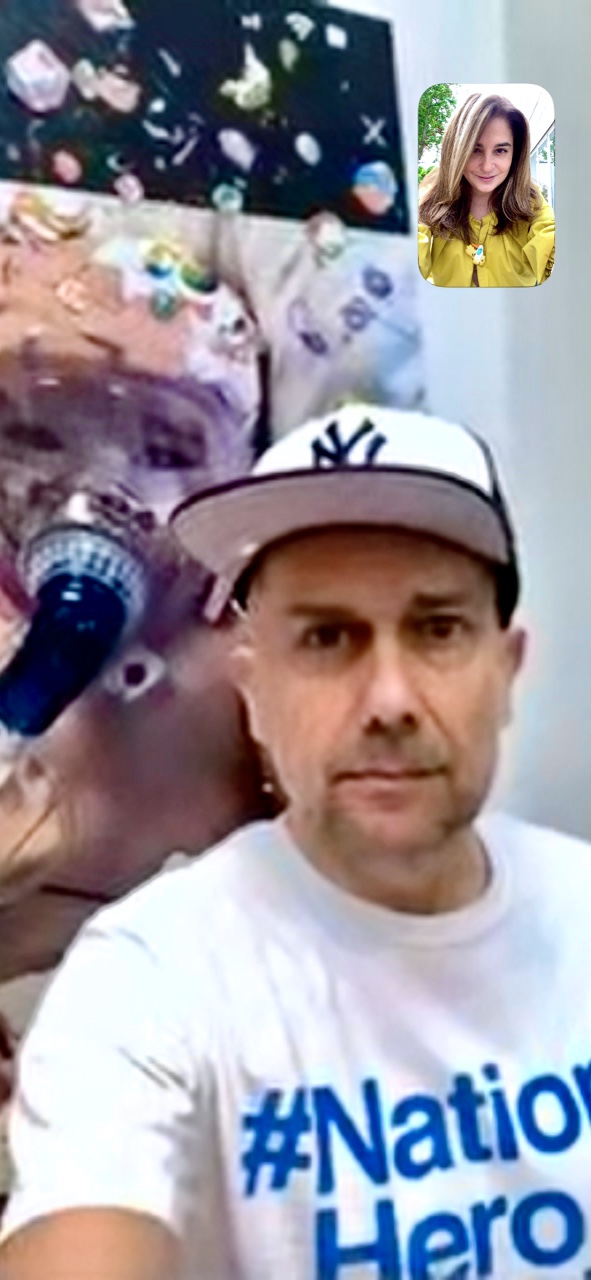
Marc Quinn
June 1, London, Studio
I understand the world by making art, so in a period of huge crisis and transformation, the only way I can come to terms with it, is by making art about it. I’m painting at my studio every day, creating my new series of works, the Viral Paintings. My whole day revolves around the creation of the works. I spend a couple of hours each morning reading the news online, then I pick one or two articles to print out and start working on the canvases I stretched the previous day. I paint for two or three hours each day. Those hours of painting in the studio are my sole focus; afterwards, I’m completely exhausted. The next day the whole process starts over again. To me, there is a very strong element of performance and ritual in the creation of these works. It is important to me to engage with one of the most significant stories of our time, in real time.
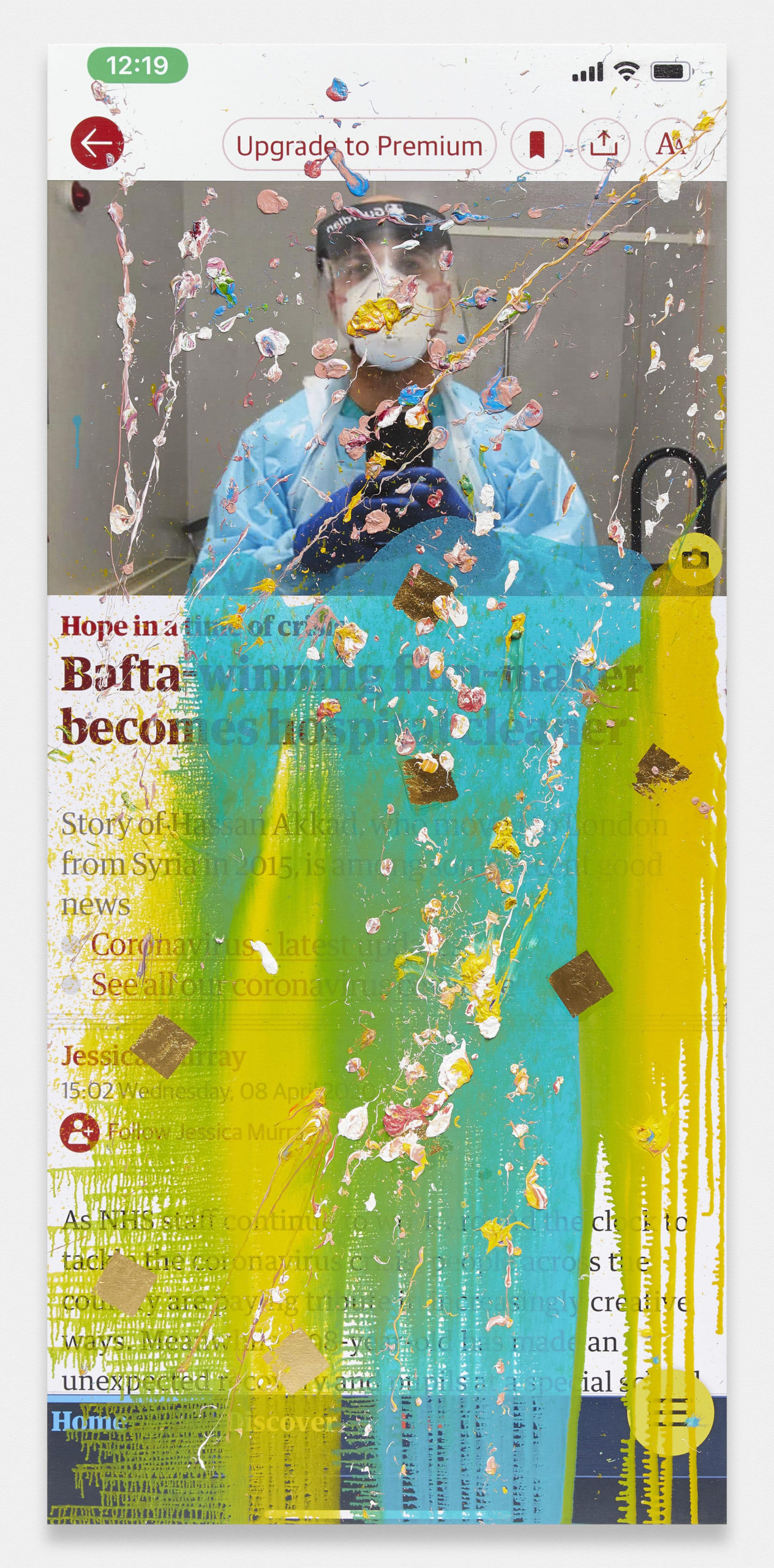
Viral Painting. Bafta-Winning Film-Maker Becomes Hospital Cleaner, The Guardian (Painted 10 April 2020), Marc Quinn, 2020.
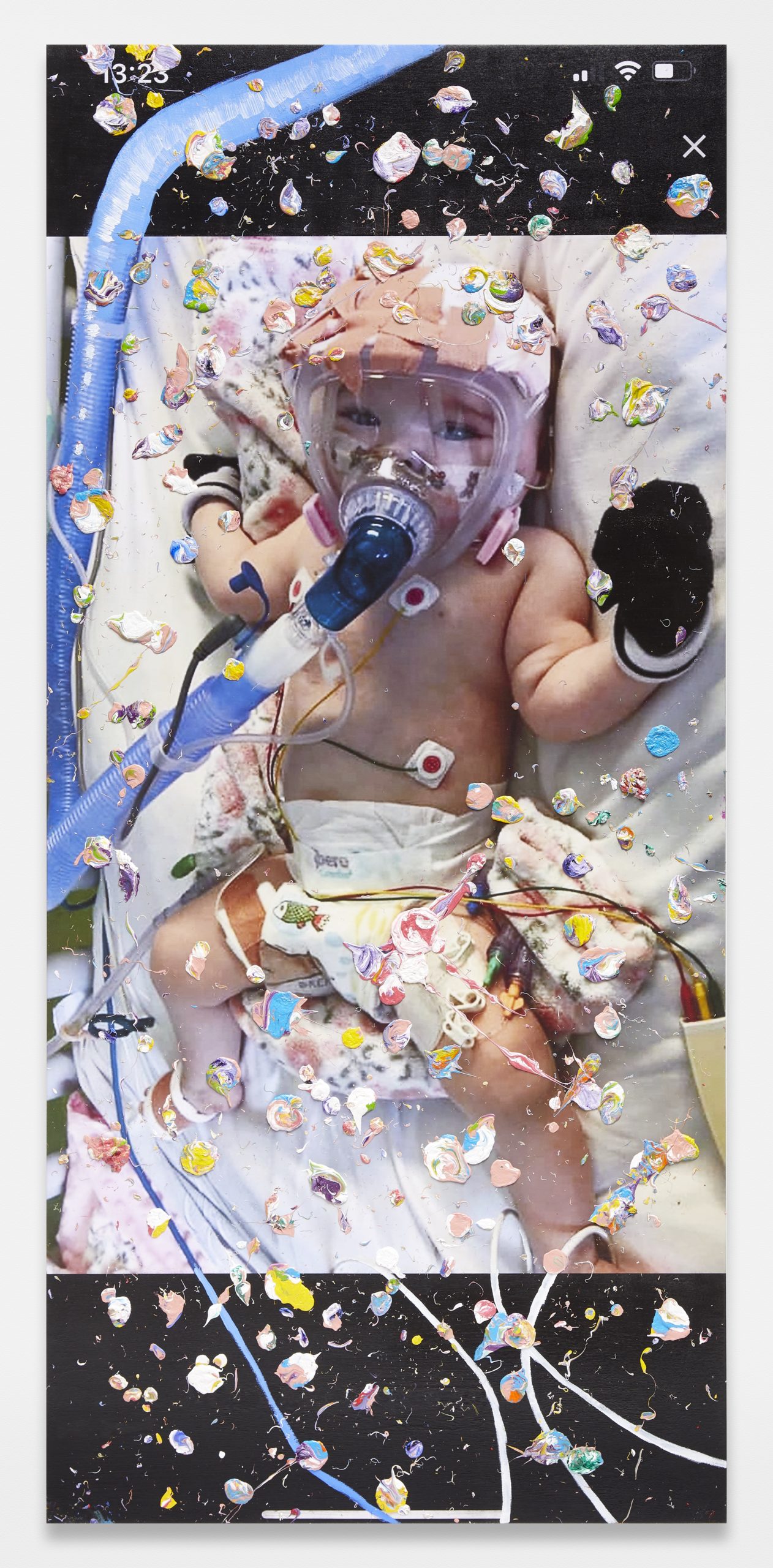
Viral Painting. Baby Erin Bates (Painted 15 April 2020), Marc Quinn, 2020
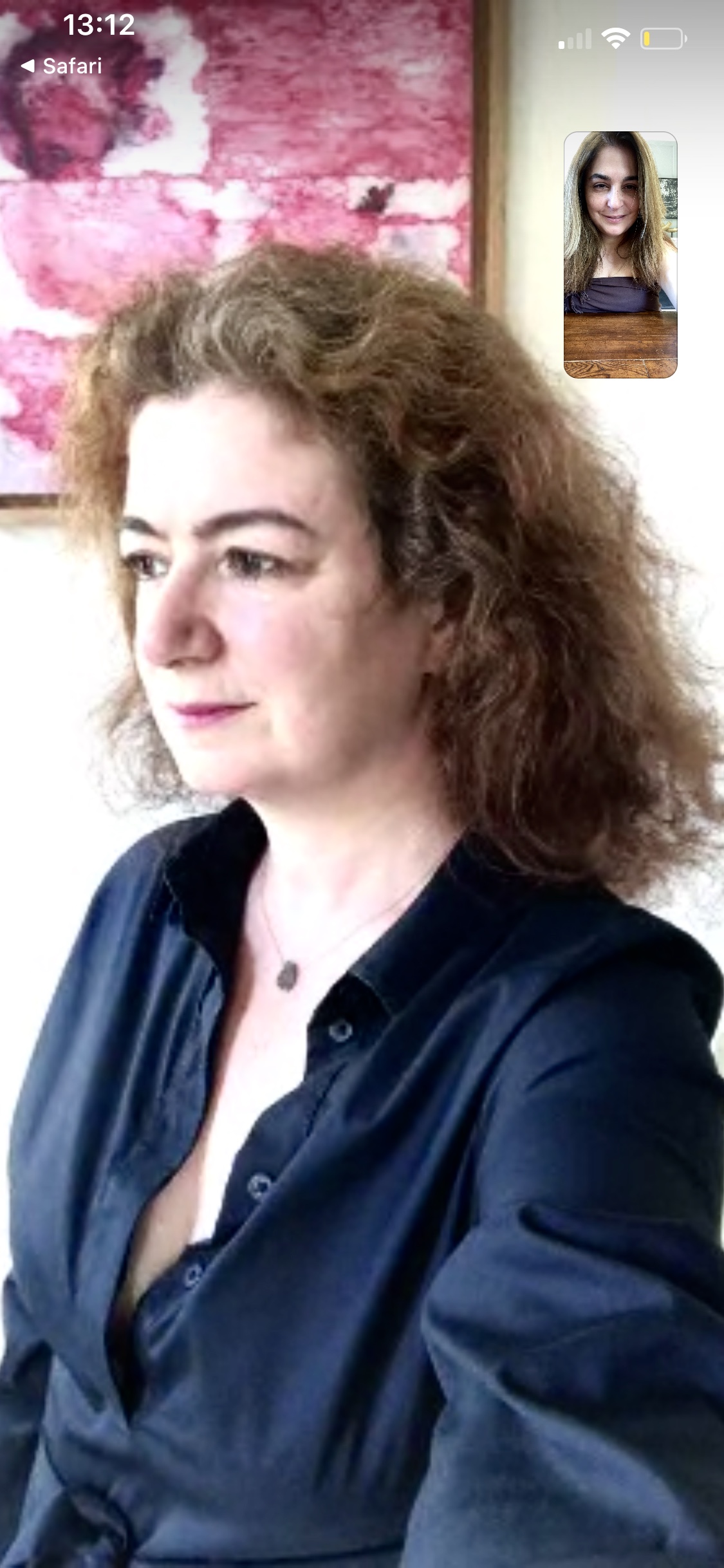
Lamia Joreige
June 1, Beirut, Lebanon, Home
ليال و نهارات في زمن الوباء – Nights and Days in times of pandemic
Today, as the coronavirus spreads, the country is broke, and the people, robbed and ruined, are breathless, in a state of exhaustion. The virus has delivered a final blow to the country, which was already down, and a violent blow to our uprising—a blow which is beyond us and against which we are helpless, forced to pause, at worst, to sleep, at best to grow introspective and reflect on politics. The future is uncertain, dark, our worry worries are two-fold. How will we make it, and what will become of our uprising, which has been for the most part peaceful, even joyous and sometimes violent, but certainly of an unexpected scale in our history. How to carry on in this state of emergency, when we can no longer gather in a public square? These restrictives measures on our movement and associated surveillance suit all the states of the world well. Indeed, our government hastened to dismantle the tents and installations belonging to demonstrators on Place des Martyrs and Place Riad el Solh. Since October 17th, my artistic work has been suspended. Caught up in the excitement and the hope of change, there was no place for art. Many of us have been emotionally overwhelmed, our thoughts focused on one goal: radical political change. What can art do in such circumstances. I have asked myself this question a thousand times, for months, without ever being able to answer it. The idea of pursuing my artistic research seemed impossible to me, just as creating a work testifying to this revolutionary moment would be pointless. I wanted to fully experience my commitment. There was no room for poetry, or even for melancholy, only anger. Was this a form of hardening, a result of years of sadness and anger born of having seen everything around me being slowly destroyed? Anger at myself for waiting too long to revolt? Today, after a month’s confinement, I decide to write a few lines. After the first week of sadness and anxiety, I quickly settled into a state that resembles that of an ideal retirement, alone. My house being also my studio, my days should have been little different from those before the coronavirus, since I rarely went out during the day, and most often at night. However, everything is different. What has changed is the perception of my inner space, the rhythm and discipline that I instil and the pleasure that I experience, along with my state of alert in the face of imminent danger. My body itches. For the past two days I have been frantically scratching myself, my legs, my arms, my chest. Is it an allergy, or the signs of an unlisted illness, an unrecognised symptom of Covid 19 or the effect of fear of being infected. My body itches, I want to hug a human being. To feel an embrace, a hug, a kiss.
When will we be able to hug a parent, a friend, a lover again? What will happen to beautiful encounters, will we trust the unexpected, the unknown, a stranger? I wonder if I will ever again kiss and make love physically. Will virtual sex take over? In confinement, I often think of the summer of 2006, when Lebanon was under siege, bombed by Israel for more than a month. Although the situation is not the same, the feeling of being in a closed space-time, in an exceptional state governed by its own rules and conditions, is similar. And lo and behold, yesterday, when I was walking, a drone flew over the sky without anyone being able to see it. At nightfall, the continuous, incessant, heavy noise reminded me of this Israeli drone, which night and day flew over the sky during the war of 2006, and whose uninterrupted humming I had recorded from my balcony.
This text was used for the voiceover of the short video (below) commissioned by Daraj Media and IMS in April 2019 as part of “Living in times of Coronavirus”:
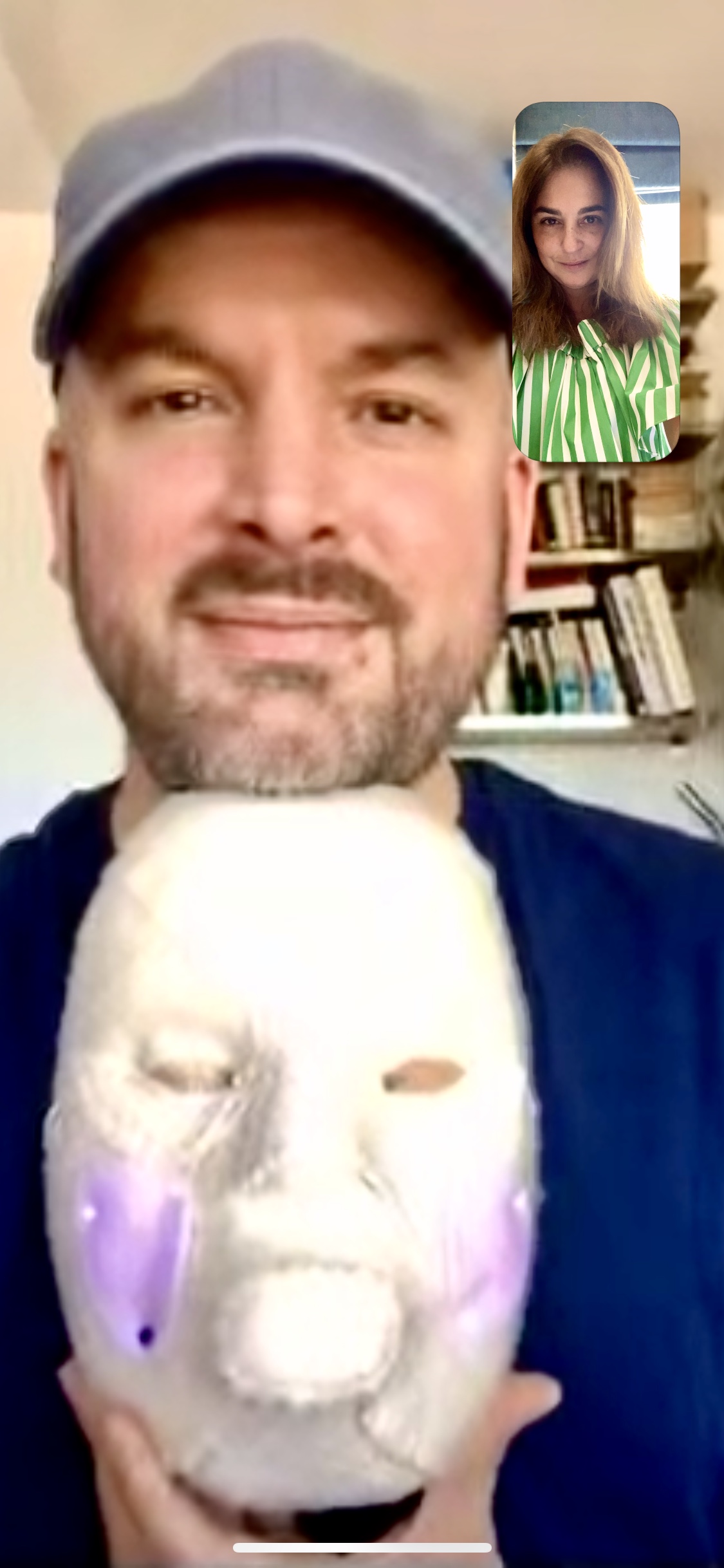
Jonathan Baldock
May 29, London, Home
When I was younger I was an avid bird watcher, but since living in London, I’d lost touch with my avian friends.
During lockdown they’ve been singing louder and clearer than ever, uninterrupted by the usual shouting of inner city hubbub.
I’ve been reminded of the power of their songs and my connection to them, which I could describe as almost spiritual. I can imagine life outside the confines of home and away from feelings of anxiety and stress.
It’s reminded me they need our protection, and so this spring I’ve rejoined the RSPB and rekindled my love affair with birds.
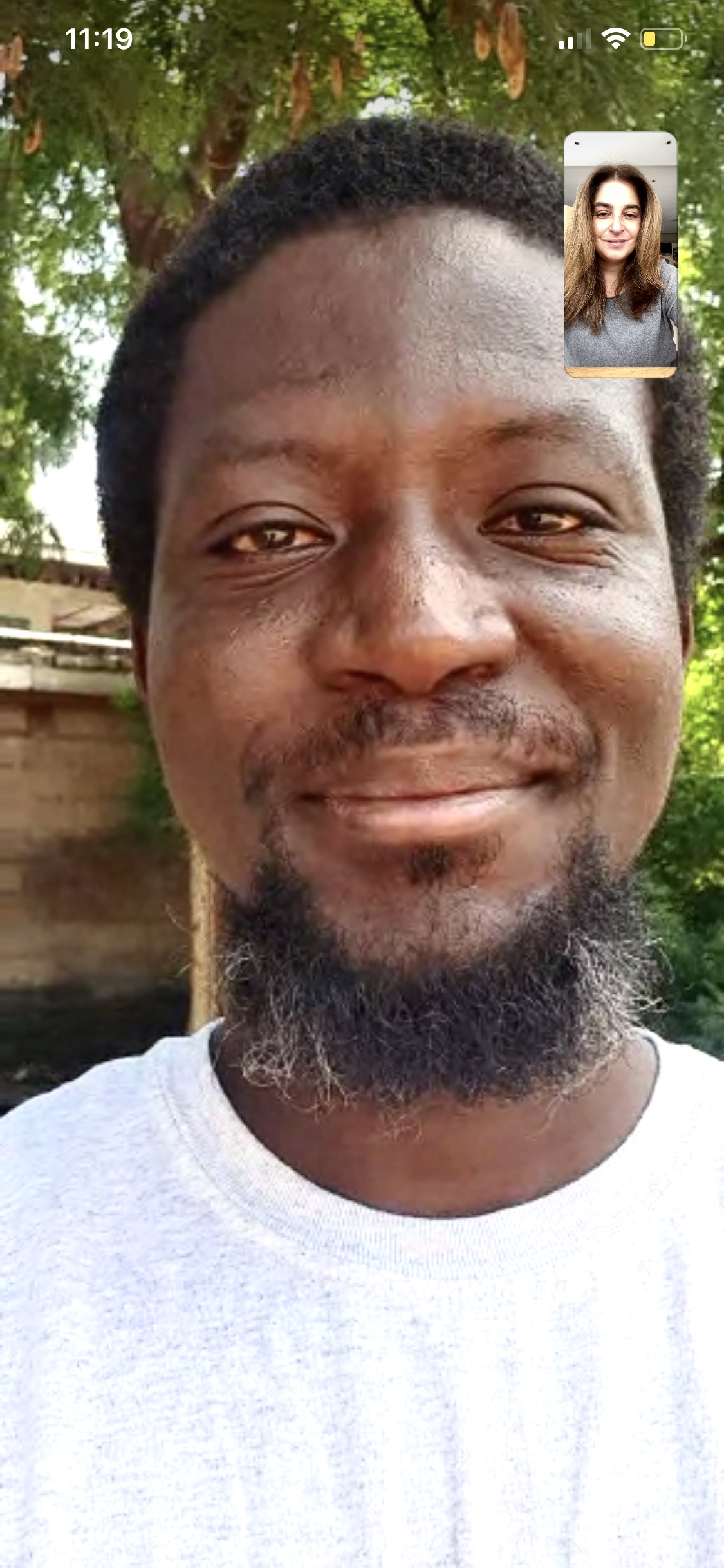
Ibrahim Mahama
May 29, Tamale, Ghana, Home
What’s the relationship between the dead and the living? How do we resurrect ghosts within a time of crisis? What do ghosts and crises have in common? Can failed revolutions lead us to think of crises as a form of material to create new forms within the 21st century? What does the gift economy and crises have in common? Is it possible to imagine a future using death and decay as a starting point? What constitutes a parliament or a place of gathering? Are ghosts implied within historical places of gathering? What is a constitution of labour and its ideological implications?
The Parliament of Ghosts is a place of many gatherings using the failures of history as a starting point for artistic production. The process of building a place starts with an assembly of various labour forms and techniques, it is the constitution of labour that defines any given form. These labour forms have produced many ghosts across time and it is important to allow them to shape the ideas and embodiment of place. The haunting of place and the constitution of labour might lead us to rethink about the role of capital and its paradoxes. Proposing new forms between the art world and its audiences, its promises and failures.
The constitution of labour is at the centre of the universe and the centre has no limits. It is important to pay attention to the gift economy with these uncertain and difficult times so the generations which emerge from the crisis can create new values and systems not just based on circulation of capital but through an act of will. The introduction of play into the place of gatherings might yet be the next revolution with this century? Can the processes that constitute art be a gift to society………..?
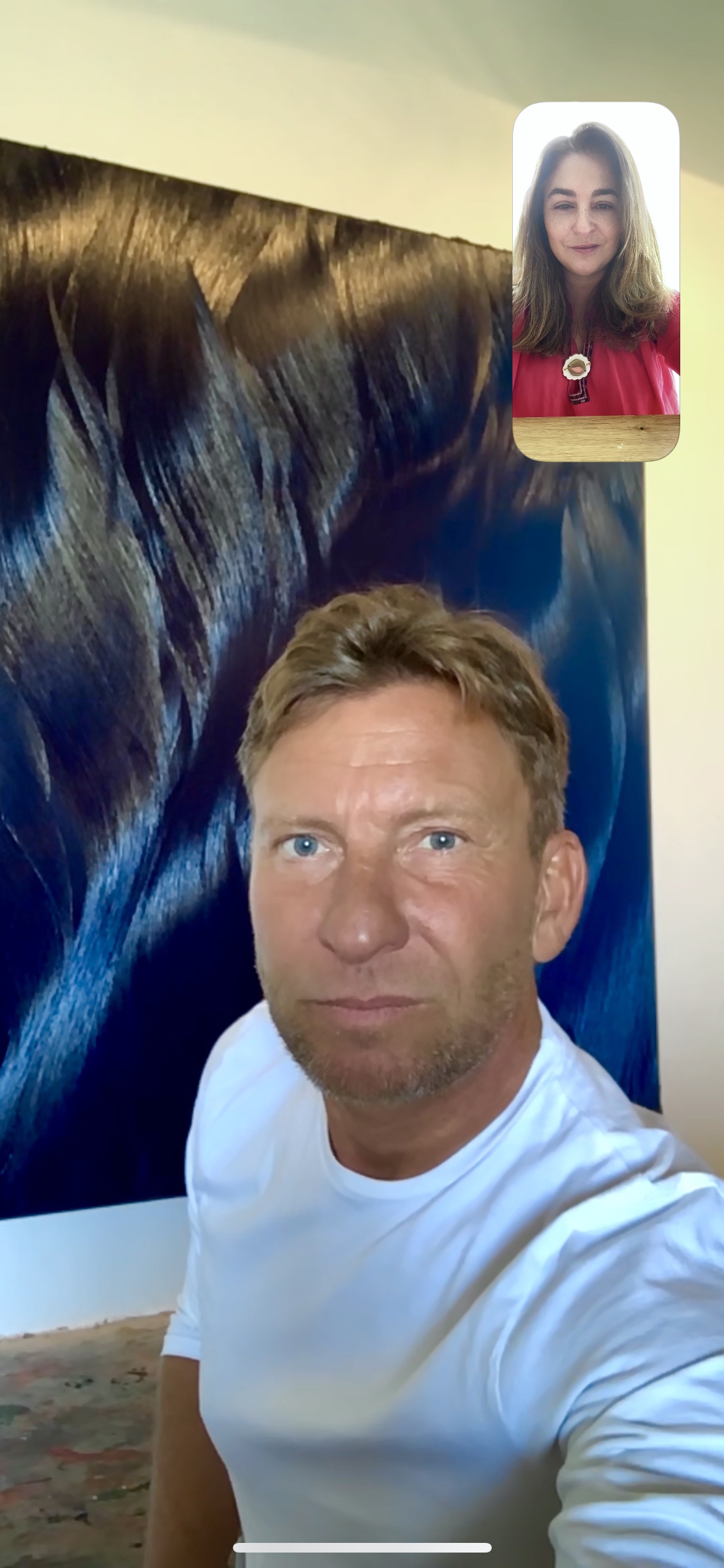
Jason Martin
May 27, Comporta, Portugal, Home
Retreating to a working space beside an estuary and surrounded by rice fields, you might consider the world’s dilemma almost anathema and apart .
Not so.
This remote rural enclave slowly dictates an uncompromising benevolence of nature. Due to a heavier rainfall than average, rice was planted late this year. The farming community prevails regardless, necessary and vital as always .
My field of endeavour lacks any such pragmatic or fundamental necessity.
Back to the existential questions surrounding the idea of an art practice as essential.
From this reclusive exile, purpose can seem as remote as the location; however, there is possibly a scintilla of hope.
Subtle acts of empathy emerge from a place of quiet reticence .
We are all poets in lockdown when we find a nostalgia for what lies ahead .
As the master of melancholy Fernando Pessoa reflects ‘…to possess something is to lose it. To feel something without possessing it, is to keep it, because in that way one extracts its essence.’
Perhaps, the restrictions on our personal freedoms can be an enlightening revelation if we consider that suspension is a timely interim. We move on…
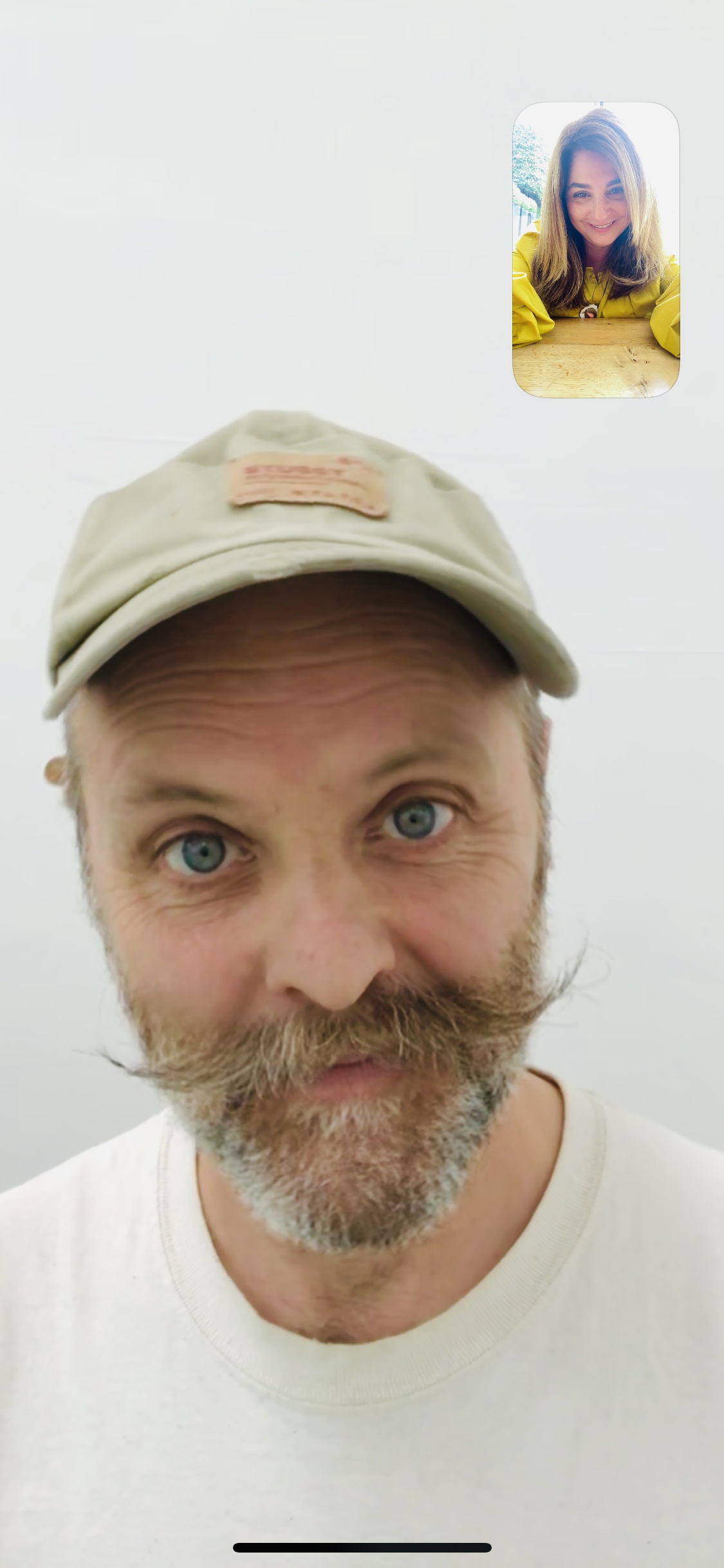
Gavin Turk
May 27, London, Home
This current ‘Lockdown’ moment has been super interesting for me as I have learnt about my reliance on the physical audience and experience. The interaction between the art and the audience is fundamental to my concept of art; not being able to experience physical art except online is kind of flattening my perception.

Dor Guez
May 27, Tel Aviv, Israel, Home
I remember seeing Jaffa while on my grandmother’s back from the Mediterranean

Edward Burtynsky
May 26, Toronto, Canada, Home
I can say with certainty that the 2020 we are living in now is not the one I envisioned as we began looking ahead to the new decade at the end of last year. It’s an understatement to say that this new reality we’ve been thrust into has sent a shockwave through our society, our economy and our individual lives. But as an artist who has spent nearly 40 years photographing the largest examples of human incursions into the natural world — what I’ve so often described as “business-as-usual landscapes” — this shockwave seemed ever more prominent when “business-as-usual” was all but suspended, indefinitely.
It is disorienting to have observed our collective industrial experience on this planet — the seemingly endless propagation of our human destiny — through photography for almost four decades and then to see that version of “normal” shattered in the blink of an eye. There’s no doubt that the ravenous human appetite to conquer Nature, and the extent of these behaviours, has led us to where we are today: isolated at home with a new pathogen determined to wreak global havoc with no regard for party or geographical lines. It’s a stark reminder that our reach into Nature has gone too far, that we are on a dangerous trajectory and the scales are frighteningly unbalanced. What’s more, it’s clear that the global call to action against this virus is a test run for our inevitable and impending fight against climate change. But we have to remember, however, that while there may one day soon be a vaccine for this virus, there is no vaccine for climate change.
Over the past few weeks, I have been inspired to go back to my origins of photographing in these natural landscapes – viewing nature as a kind of painting. Looking at abstract expressionism and trying to find that place through photography. Going back to the shrubs and bushes of the forest. Going back to my home, nature. During this time in isolation I am creating a suite of images looking at nature, with a percentage of proceeds from the sale of the work going directly to support the arts sector in Canada. The arts have taken an oversized hit during these times and will continue to suffer enormously because of this crisis. And yet, it is the artists, musicians, filmmakers and performers to whom we are all turning for catharsis, relaxation, distraction, entertainment and, perhaps most importantly, hope. As the great artist Gerhard Richter once said, “Art is the highest form of hope.” Artists now need our support as much as we need theirs.
The slow reopening of society will bear its challenges, but I hope it will also bear positive changes as we reevaluate what it means to live and work on a planet whose resources, habitats, and biodiversity are both finite and precious.
@edwardburtynsky
edwardburtynsky.com
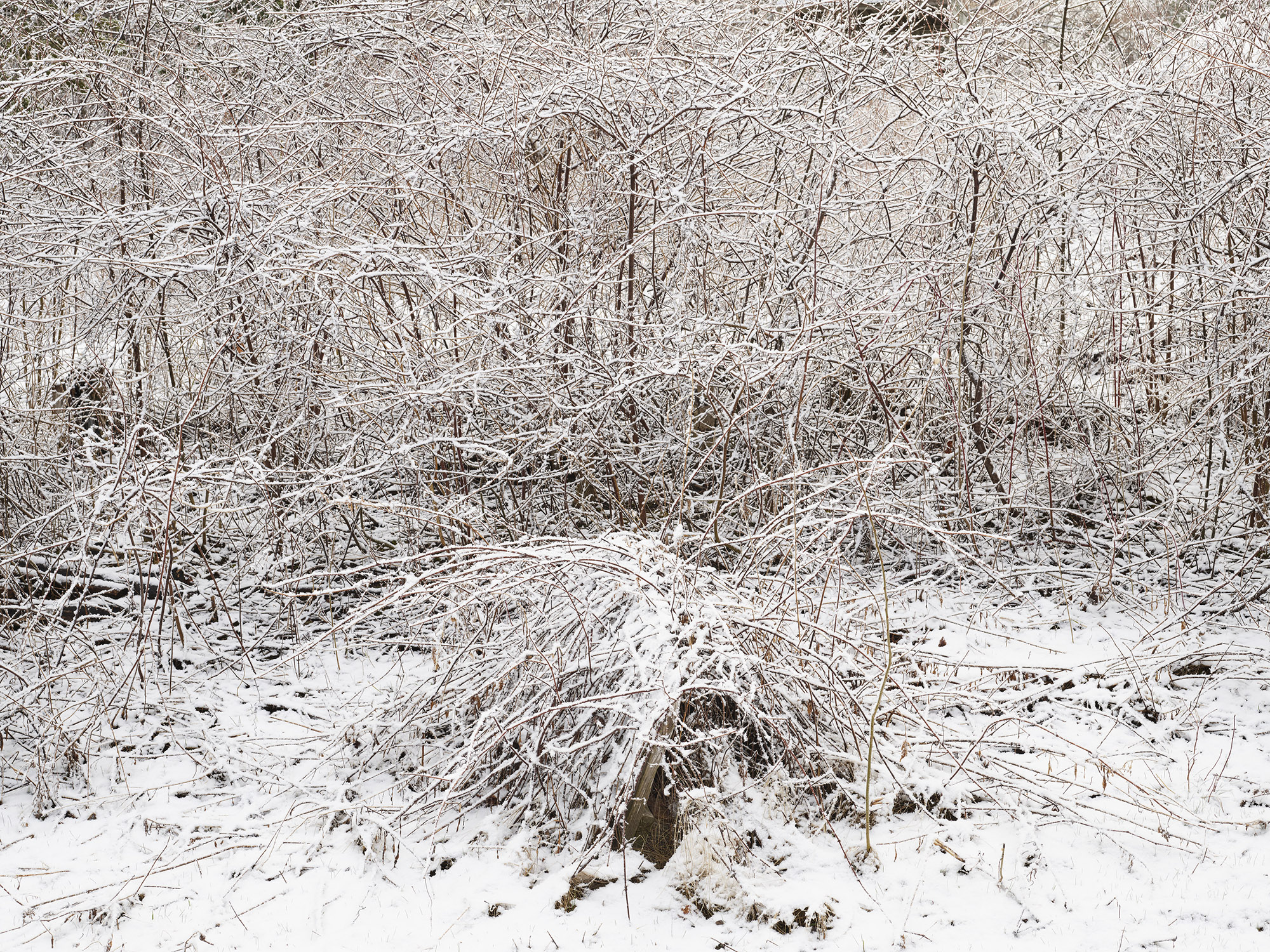
Spring Landscape Study, Ontario, Canada, April 2020, photo © Edward Burtynsky, courtesy Flowers Gallery, London / Nicholas Metivier Gallery, Toronto

Timo Nasseri
May 26, Berlin, Home
Despite all the current horror, it’s time to step back and try to re-imagine the world beyond this forced STOP. We need to reconsider our objectives as humans, as beings who have been given a unique chance to inhabit and share this beautiful planet. We have in fact been given a special gift, the opportunity to fully re-evaluate our lives. I think we will all experience a form of catharsis, rethinking our value systems whilst bringing more humanity into our lives, ultimately leading to a better existence. I feel very privileged to be living in Berlin, in a country where political decisions are based on science; during the first couple of weeks of the pandemic, all political parties came together in solidarity, putting all their differences to the side. That is admirable.
Today, with all the discussions taking place around cuts in arts funding, people are asking themselves what the world would look and feel like without art, without books, music and films. And suddenly, we realise the importance of beauty in our daily lives as a counterbalance to our fears. Or like François Cheng put it in Cinq méditations sur la beauté: “In these times of overwhelming misery and blind violence, of natural- and ecological disasters, it may seem inappropriate to talk about beauty. A provocation, almost a scandal. But it is precisely this that makes it clear to us that beauty – as opposed to evil – has its place at the other end of a reality that we have to face. I am convinced that it is our urgent and permanent task to face these two mysteries, which are the two poles of the living universe.”
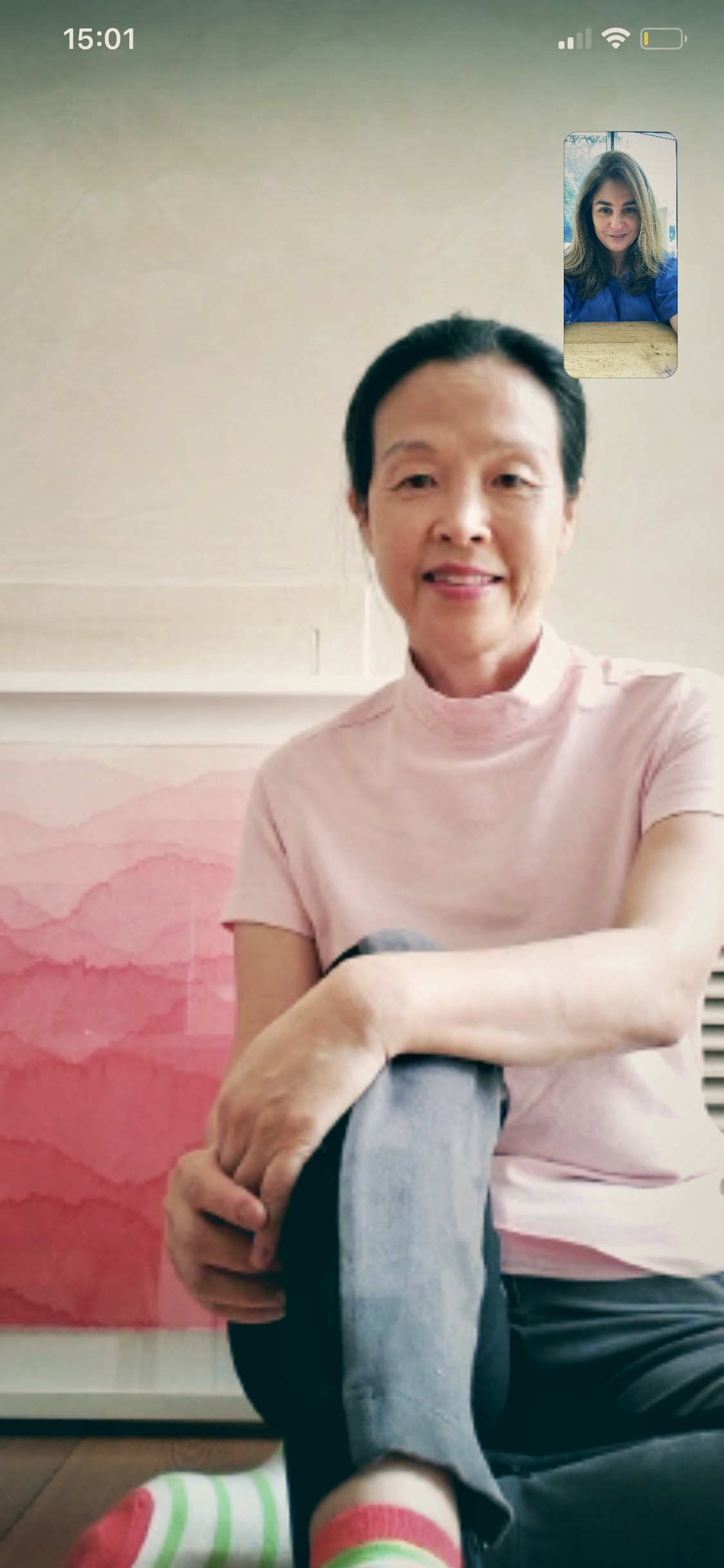
Minjung Kim
May 26, Saint-Paul de Vence, France, Home
What I feel now is that we are in a time machine capsule, but we don’t know whether we are moving towards the future or returning to the past.

Alia Ali
May 25, Los Angeles, Home
During this time where we are taking care of each other, it becomes even more revealing who is not taking care of us. While COVID 19 has introduced catastrophic outcomes, it has also done something significant. It has revealed the structural flaws of our economic, political, social, healthcare and educational systems. Problems and challenges which, as artists and citizens, we must not only observe, but also react to – particularly in the United States. It has deeply shaken my trust in the system, but it has also enforced my trust in my community. And when I say community, I mean the community that supports me across the globe. These individuals include family, friends, artists, writers, curators, roommates, studio mates, mentors, healthcare workers, neighbours, all of whom have reached out, not to ask “how are you being productive,” but rather “how are you taking care of yourself and how can we take care of each other.” While our systems have fallen apart, our love for each other has strengthened. During this time, I continue to work on my textiles, but rather than finding fabrics in the world, I am, for the first time, making them. I’d like to dedicate this photo and textile to all of those who have dedicated their time to their communities. And while we are in this position, sharing love, we must consider that this is, in fact, just the beginning of what should be some radical structural changes.
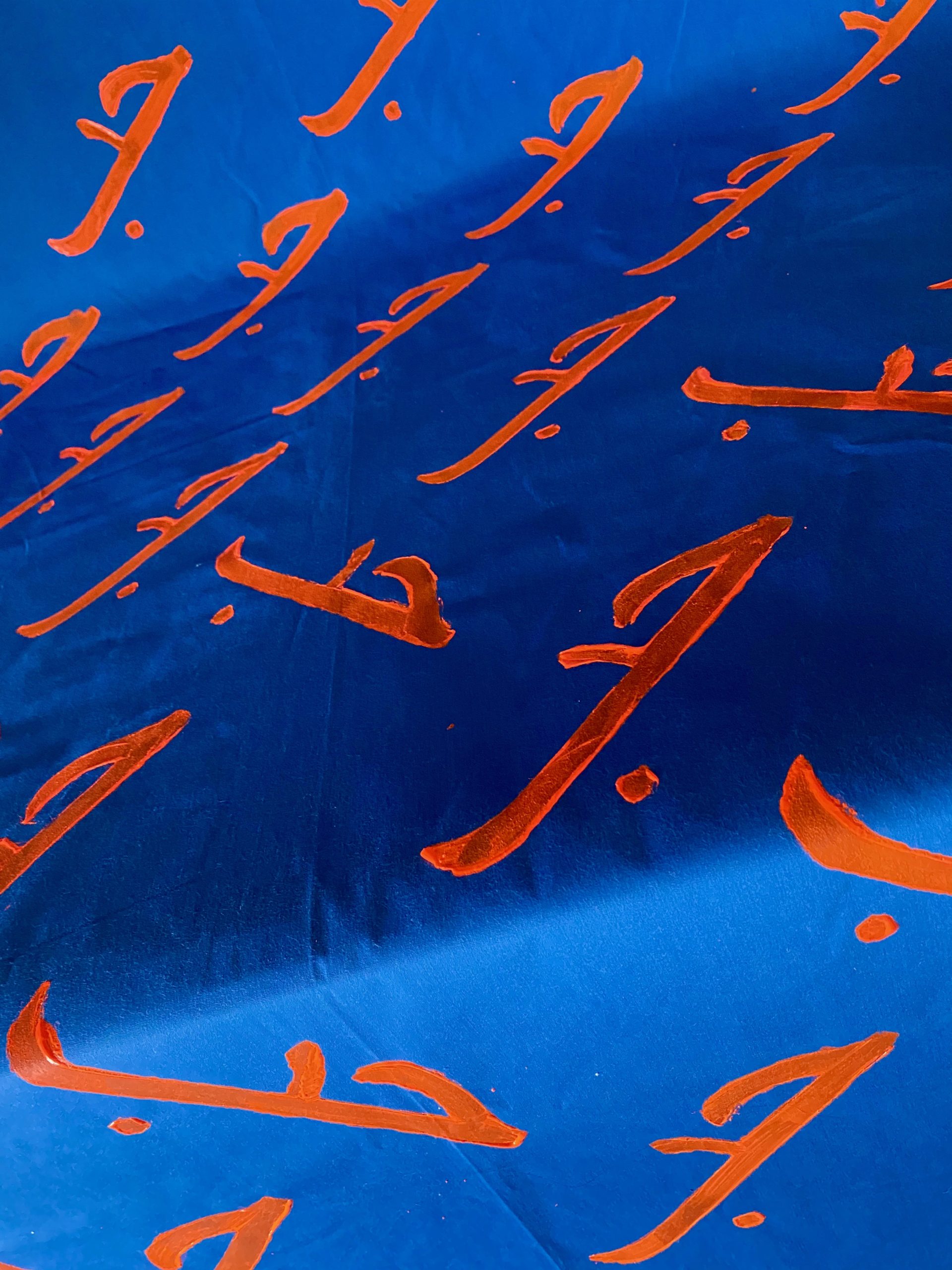
Fabric handmade by Alia Ali depicting the word ‘Love’ in Arabic

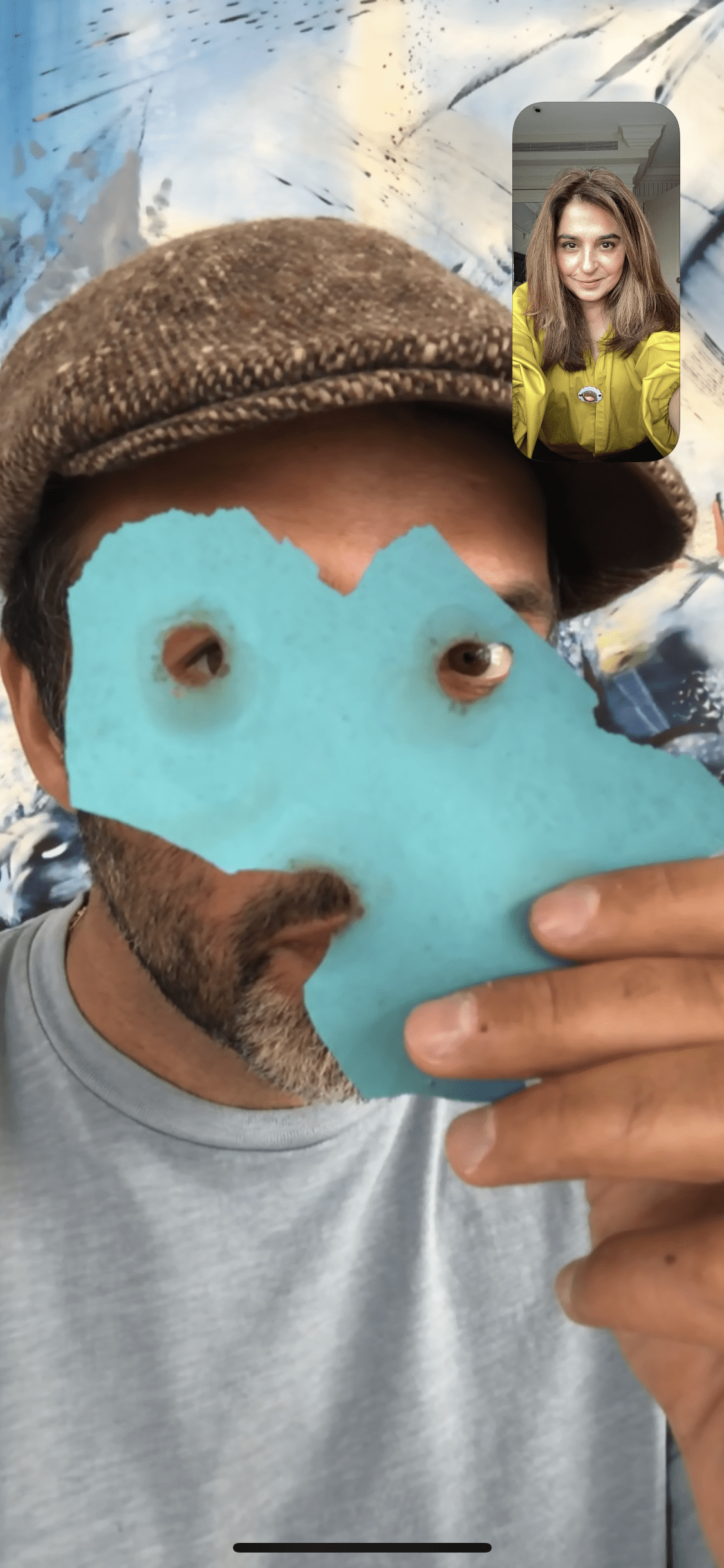
Ali Banisadr
May 24, Brooklyn, Home/Studio
I have been in my Home / Studio in Brooklyn for the past 4 months. I spend most of my time here anyway, alone in the studio for long hours, but it certainly feels different when it’s no longer a matter of choice.
I have been having the most vivid dreams filled with signs and symbols that are working their way into my paintings.
I have been reading, gardening and spending time with my two young daughters – their spirit gives me hope.
We have to trust in the future, and I hope this great pause makes us better going forward.
We can think about who we want to become, how will we take care of each other and how will we take care of this earth we live on.
We are only guests here, so hopefully the good that comes out of all this is that we remember that more often in our everyday lives.
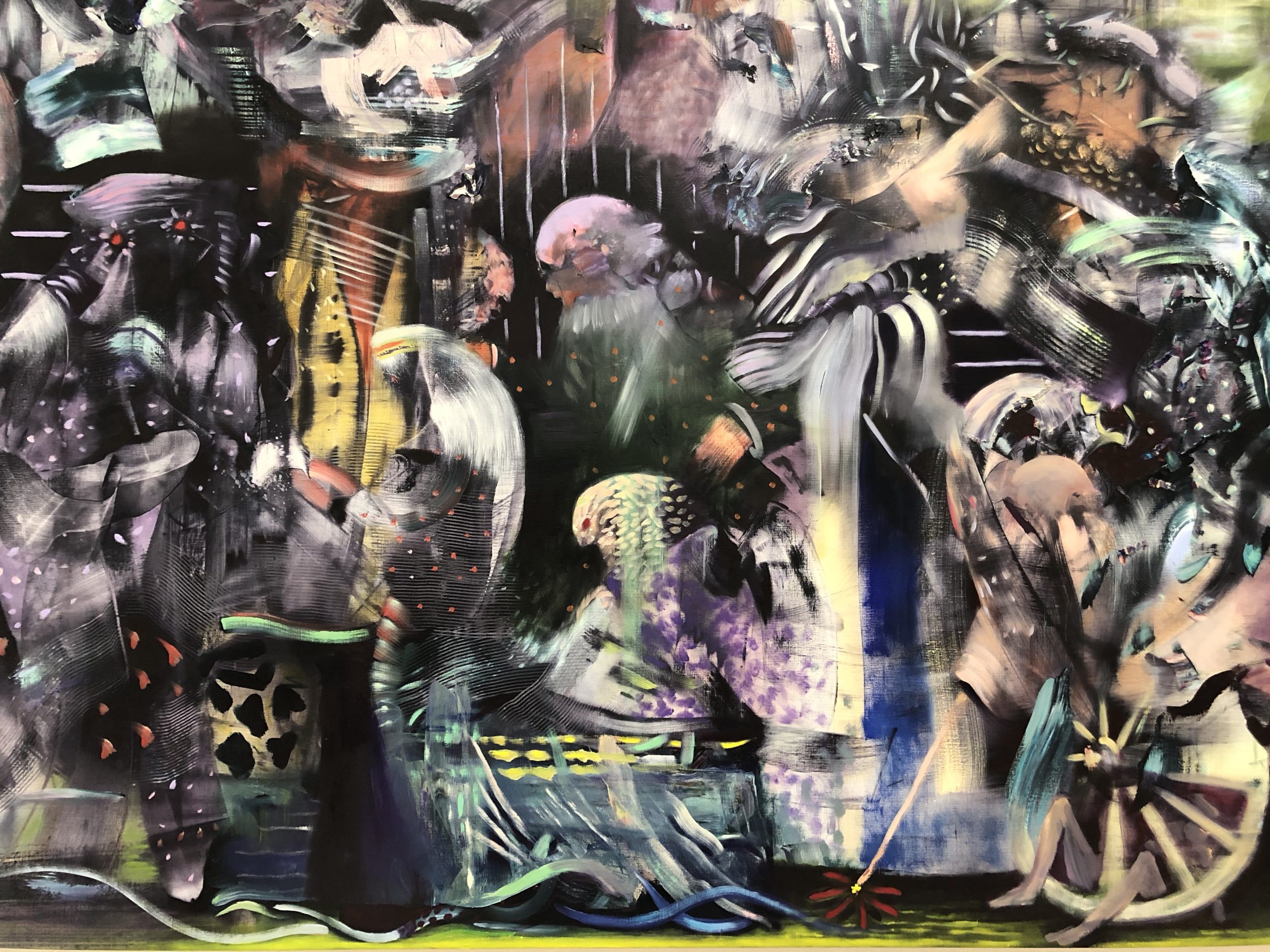
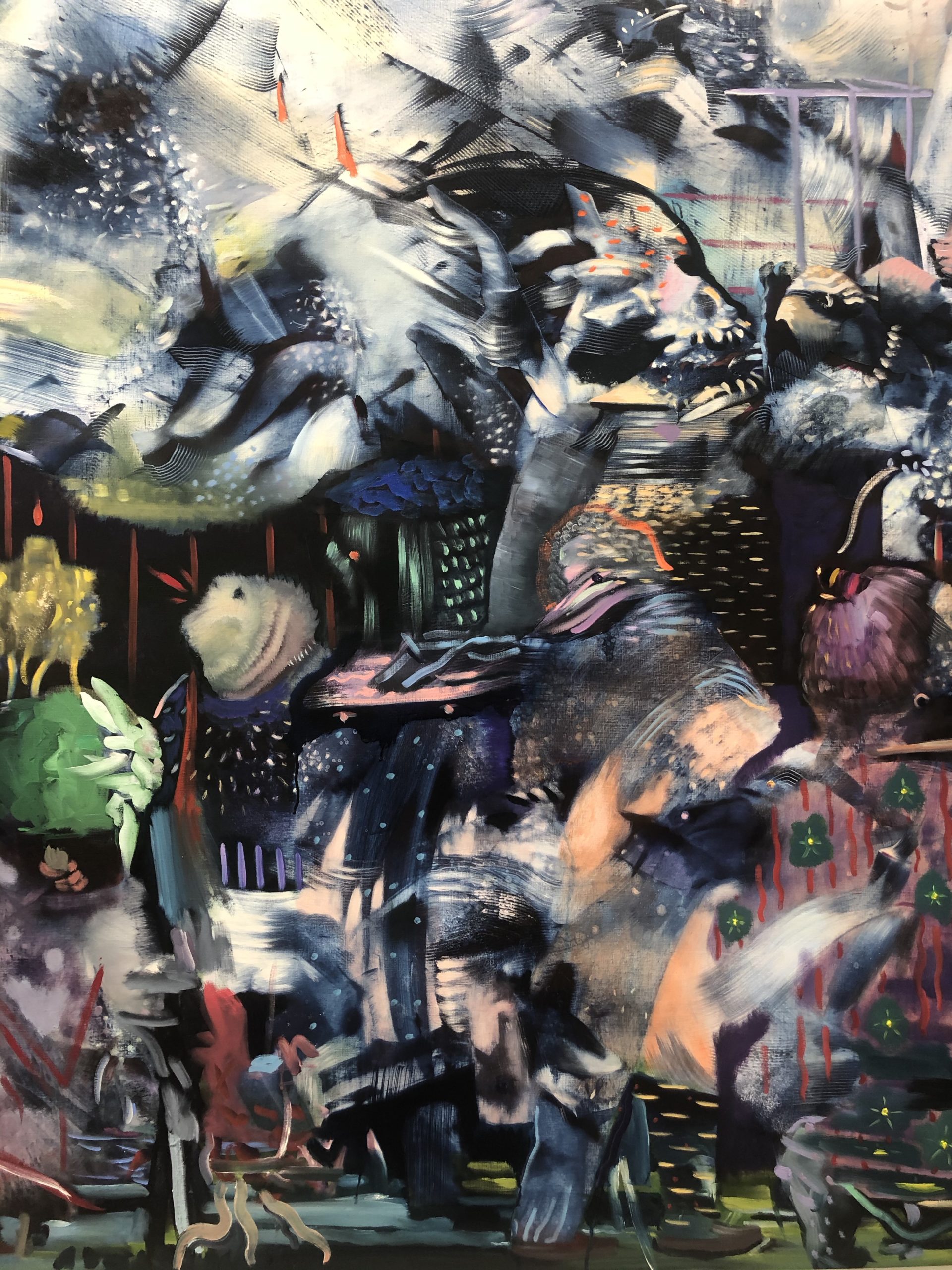
Here and above: Details from recent paintings painted in confinement
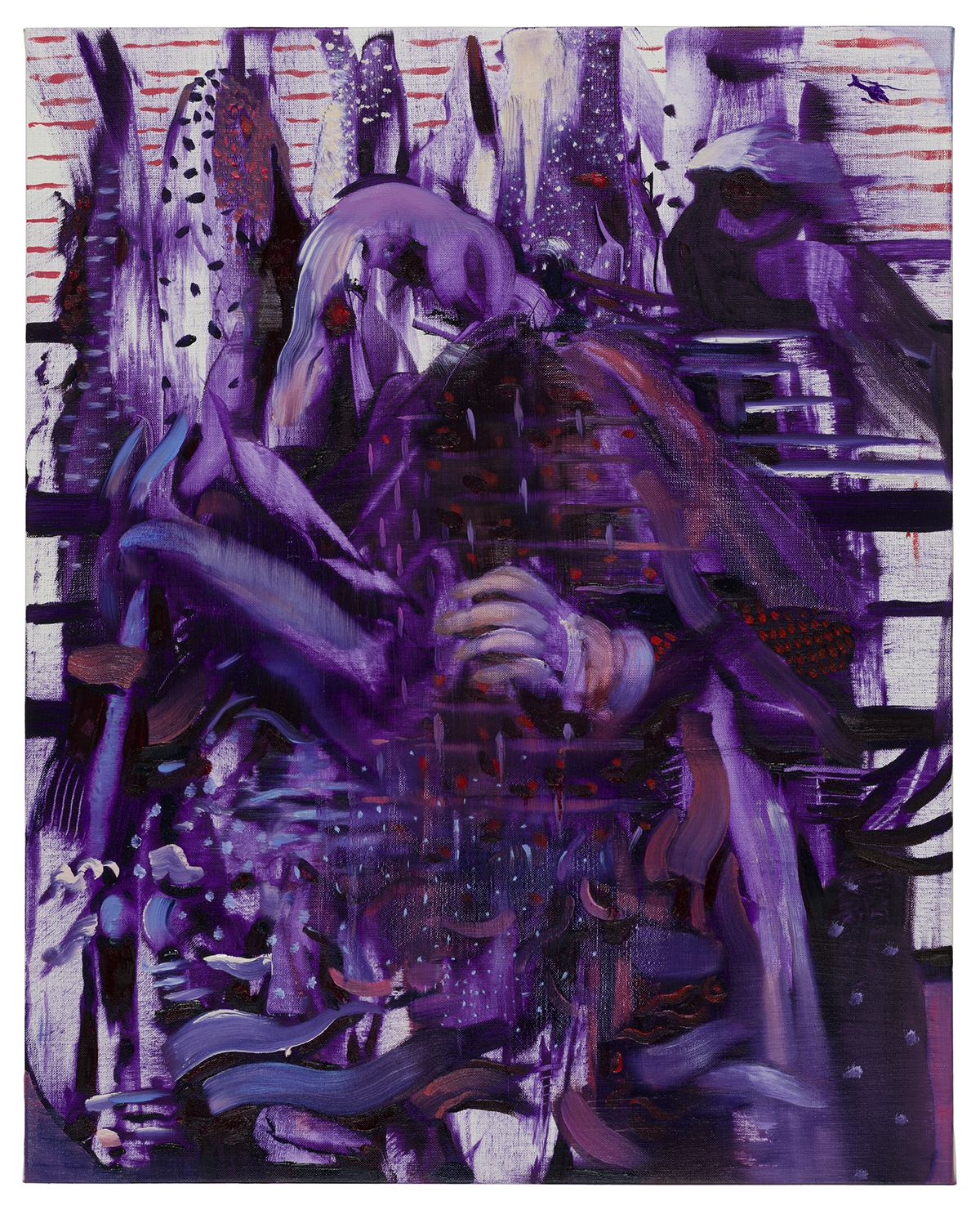
‘Only Breath’ by Ali Banisadr

Caragh Thuring
May 23, Strachur, Scotland, Home
The current pandemic beautifully illustrates how strained and fragile our social and financial buffers are.
The chronic, unsustainable economic inequality pandemic, could also do with finally being vaccinated.

Subodh Gupta
May 23, Gurgaon, India, Home
We all know we’re going through a big crisis; all of us slowing down has led to some good things too. It’s a time to reflect and maybe we needed this to do so. However, the most painful and unjust thing has been the condition of migrants workers walking home.

Derek Fordjour
May 22, The Bronx, NY, Home
Several weeks ago, I received a frantic voicemail from my cousin at 7am. My uncle was dead. She was frantic with shock and loss. When I reached her later, her shock had morphed into utter outrage. The local community funeral home was no longer accepting bodies. Before I could muster a word of consolation, the very real dilemma of finding a host for his corpse dominated her focus. Fortunately, another relative, employed at New York City hospital, agreed to do a favour to the family and provide temporary storage for the body. The helplessness I felt, the desperation in her voice, the horror of peddling the dead body of a beloved parent in a city overrun with corpses. This is my reality…one person removed, in a multitude of relationships, from devastating human loss without the comfort of dignity or time or grace.
A neighbour recently shared a nightly encounter with a foul odour on his commute walking to the train from work in Brooklyn, each night for the past week. After the issue was resolved, he learned that it was a massive refrigerated tractor trailer overrun with dead bodies that had been emptied to make room for more. It was the stench of decomposition and death. Over the past month, I have relayed countless times to friends and family reassurances that I am fine. I must also remember that the gift of protracted time and increased creative focus I relish daily was underwritten by deeply personal losses en masse. As much as this is a season for recalibration and renewed commitments, it is also a season of death. Let us not forget.

Sharon Eyal
May 21, Tel Aviv, Israel, Home
“…things get broken, and sometimes they get repaired, and in most cases, you realize that no matter what gets damaged, life rearranges itself to compensate for your loss, sometimes wonderfully.”
Hanya Yanagihara | A Little Life

Mary Weatherford
May 20, Los Angeles, Home
I flew from Los Angeles to Cape Town in early March to start a trans-Africa journey. My boyfriend and I planned to travel improvisationally north to Morocco, landing finally in London for my exhibition at Gagosian in June. Instead, we stayed put. The Western Cape is, as everyone says, spectacular. Huge green mountains push right up to white sand beaches. The Indian Ocean is clear and chilly. The South Atlantic, clearer and chillier. Schools of tiny fish swim at your ankles. Penguins hang out on rocks. The Cape Floral Kingdom is incomparable on earth. Hiking is crushing flowers with every step. And the light! South Africa is also, as I expected, an emotional jolt. Half of Capetonians live in densely populated townships – Khayelitsha, Mitchells Plain – where government-built housing is brick with running water but most shelter is informal construction, corrugated metal with shared water taps and toilets. The biggest TB and HIV/AIDS epidemics in the world are ongoing in South Africa. Poverty pushes right up against wealth.
So, when President Ramaphosa went on TV the evening of March thirteenth to announce COVID-19 lockdown, it was strict. No planes in. No planes out. Cargo ship crews not permitted off vessel. No walking dog. No walking outside except to market or pharmacy. No driving between districts within city. Ten thousand field workers dispatched in door-to-door COVID testing and screening. No alcohol. No cigarettes.
Thirty-five days later and only 3,500 known case in country, we took a repatriation flight to London organised by the Canadian High Commission. From there, traveled home on a near-empty British Airways flight.
The view from my window in Los Angeles differs little from when I left. More walkers, most in masks. Springtime verdancy belies an unfolding global emergency. The structural weaknesses of the United States and uncanny similarities to South Africa – two countries with exaggerated wealth inequality – are revealed. On any given night about sixty thousand people in L.A. are homeless. Of those, nearly 5,000 are children. Kids not going to school aren’t getting enough to eat. Less than half of L.A. still has a job. Food insecurity has skyrocketed.
In conclusion, here’s how to help:
Cape Town: @thebigfooddrive
Los Angeles: lafoodbank.org

Konstantin Kakanias
May 20, Los Angeles, Home
As we slowly come out of the lockdown in Los Angeles, life is certainly not the same. This quiet period of quarantine has given me the much needed opportunity to rethink, reevaluate, restart and reconsider everything, really. For quite a while, I’ve felt very sad and guilty about our society of excess, of mindless grabbing and throwing things away like there is no tomorrow.
I have taken the decision to be much more considerate of everything around me and spend time listening to the trees, the plants the animals and all the insects. Kissing the earth and going beyond the rainbows. A single leaf of any tree – this is the key to my spiritual life. And that should be enough .

Katherine Bernhardt
May 20, Antigua, Guatemala
What’s going on in your mind?
I’m here in Antigua, Sacatepéquez, Guatemala, in Central America. Upon arrival here, they checked our temperature at the airport, and anyone with a high temperature was sent into quarantine. The next day they closed the borders. The president is a medical doctor and does not want anyone in Guatemala to get this virus so he has decided to take precautions to avoid tragedy. If you go outside without a mask on, the fine is 20,000$ or 150,000 Quetzales and/or 6 years in jail. We have daily curfews, and on weekends everyone must stay in—nobody is allowed out except essential workers and people going out for emergencies—from Thursday night until Monday morning. President Giammattei updates the nation on Sunday evening TV talks about what’s going on across the country.
So far, about 29 people have died here. It feels safe and wonderful here. The weather is perfect. Birds sing all day. The food is fresh and delicious. The people are friendly and helpful.
I have met two different tailors here, one weaves in the traditional method, but specialises more in embroidery, the other makes interesting tops out of amazing fabrics. The huipils—the traditional hand-woven tops that have been made here by the indigenous peoples since well before the time of Columbus coming—are awesome. The women still weave them and wear them. Each town specialises in a certain design featuring particular symbols and colours so when women wear them across Guatemala it is a sign of where they come from and a form of indigenous identity.
The rainy season is beginning these days. The sky is more often dark now, but we haven’t had lots of storms yet. It is wonderful living an indoor-outdoor lifestyle. I live in a tropical paradise and swim in a hot pool every afternoon. When I walk around birds say ‘hola!’ to me. The national bird is the Quetzal, but it only lives around Coban in cool forests so I haven’t seen one yet. I eat fresh guacamole every day.
I’ve been here since 12 March, it is now 19 May…2020. I have set up a studio in a patio here next to my room. I am surrounded by an old fountain, lots of colourful plants, loud singing birds, and textiles hanging out to dry. I paint paintings on paper of quetzales, flores, Nitido, Gel, 7-UP, Pepsi, toilet paper, huipiles. Right now, I am painting Kool-Aid jugs with runny colours. I listen to Ozuna and Bad Bunny in the patio. Through my Instagram, I am selling huipils and other textiles from a lady who works outside. At night, I Netflix and chill. When I wake up in the morning, I eat pan francés with chocolate. I live a variation of this same amazing day, every day, now.

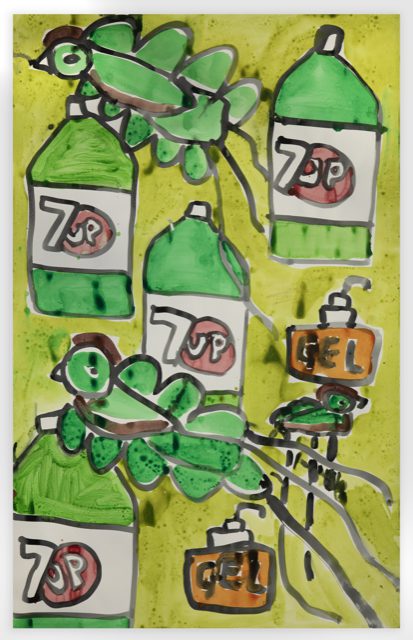

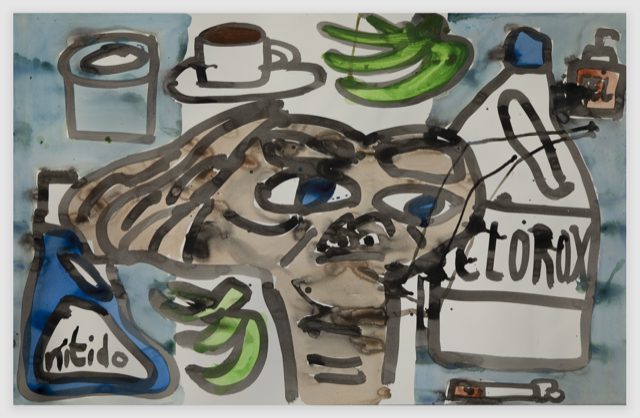

Mary Sibande
May 20, Johannesburg, South Africa
There is an age old idiom in my mother tongue iSiswati to express impossibility. These are not normal days. My mind keeps circling on about ephemerality of life.
I have experienced seeing a lifeless body of a dear friend recently. I had witnessed both at once his energetic, love, full of jovial character against his lifeless and statuesque corpse.
In many ways, evidence suggests that my partner and I were chosen to be present in the following hours after his last moments, right before he became a fading memory for all of us, a picture greying right before my eyes.
People say, for example, when confronted with something they consider absurd “lilanga lingawa licoshwe tinkukhu” (The sun would fall and the chickens would chase it). It would have been apt, some 50 odd days ago that we would be all in-prisoned in our homes for a fear of an unseen enemy. An enemy daring us to venture out at the risk of losing our life.
The global pandemic has gripped our imaginations, put into play some of our best and worst qualities as humans. Generosity against selfishness, and somehow pairing the two together for a good outcome.
It may now be appropriate to rethink this phrase as “Lilanga liwile lacoshwa tinkukhu”(The sun has fallen and chased away by the chickens). The protagonist in this phrase is the sun, whose power has been sapped and chickens rule and have the power to chase a ball of contained fire.
We are in Animal Farm again and this time the environment, the celestials are involved.
Nature is reported to be recouping, scenes of dolphins swimming in the clearer waters of Venice, once again the night sky is not murky and stars blink brightly. Areas where life was declared over raising up like Lazarus, showing us the cost we impose on nature as the so-called caretakers of the earth.
Once in a while we hear experts of society say that the virus knows no class, race and status and yet, in contrast it has more than exposed dramatically those categories. The effect has been tragic for those who aren’t rich, to those who aren’t able to social distance in the small spaces that they inhabit. The world is rightfully topsy turvy and…The impossible has happened!

Edel Rodriguez
May 19, New York City
My time is spent in the studio, reading, watching news reports, trying to make some sense of what’s going on, commenting on it through my work. Isolation has made us have to live more simply again. The art world over the past ten or so years had become a series of art fairs and conferences, artists going from one place to the next, giving talks, staging performances, and so on, all of it exacerbated by social media. There was always something going on, or a place to be. It’s good to have some time to stop for a while and focus on what we want to make instead.
I have extended family members working in hospitals at the moment, helping those in need. We had a scare recently, as one of them became positive through their work with patients, and many in the family had to be tested. Things seem to be on the mend for them now, and it’s brought some relief.
With all that is going on, art is a wonderful distraction, something to focus on that makes the hours pass by very easily. I was reading too many news reports before, thinking about those that had passed, and it all became a bit much. I stopped excessively reading the news and started spending more time painting and drawing. It has definitely helped.
This past summer, I went back to my hometown in Cuba for a couple of weeks. There is no web access there, and no entertainment. I spent much of my time talking with family and telling stories on the porch. I made a couple of dozen paintings and drawings during my short time there. It made me realise how distracted I had become in New York City.
What is happening now has focused my family and I in a similar way. The kids are working on projects they’ve talked about but never made the time for. We’re cooking together, reading more books, and telling stories on the porch. I look forward for this to be over, but hope that we can keep some of the good things we’ve learned along the way.

Jimmy Nelson
May 18, Amsterdam, Home
The essence and purpose of my world, throughout my whole life, has been to celebrate in a very romantic, indulgent and iconographic way, the world’s last tribes who have lived in harmony with themselves, their culture and the natural environment that they live in – unlike us, in the developed world who have decided that the planet perhaps needs us. The indigenous communities of the world live the other way around. We need the planet – so the art that I create is aligned with this message, and coincidentally, with the world being in lockdown over the last few months, I could not think of a better time when my message can begin to resonate with the world, from an artistic point of view. Finally, what I have seen and felt, but also connected with and ultimately loved, through the pictures that I take and the stories that I tell, perhaps can serve as catalysts in waking the world up and finding a way to better live with one another, with ourselves, and ultimately with the natural world at large.
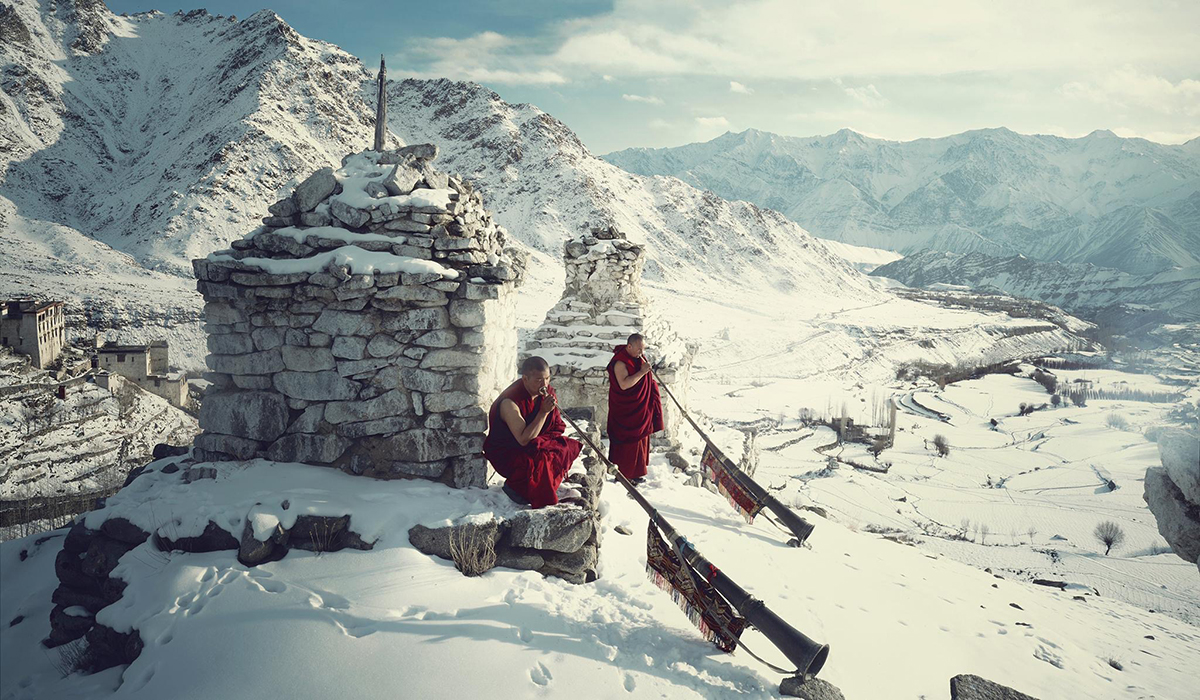
VII – Lekir Monastery – India, 2012. Courtesy of Patricia Low Contemporary
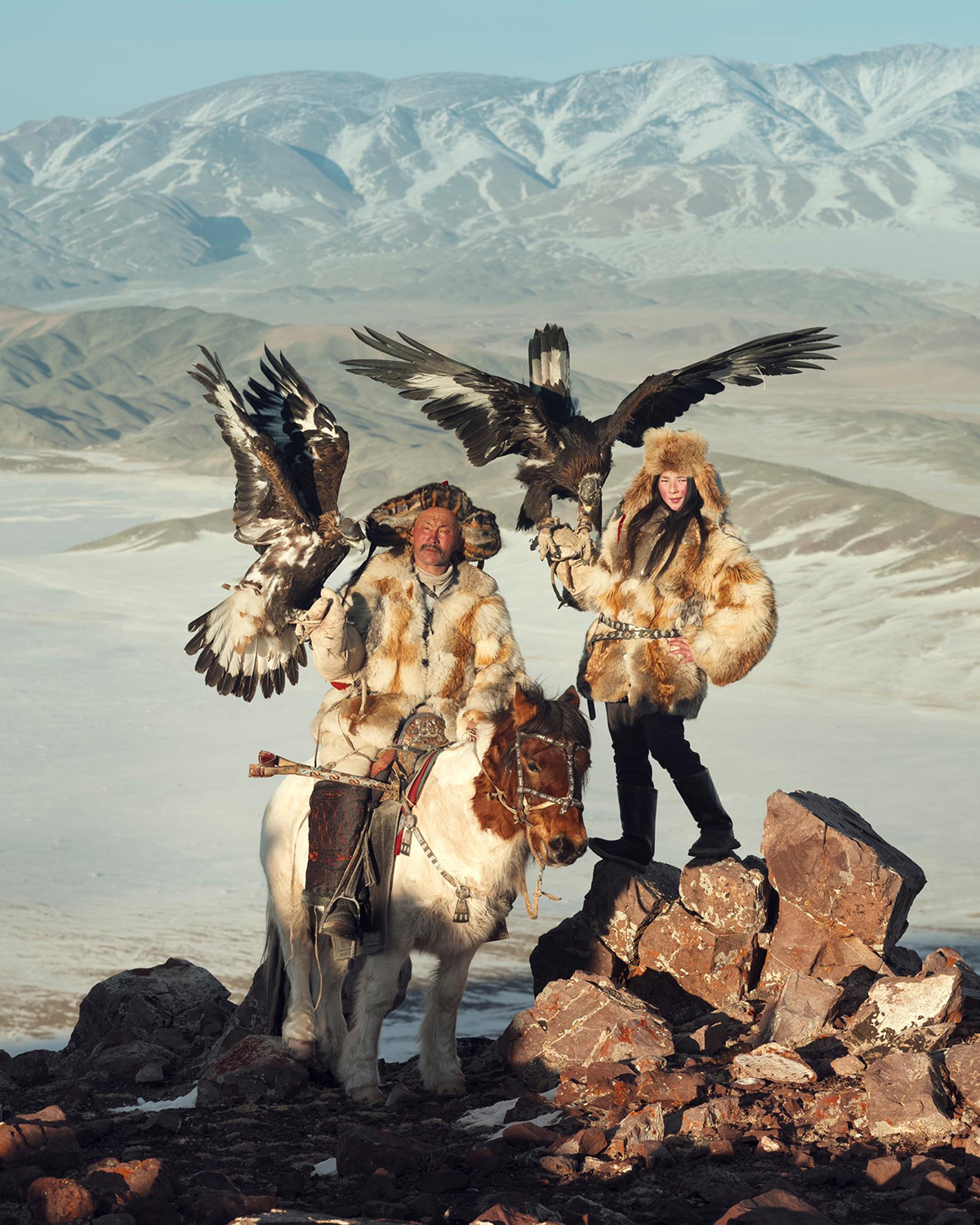
XXX 116 Dalaikhan with girl Khoyor Tolgoi Hill, Altan Tsgots County Bayan Ulgii, Provence, Mongolia 2017. Courtesy of Patricia Low Contemporary
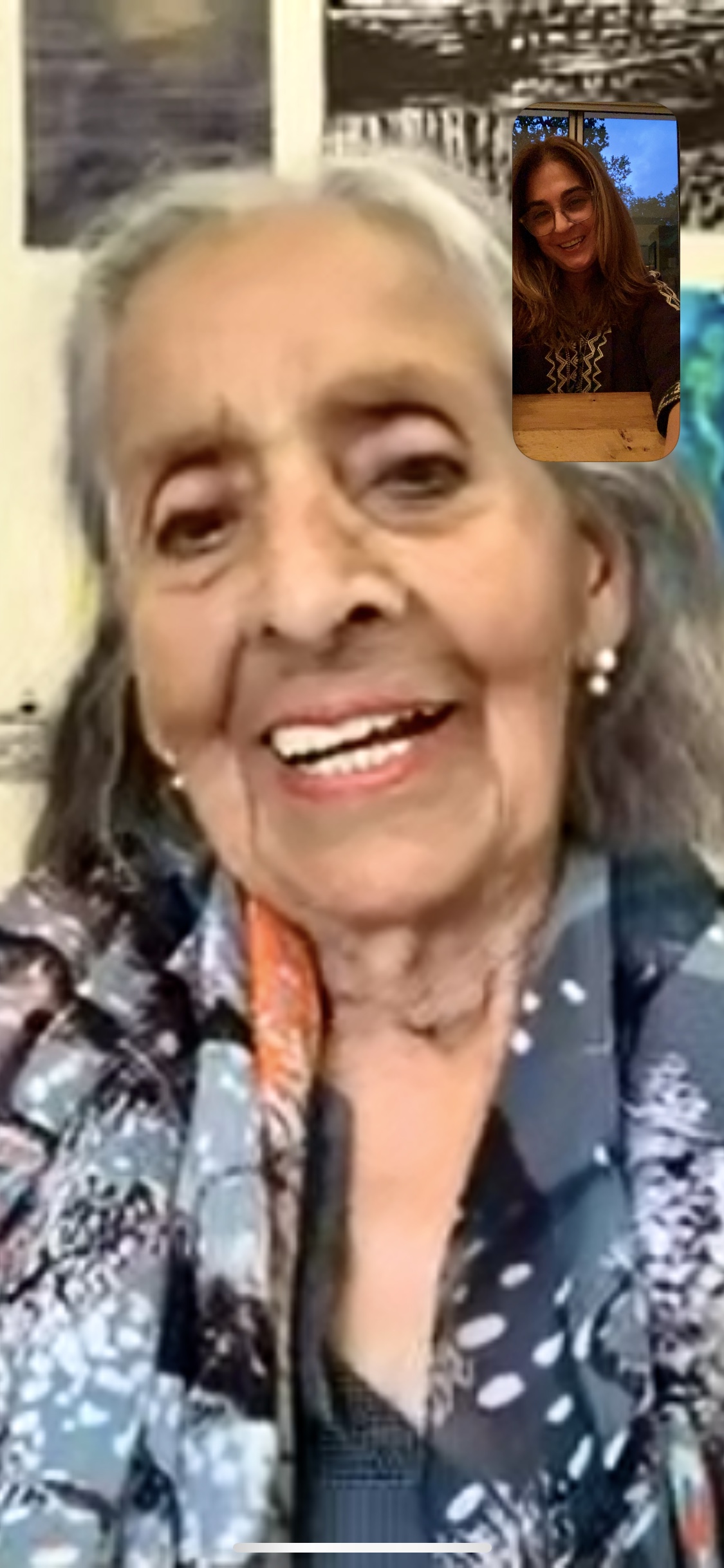
Luchita Hurtado
May 18, Santa Monica, California, Home
It’s very serious–the situation in the world today, and I’ve been talking about it for a long time with just simple words like “air, water”. We’re running out of water, the poles are changing, everything is in flux. We are looking the other way, and we have to look straight at things and decide we are going to clean it up.
I don’t think the virus is a result of our thoughtlessness of the world, but it’s partly to blame. It should be our first concern–the health of our planet. It’s where we belong. We’re creatures of this planet.

Miguel Soler Roig
May 18, Madrid, Home
A Time of Intermission 新冠病毒的故事
Over the last three months, I have been increasingly made aware of the problem we are experiencing today, given that I have been communicating incessantly with art world friends, especially those living in China, since the beginning of the spread of this deadly virus, at the end of last year.
In communicating with family, friends and colleagues globally, I think it would be fair to say that we all agree that this situation has indeed changed our daily routines. It has left us time to think that there are indeed other ways of contemplating and comprehending our existence, that life consists of much more than a handful of material goods, and that we do not always appreciate what we have, often taking things for granted. Instead, we need to be grateful for every day that we have and enjoy on this planet.
My reflective nature leads me to seek tranquillity and to keep calm with the right dose of inner peace. I’ve listened to music. I have also tried my hand at writing, and as the days went by, I never once felt bored. In fact, I wish I had had more time to spend on my new body of work.
This has been a signal to the entire world population, a global wake-up call. For the first time, we, humans, are taking steps in the same direction, allowing us to come together, as brothers. We’ve given the world and nature a break so that we can survive and hopefully co-exist. Above all, we have understood that from now on, many things will need to change. This intermission will no doubt produce a new period of deep inner thinking. We owe it to ourselves to establish new rules and new scenarios in order to carry our civilisation forward, whilst trying not to fall into the same pattern of mistakes as before, mistakes which were principally governed by greed.
We must fight together against fear, eliminate selfishness and herald empathy. At the same time, we need to understand that the greatest character trait we need to embrace and safeguard whilst isolated is that of harmony and optimism.
And along the journey, we have also quietly said goodbye to many who have left us and with whom we shared fond memories alongside the beauty of love. We have and continue to find power in faith, and give ourselves no choice but to move forward with compassion, with tolerance and with deep care for one another.
Miguel Soler-Roig
Madrid, May 15th, 2020
@miguel.soler.roig
soler-roig.com
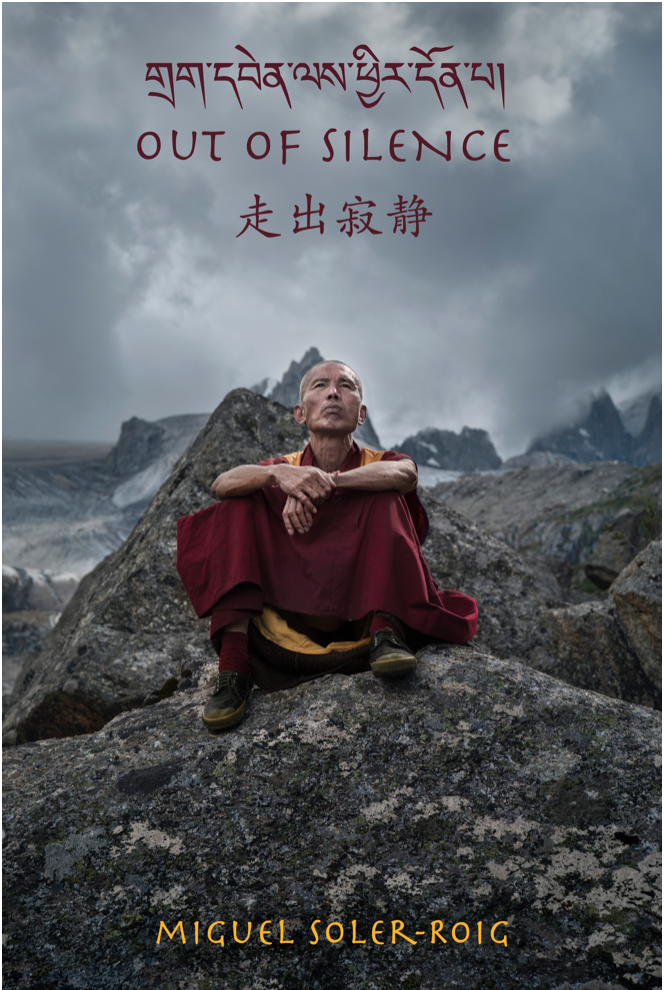
Trori Dorje Ziltrom (5.816 m) in The Eastern Himalayas, Tibet, 2016.

Kimsooja
May 17, Seoul, South Korea, Home
We are imprisoned by the mobility of our time, and the whole world is fighting against this invisible singularity that multiplied all over the globe.
Contemplating on all the species, and each one’s egoistic survival instinct, isn’t Corona virus also ‘a life’ that fights against humanity for its own survival?
Where and how can we find the fine balance to coexist with all the species even with this fatal virus without harming each other?

Akram Zaatari
May 17, Beirut, Lebanon, Home
This is not the first confinement I have experienced and will most likely not be the last one either. For a Lebanese of my age, it feels strange to be forced to stay home, when the world outside is not at war. No. Being placed face to face with a virus does not indeed qualify as war. Those who have lived through an actual war will surely realise the peaceful nature of this particular confinement. I am able to draw, to sleep, to cook as well as truly give reading the time it deserves, as well as spend time organising my work, and most importantly feel no guilt while staying home. The whole world is slowing down , and it’s going to be very difficult for us all to adjust or to go back to ‘normal’.

Antony Micallef
May 17, London, Studio
My initial response at the world stopping was one of perplexity and astonishment. For once, as humans, we had to take a step back. It felt like our hierarchy had been reshuffled somewhat and we had no choice but to eat humble pie. I also think we have experienced all shades of the emotional spectrum. From the fear of loosing loved ones to being separated from family, we have all been tested in different ways.
When the lockdown happened, I had been working on my new body of work (for the last 4 years), and was due to exhibit this year. My initial response was huge disappointment and selfish anger. I had channelled all this energy to fruition, and then the universe decided that the show could not go on. To be honest, my feelings have been completely inverted, and I have been reminded to just take a step back and pause. Like so many others in this period, I have learned to appreciate what I may have considered the smaller, less important things in life before. You can notice the subtleties when there is less noise, which makes them clearer and empowered with greater vibration. My friends and family all seem safe and well for now, and for that I am grateful. I feel proud to be human, and I feel deeply humbled by the will and spirit of our frontline workers and all those who are still making our society function under such great strain.
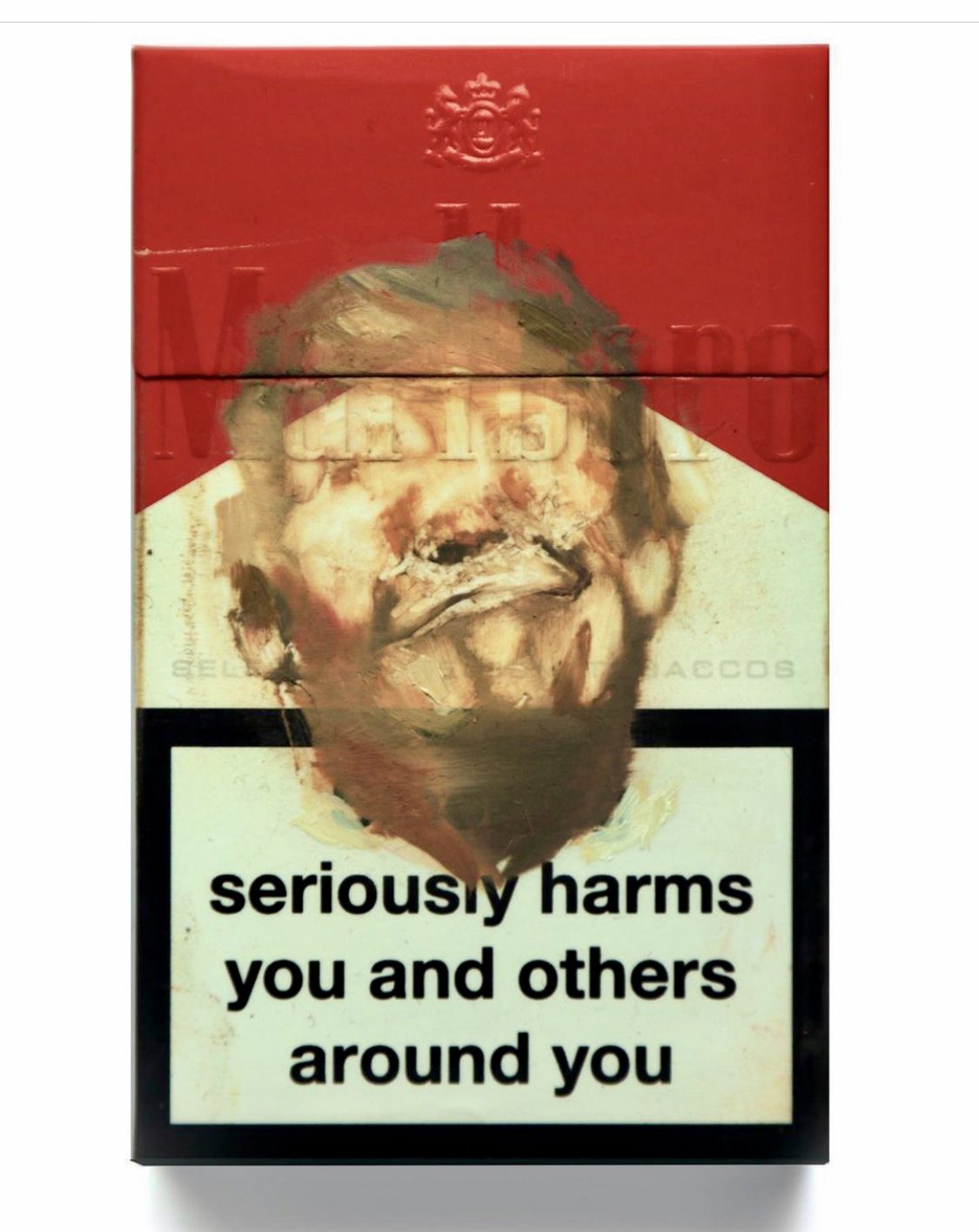
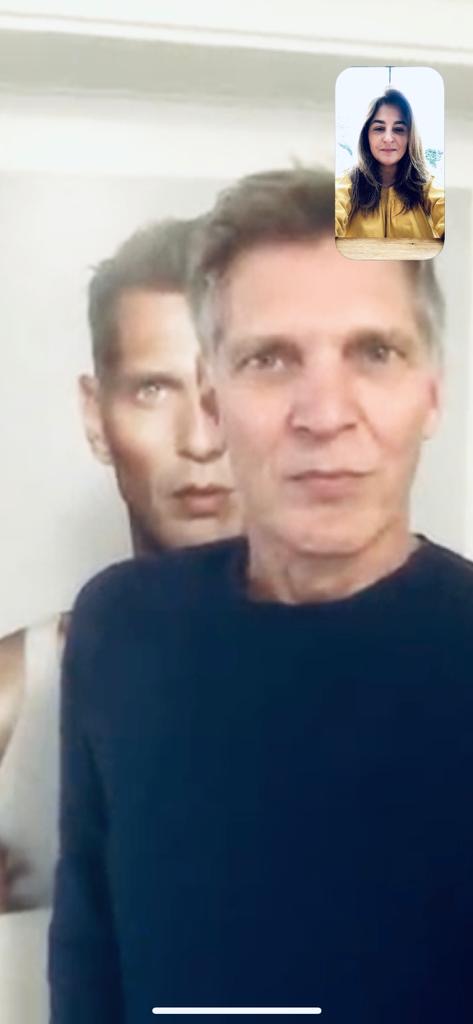
Erwin Olaf
May 16, Amsterdam, Studio
April Fool 2020
The visual narrative of April Fool 2020 gives shape to the emotions and images that paralysed me after we all suddenly woke up in the surreal nightmare of this pandemic.
Fear and powerlessness have dominated me for a few weeks now; I feel like an insignificant extra in some morbid film, the conclusion of which is entirely unknown. The plane in which we are all sitting has lost its engines – the benevolent silence is only a harbinger for what is still to come.
The supermarket shelves, emptied by hoarders, made me realise that for decades I have assumed that everything would always be there, that our dancing on the volcano’s edge would never end. Nothing could be further from the truth, and here I stand, my mouth full of teeth. Vacantly I walk around, waiting for the utter unknown, afraid of an enemy that I cannot see, and who I fortunately cannot feel yet.
The house of cards is collapsing, and we are all the joker.
Erwin Olaf
22 April 2020, Amsterdam
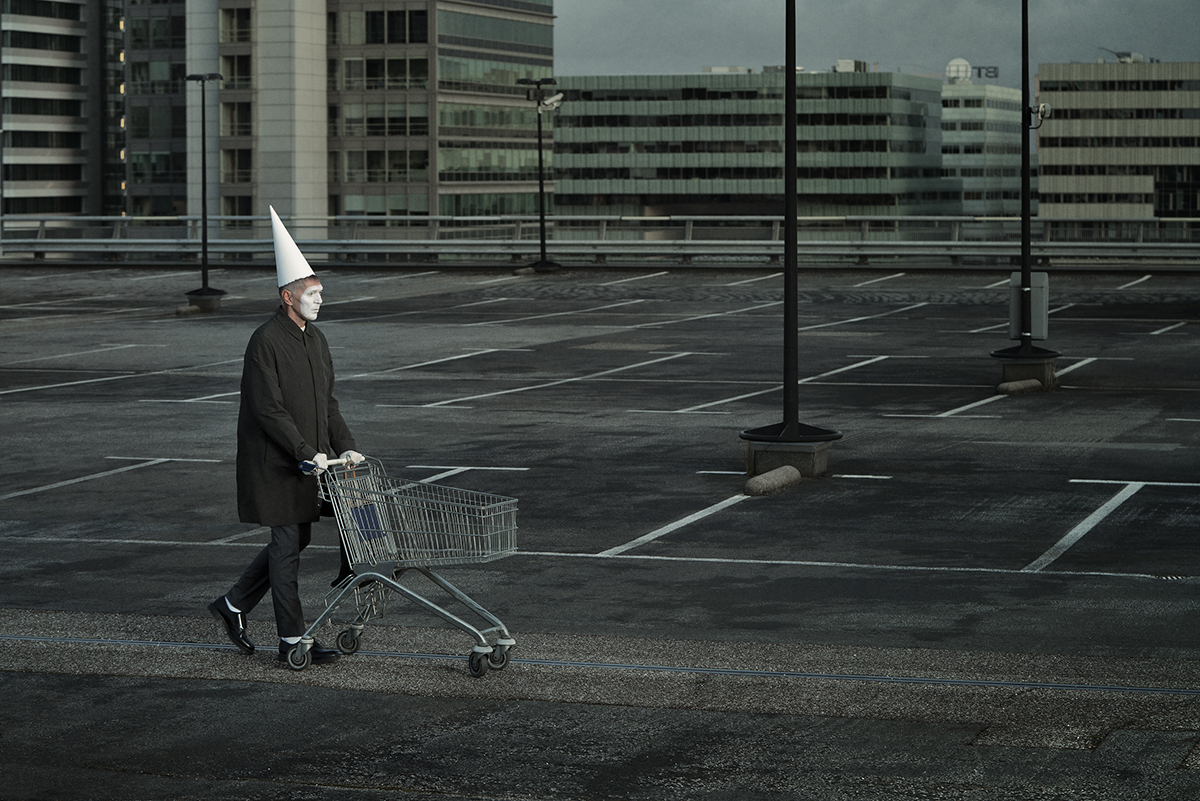
April Fool 2020, 9.45am. Photograph by Erwin Olaf. Courtesy: Hamiltons Gallery London, United Kingdom
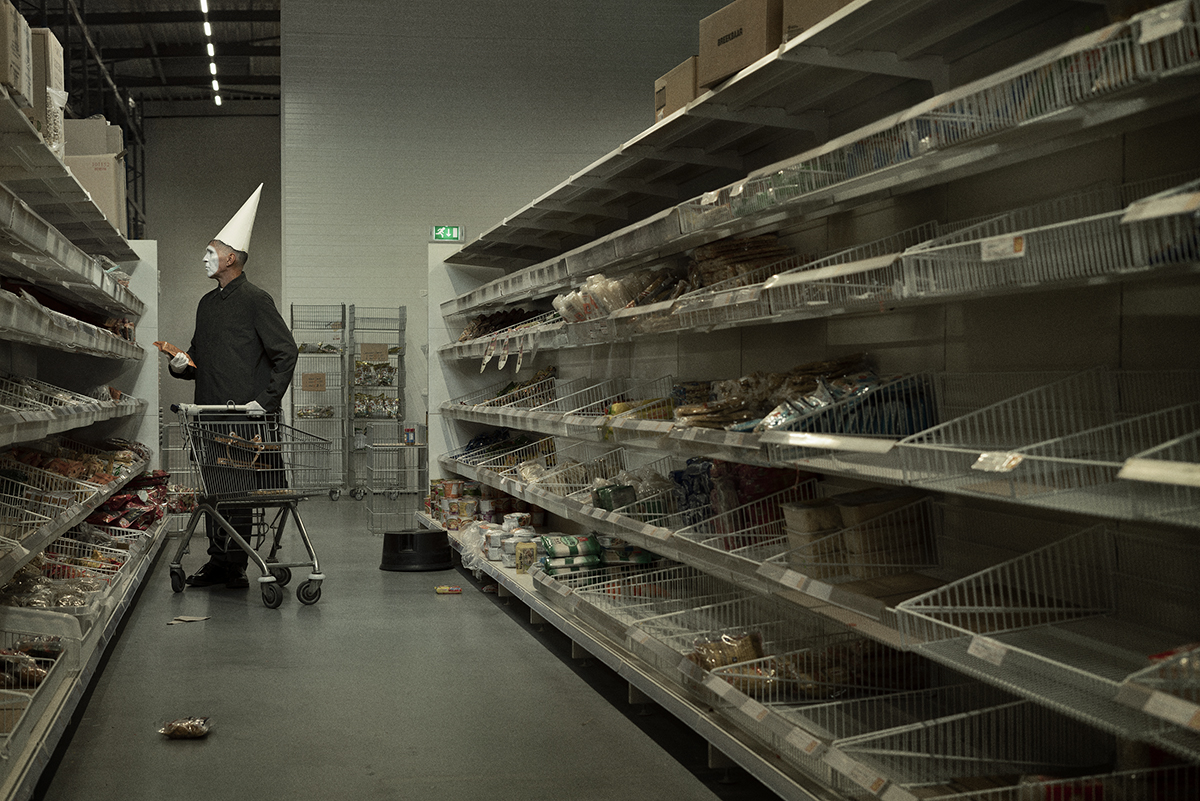
April Fool 2020, 9.50am. Photography by Erwin Olaf. Courtesy: Hamiltons Gallery London, United Kingdom
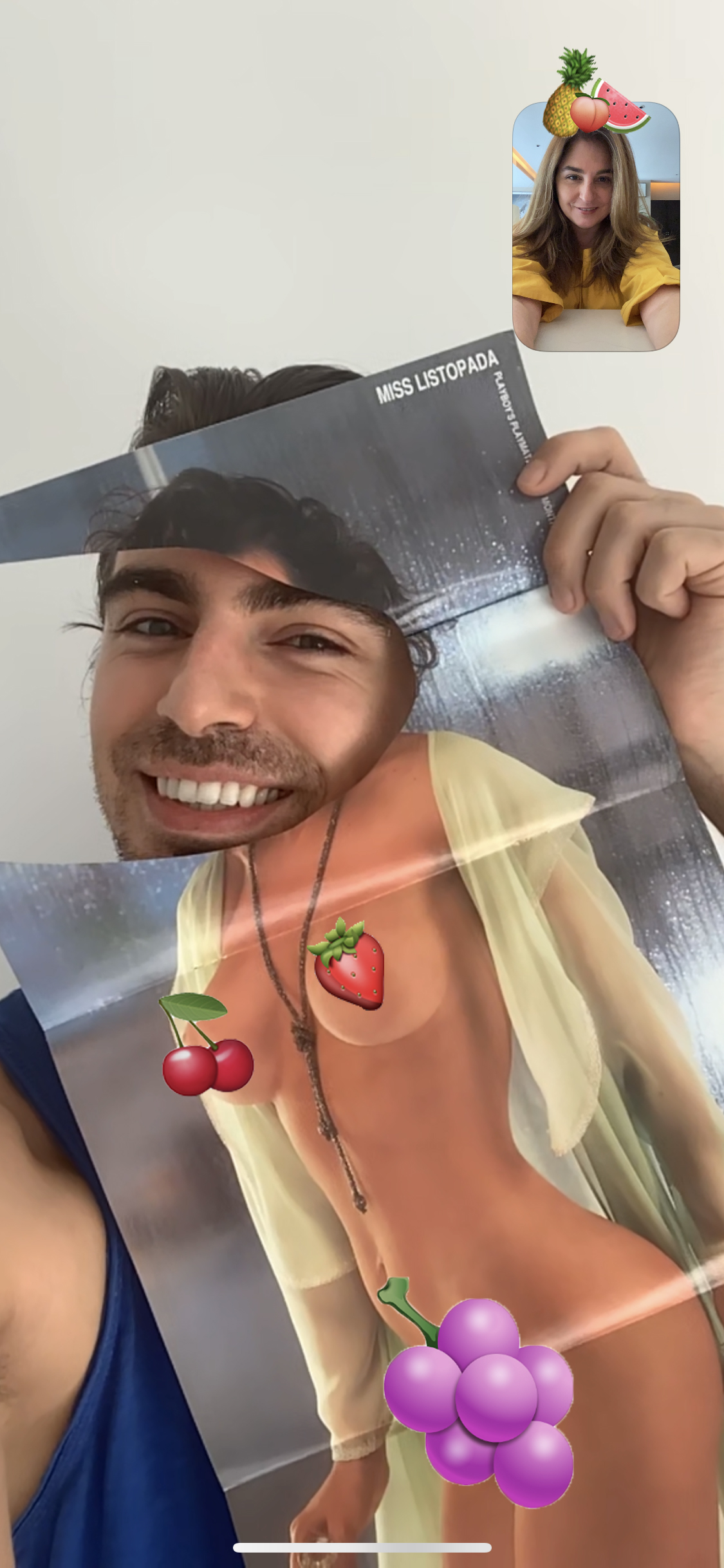
Piotr Krzymowski
May 16, London, Home
I have been entertaining myself during the isolation over the last few weeks with the collection of my dad’s early Polish Playboy magazines (he has no idea they are in my posession BTW). They were published around the time when I was born in the early naughties, way before we became so dependent on the network and the Internet. What struck me most was the advertising of the human-friendly technology and the Internet, which back then put people first before anything else. It’s hard not to look back at this imagery with a slight nostalgia at the times when today’s networked transformation is actually endangering humanity with vast digital monopolies and the pervasive culture of online surveillance. I miss the future, or at least the idea of it and a certain promise of comfort and safety that the early technology was offering.

Meiro Koizumi
May 16, Yokohama, Japan, Home
Here in Japan, the current government has been having so many scandals by now that it is almost impossible to trust the data, the information, and the stories given by them. So we don’t really know how bad the real situation is. We can not measure the size of the catastrophe. All we can do is to search for any coherent story in the internet while being locked inside our local environment. It has been very frustrating.
But one good thing is that I am spending a lot of time with my 7 year old son. It has been very fruitful taking a walk together in the park, seeing the sunset together, growing vegetables on the balcony, learning together about the universe, learning together about dinosaurs and most importantly, making a story book together, teaching him how to draw and how to make a story of his own.
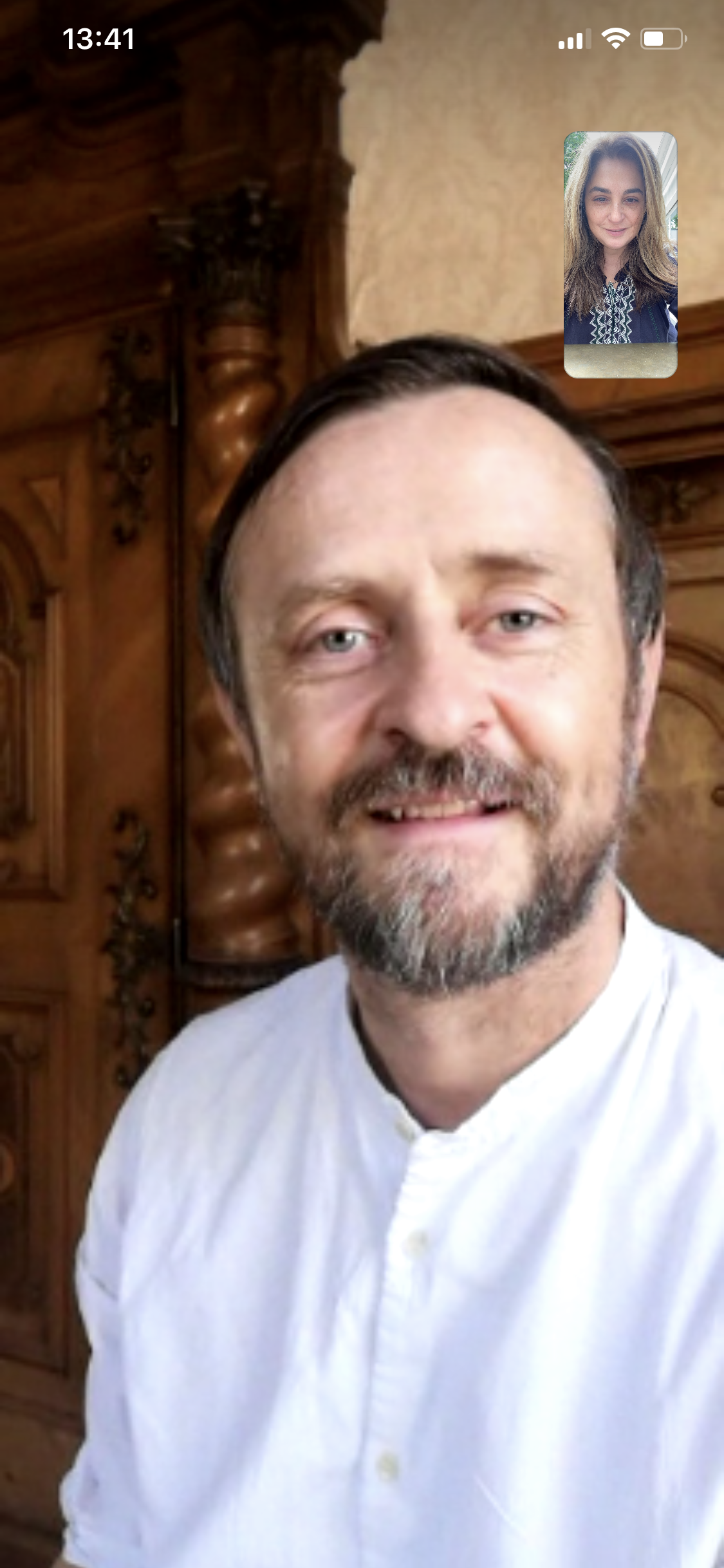
John Gerrard
May 14, Vienna, Home
Stoppage
When one is packing one is concentrating on all that.
When one is boarding a plane one is involved in all that.
Over fifteen years I have done a lot of all that.
These eight weeks of stoppage have forced me to think and feel differently.
It is exhausting and hard.
No varnishing that.
One yearns simply to leave again.
To move fast. To unfeel. To unthink.
I saw a film once in which an indentured labourer ran away from his place of work. And was pursued.
During the entire film he made it five miles from home.
The furthest he had ever got.
Five miles is now my horizon.
I walk. I think. I stop.
Who knows what will happen next.
JG
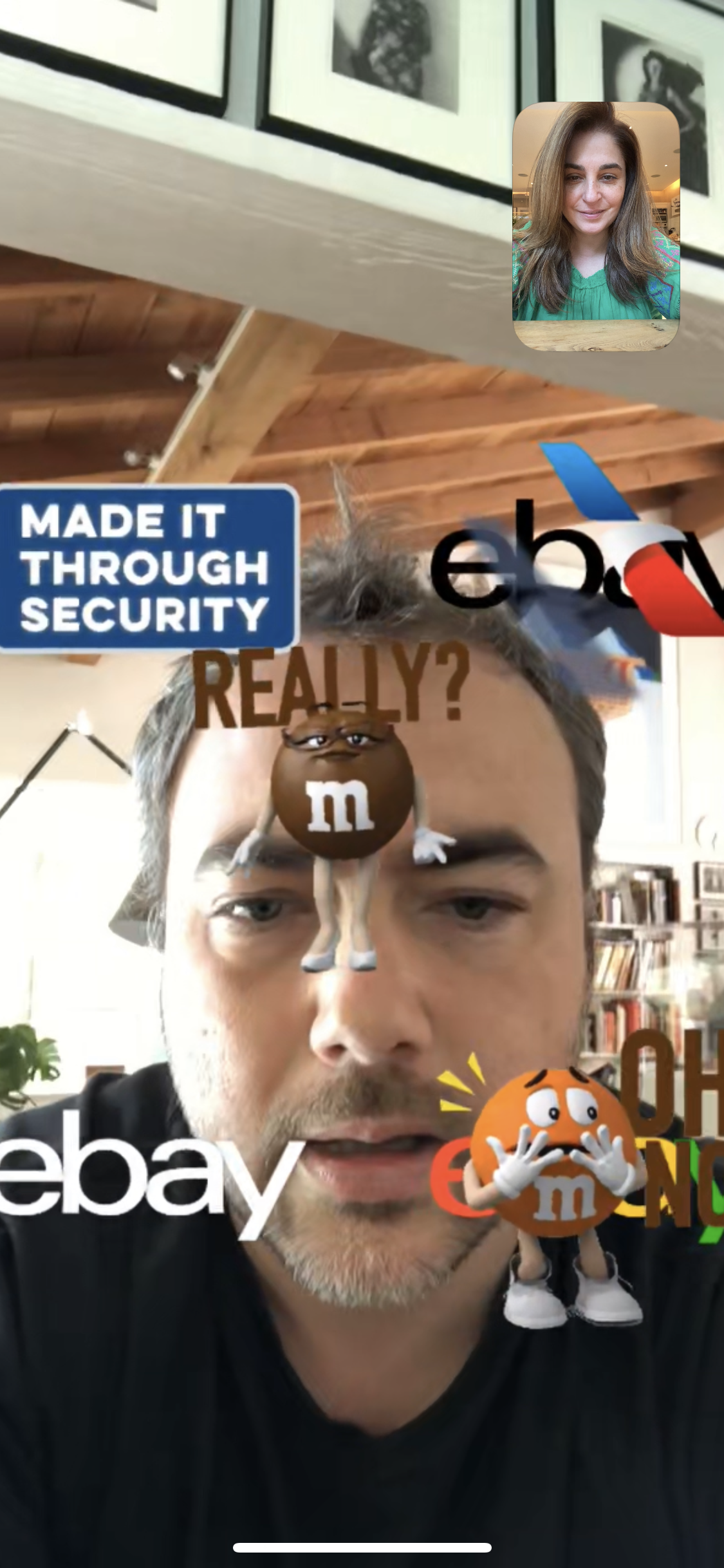
Walead Beshty
May 14, Los Angeles, Studio
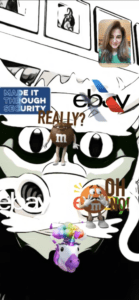
Dear Maryam,
Here’s my text; similar to the photo, I just used automatic functions on my phone to generate it (the suggested text algorithm in the iPhone OS which tries to predict what you’re going to write), just tapping on it blind. Oh, and leave in the ‘sent from my iPhone’ line.
hope all is well with you!
All my best,
Walead
I’m going on the hike today I hope you’re having fun and I’ll be back soon I love is a time for me maybe you could hang around for me maybe I could do a good thing and maybe you could do a good thing and maybe go get some rest I’ll be back in a couple minutes I wanna is a time for me maybe you could come and go do some work stuff for dinner 🍴 was that good good thing and maybe we could hang around and get a coffee ☕️ I wanna is a good day hope you’re doing good I’ll be there soon hope you’re having fun I hope you have an amazing day hope alls well is the afternoon and I love 💕 is the way to get a couple more of you and the family are doing well and you are doing great and I know what you wanna is like the way you want me to do so much fun you have any other questions that we are looking forward for tomorrow morning to see if I wanna is a time to get together for dinner and maybe I could hang with him in a little while and I’ll see what he wants me when you like me and I’ll send it back and then I gotta I want something that weird thing and you don’t have any other place you can have the other stuff and you don’t want it and I’ll send a check for it if that’s cool 😎 was that I like the best pizza 🍕 I wanna I love 💕 morning you want a wonderful and good evening.
Sent from my iPhone
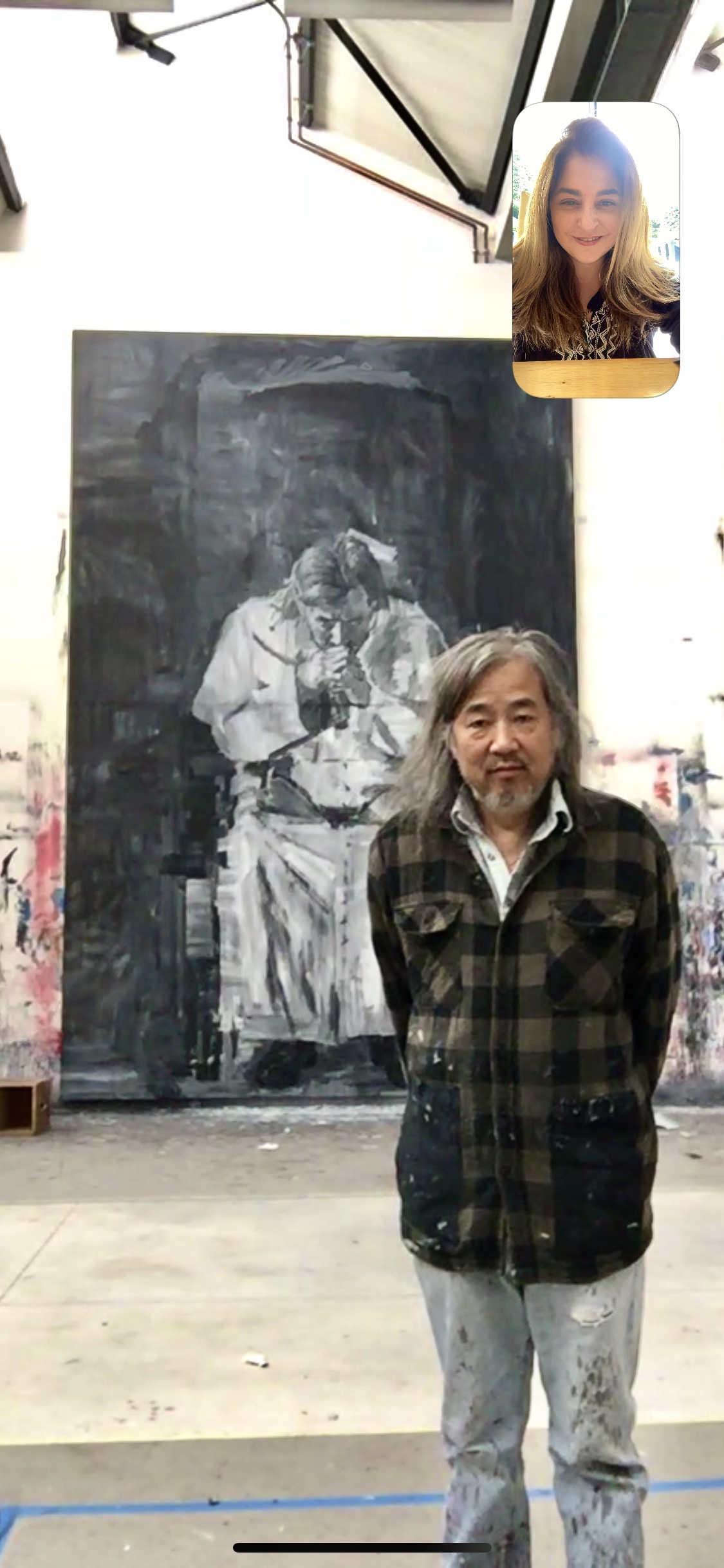
Yan Pei Ming
May 14, Dijon, France, Studio/Home
I’ve been adapting to confinement pretty easily. And, despite the world’s worrying situation, I have managed to set up a fairly strict routine that allows me to continue to paint. Every day, for the past two months, I have been working alone in my studio from morning till night. I don’t see anyone outside of my family. We only meet at dinner time, when we watch the news on the television, together.
Lately, I have become very curious about bats, as I am currently working on a series of paintings in which they play a central role. I believe that these animals are unfairly accused of being the cause of the pandemic, when in fact they are most useful to our planet’s ecosystem. On the contrary, it is deforestation, the destruction of the bats’ natural habitats as well as their consumption that are the real causes of this crisis.
Until a vaccine or treatment is found, the emphasis must be placed on education regarding the virus as well as prevention from contracting the virus – akin to the time in the 80s when people had to be massively educated regarding HIV whilst getting accustomed to using condoms, in order to protect not only themselves but also others. Today, prevention involves confinement, social distancing, barrier gestures and, of course, the wearing of a mask. Needless to say that masks are essential, and they need to be worn by everyone. Only then, will we be able to regain a sense of normality!
There is a lot of sadness, at the moment, all over the world, with the number of deaths constantly increasing, not to mention terrible economic conditions, a direct consequence of the spread of the virus. There will inevitably be many divorces [laughs], but also many couples will come out of it, stronger, and more together than ever before. I am confident that once this crisis will be over, we will regain our joie de vivre, because that is what human nature tends to do!
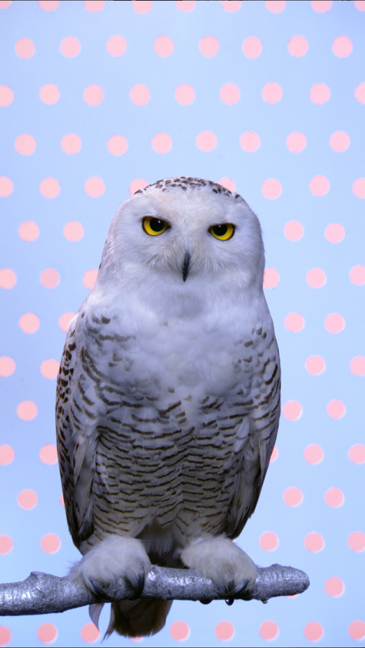
Robert Wilson
May 12, Berlin
It is in times like these that the ability to change is essential and the measure of our humanity, creativity, and survival. Gao Xingjian, the Nobel Laureate in literature once said, “Solitude is a necessary condition of freedom.” We find ourselves startlingly alone, and yet more connected than ever. I hope that this world crisis will bring about a better understanding of how we can work and live together.
Robert Wilson
April 2, 2020
Berlin
Robert Wilson would like to show his support of the project by kindly providing a link to one of his films: KOOL (Snowy Owl), 2006. Music by Carl Maria von Weber, arranged by Peter Cerone. Courtesy RW Work Ltd.
Opposite image: Robert Wilson, KOOL (Snowy Owl), 2006, Video still. Courtesy RW Work Ltd.

Richard Woods
May 12, London, Home/Studio
Generally I work on a very large scale; I like to make large public artworks. I use the studio to make sections of works that get shipped out of the studio and put back together somewhere else. The studio is a place where there’s a lot of ‘comings and goings’.
That’s all changed now, there’s nowhere for the works to be shipped to and I’ve found myself working on a tiny scale…it’s a first for me. It seems right. Maybe it’s because making art seems a bit wrong at the moment? A bit bad taste ? And I’m hiding stuff from myself…or maybe it’s just a practical decision? I think it’ll be a while before I find out which it is?
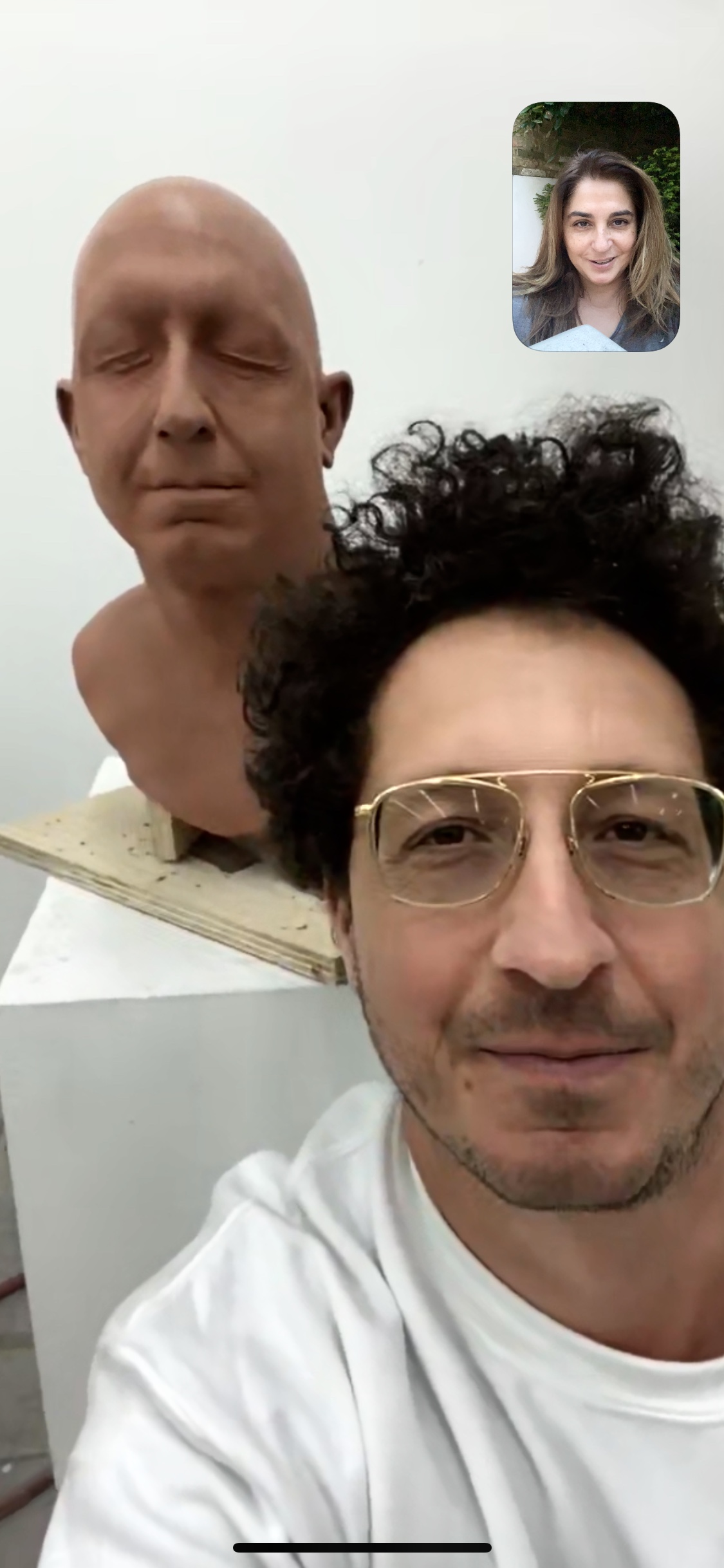
Tony Matelli
May 9, Long Island City, New York, Studio
Hi Maryam,
Great to see you the other day,
Everything has slowed down or stopped. We owe it to ourselves to try to appreciate this new speed. Assuming this pandemic will end, I want to look back and say I smelled the roses, not that I pretended nothing was different. Work junkies depress me.
I intentionally leave politics out of my work but personally, I’ve become consumed by them. It’s very hard to be an American and not feel totally in shock right now. We are living in a psychedelic moment; the door has been opened very wide to our reality. Only a few months ago, people were debating the appropriateness of a particular Christmas song…I don’t want to hear those bullshit conversations ever again. If we can’t focus on meaningful change in our society, we are doomed. If we, Americans, get to the other side of this pandemic without quality universal health care, we will truly be in a pitiful state.
Peace and love!
-T

Hurvin Anderson
May 9, London, Studio
As the world has slowed down, the studio in lockdown is in many ways the perfect scenario for a creative; all the quiet and space to reflect on work and time to make, interrupted less frequently now by admin and calls. At the same time, it has become a distracting space, full of mental ‘noise’, anxiety and worry for the vulnerable and those at risk. Throughout, I have been reminded of the power of community and relationships on the periphery of my practice, but also of the importance at any time of the studio, as a place of refuge and retreat. I have also realised, however, that the hustle and bustle outside, the general hubbub of commuting life, all the external energy of goings-on are as important to the creative process as calmness. I’m reminded every day that basic human interactions fuel everything and can’t be taken for granted, and that as we all become more insular, many of our reference points are lost. And still, I paint, and my children fill their days with craft projects and on some level, we are each comforted by our ability to make and express ourselves, amidst the topsy-turvy uncertainty of it all.
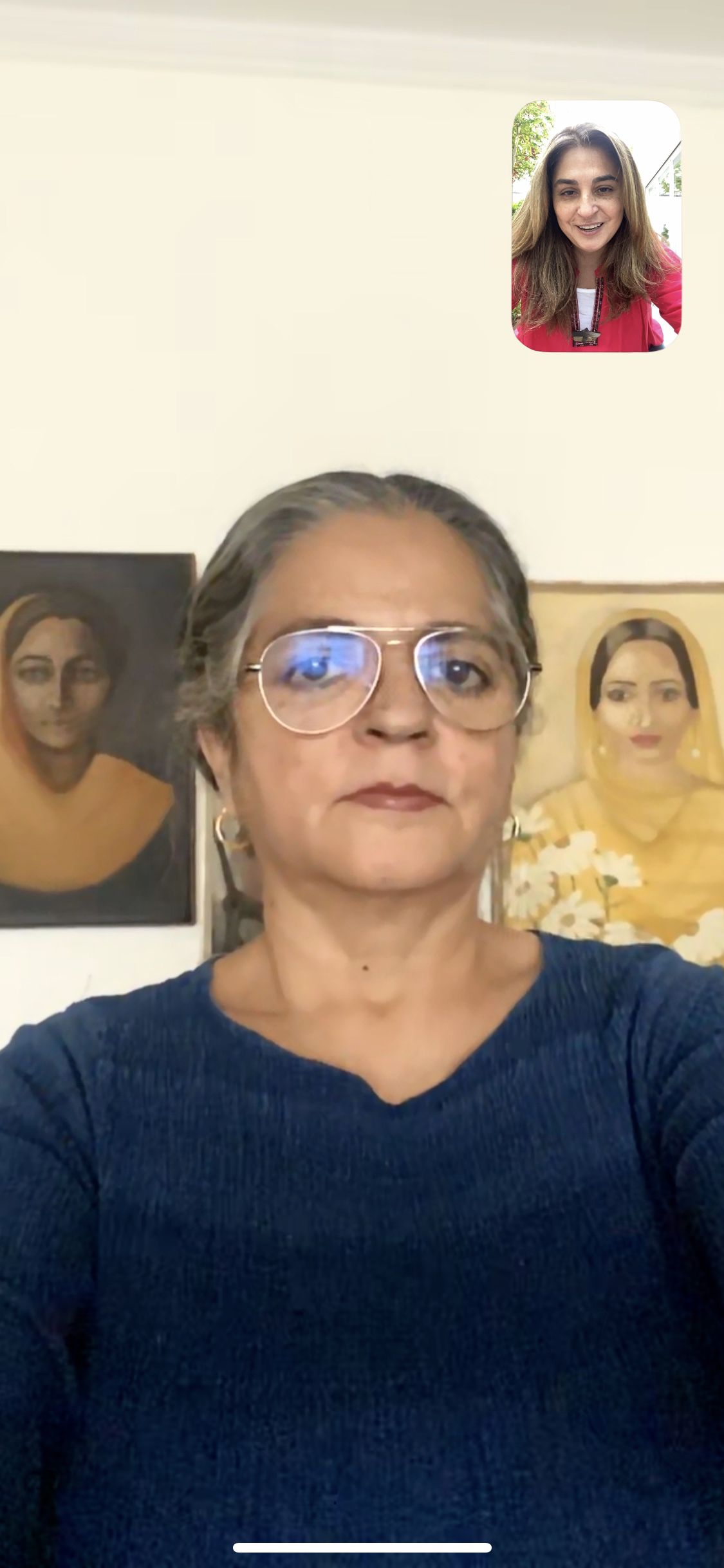

Meihui Liu
May 8, East End, London, Studio
Memories of the past.
Reality of the present.
What is tomorrow?
Do you think this is the worse moment you have ever experienced ?
If it is, then you must give it your best shot to make it better, together with others – from this day onward and into the future. A future, we need to embrace with no fear, no regret, and no looking back, with a healthy mind and healthy body to go with it. Mens Sana In Corpore Sano.
If you weren’t happy with your life before lockdown, then this is the moment for change. Conversely, if you miss what you had before, then appreciate life, in all its dimensions, past and present, to include all that is around you now: loved ones, a rose petal, a bird singing, a simple home-cooked meal, beautiful music that transports you, memories that you cherish.
We can all keep hoping, even while we wait in this limbo. Dreaming is important, to keep our hopes alive.
We should all remember that our dreams and projects are not all cancelled; they are just postponed.
We have all suffered deep hurt or broken hearts in our lives. But we only felt the sadness because we have also experienced great happiness. One cannot exist without the other. It’s only natural to feel down, especially when individual freedoms are removed. We will no doubt regain these freedoms, only this time with the opportunity of a fresh beginning. A future en-laced with love and positive energy with people who deserve to share it with you.
When the light will return, peeking through the darkness, there will be new challenges for us all; we should welcome them and better ourselves in the process.
Social distancing, lockdown, isolation, staying home… it all hit us like a hammer. Quickly. Unexpectedly. In an alarming way. We should have seen it coming. We were partly responsible. But we were lost in greed.
Personally, I have experienced lockdown for almost 2 months in my East London home. As a Taiwanese, I have lived in London for more then 20 years, and for the first time, I feel homesick. I miss my birthplace, my Taiwanese family.
For the first time, I also have many questions for our governments across the globe, but especially here. Losing control over our individual rights and lives and leaving our trust into their hands… It all gets too overwhelming sometimes. So perhaps best to focus on myself, my work, my family. I spend time in different rooms of the house, in the garden, and I have re-discovered my neighbourhood with a fresh eye and a new perspective, walking, cycling to the grocery store. Sometimes I deliver food and supplies to isolated friends and artists. In a way, I am returning to them a little of the joy they have given me, over the years.
I keep busy. It’s important to keep going.

Mohau Modisakeng
May 8, Johannesburg, South Africa, Studio
In a time of crises, there is always an opportunity to redefine, re-frame, and re-constitute established norms…an opportunity to begin anew. It is as if some things need to burn to ashes so that new life may sprout. At times, if not most of the time, life as we define it for ourselves gets in the way of new beginnings; it gets in the way of our healing. Often, we are preoccupied with trying to put out fires, never still…always in a panic.
Perhaps this is the time for stillness, a time to sit and watch as the fires rage and consume all the superficial things we thought dear to us, while we anticipate and contemplate what will rise from the ashes.
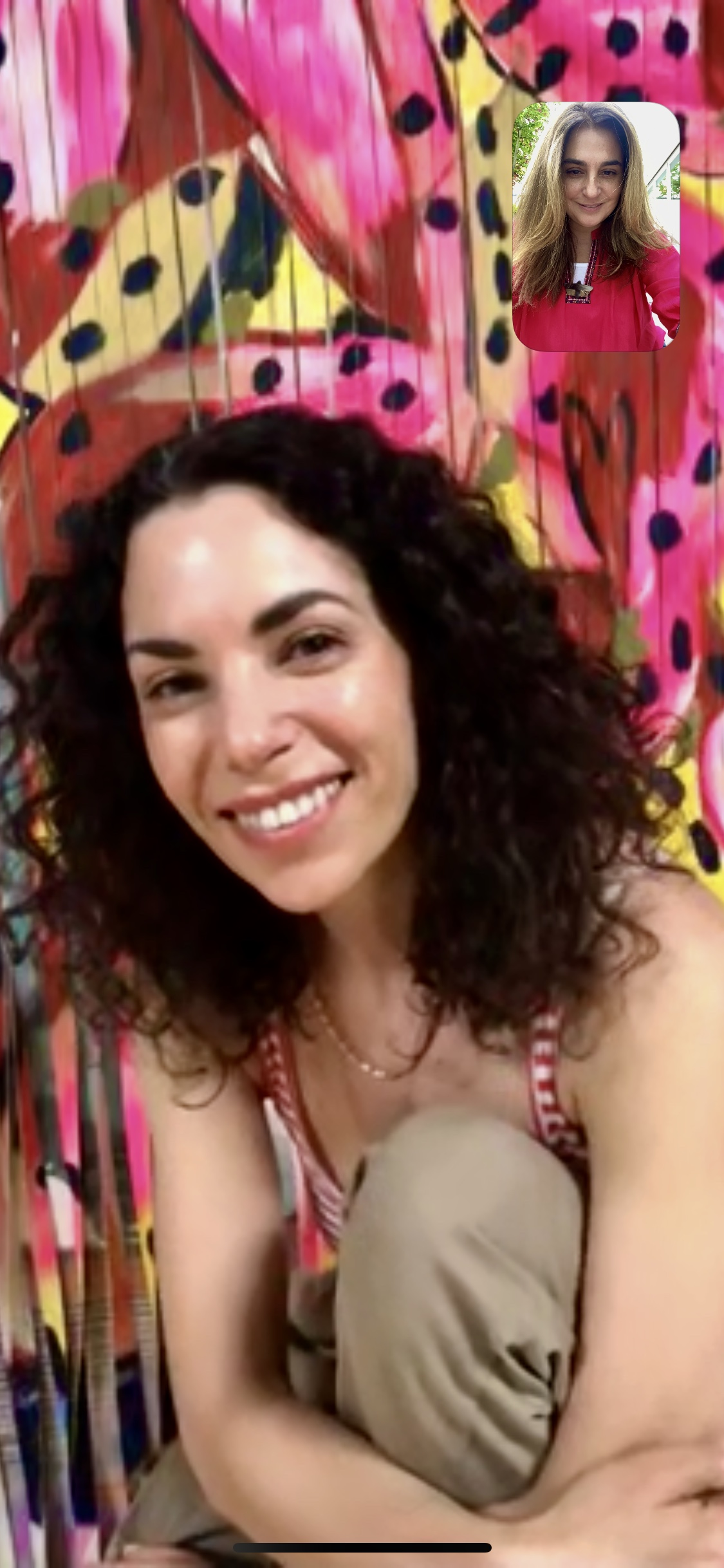
Ali Silverstein
May 7, Los Angeles, Studio
Uncertainty isn’t easy — but as artists we have had practice. Of course I have moments of real anxiety, or a heavy heart… and immense gratitude for the workers who are keeping it all going right now for all of us…
But it’s also an unparalleled opportunity. Could we ever experience this — a break! a break! a pause! on the whole thing! everywhere! all at once! — a chance to stop moving, to reflect, to reconsider, to reorganise, realign, to hear our inner voice and all the subtler things we normally miss — if it weren’t for something big enough and scary enough to insist that we stop?
I have found this time to be a great gift.
For years I’ve been craving quiet, but while the world has been noisily marching on, and the pressure of staying in contact, of being seen, showing up, answering calls, and taking care of business have been constant, it frankly has remained a yearning that I lived with. Retreat, so essential for a creative life, has always involved a sacrifice, a FOMO, having to say “no”… But while everyone else is isolating, too, a great anxiety is eased, and I can shamelessly relish in my solitude, in my own vibe.
So I am grateful, because for the first time in years, life is quiet enough for me to feel my deepest and most genuine creative urges — and for them to make sense!
I never want to have another appointment ever again!
I’ve been able to create a routine in this time — something else I’ve been longing for for many years.
In the morning, I work on a writing/relational project about intimacy:
Perfectly ironic for this time of isolation, it involves reaching out to the people I have written about in a diary I kept from the age of 17 – 30 (the diary was mostly focused on trying to understand love and relationships) — to ask them to contribute their accounts of our connection. The conversations involved in these requests occupy my morning hours, and are themselves a portrait of intimacy.
At midday, I dance, by myself. It’s a time that I offer to my body, to allow it to move exactly as it wants to, since, for the rest of the day, I order it around.
In the afternoon, I am in my studio, where I am now, working on these paintings that have something to do with decoration, religion, celebration, performance, ritual — the way we set certain moments apart, elevate them from mundane experience, make them sacred. Even the difficult ones. Even, maybe, like this one.

Adam Neate
May 6, Sao Paolo, Brazil, Studio
For me, this lockdown has made me reflect on the importance of everyday things we often take for granted. We are so fortunate to have technologies like social media to stay in touch with loved ones.
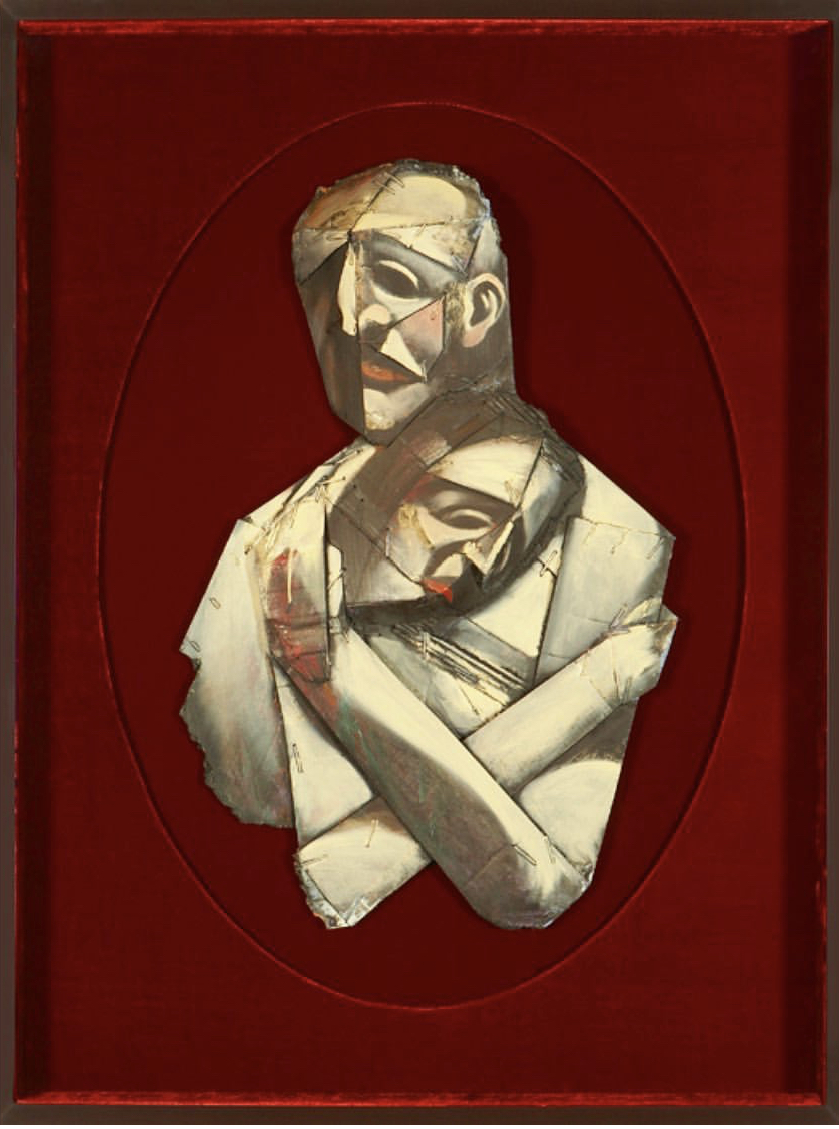
‘THE HUG’ 2008 mixed media on cardboard. 95 x 124cm
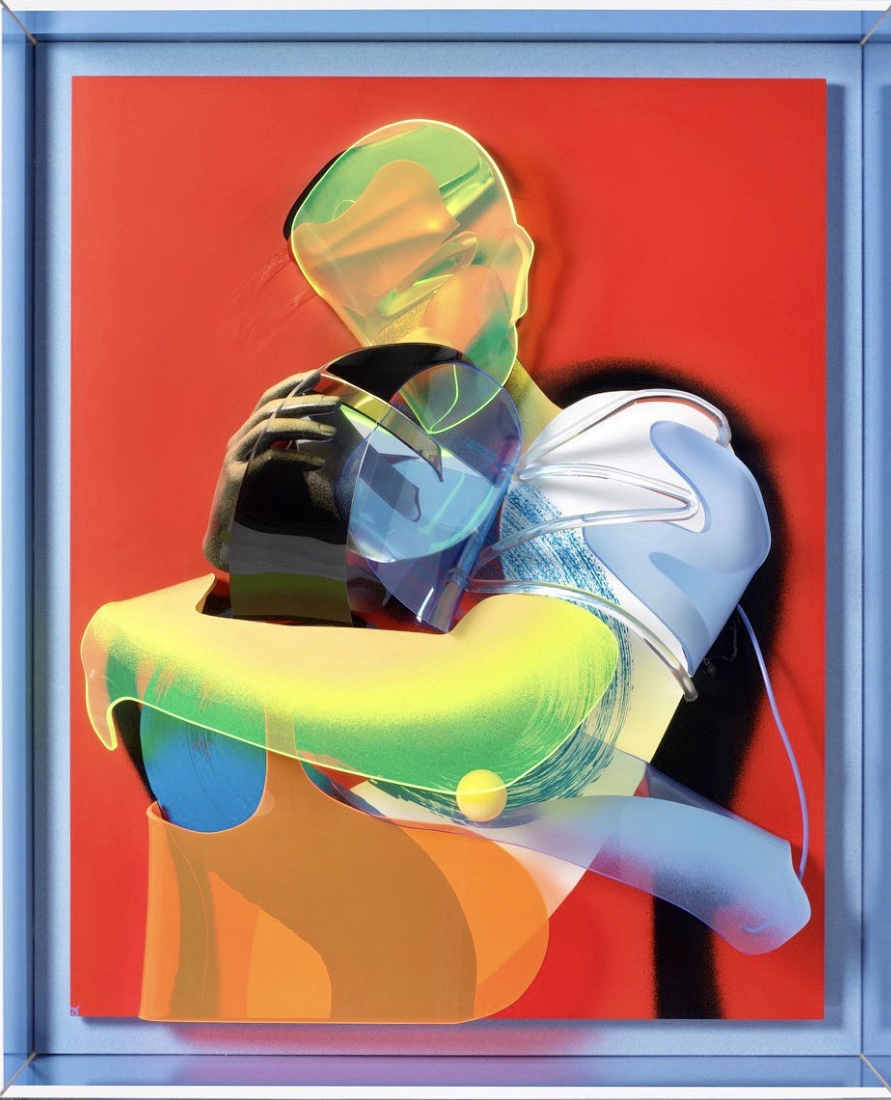
‘THE HUG’ 2011 acrylic, Perspex, metal and aerosol on board 72 x 88 x 23cm
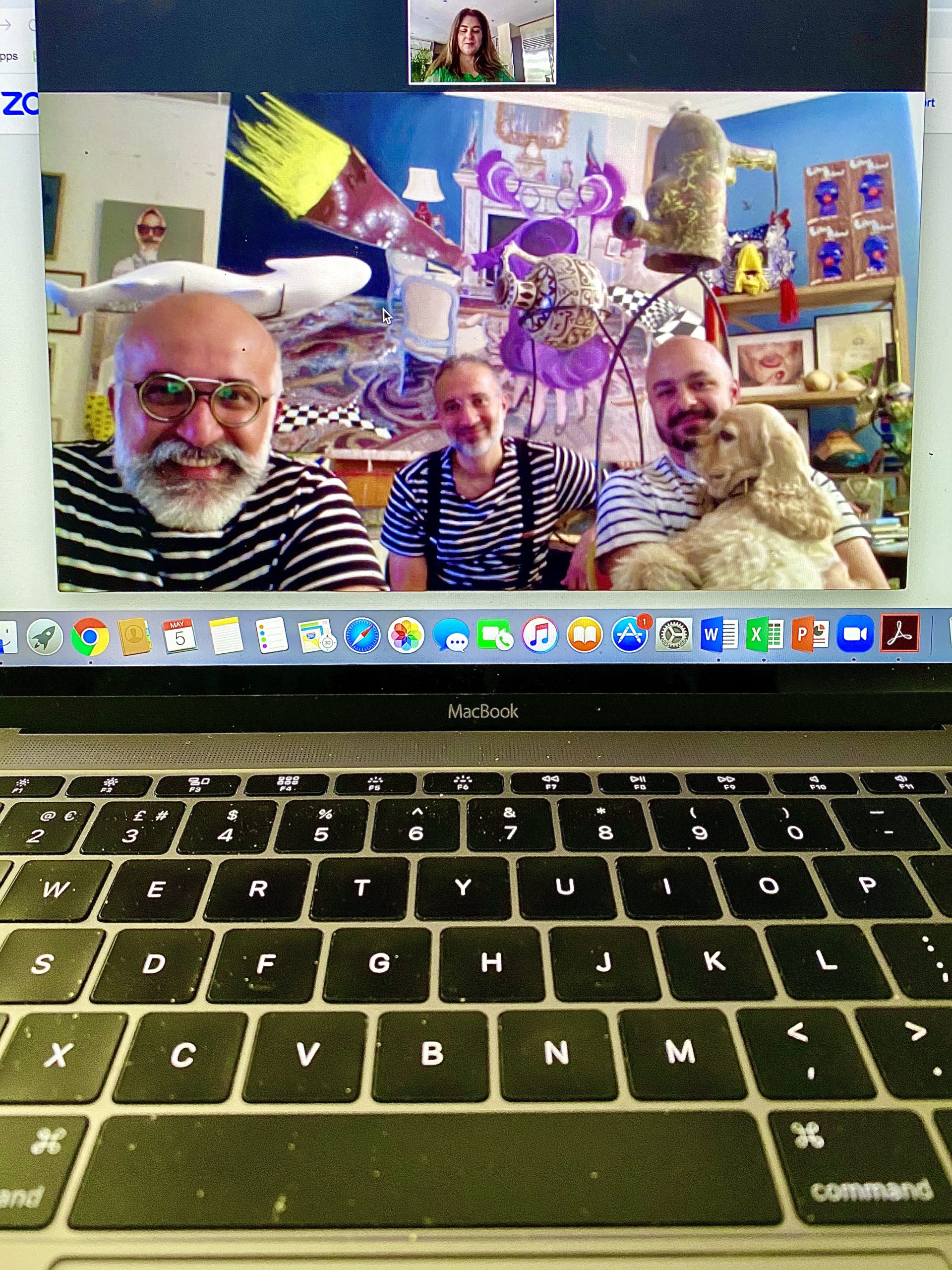
Ramin Haerizadeh, Rokni Haerizadeh, Hesam Rahmanian
(with their dog Mozafar)
May 6, Dubai, UAE, Home/Studio
We have been privileged to be working and living together in quarantine for many years and we continue to do so now. So, these past months haven’t made a big difference to our living/working routine, although it has indeed brought us some challenges, as it has for many across the world!
We have replicated a version of today’s cities in our home and decided to create an environment in which we have more power over the way we plan our lives. To many, it may seem like a life in confinement, but we actually really enjoy it. We wake up in the morning, at the same time as the birds in the garden, and match our activities to the movements of the sun. There are discussions every morning regarding a recent book we’ve read or a film we’ve watched, all of which always gets redirected towards our work. In every corner of the house and the garden, we have activity stations which we use on different days of the week. Cooking and table arrangements are equally important to us, and we use that space and culinary moment of the day to create installations with dishes and cutlery we love, including the food itself.
The video below is a record of a period of time, working and living in quarantine; it is made with our phones during our daily activities/routines. It also borrows verses from Palestinian poet, Mahmoud Darwish whilst referencing Iranian poet and film director Forough Farrokhzad’s documentary, The House Is Black. The video tries to demonstrate life’s transient moments, while the world is on pause – in solidarity, against the Covid-19 virus.
This artwork is an invitation to vigilance. Our aim is to show that time is different from duration – duration is finite, but time, on the other hand, is like a third path, a product of the imagination.

Erwin Wurm
May 5, Countryside, Austria, Home/Studio
Let’s be grateful for the wind who brings the smells of the spring.
Let’s be happy that quietness gets space now.
Let’s dream that our nature heals.
Let’s think of our beloved ones.
Let’s start being slow.

Peter McGough
May 4, Greenwich Village, Manhattan, New York, Home
“To see a world in a grain of sand and a heaven in a wildflower, hold infinity in the palm of your hand and eternity in an hour” -William Blake
I have almost died 5 times in my life. As a 12-year-old, I spent 6 months in a hospital for acute appendicitis that burst inside me. I was given last rights by the local parish priest twice. Decades later in the 80’s I was thrown out of a 1913 Model T ford car across a highway. I stood up without a scratch. And then sick with Aids in the 90’s. I was given 3 months to live. My memoirs (I’ve Seen the Future and I’m Not Going) that was published last year has all this in it and more.
My sister said to me after she read my book “I guess you’re here for a reason.” I grimaced at her statement. Then I was thinking “Why am I here?” Then this little thought came to me, “You are here to experience joy.” I wasn’t stunned, I enjoyed the statement. I thought, “Yes why be miserable? Why constantly complain?” Even when I was dying, I wanted to enjoy that day.
Who will care about all my petty concerns years later? Most likely no one. All that’s left of the ancient world is broken statues and crumbling architecture. And I’m sure people at the time complained or thought how important they are.
When I was sick and dying from Aids in a slanting 5 floor walk-up near Times Square (since I didn’t have the strength, I didn’t leave my flat for one year), I didn’t want to die or be in such physical pain. And I was used to being in confinement. I started to live just for the day I was in. Not the next day, nor the next week or month. I focused just on the day and what I wanted to do.
And now in this global pandemic I’m home since early March. My apartment is decorated to my liking, I have my dog for companionship. I have my books, television and a phone to see and speak with my friends. I’m making drawings at home while I listen to music.
As artist Sonia Delaunay said “…I want to express myself before disappearing.” I wake up some mornings thinking “Not this again.” But then I forget it and go on with my day. I had a friend who worked at a hospice and she related that the most constant deathbed regret was “I wish I had enjoyed my life more and had fun.” That’s how I feel. I don’t want to be a bitch my whole life and then die. I don’t want to fight with people, be nasty to others or complain how horrible everything is. I want to look for the silver lining and walk on the sunny side of the street. Leaving my cynicism aside. Who cares anyway about being miserable? I’m not interested in heading down that road.
Since I’m not vain enough to say there is nothing after this or there is another life after this (please no reincarnation – I have no interest in returning), I only know my life as it is.
I might as well enjoy it.
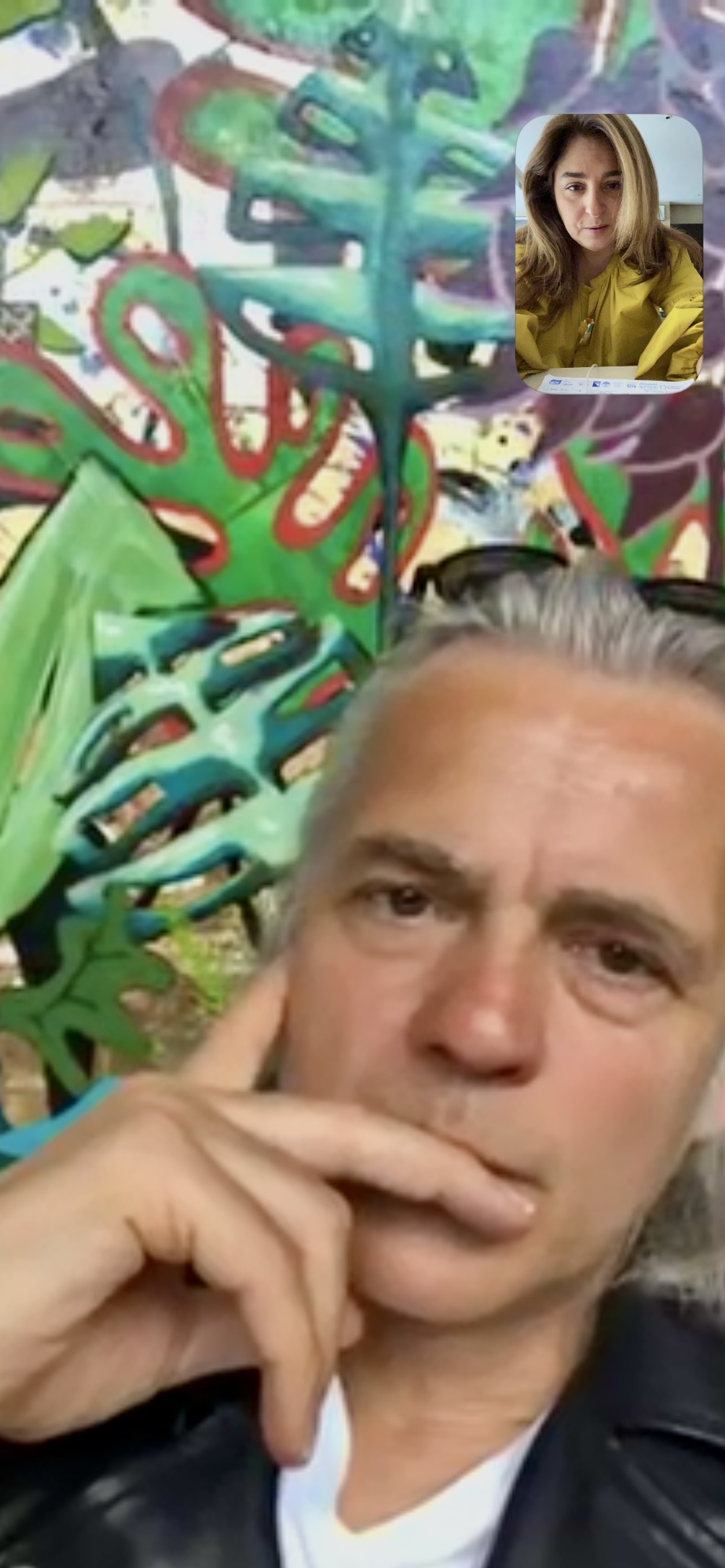
Tilo Kaiser
May 4, London, Studio
We probably all agree, in some state of paralysis, that these are strange times. Everybody knew this would be coming; books had been written about pandemics, movies have been made about exactly this scenario, scientific studies were commissioned and state exercises staged, and yet it is deeply surprising, unacceptable and massively worrisome that our systems, governments and societies were shamefully unprepared when Covid 19 appeared. Now, we can only hope that we collectively behave a little more intelligently, coming out of this crisis, than we have when going in. Maybe and hopefully, we can employ some of the hard learned lessons to change our future behaviour and become better, fairer, more considerate and more empathetic societies.
In all this craze, art could and should become more relevant again and not just a tool to make tons of money. Some of the best art was created in times of war, distress and crisis. As people crave new ways and approaches to almost every aspect of their lives, artists can lead the way, inspiring others to think outside of the box, to be socially and politically critical, to heal, to recover and to protect our spiritual and mental health as well as our personal freedoms.
I truly hope that as many artists as humanly imaginable will emerge from this crisis unharmed, stronger, and financially able to continue their calling. The world needs art, music, theatre, literature, dance etc more than it admits and knows. It will be fucked without.
Fuck off Covid 19!
p.s.: And a massive loud and roaring THANK YOU to all the people who put their lives on the line during this pandemic working on the front line. We should all pay them a deserved vacation when this is over.

Francesco Clemente
May 3, Greenwich Village, Manhattan, New York, Home
Everything I knew on May first 2020
Our notion of self is delusional. Our identity is a fantasy. In our true nature we abide in eternal light and the world is perfect. Buddha Mind, Atman, God, the names are many, the experience of our true nature is one. At times we may get a glimpse of it through beauty and art. Truly we are only the Witness, pure, blissful, undefiled, of the fantasies of the self. These fantasies are neither good nor bad: they include joy, pain, fear, hope, they even include our own death. Whether we are aware of it or not, our true nature remains untouched, so all we need to do is to observe tenderly our skillfully woven delusions and enjoy the ride!
In this mystical view, refined through the ages by countless sages, even the pandemic is just another facet of the sufferings we encounter when we forget our fundamentally compassionate, ecstatic nature.
On the other end, if a big truck is going to run you over, will you sit and meditate or will you run for your life?
The pandemic is the dress rehearsal of the future. The pandemic is visible, the future is invisible but it is here, cleverly made invisible in plain view: twenty years of illegal wars for oil, the reckless destruction of biological and cultural diversity, the transformation of the American republican party into a suicide cult, the triumph of an economic order whose goal is to make lots of indifferent stuff and indifferently throw it away, man-made poverty, man-made tyranny, man-made refugees, at the root of it all man-made economy.
The economy is not a dogma dictated by God, the economy is an invention of men.
There are partisans of this economic order. To them, economy comes first and human life is just an afterthought, a hindrance to the aimless accumulation of wealth.
If the market could get rid of the human race it would. The partisans of our absurd economic order, which we all know is killing the earth, like to tell us: ‘this is life.’ Maybe what they mean is ‘death is life’. Or maybe what they mean is: ‘your death is my life’. Fighting to save ourselves would be inelegant. Fighting against the partisans of death would turn us into them. We have to change with them and not against them and this will require great imagination, more imagination than the most accomplished artist can ever offer.
It is an old story, playing one time too many: the lambs coming to the rescue of the wolves.
It is happening now, a few blocks from where I write: first responders, nurses, doctors, firemen, workers holding the city together, embracing the silent but eloquent simplicity of love and service. Light attracts darkness, but darkness breeds the light.
Francesco Clemente,
West Village, New York
5-1-2020

Ketaki Sheth
May 3, Mumbai, India, Home
The lockdown is, for me, a novel experience as I imagine it is for every individual in the world.
Although I am separated from my family at this moment in history, I am blessed to be dividing my time between two homes in Mumbai. My 85-year-old mother’s beautiful garden flat that I grew up in, stamped with her good taste and my own flat nearby filled with books, photographs and paintings. As I navigate the space alone at home, I feel the absence of my daughter and husband. There is a loss of personal connection, but the vacuum is filled with the presence of our beloved beagle Shoji and our loyal live-in carer, Fatima. These times will pass is what I read in their eyes.
They say a pandemic shatters the past before it thrusts you into an uncertain future. This lockdown has turned me more inward than ever. I find myself reaching back to a past more than 60 years ago, to letters— beautifully handwritten in ink on onion paper (the ink still blue)—by my father to my grandfather asking for his daughter’s hand in (arranged) marriage; to his diaries where I find many a mention of me; to photographs from a time I never knew. I find a letter from an 80 year-old-family friend who willed himself to die after playing his favourite symphony on the piano. I find our wedding invitation designed so beautifully by my husband, a typographer, 26 years ago to the day. I find my daughter’s birth horoscope written in a language I cannot read. I must get an interpretation.
So while the skies are bluer and we can hear birdsong, I find myself wandering into the archives of my past wondering if the present is not history enough.

Maria Qamar
May 3, New York City, Studio
ME, MERASELF AND I.
Loneliness is a concept I am familiar with. I have spent over half a decade working in solitude and understand that now more than ever, it is my duty to continue doing so. But you can tell a lot about where I’ve been mentally during the last two months of self-isolation by my recent Google searches. Will eyes burn from too much computer use? How long can a human go without taking a shower? Difference between online viewing room and website? How long can a human go without talking? Can you catch the virus from takeout? How to make espresso martini? How to block someone on Zoom? VR galleries 2020? Online nightclub 2020? Street art allowed or illegal? What is the penalty for playing music from balcony to boost morale? Homemade masks how to? How to calm anxiety? What is CBD? How to order weed online? Is Kim Jong-Un dead? How to temporarily disable every social media account? How many years were in March? Essential definition? Is art an essential service? Is paint an essential object? Are artists essential? Are galleries essential?
Am I essential?

Richard Hudson
May 3, Cotswolds, UK, Studio
I have the privilege of staying in a country house. For the first time in over thirty years, I picked up a garden fork and planted a vegetable garden. A farmer’s son; memories of milking cows, chickens, ploughing fields, hay making and harvesting on warm summer evenings filled my veins like a bolt. I yearn for this again, registering the beauty of earth’s fragile bounty, but yet now, sadly, I also realise how we have abused it. This wake up call is nature’s way of speaking to us, asking us to stop, to take note, for if we don’t, we will have, ultimately, self-destructed our own species. I believe in human tenacity, and it is not too late to take account of our lives, the important things, rather than charging manically around the world obsessed with “I want…I want…”: greed. I see this in my art world, fairs everyday of the year, people paying tens of thousands of dollars for a “Banana skin”. I know that was the artist’s point, but was anyone really listening?
Let’s get off the oil barrel, out of those planes, clean the oceans, produce and consume locally, love thy neighbour, respect the old. Only then, shall we have “hope” again and a future for our children.

Nandipha Mntambo
May 2, Johannesburg, South Africa, Home/Studio
Getting back to basics,
Rekindling my fire.
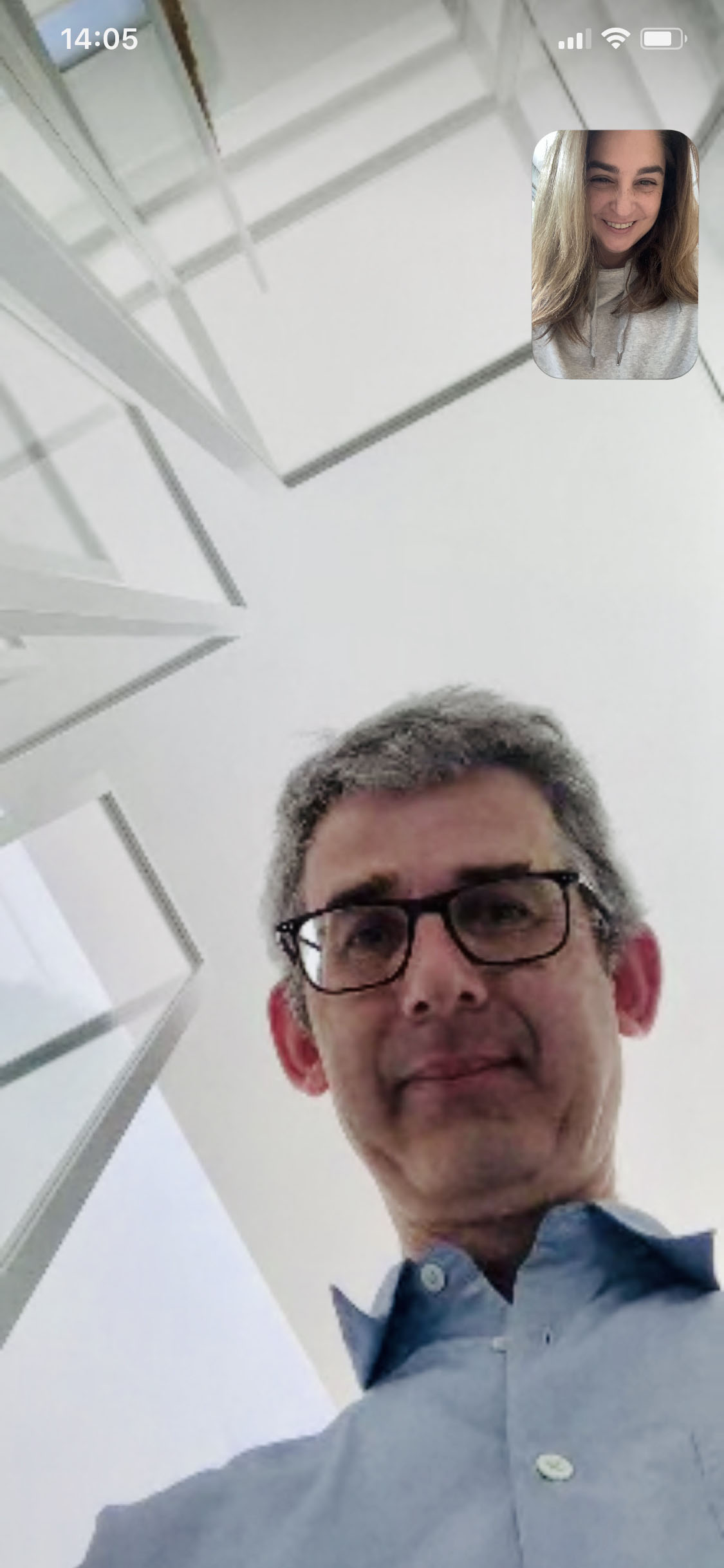
Edmund de Waal
May 1, London, Studio
Just over five hundred years ago, Dürer woke from a dream:
‘In 1525, during the night between Wednesday and Thursday after Whitsuntide, I had this vision in my sleep, and saw how many great waters fell from heaven. When I awoke my whole body trembled and I could not recover for a long time. When I arose in the morning, I painted the above as I had seen it. May the Lord turn all things to the best.’
The volume of water makes the earth shake. The wind and the sound and the slowness of the deluge, the inevitability of this apocalypse is terrifying.
You wake up and don’t know where you are. A plain with low hills and fields. Somewhere from childhood. And the heavens have opened and the waters are coming down, the waters are coming towards you. It is the apocalypse: the world turned upside down. You can hardly breathe.
During the night you are exposed. You are alone.
We follow Dürer, his line of thinking, this moment of exposure. It is his aloneness that talks to us. He cannot control what is happening, only record what he remembers, what he sees, what he feels. This exactitude is not protection. It is a way of approaching what is happening when the world is unstable. During the night we are alone and vulnerable, the certainties disappear. Dürer paints and writes to see what will happen, to feel the edges of his control.
We return to these fears.
We need solace. We need certainties but we also need to know that others have been in dark places before us. And that is why Durer matters. And the poems of Celan, Mandelstam, Emily Dickinson: poets who know solitude.
I am alone in my studio. But it is a freighted solitude.
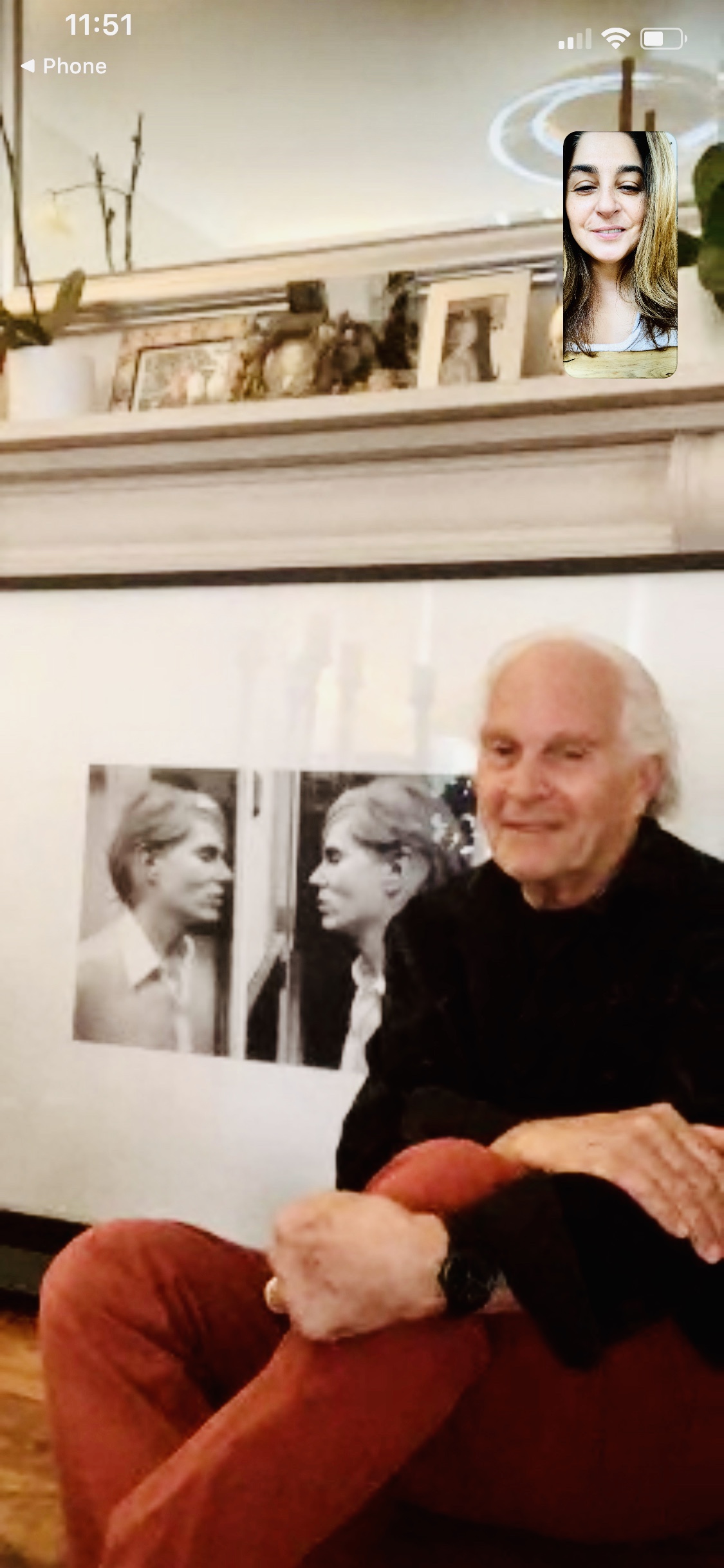
David Montgomery
April 28, London, Home
When I hear or think of the word ‘Lockdown’, being a photographer completely immersed in the photo visual world, I realise that most of my life has been spent in a self-imposed isolation. Alone, with my psyche, which I have learnt to enjoy. Obeying the wishes of my subconscious. Hopefully, during these challenging times, people will connect with a part of themselves on a deeper and more personal level. Keep looking! A picture is worth a thousand words.
‘Lockdown London’, David Montgomery, 28 April 2020
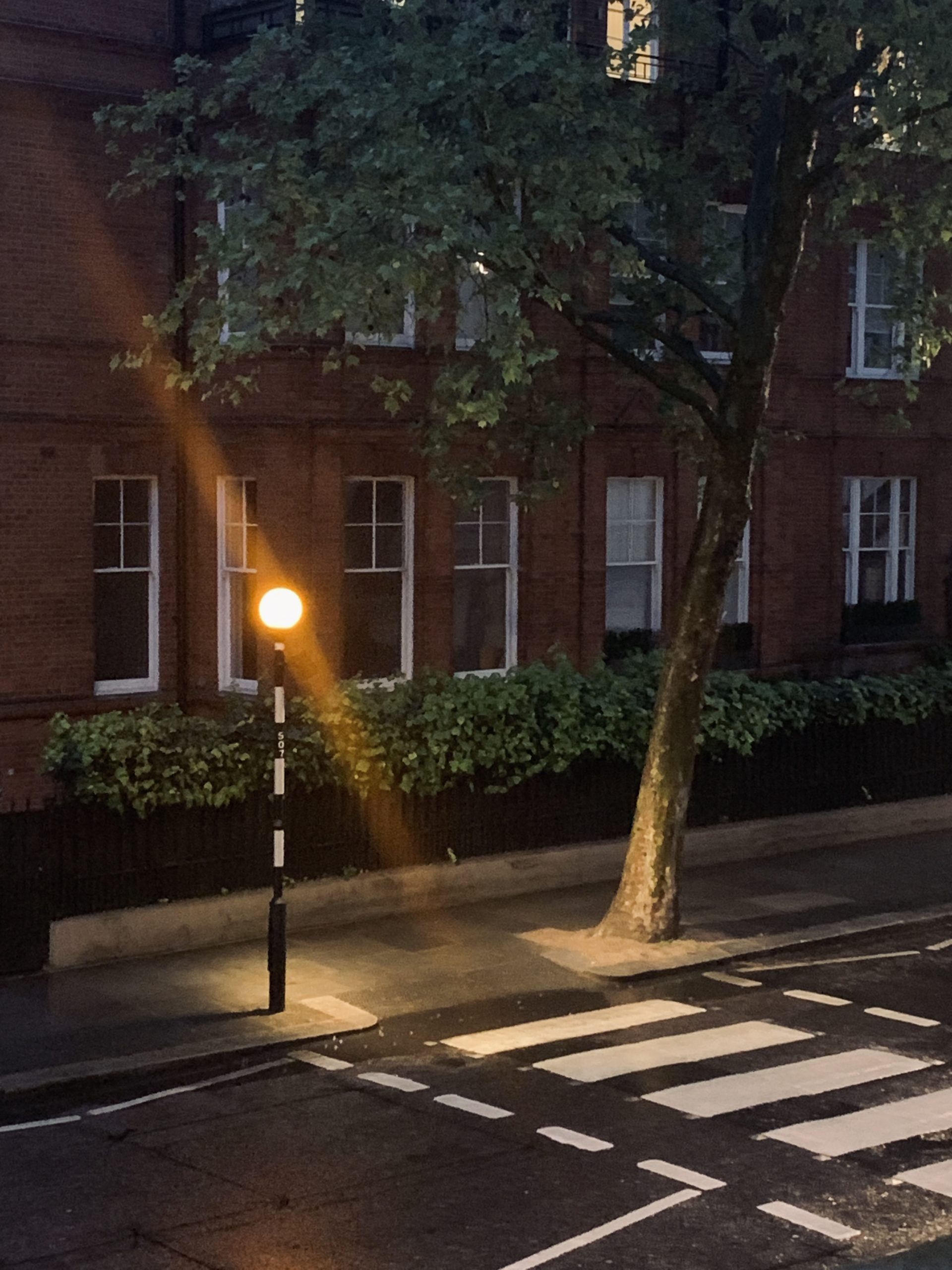
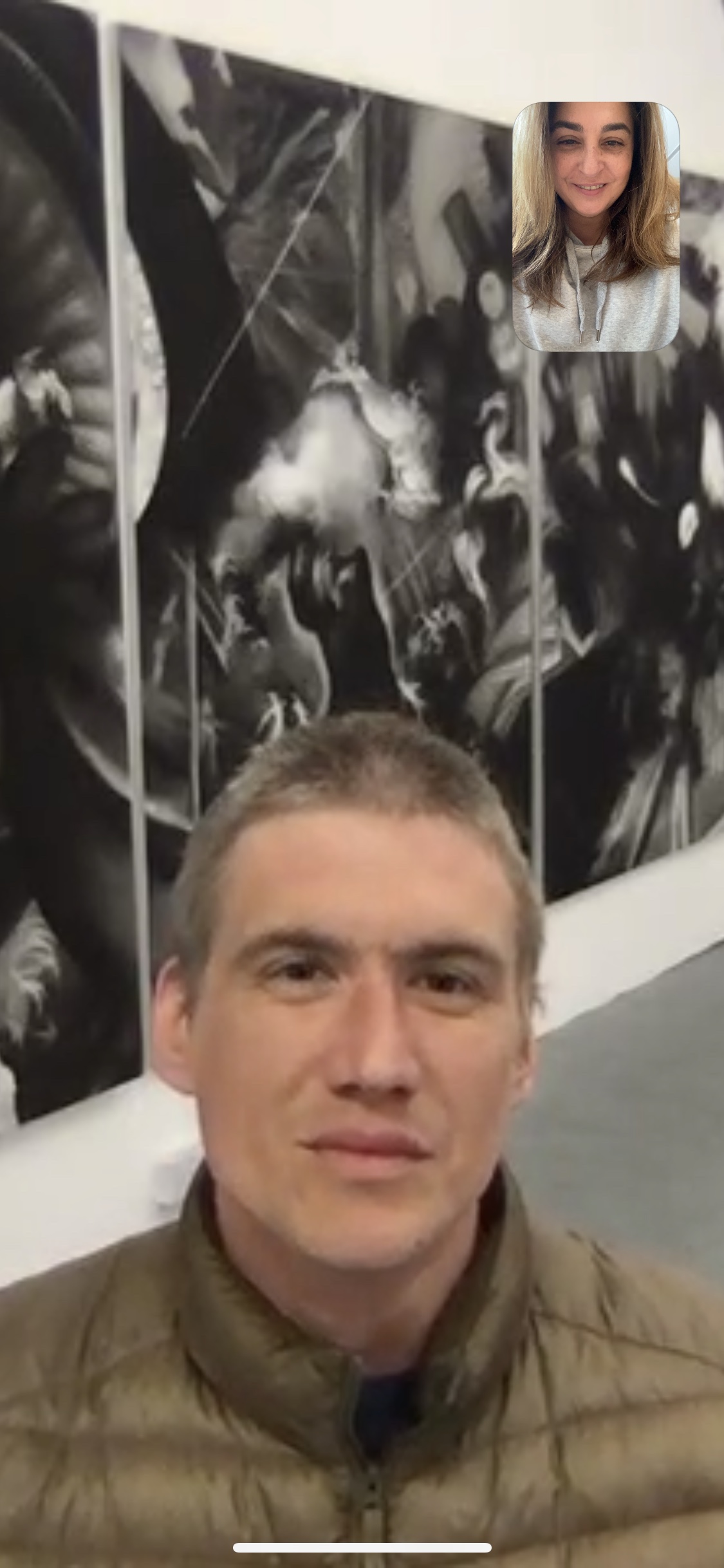
Hugo Wilson
April 28, London, Home
On many levels, my work has always been about the structures we hang our lives on, their underlying fragility and the need to cling on to any ideology that sits in front of you; never has that been more relevant, certainly in my living memory. I once was not allowed to call a show ( probably rightly so ) ‘Whatever Gets You Through The Night’ and here we are. I am, nonetheless, and in some ways, positive about this, because when you have to sit in your own skin for a while, it begins to fit you better.
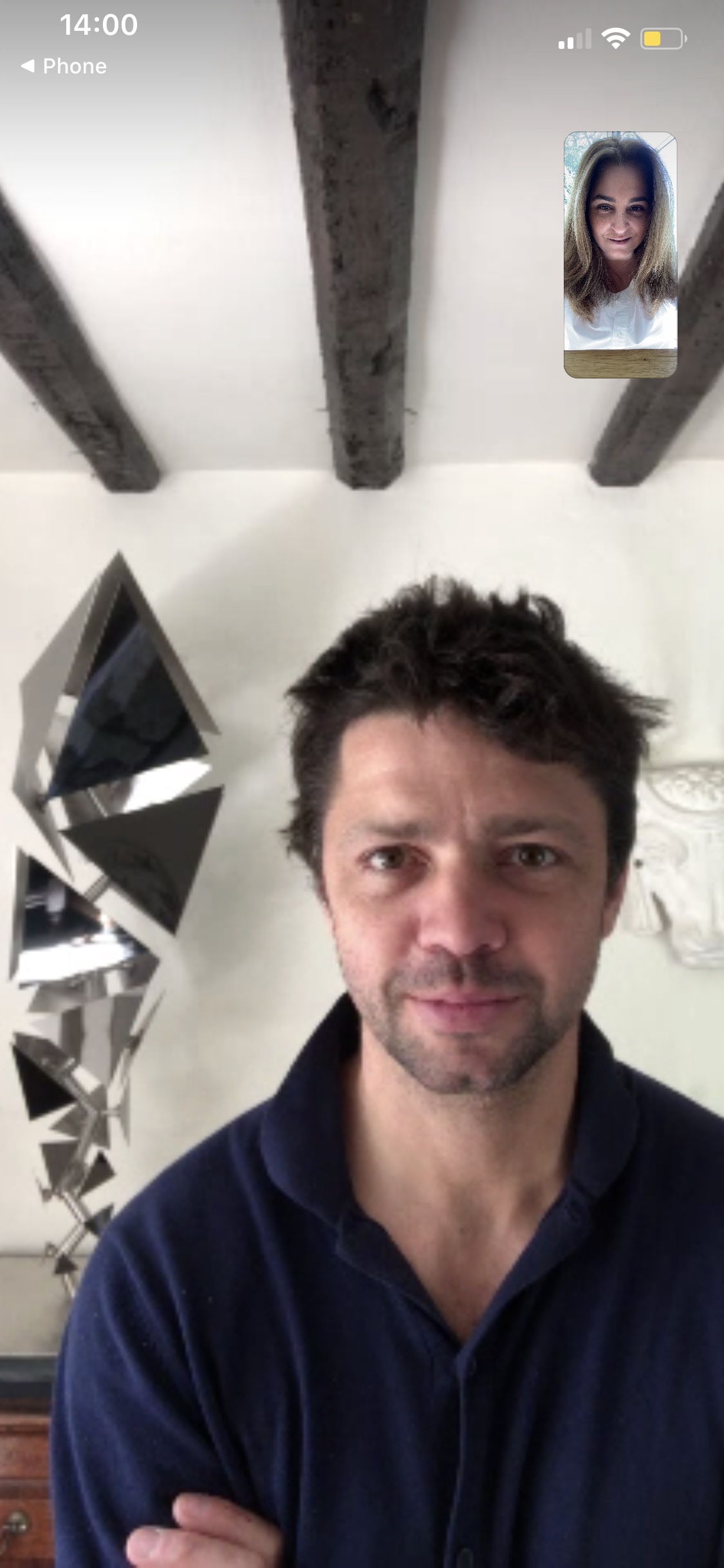
Conrad Shawcross
April 28, Sussex, UK, Home
In this moment, my thoughts have been revolving around notions of absence, death, departure, entropy.
A hole cannot exist without a host;
a hole is contained within something else.
Holes exist as cracks, tunnels, valleys, indents.
They are everywhere -they are visible, invisible.
They are incomprehensibly large and unfathomably small.
The ubiquitous thing that is not has captured the imagination of artists for centuries – from Hieronymus Bosch to Hepworth to Whiteread and Kapoor.
Holes are the departed people we loved. Their spaces filled only by our memory.
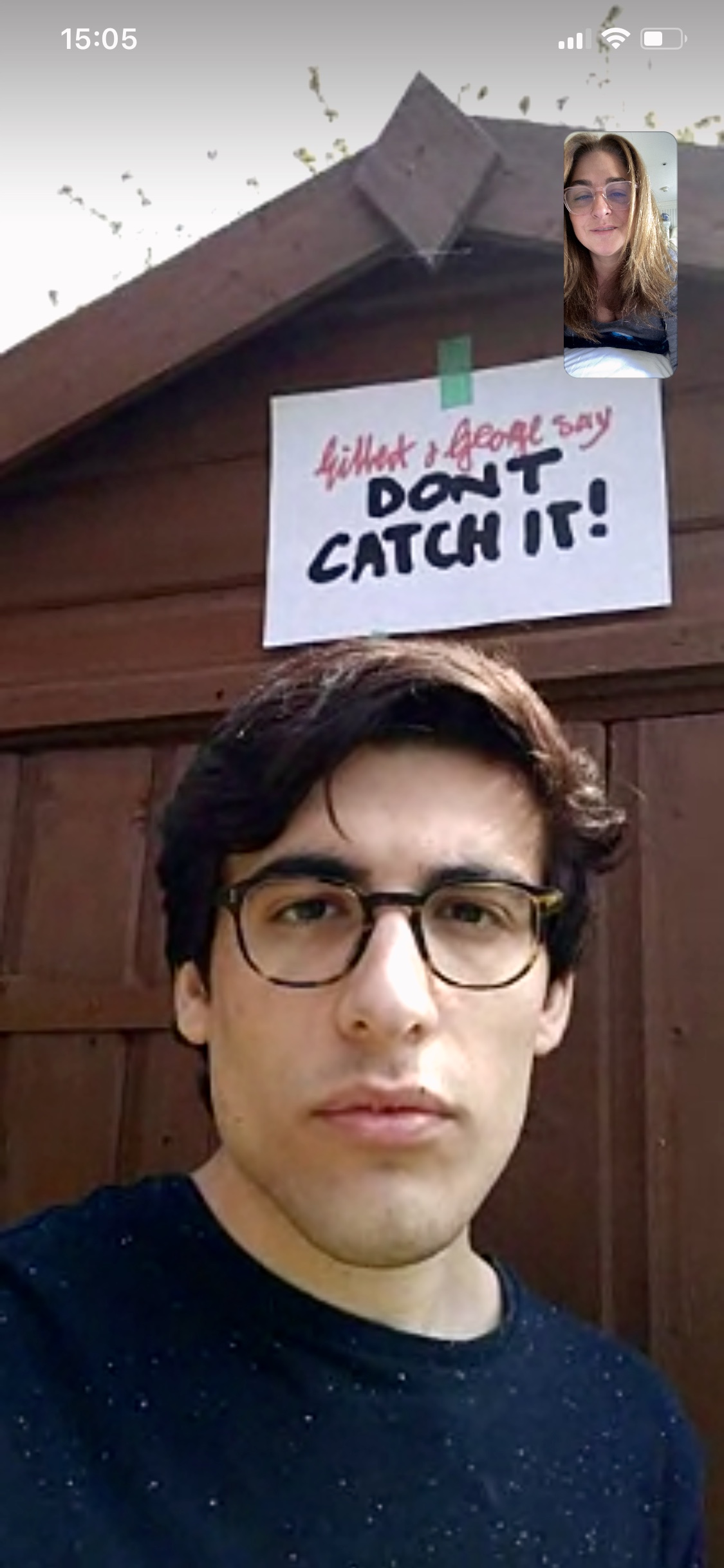
Sam Harris
April 26, London, Home
The world might have come to a standstill but that doesn’t mean life has to stop – and it definitely doesn’t mean art should stop! Artists will continue to make and produce – maybe even more than before.
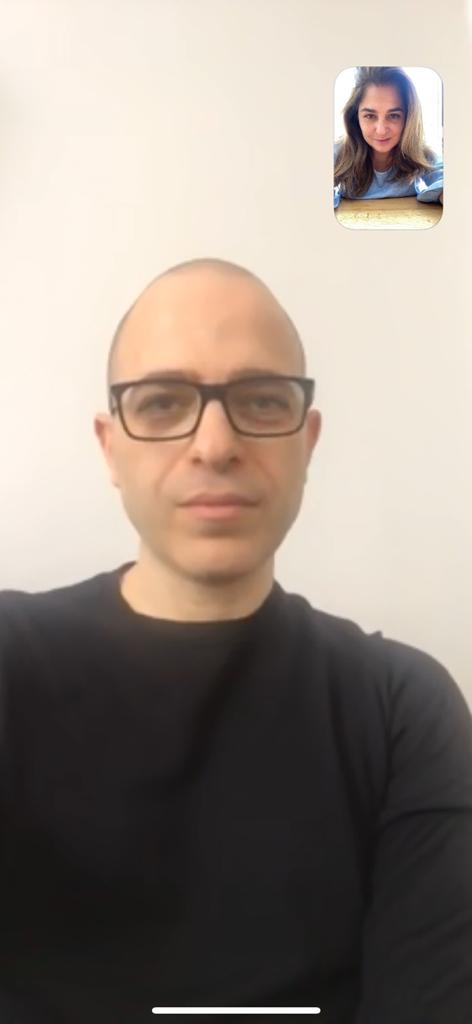
Youssef Nabil
April 24, Paris, Home
This time is about pushing the reset button, about sitting with yourself and about isolating yourself from what you understood life to be. A time to think, to meditate, to observe, to wait… It is a blessing, in many ways, that we were offered this pause in our lifetime; maybe it was needed so that we could fix what was broken for the generations ahead. A time to change some of our habits and to get closer to one another. I hope we will be more aware that the most urgent matter for us on this planet is the preservation of nature as well as our environment.
I also hope governments will start giving more priority to science and healthcare. What we are living now is a reminder of how fragile we all are, of how we should share the same goals and of how we should start to see life.
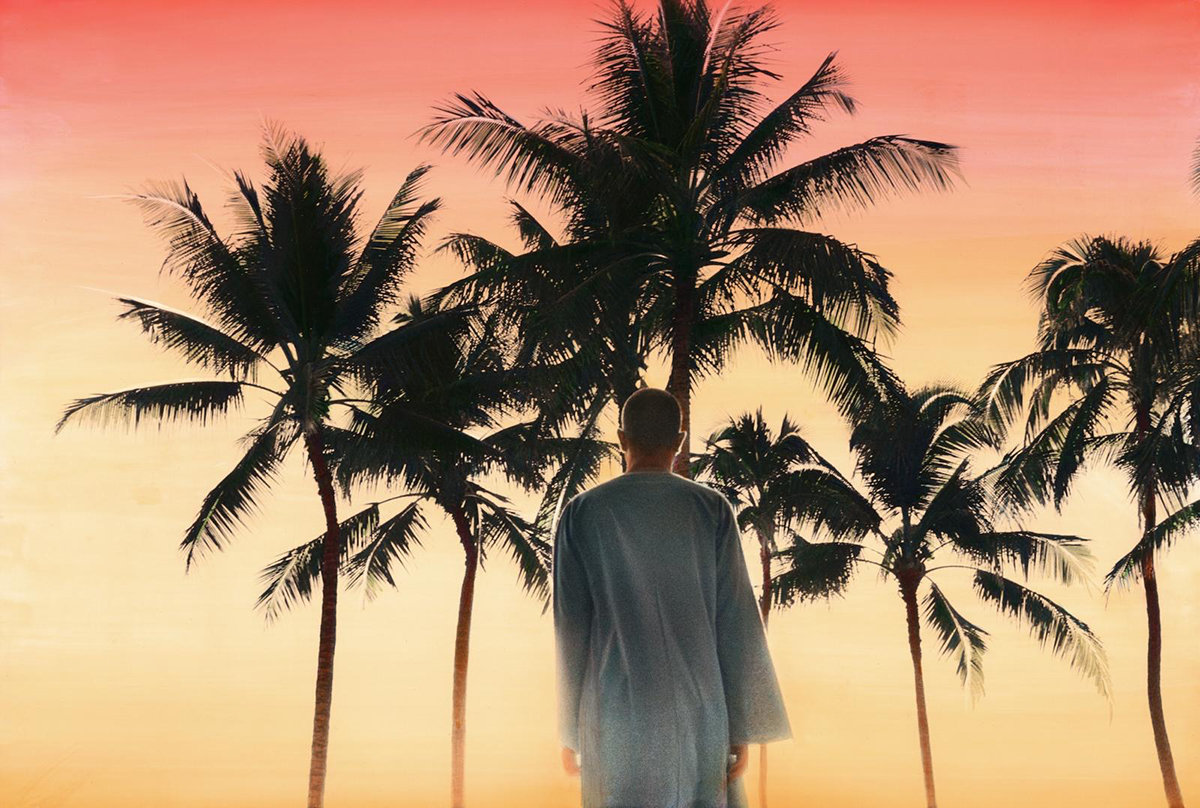
Self Portrait, Hawaii 2013
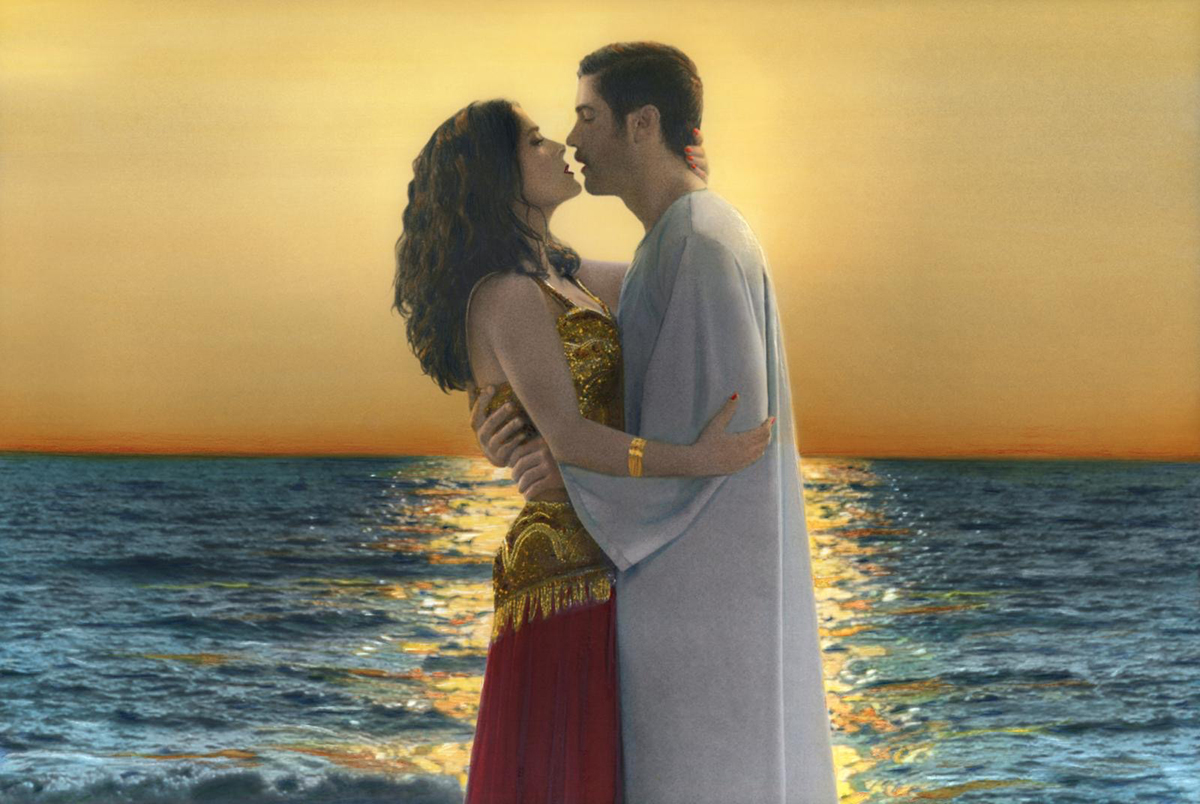
I Saved My Belly Dancer #XX, 2015
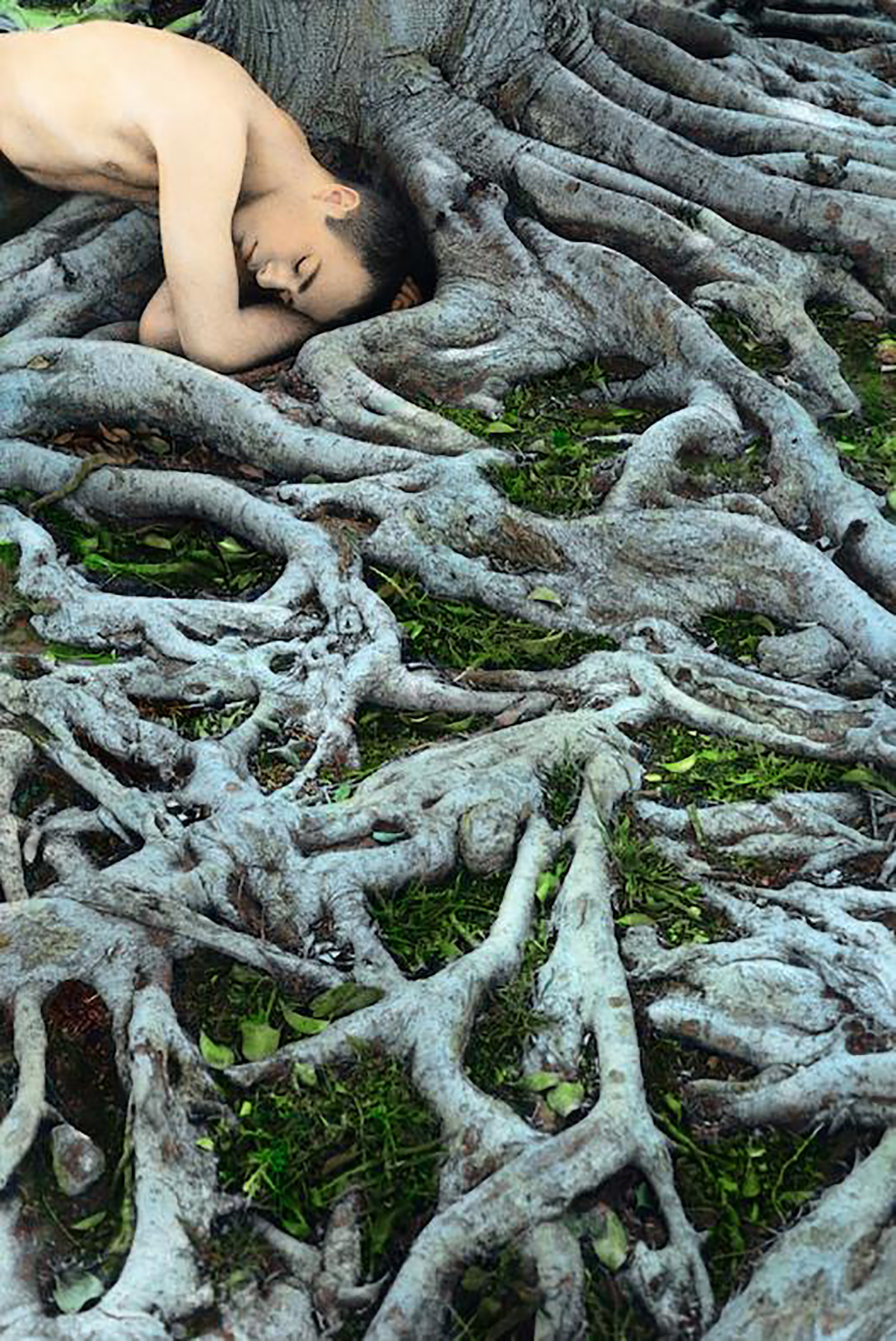
Self Portrait with Roots, Los Angeles 2008
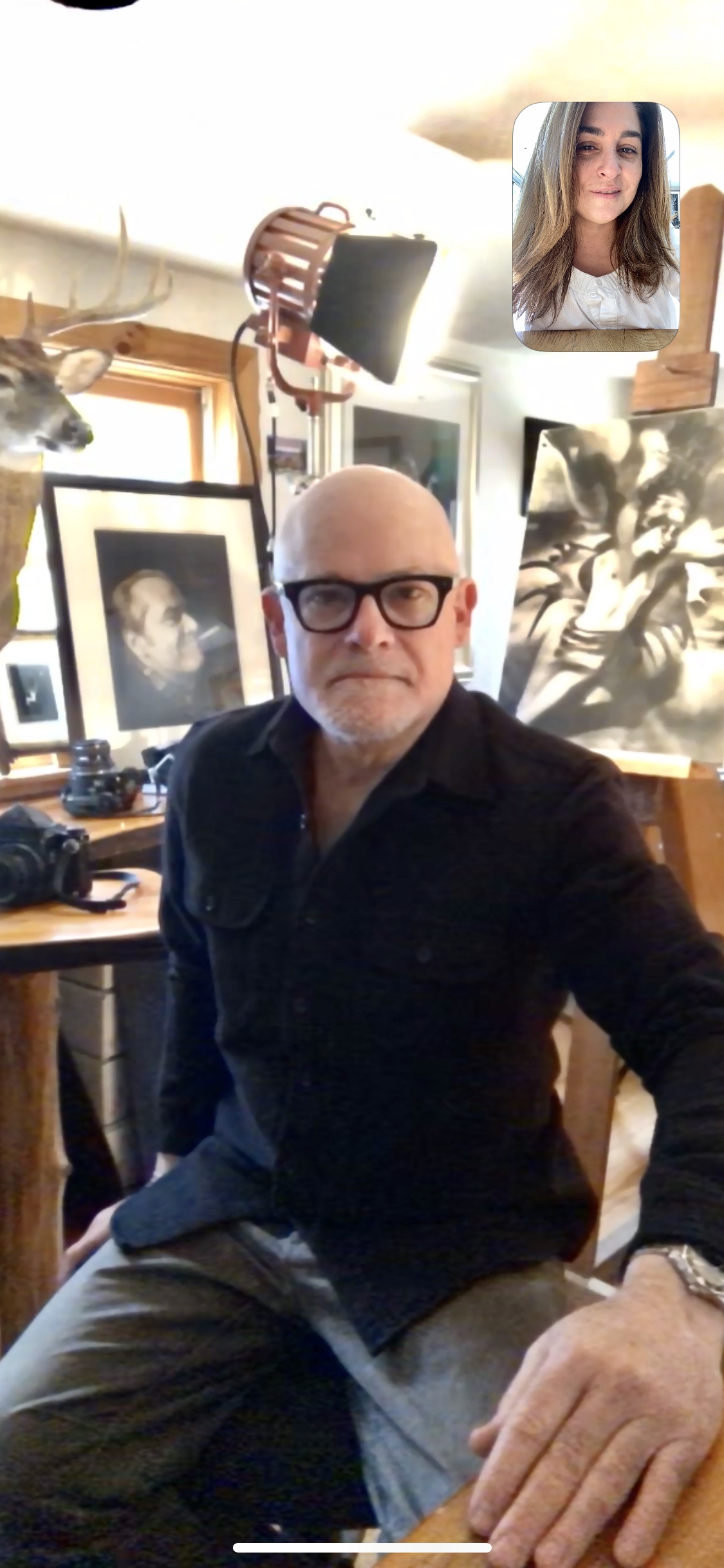
George Holz
April 23, Panther Mountain, New York, Home
ART AND SUSTAINABILITY IN THE TIME OF COVID-19
I’m never one to be bored. There are still not enough hours in the day.
For me, this period isn’t so different from my normal routine, except for the lack of socialisation and travel. It’s hard to believe that this time last year, I was doing the finishing touches for my exhibition at the Helmut Newton Foundation in Berlin. What a difference a year makes.
I’m lucky to be nestled away on 25 acres with my family, surrounded by thousands more acres of wild land, in the heart of the Catskill Mountains. We can’t see our neighbours from here.
COVID-19 has perked my survival instincts, so I’ve spent a majority of my time working and living off the land. We tapped maple trees, collected sap, and made syrup. I’ve been bottling my hard apple cider from last fall. I try to go trout fishing every day, and look forward to wild-turkey hunting season. We’re foraging wild watercress from the stream, starting seeds, and getting the garden ready. Being self-sufficient means less trips to the market, safety, and peace of mind.
This is a dark time. I think about my 99-year-old mother, my family, and the future of the collective planet, this big six-degrees-of-separation of illness and death. The death of my friend Peter Beard came as yet another gut punch and wake up call.
I do think about my work a lot. I’ve had more time to re-edit past sessions and look for hidden gems. I’m not one to be locked in my studio or glued to my computer all day. I’m not interested in doing virtual photographs. I look forward to shooting analog “in the flesh” again so to speak—it will make me appreciate the tangible aspects of what I do, and never take being up-close and personal for granted. For now, I walk the land, analysing how light and seasons change from day to day with all their idiosyncrasies. Winter to spring is an amazing transition in slow motion. I search out new locations, daydream new ideas, and yearn for the time when carefree human interaction is possible again.

‘A River Runs Through It, The Esopus Creek, Phoenicia’ – Without being able to get out on the river and fly-fish during the lockdown, I would have gone insane. It was my salvation.

‘Home Waters, Woodland Valley’ – Waking up to this view from the front yard every morning kept me going. It’s like living in an ever changing Hudson River School Painting
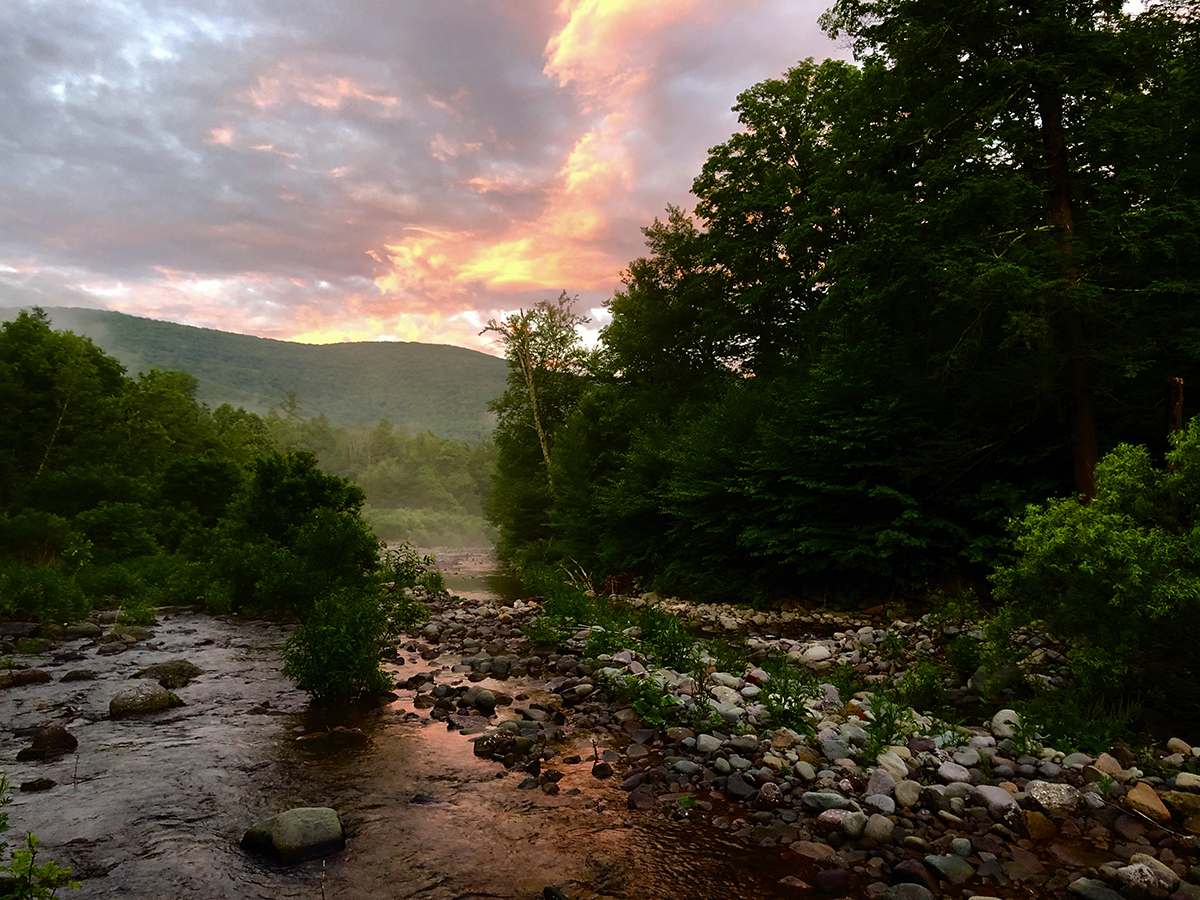
‘Our Dock, Lake George’ – We nicknamed our pond Lake George. We sit out here all year round. The light is constantly changing, always fantastic. The dock is like a muse, a favourite location for photographers and artists.
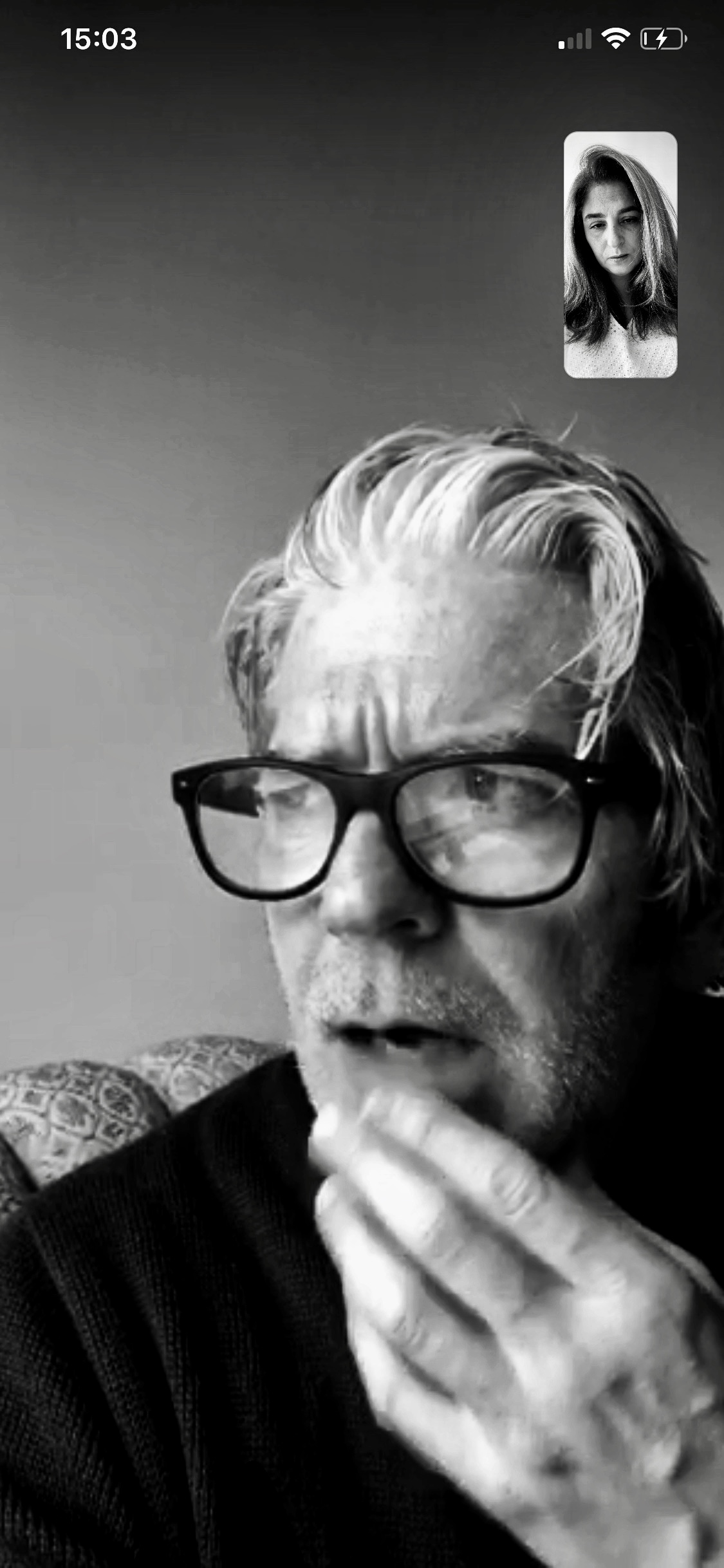
Henry Lohmeyer
April 23, Saint Louis, Missouri, Home
Hi Maryam,
It seems sad, but it’s what I’m feeling.
I hurt most days. Do you? I listen to songs—a lot of James Taylor and Jackson Browne. You know how lines haunt? Mine has always been from the song These Days. ‘Don’t confront me with my failures, I’ve not forgotten them.’
I want to be held each day. I want to hold. Do you? Let’s hold, just hold. Just today. Because I don’t know what day it is—it’s just today.
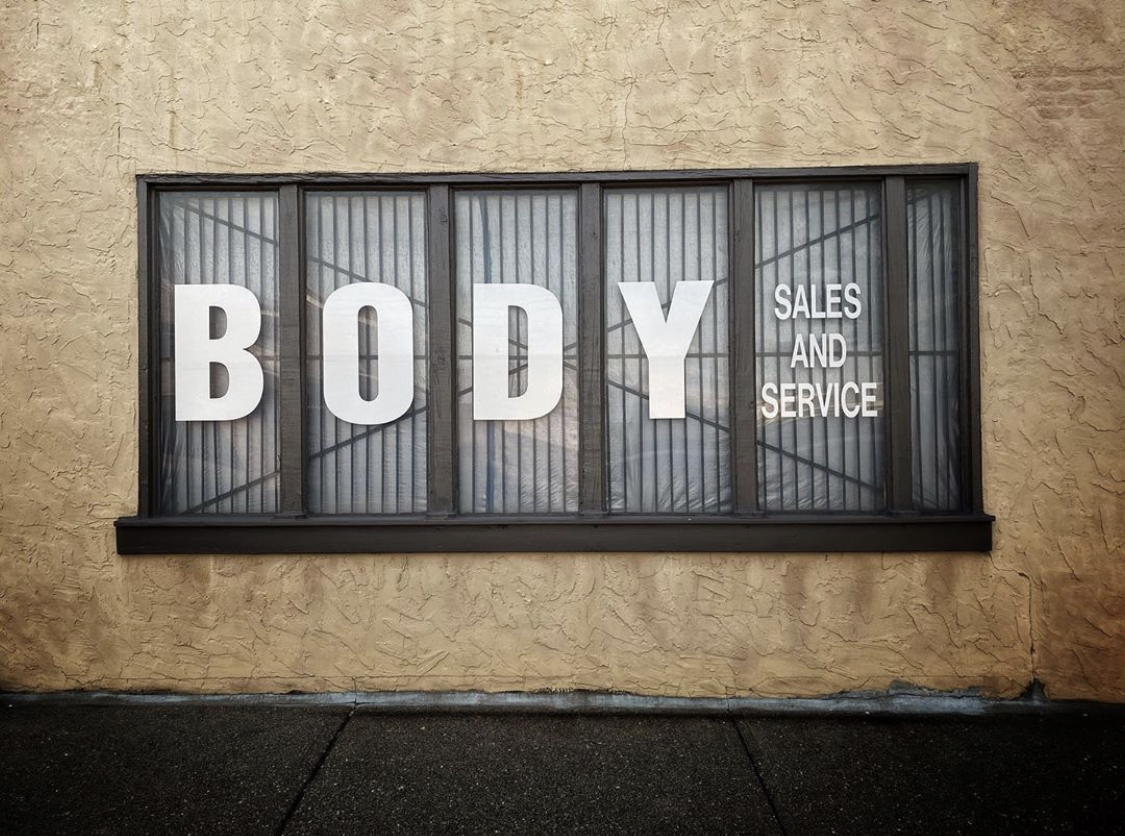
All that I hold inside – words, breath, a touch, a yearning. With all the longing that lies behind I wait, need and want with a hallowed patience.
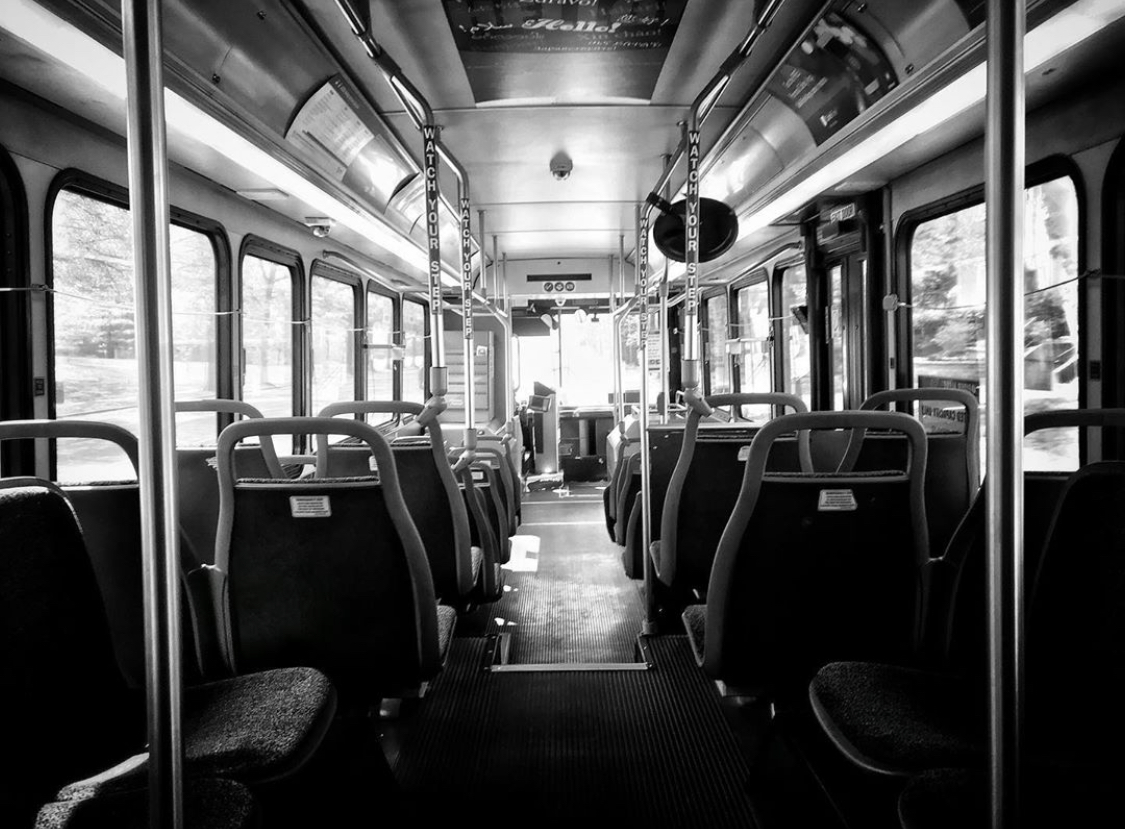
I don’t do alone very well. Most would argue, and I don’t disagree, that I don’t do together very well either – together just seemed more hopeful. I suppose within us is both a sinner and saint, loner and lover. I’m not solely one or the other, my aspirations lie where those two meet.
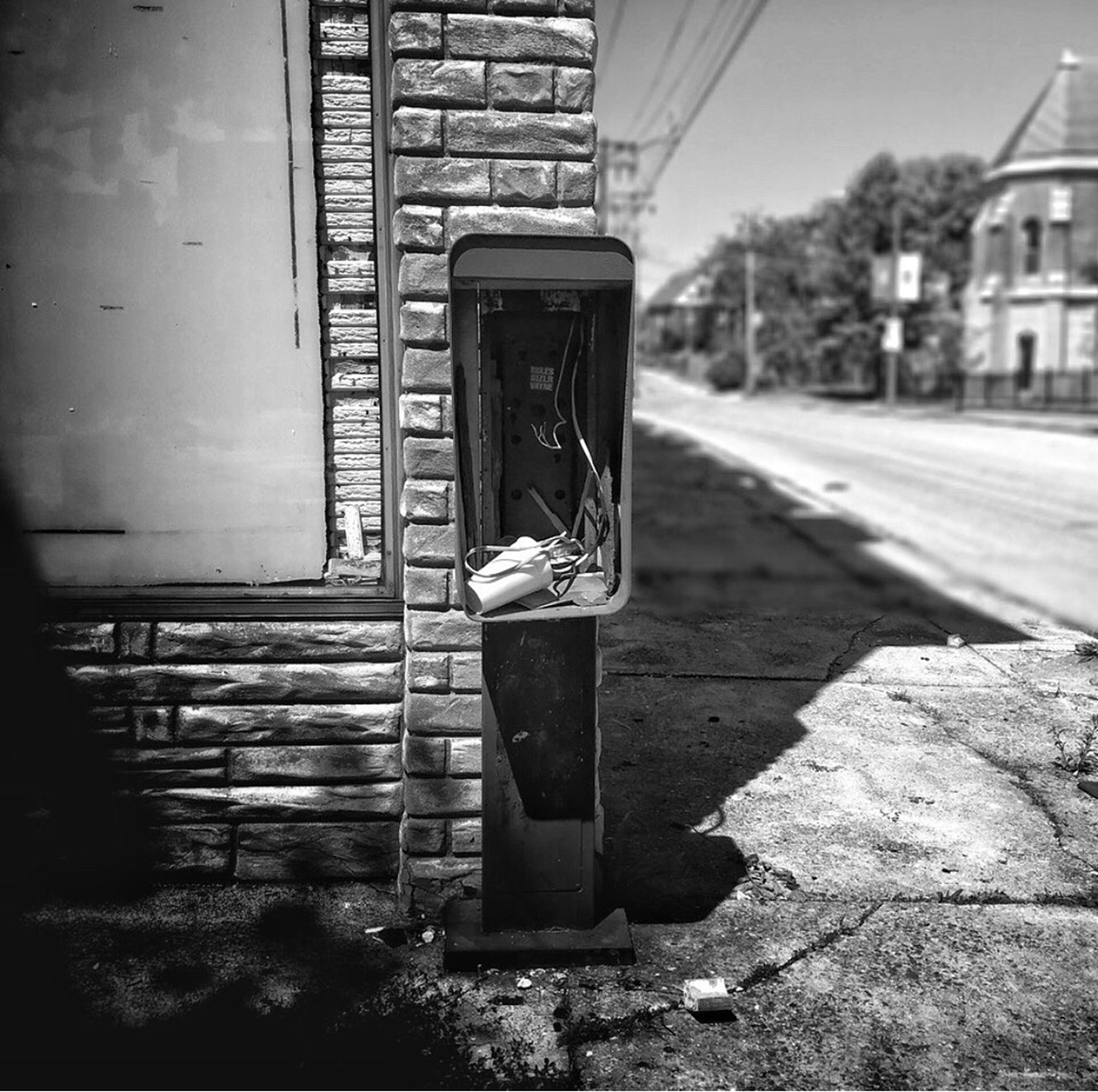
Obsolete. These times remind me I’m not – we’re not
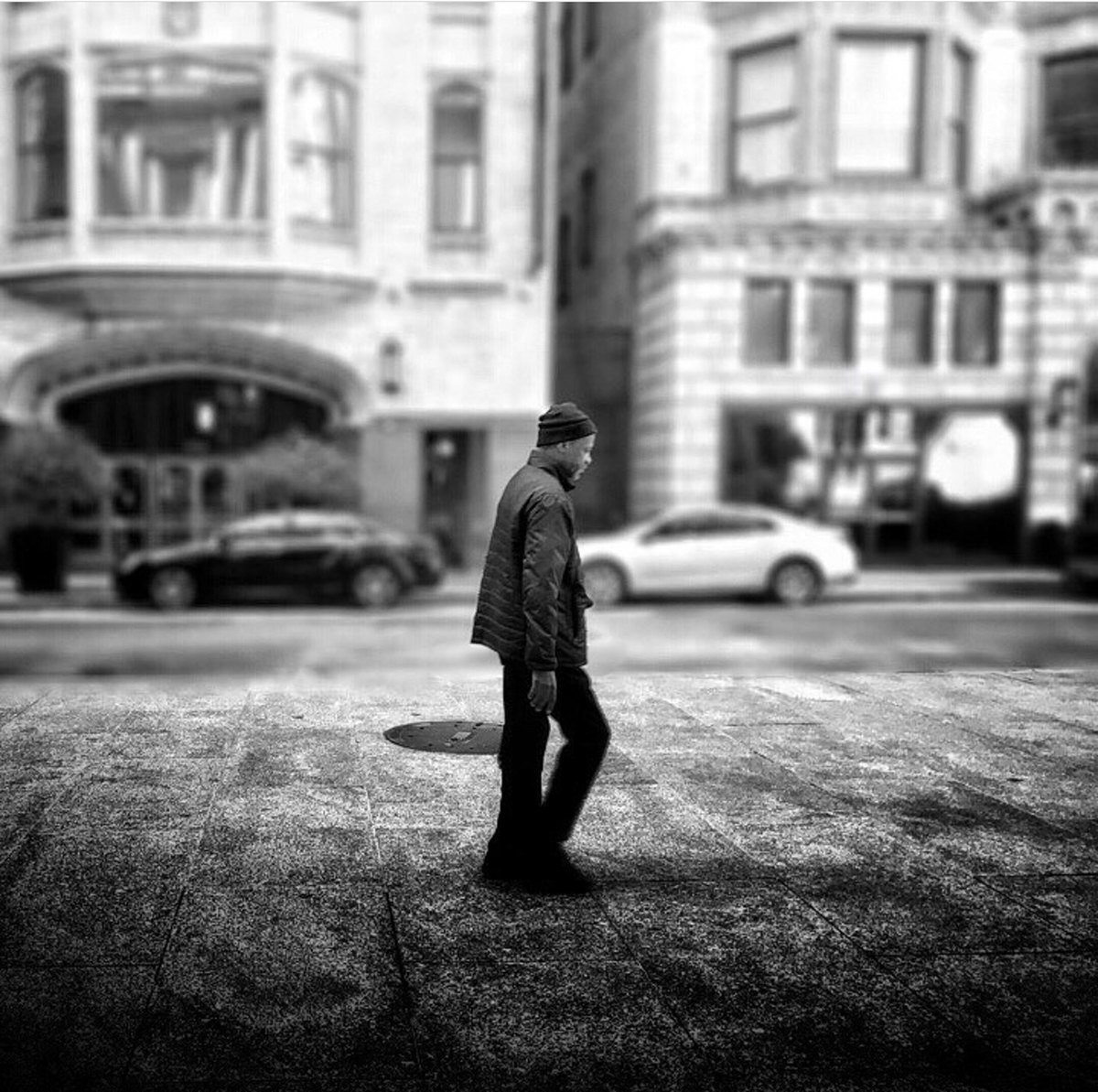
Solitaire. I miss greeting my sons at the diner we frequented and hugging them. If there’s anything or anyone person that you miss what or whom is it?
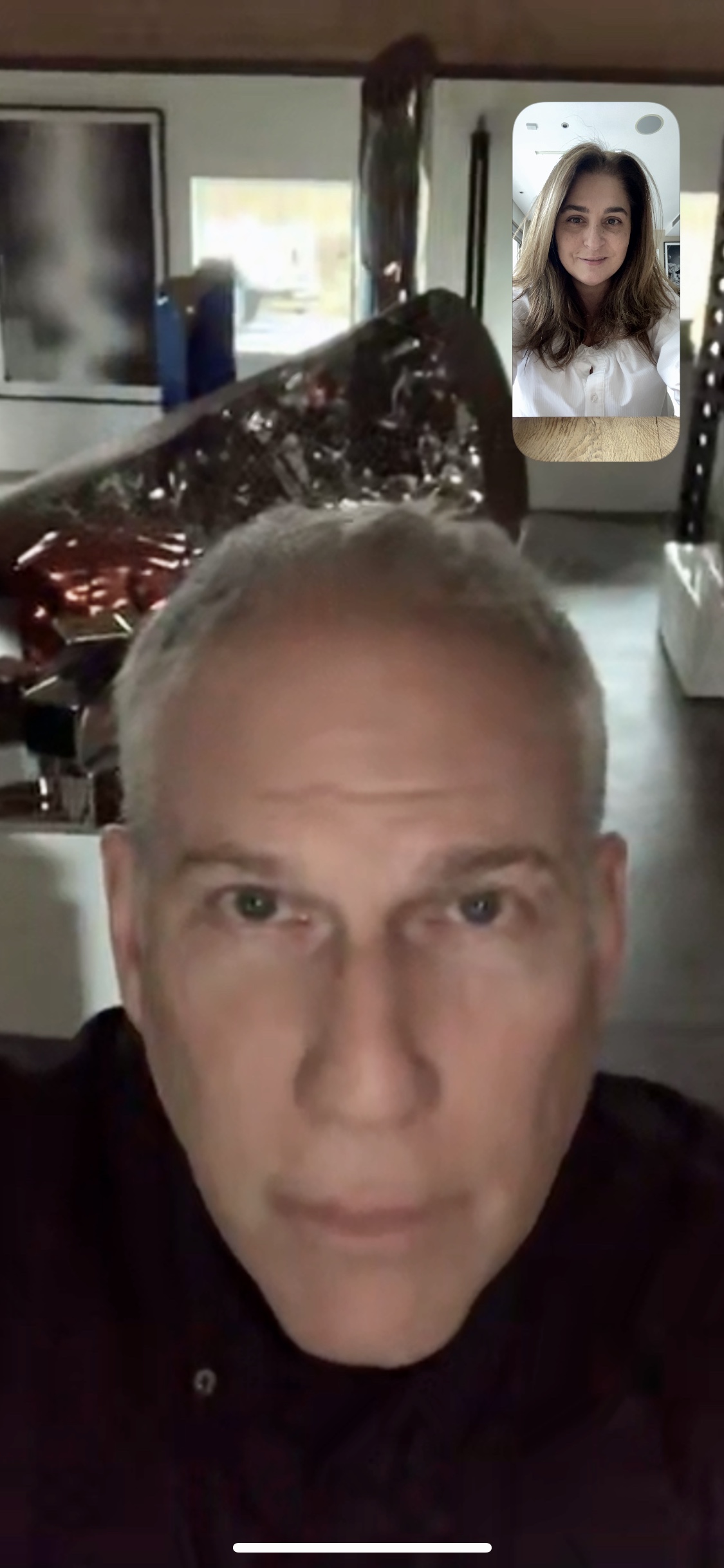
Jonathan Prince
April 21, The Berkshires, Massachusetts, Home & Studio
I am filled with gratitude:
I have a home to shelter in.
Food to sustain me.
Work that inspires and challenges me.
Love that fills my heart.
I’m surrounded by nature.
I feel safe.
My heart goes out to those who don’t have these blessings.
Now is the time for a new level of consciousness.
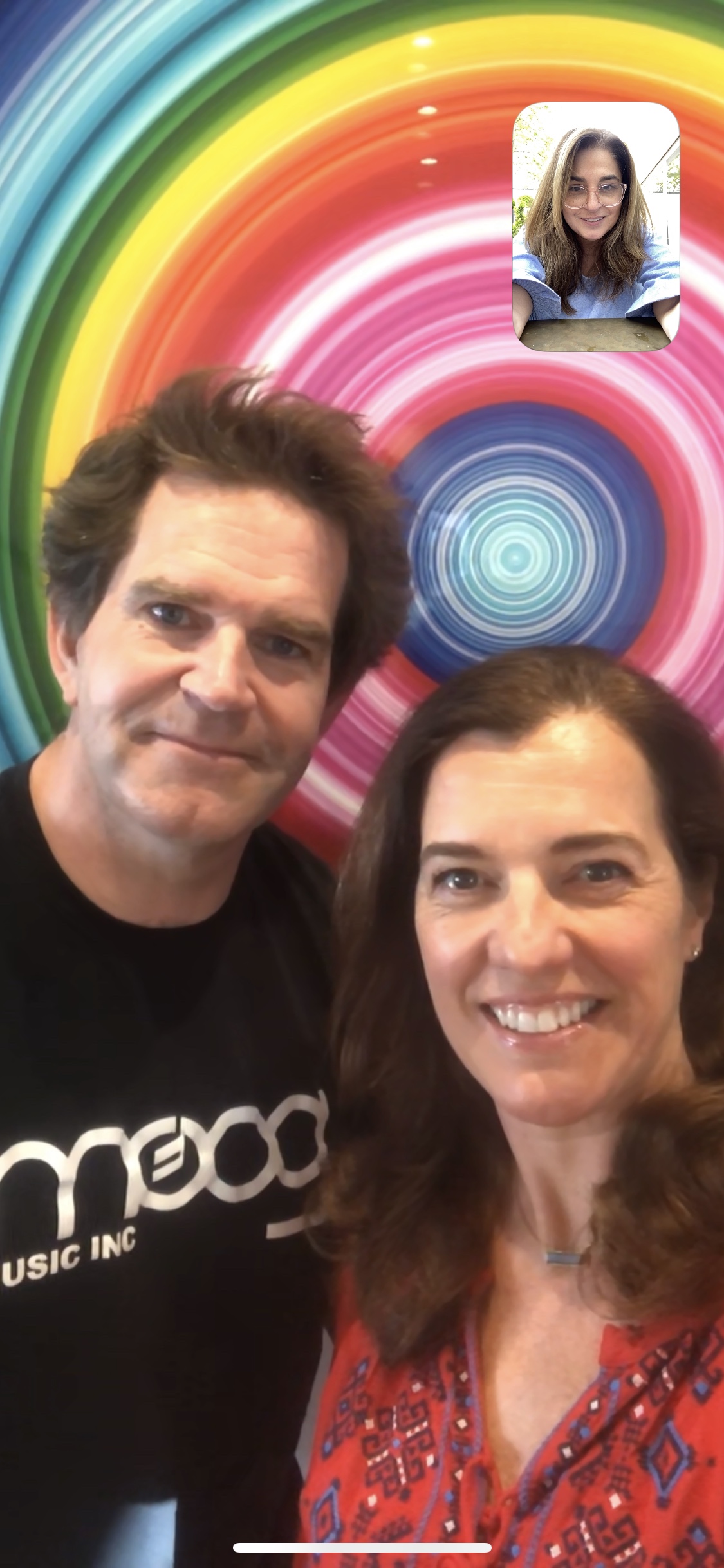
Rob & Nick Carter
April 21, London, Home
We are all desperately missing contact with friends and family during this period. It seems unthinkable now, but just nine weeks ago we launched our “Dark Factory Portraits” in a packed gallery at Ben Brown Fine Arts, followed by a fabulous after party at The Groucho Club. How distant that memory seems. Luckily we have been able to continue working during ‘lockdown’ behind closed doors, painting remotely with our robot. In many ways, it is an ideal project during this pandemic as the genesis for these portraits is simply a photograph. Collectors have been afforded the time to go through old albums with a sense of nostalgia, selecting their favourite image to be painted by our robot whilst they watch from home as the portrait evolves in real time via a webcam.
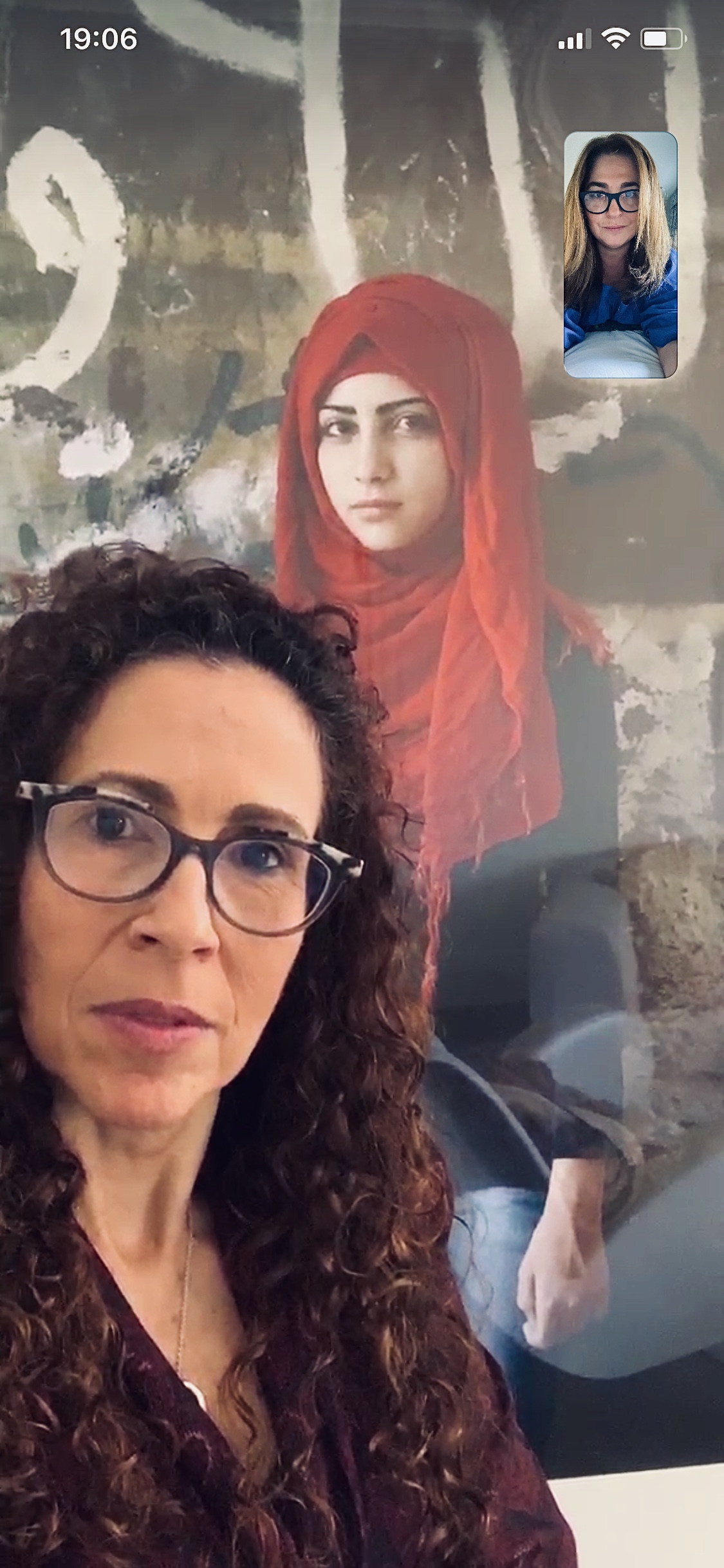
Rania Matar
April 21, Boston, Massachusetts, Home
It seems as if life has been on hold these past few weeks – for everyone. I am always straddling two cultures and identities, as a Lebanese/Palestinian, and as an American. It feels as if the news is always dividing us as “them versus us” and now, here we are a “we”. We are all in this together, in the same boat, with life at a standstill and reduced to the confinement of home. This virus is such an equaliser, making all of us re-evaluate our shared humanity, our fragility, and our priorities.
Isolation and confinement have offered me the gift of time at home with my family, and in the studio with my work. I had almost forgotten how precious both are. With time and space to re-evaluate what matters, I have reached out to my friends, and started visiting them and making their portraits through their windows. A new project about “connecting across barriers” has emerged. It humbles me how many people were willing to be part of this, but also how important the human interaction, that we often take for granted, is. Despite the fact that we only communicate across a physical barrier, we are really, and truly making a connection.
When life goes back to normal, I hope we keep that empathy, kindness, interconnectivity alive in us.
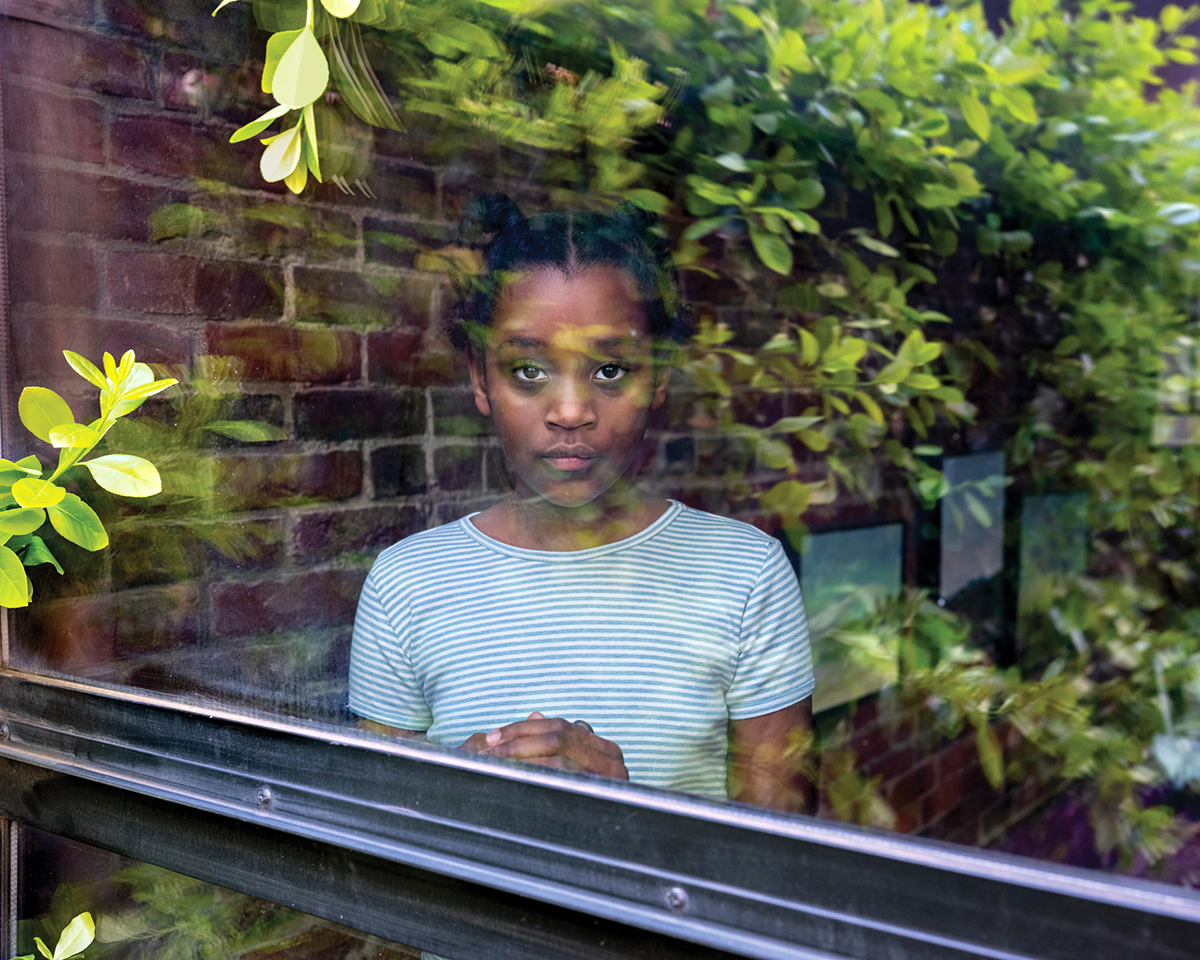
Ruth, Boston, Massachusetts by Rania Matar
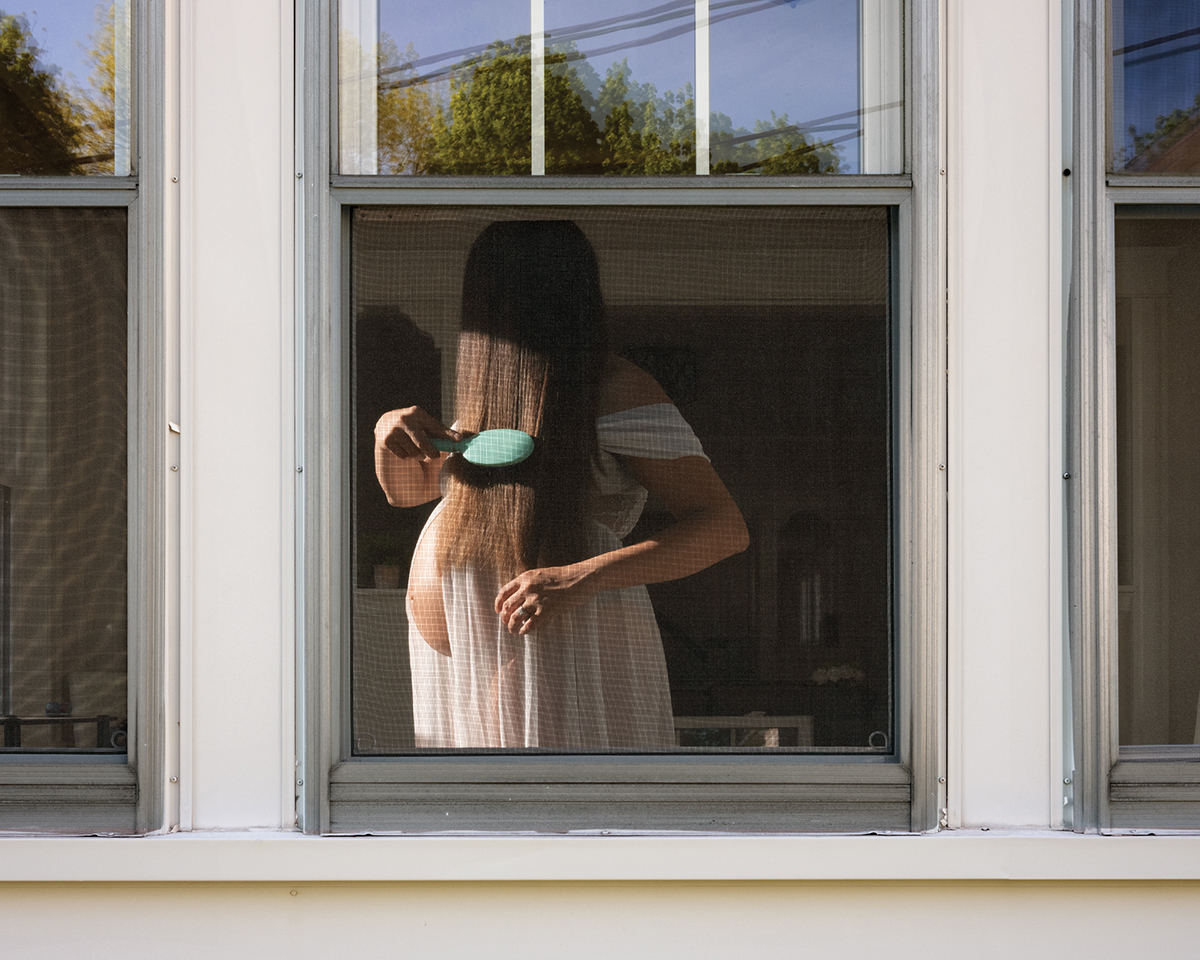
Susan, Salem, Massachusetts by Rania Matar
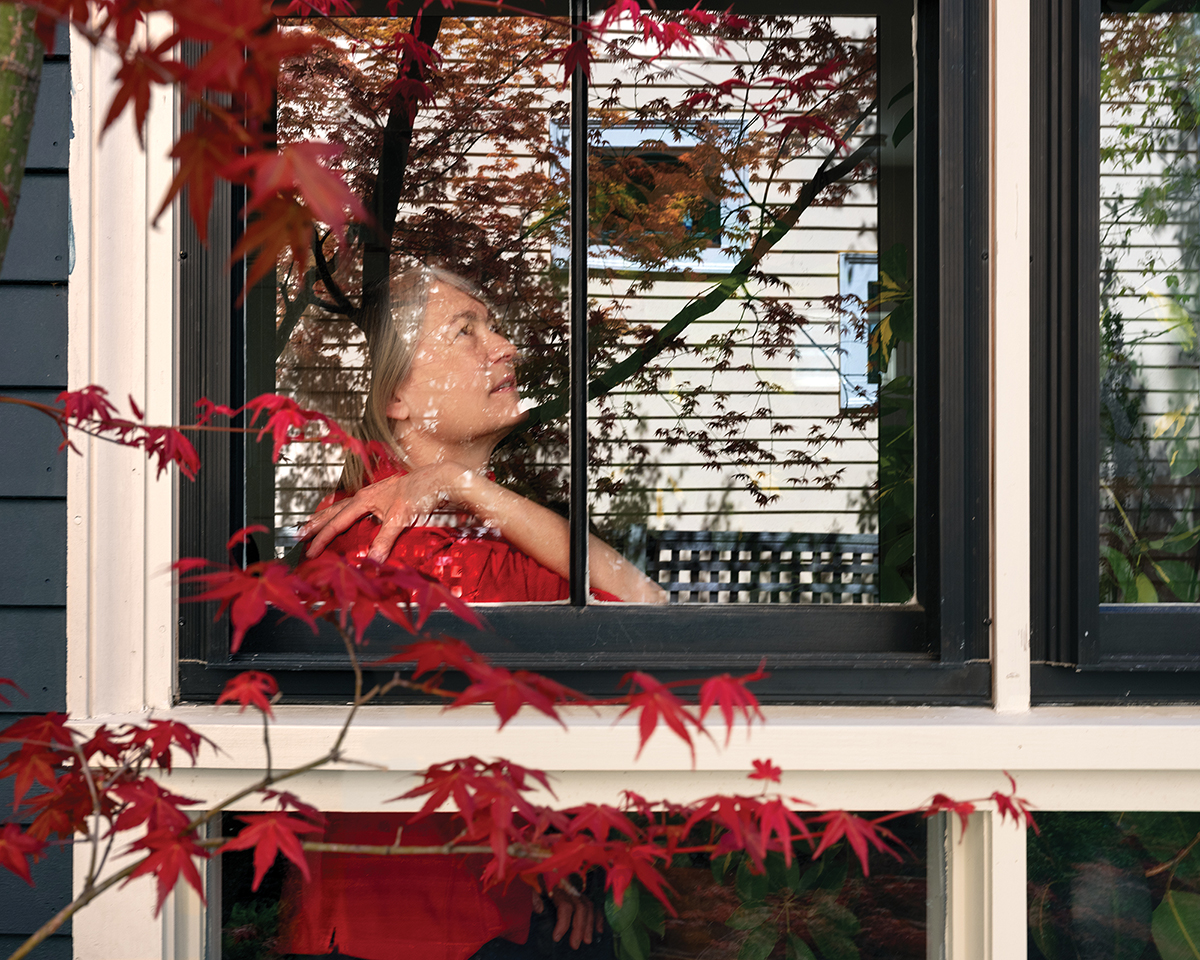
Marie, Cambridge, Massachusetts by Rania Matar
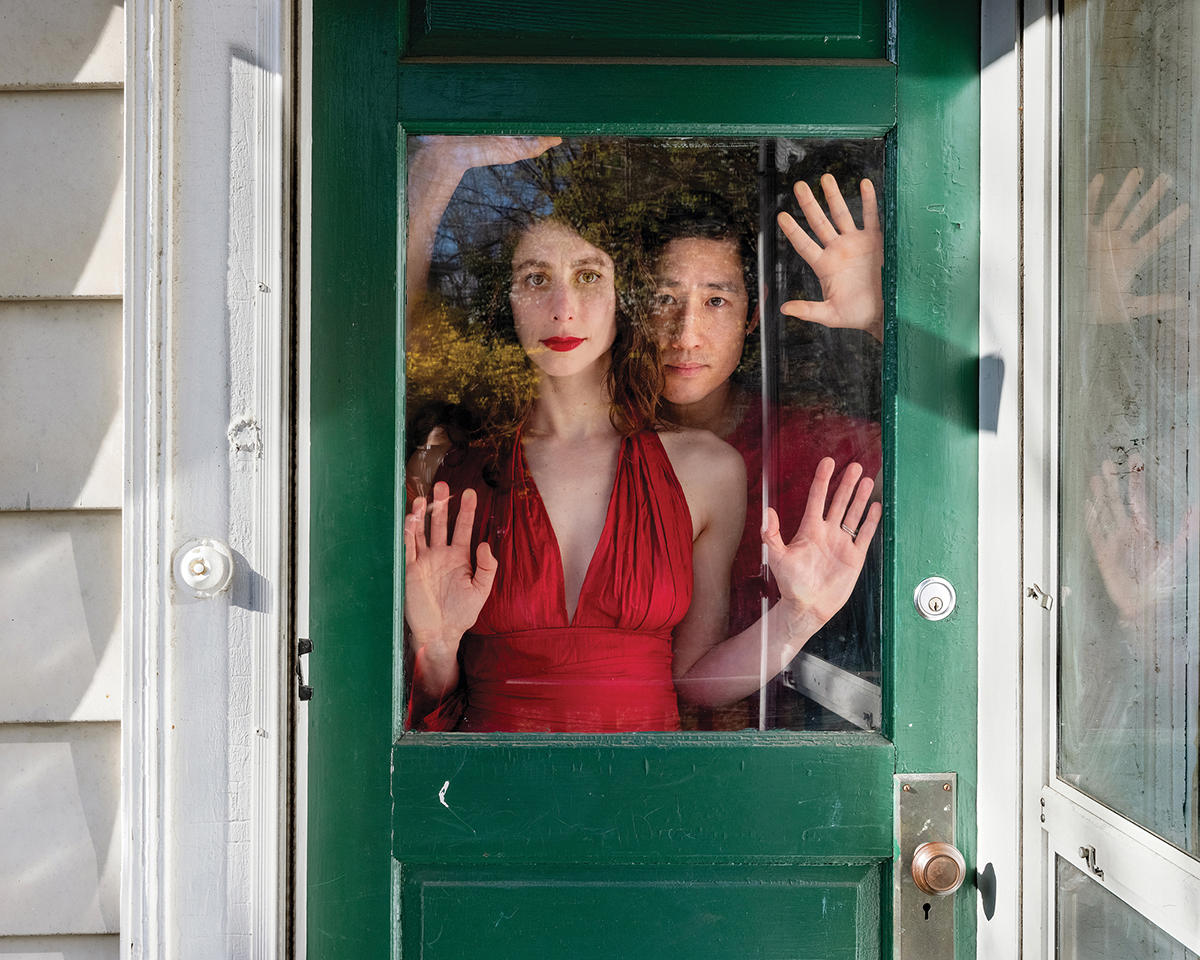
Mia and Jun, Brighton, Massachusetts by Rania Matar
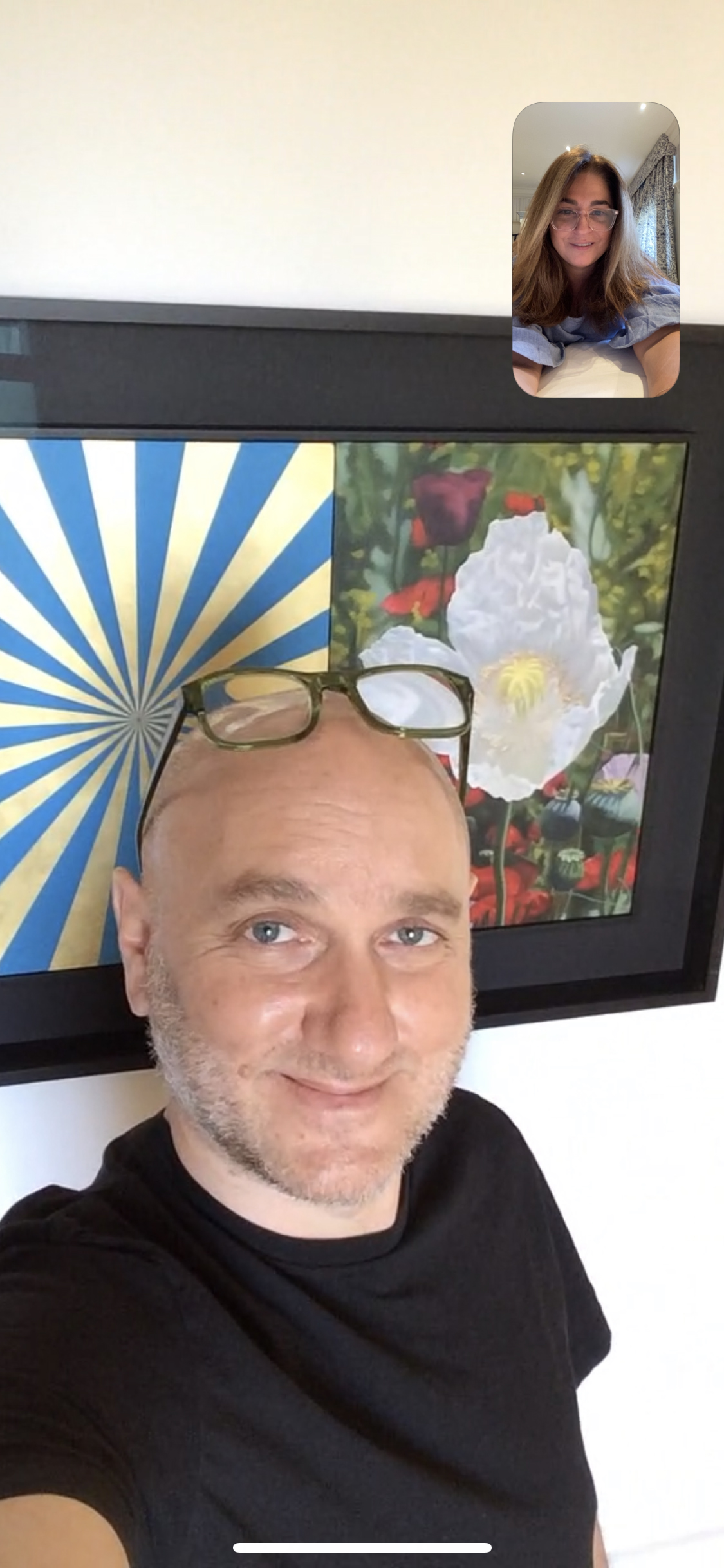
Mustafa Hulusi
April 20, London, Home
I find myself in-between a binary of two poles of opposing modalities:
The year is 2020,
Technical versus Magic
Existence versus Essence
Instrumental versus Ineffable
Heaven versus Earth
Monolithic versus Multitude
Noise versus Silence
The Map versus The Territory
Logical versus Mystical
Capital versus the Commune
Magnificence versus Abject
Stasis versus Transformation
Nature versus Culture
Liberation versus Subjugation
Substance versus Style
Ascent versus Decline
Shallow moment versus Deep Time
Sacred versus the Profane
Health versus Plague
Sunlight versus Destruction
Esoteric versus Exoteric
Compassion versus Indifference
Thought versus Speech
Sobriety versus Intoxication
Fragility versus Strength
Joyous Miracle versus the Mundane
Sensual versus Mechanic
Shining versus the Darkness
Rhythm versus Infrequency
Idea versus Image
Flow versus Barrier
Ancient versus Modern
Authentic versus Counterfeit
Imaginary versus the Material
Virility versus Exhaustion
Concrete versus the Fluid
Limit versus Continuum
Animism versus Monotheism
The mountain versus the Sea
Everything and Nothing.
The infinite.
My fear is that without a functioning economy, art becomes an unreachable luxury as most artists will not afford the time and mind-space to embark on production.
Maslow’s Law outlines the pyramid of basic human needs required to fulfil the self-actualisation process of artistic potential. This is necessary to release the variable physicality of art to its audience and the world.
Mustafa Hulusi: The EMPTY Near East, (single channel) from Mustafa Hulusi on Vimeo.
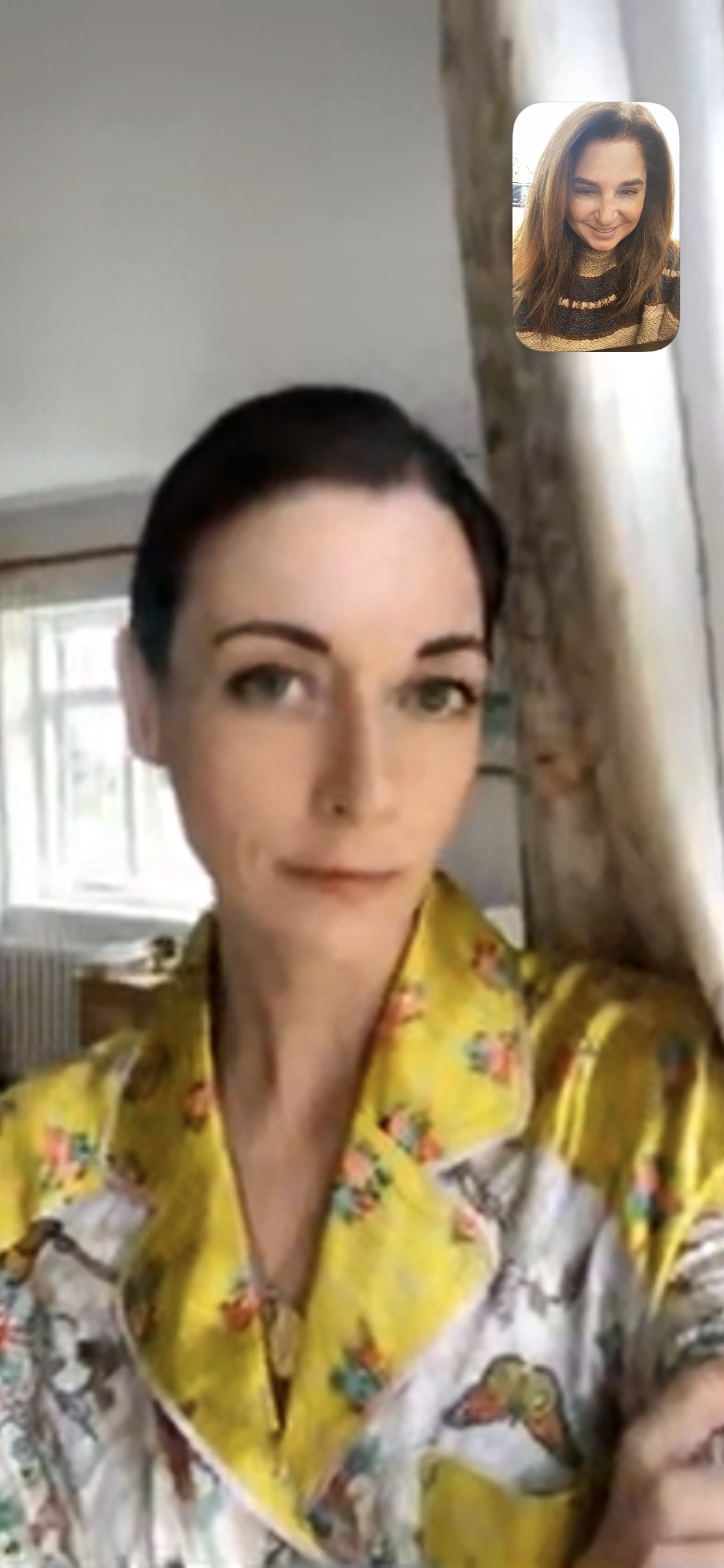
Mary McCartney
April 16, London, Home
What we have lost in these times is personal connection. So I wanted to delve back into my archive in search of those moments of affection and touch. In doing this, it has made me appreciate how powerful those emotions are.
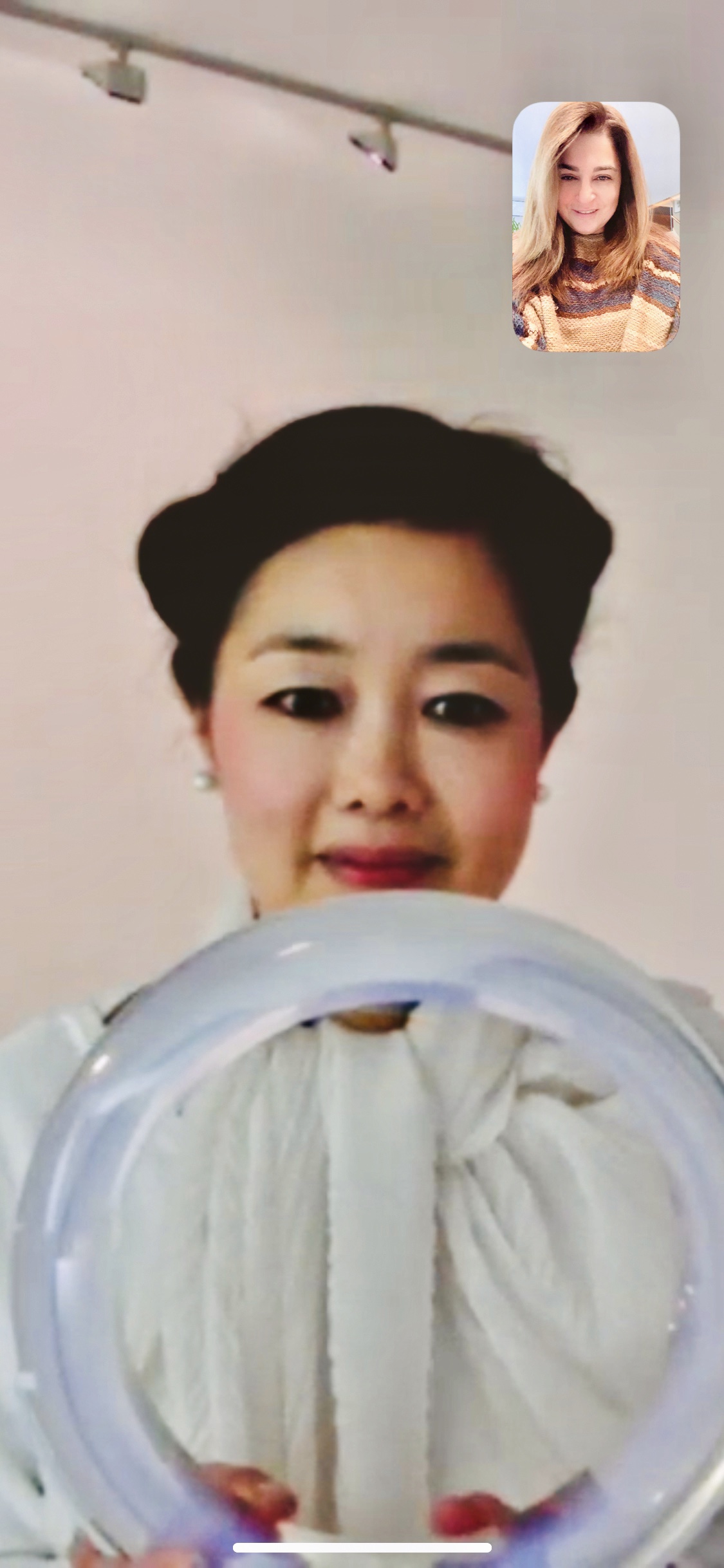
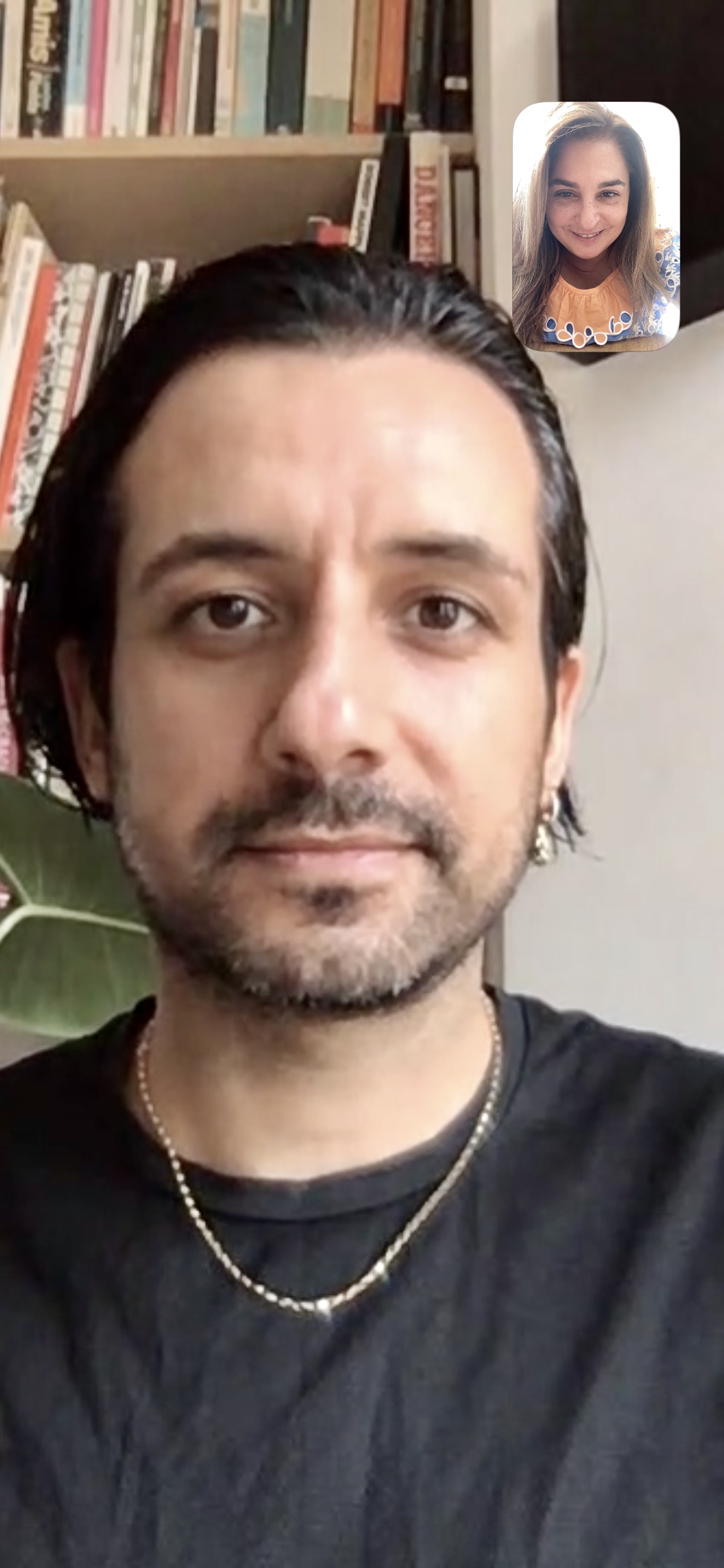
Prem Sahib
April 15, London, Home
This pandemic has made many things visible. We’ve seen that our NHS and public services are more important than ever. That BAME people are disproportionately affected by Covid-19. Only weeks ago the Home Office deemed as ‘low-skilled’ those now known as ‘key workers’. I hope the current visibility of these issues will prompt positive and lasting change.
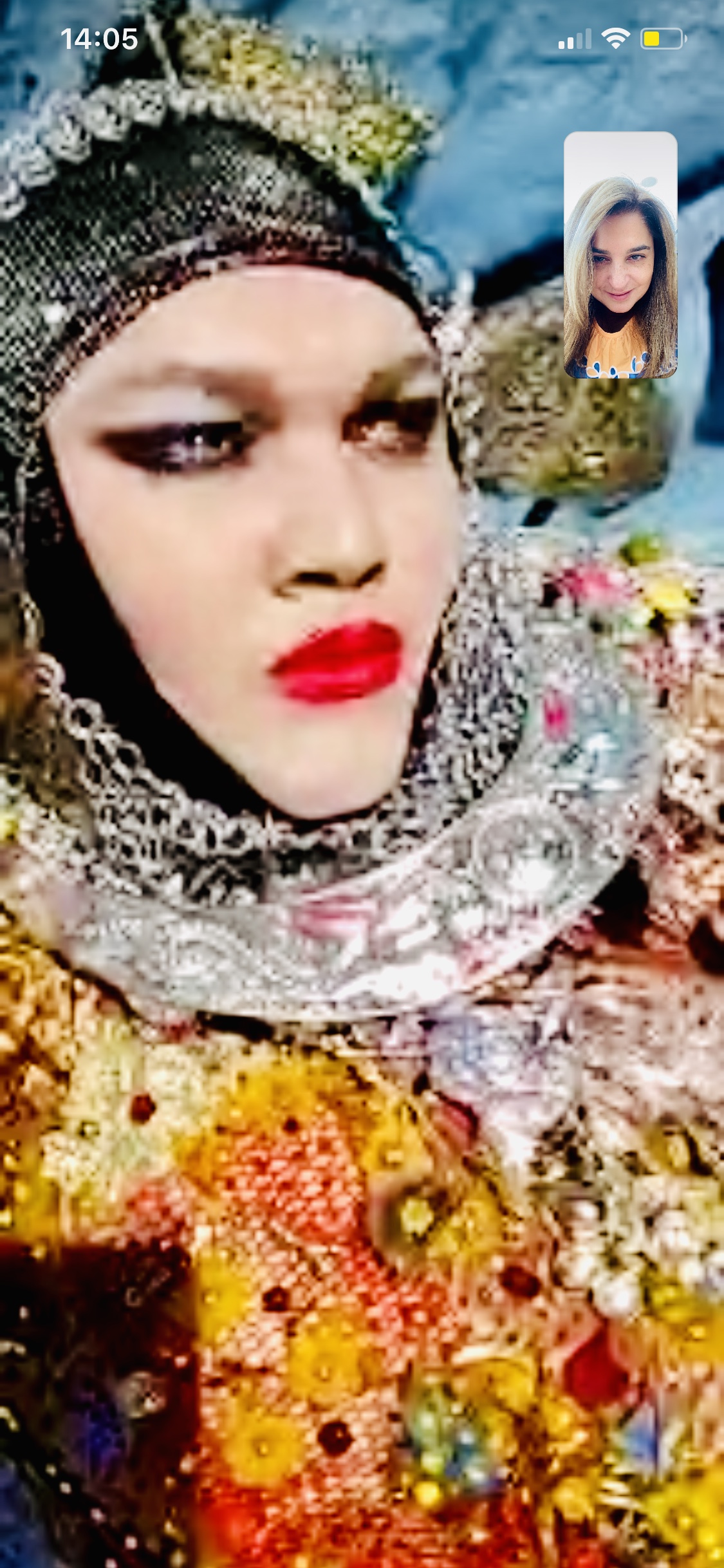
Daniel Lismore
April 15, Coventry, UK, Home
I have been travelling curiously around the world for the past eighteen years. Never once did I say no to a journey. All of a sudden life and travel stopped. This unfortunate time has made me think and feel about all the thousands of tiny things that I have picked up along the way, and stored in boxes at home. I always knew a time would come when I would do something with these memory-based trinkets…from things I picked up on stage with Adam Ant and the Mötley Crüe to the stage glitter when I danced with Macy Grey, Kesha and Kylie Minogue, not to mention bottle tops I found in Kenya and which I buried for years. The sequins I ripped from Michael Jackson’s jacket. Hundreds of hours of couture embroideries, and anything I saw beauty in along the way. A champagne cork from the Tzars’ stash, a pin from Lindsay Lohan, a lace Donna Karan once gave me, a Union Jack bow tie Kate (Moss) wore in a loo on a night out, as a joke. Religious trinkets from when I was a child, Victorian jewellery my dad collected and tribal jewellery from around the world. Rubbish I found on the beaches of Iceland, and on the streets of London and Coventry, where I grew up. Swarovski crystals fallen off my ENO opera costumes and a collection of stones. All of a sudden, all of this became part of my three dimensional artworks which I have started making on my mother’s kitchen table, late at night, whilst watching Star Trek and drinking Earl Grey tea, hiding away from the world. Each stitch or drop of glue brings back a memory, making me appreciate life now, more than ever. It has also made me appreciate the people I have met along the way, now more than ever. And even though the future is uncertain, I have no doubt that these ‘armours’ will end up in my next museum show, alongside the electric filter face mask and the leather gloves I wore to the Tate Modern to see the Andy Warhol show, terrified of human touch. That night, I knew would be my last night out. It’s all become part of my journey, all these pieces that have come from the times that have made me who I am today. Now, more than ever, I am curious and excited about the future. What I have learnt, however, is that love and human touch are the crux of life.
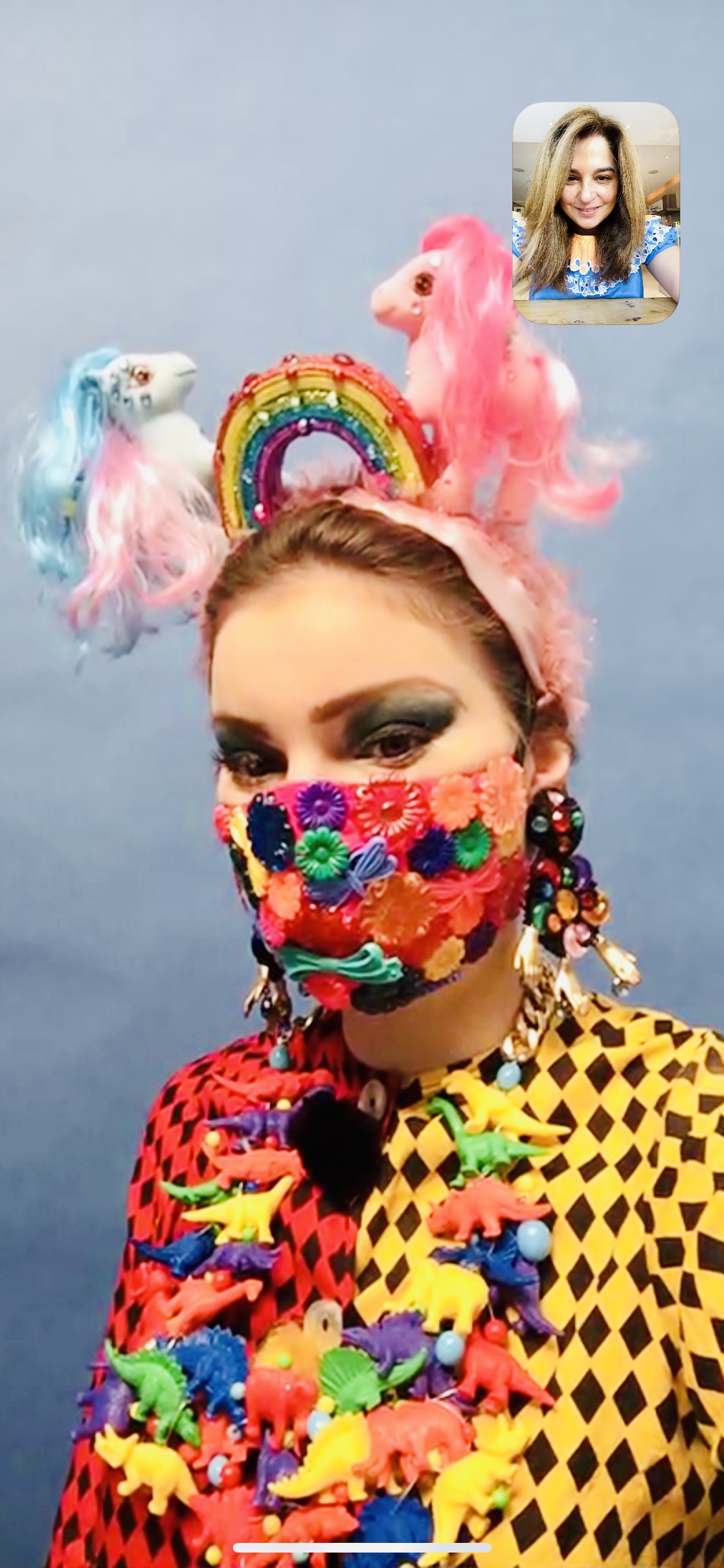
Anne Sophie Cochevelou
April 15, London, Home
Quarantine could actually be a blessing in disguise. Confinement is the perfect working asceticism for artists. No distraction (derived from the original Latin sense of “divertere” – things that divert us) from our primary mission. No frivolous party to go to, no disruptive phone calls, limited supplies that make you more resourceful within the given constraints. Tremendous creativity will rise from this austerity.
Working from home, a practice that was long seen as a sign of unsuccessfulness, is now fully legitimised by the lockdown. Like an artist in residency, in the comfort of one’s own place.
Omnia mea mecum sunt ‘All that is mine I carry with me’ as the stoic Seneca would say. I can loose works. I can loose commissions and projects, but I can’t loose my creativity. Through this curse, I feel blessed to be able to endlessly enjoy my own company, and travel through my boundless imagination. I wish I would have the luxury to experiment boredom for only one day.
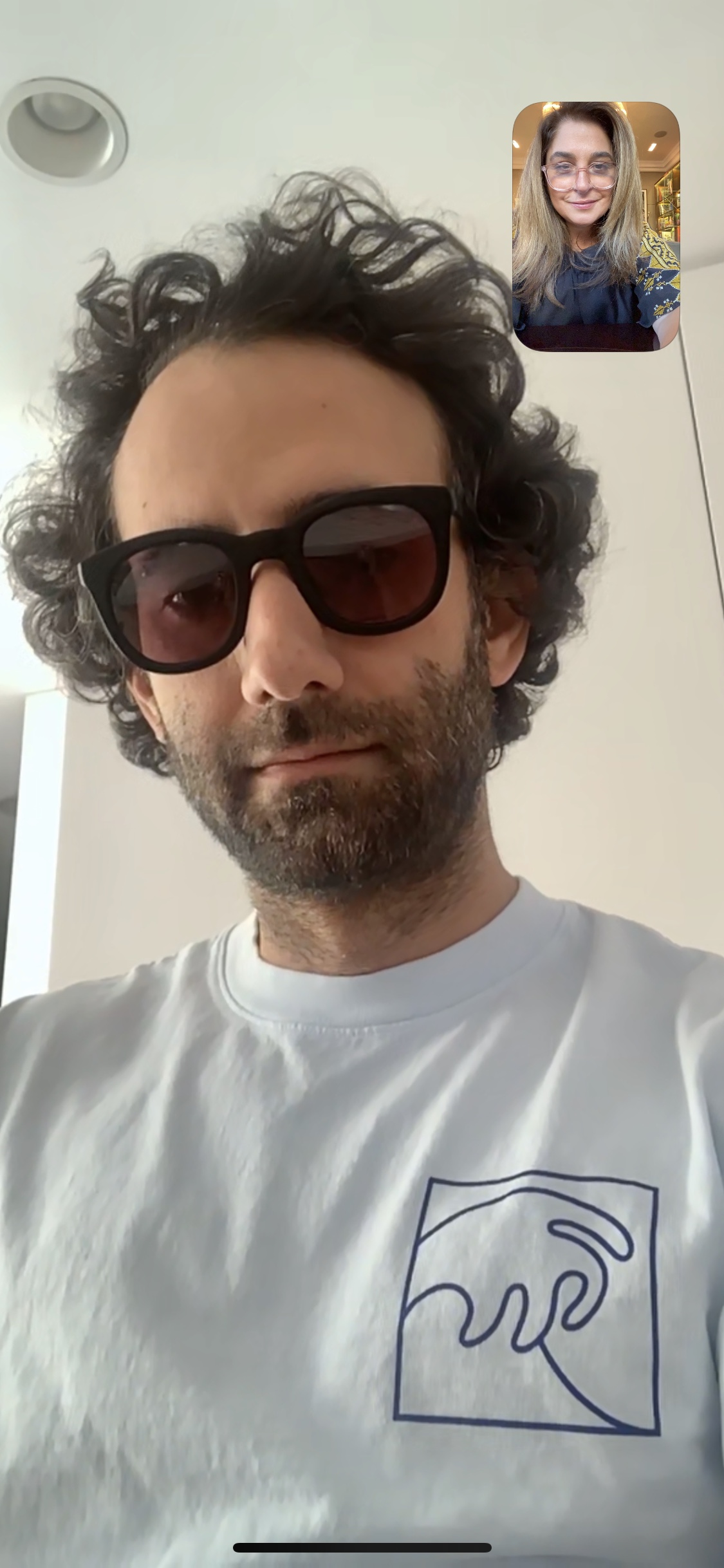
Alex Israel
April 14, Los Angeles, Studio
I hope you and your loved ones are doing well. I’m here in LA, sheltering-in-place at home with my dog Mr. Brown. My heart goes out to everyone who is suffering, and to our many heroes who are risking their lives on the frontlines of this terrible pandemic to save ours. Stay home, stay safe and please be kind to yourself.

Hassan Hajjaj
April 14, London, Home
My priorities of yesterday are no longer those of today.
Safety,
Health,
Home,
Love,
Catching up with oneself…
That’s all that really matters.
It has taken a while for us humans to get accustomed to the idea of this democratic disease which has caused ravage in all four corners of the globe. However, we are slowly learning to adapt and eventually overcome the obstacles, together. For now, let us assume our share of individual responsibility by staying home so that we are able to help each other.

Flavie Audi
April 14, Paris, Home
The abusive pursuit of profits, the mad extraction of materials, the toxification of air and water, the over-production of superfluous consumption, and the cult of the speed of life have turned the planet upside down. We are eternally interrelated with the planet. When humans destroy nature, they destroy themselves. There is an urgency to reset this relationship and to breathe new life into an intimate, harmonious, total participation in the universal cosmos.
The world has paused. What a relief. It was going too fast… The fear of missing out, the pressure for progress, the daily deadlines … all have vanished…leaving this vacuum to be filled with total spontaneity and uncertainty. Suddenly we have migrated into cyberspace, to a new continent. I am overcome by a constant ebb and flow of our perception of reality. I oscillate between attachment and detachment with reality. Sometimes haunted by the fear of losing contact with reality. Other times finding pleasure in losing my grip on the real. The Covidian context shines a spotlight on the death of reality. Life seems more iridescent than ever. Overwhelmed by the vastness of free time for the first time. As time slows down, I grow young again. Suddenly I look at nothing and see everything. I let the importance lie in my gaze and not in the thing I am looking at. Experiencing the instant, liberated from the remorse of the past and the apprehension of a planned future. And then the frustration arises. The virtual world will never have the same significance as physical contact, as a hand that caresses you.
Let’s be guided by hope, not fear, to re-enchant the planet once more. We miss the unique visions of provocative past thinkers who helped us glimpse the unimaginable. Let this uncanny confinement be a resurrection of the soul in its absolute alignment, a portal towards a new universal cosmic awareness. May our fervour lead us to experience these circumstances, not as tensions, but as a potential for awakening.
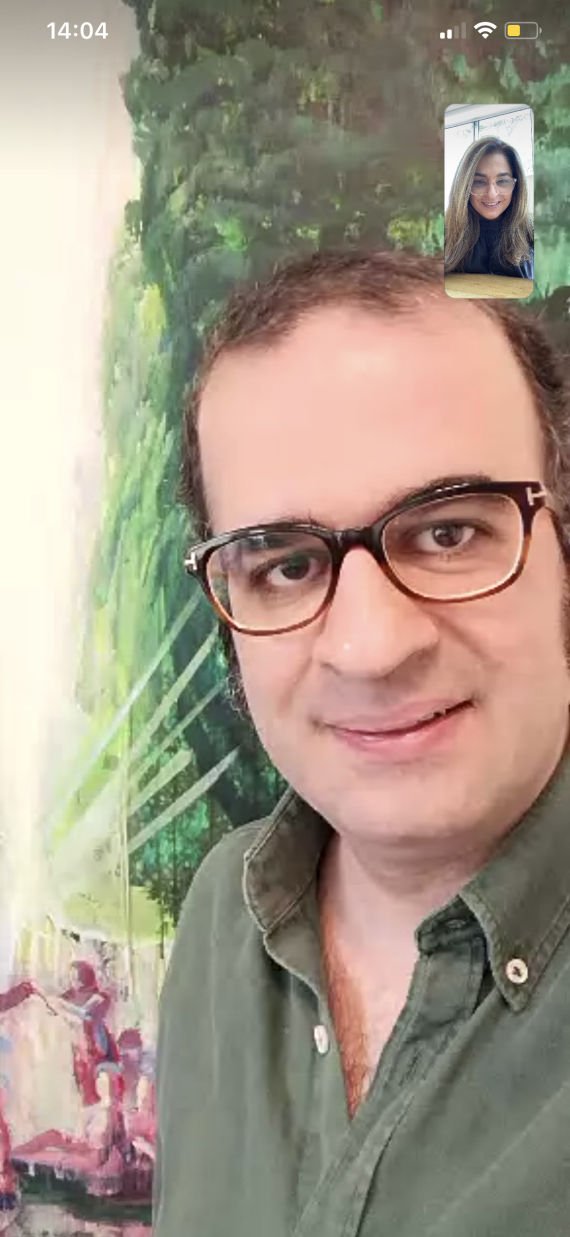
Mehdi Farhadian
April 15, Tehran, Iran, Studio
Confronting the difficulties and historical uncertainties of the past few decades, my people have tried to protect and empower themselves whilst facing an unpredictable future. That future is now happening in real time, the difference being that now, those fears and uncertainties are shared with other nations of the world. Art can, does and will offer answers and solutions to sooth these tensions and fears. Art at this moment in time is my personal saving grace.
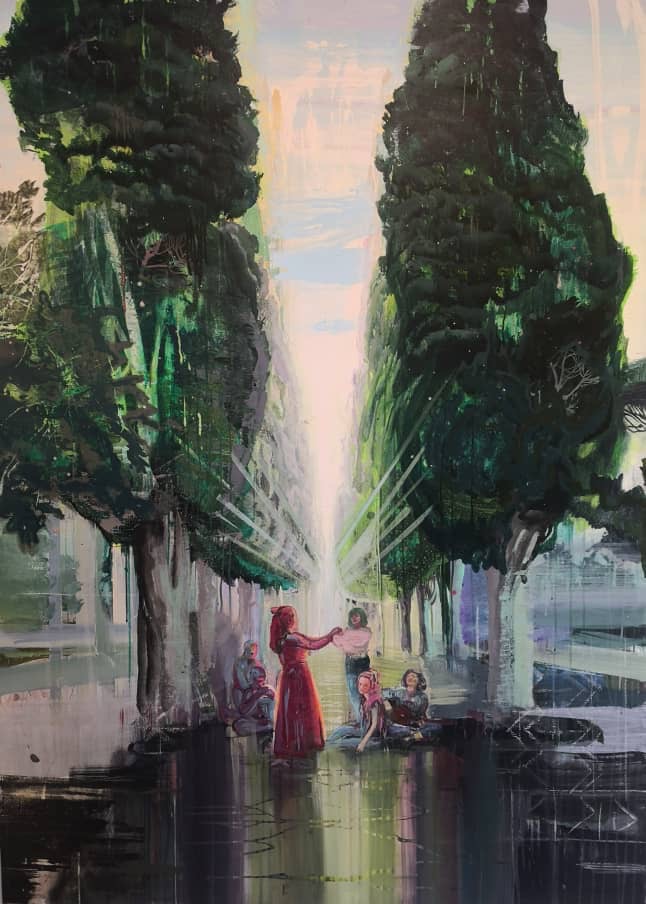
‘Together at Dusk!’, 2020, work in progress
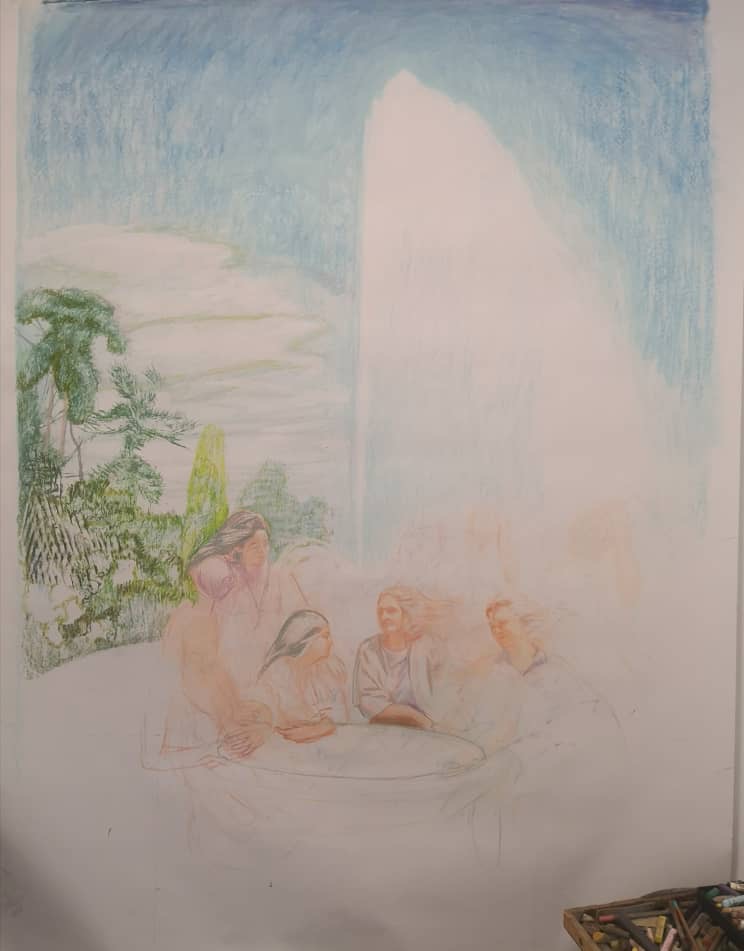
‘Mothers and Daughters’, 2020, work in progress
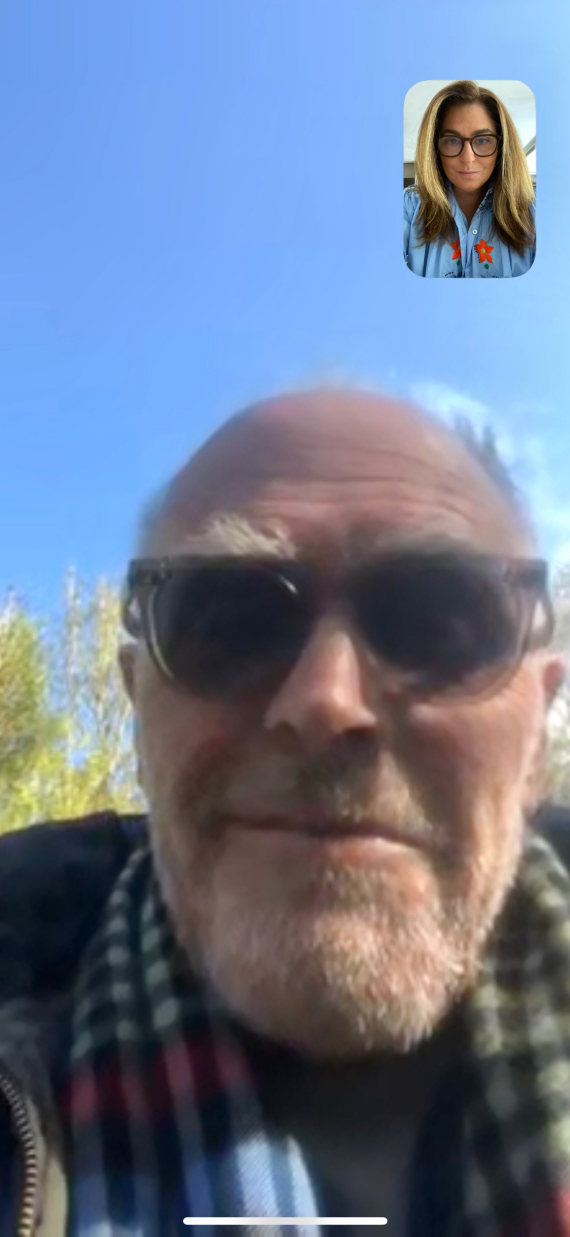
Richard Wentworth
April 14, English countryside, Home
Dear Maryam,
What an archaeological moment this is, each and everyone of us rummaging in history, interrogating everything we thought we ever knew.
The unknowable knowns.
Amidst the vast bags of second hand things which we all carry in our heads, language must take up most of the entrepôt.
At this fugitive time, it is language which seems to effloresce, all the words burning bright, vibrating against each other.
Express, depress, impress, suppress, repress, compress, seem to be my morning’s raiding party today.
Just another emotional ambush.
RW
Tuesday ? April 2020
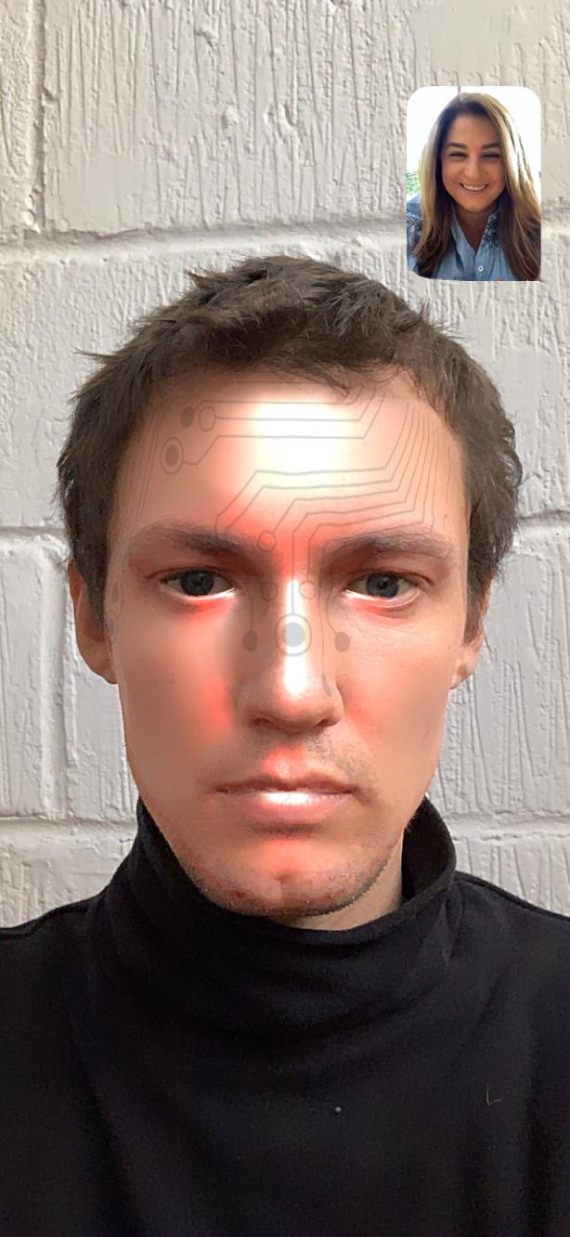
Ed Fornieles
April 14, London, Studio
When I was sick, I watched all of Star Trek Next Generation. It’s set in a future where humans have distinctly got it together. It’s an oddly optimistic reality where war, poverty and climate change are a thing of a primitive past, and where humanity seems united, brought together perhaps by a common sense of its own fragility, in relation to the vastness of space.
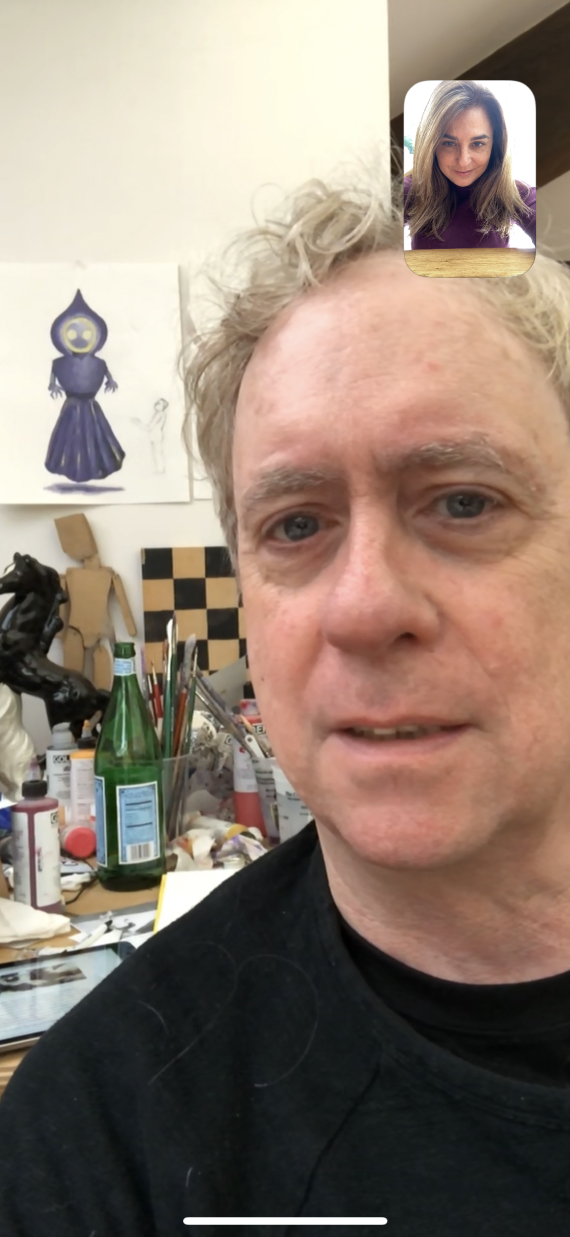
Tony Oursler
April 13, East Coast of America, Undisclosed Location
I hear a scraping sound, the data being removed from our communications devices.
A voice said: Our patterns are recognised, passed around and commodified.
Q: Humanity can’t be measured in metrics or can it?
Then something thought, “Do one thing each day that you never did before, then you can’t be quantified.”
“Yes”, they said, “Then we will be human.”
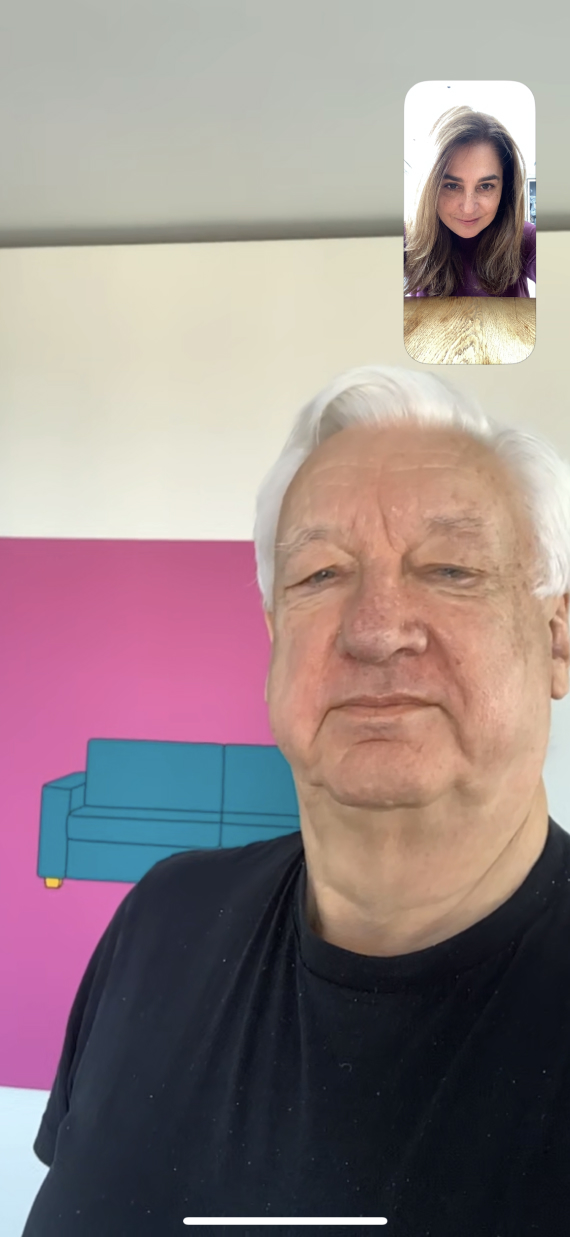
Michael Craig Martin
April 13, London, Home
Nothing that has happened in my whole life has shown so clearly as the pandemic that we are all part of a single shared humanity, and that society, community and family are our expression of that humanity.
For years we have seen the role of the public realm criticised, derided and diminished, but in crisis it has been the state that people everywhere have looked to for guidance and protection, and we will ultimately hold those who have controlled the state accountable.
We have watched in amazement that there are some people willing to risk their lives to save ours, and that we are ultimately dependent on many who are paid and respected least.
The pandemic has revealed more forcefully than ever the shameful inequalities that victimise the poor, the minorities, the migrants.
Let us hope that these lessons that seem so clear now will not be forgotten when this tragedy passes.
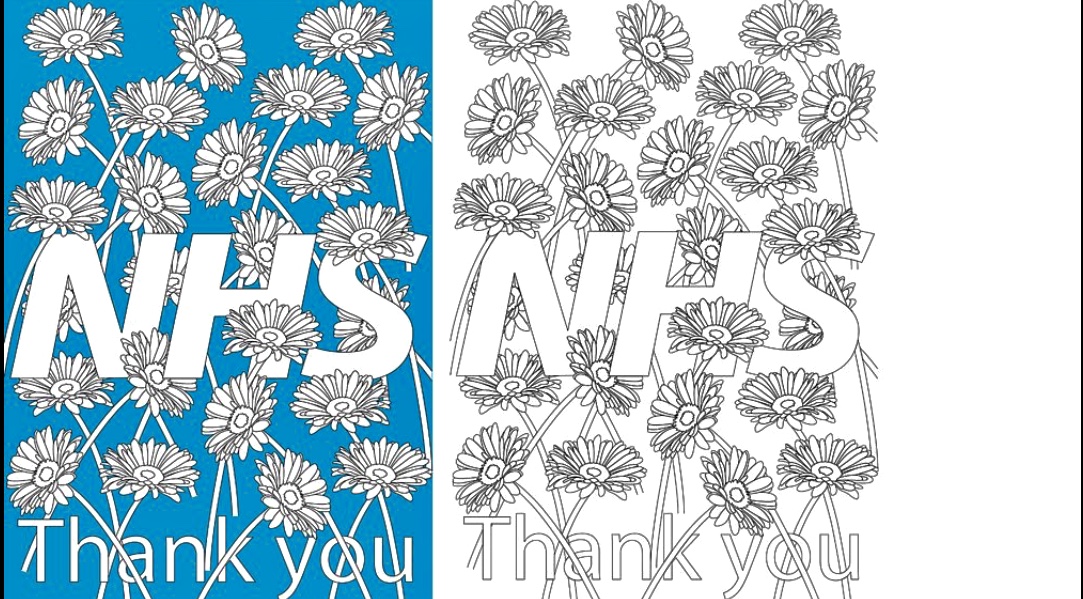
Michael Craig-Martin’s NHS poster is designed for adults and children to colour in and display as an appreciative show of support for the selfless work of the NHS staff.
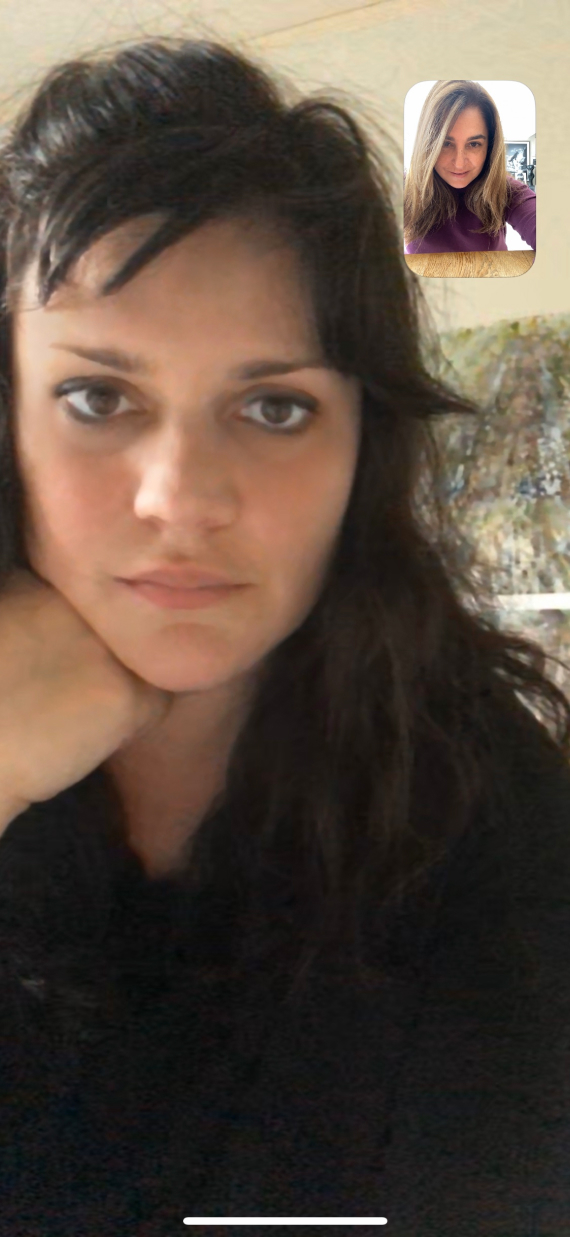
Diana al-Hadid
April 13, Upstate New York, Home
Sometimes artists don’t have many words. Sometimes artists are not ready to perform. Sometimes artists need to withdraw. Sometimes artists need fewer distractions and more silence. In fact, we all do. We have been experiencing a global existential crisis for some time. We’ve finally been made to stand still, to retreat into our homes, our families, ourselves. Let’s first survive this pandemic. Let’s absorb all this collective silence, all this ambiguous not-knowing, and use that energy to build better worlds.
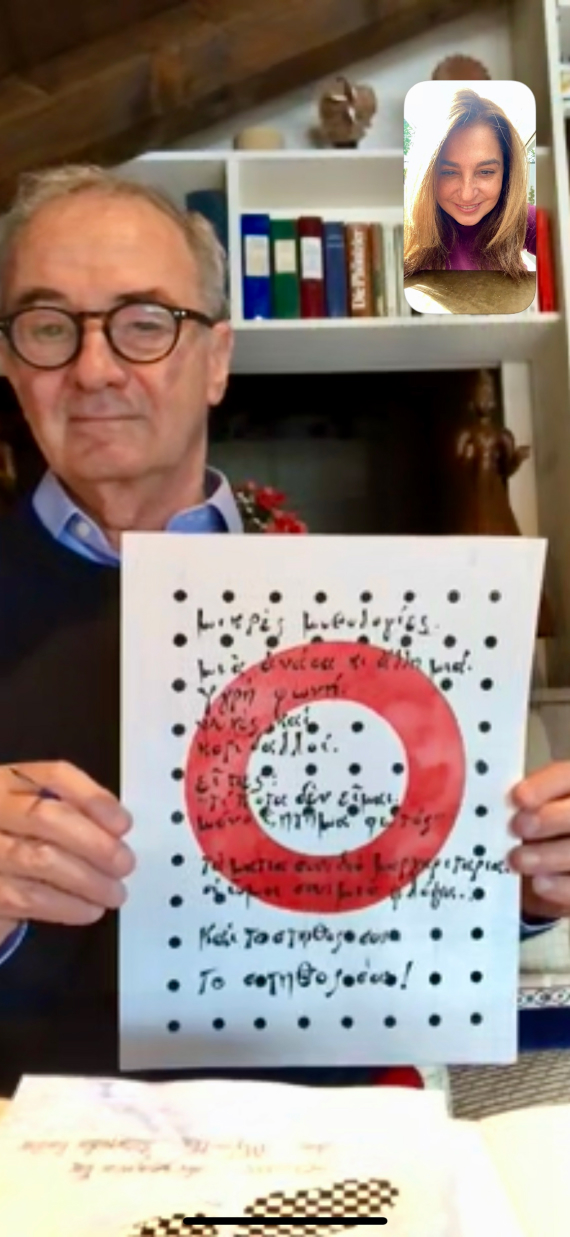
Paolo Colombo
April 13, Switzerland
I heard birds during our phone call, singing loud and free. It is such a sad moment for every human, but nature seems to be doing well. I am temporarily in the mountains by Switzerland, by a small lake. I see birds I have never seen before, mandarin ducks that never made it past the shooting in Italy and the Balkans. Probably for the first time in one hundred and fifty years they did not hear the sound of guns. (I imagine they fly lower than our common ducks.) Most of all, I miss my friends and Athens. I miss the stray cat I feed every night. (A kind neighbour feeds him these days). I have my watercolours with me, and two pads, with lots of sheets left in them. I paint every day.
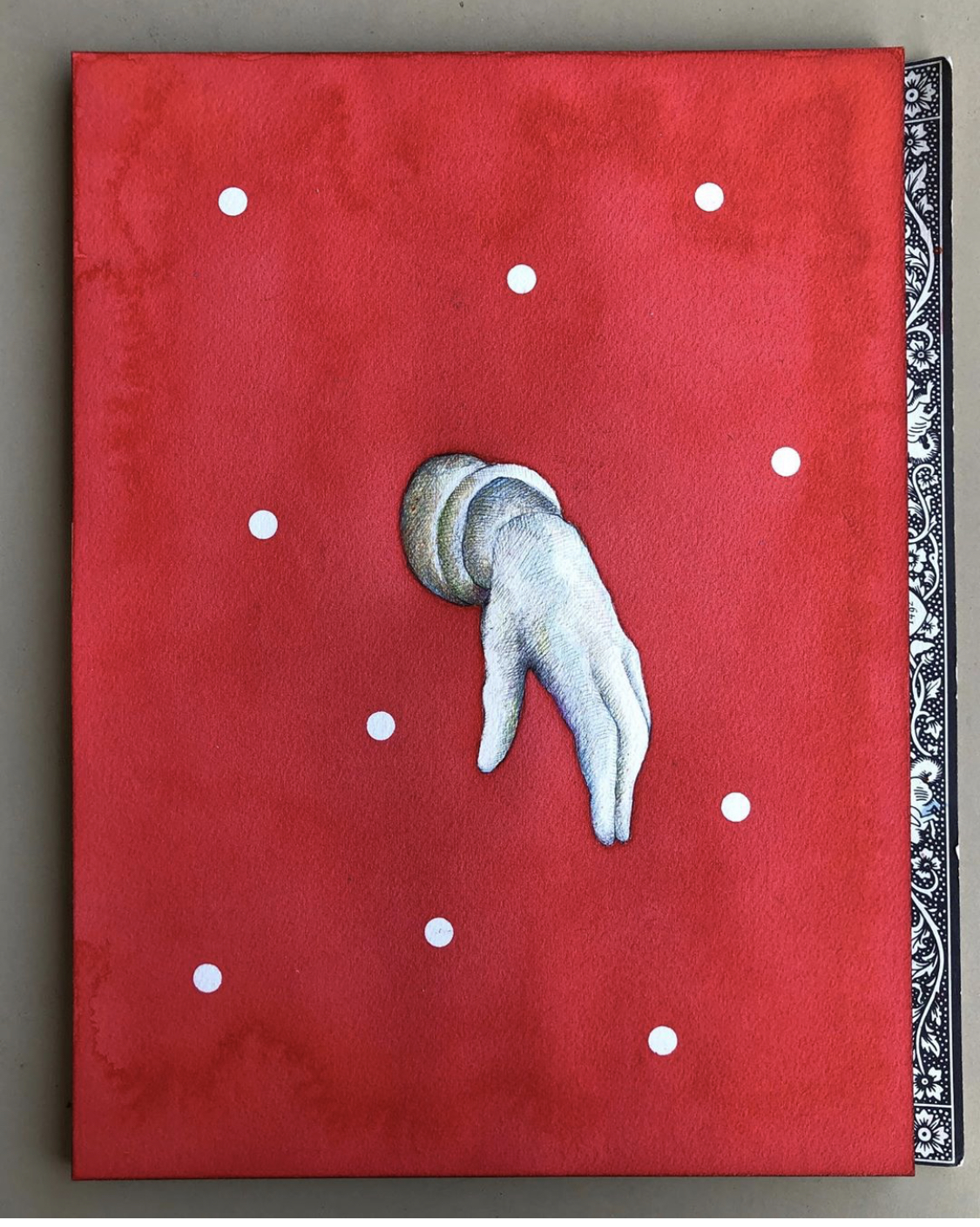
Still attached to the watercolour pad by Paolo Colombo
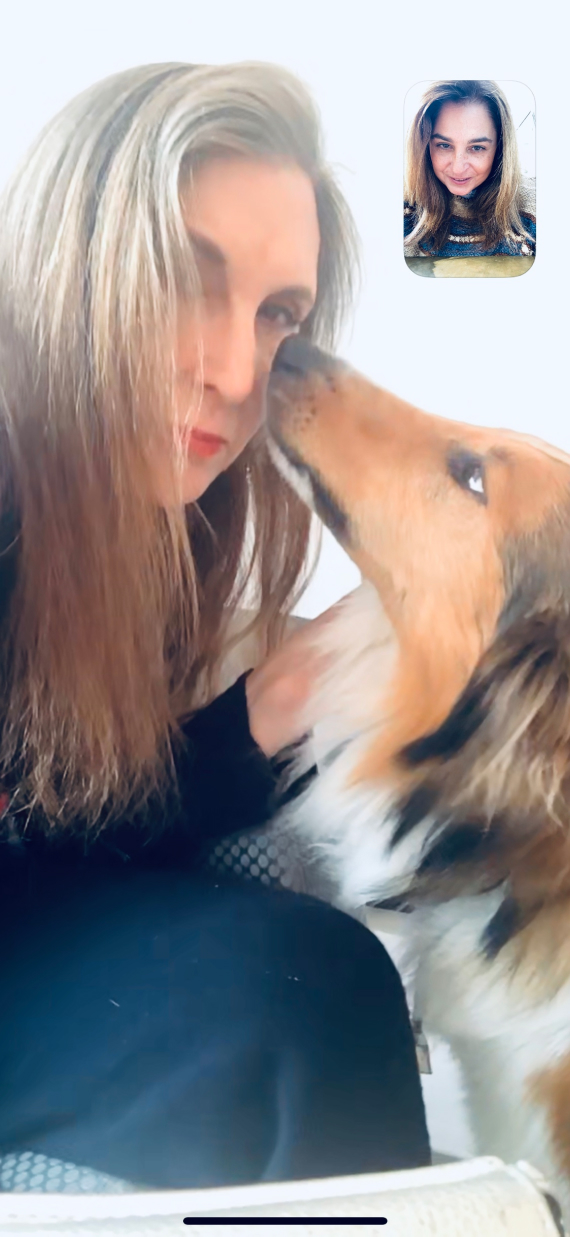
Laurie Simmons
(with her dog Penny)
April 13, Northwest Connecticut, Studio
(Some, not all) artists are used to a solitary life. I’ve talked to friends who say isolation is not that different from the way things are usually. While I applaud their efforts to normalise the situation, I say it’s as different as hell. No one is used to having their solitude controlled. If you live in a small town you might want to go to the local bar at night. If you live in the city you may want to buy yourself something glamorous for no reason, or eat burgers at a diner in the middle of the night. There can be one or a thousand human interactions in a day. After 9/11 or hurricanes Katrina, Harvey, Maria and the California wildfires, people came spilling outside, blinking in the sunlight and hugged each other… Meanwhile, as we see our inner cities being ravaged we are starting to understand that even our isolation is a social and class privilege. I’m waiting to see the impact of all this solitude, which feels like it is occurring in the middle of an unprecedented tidal wave of “connectivity.” So many contradictions, inconsistencies, incongruities to reckon with.
‘Nurses and Dummy’ by Laurie Simmons:
‘Dummy/Mask’ by Laurie Simmons:
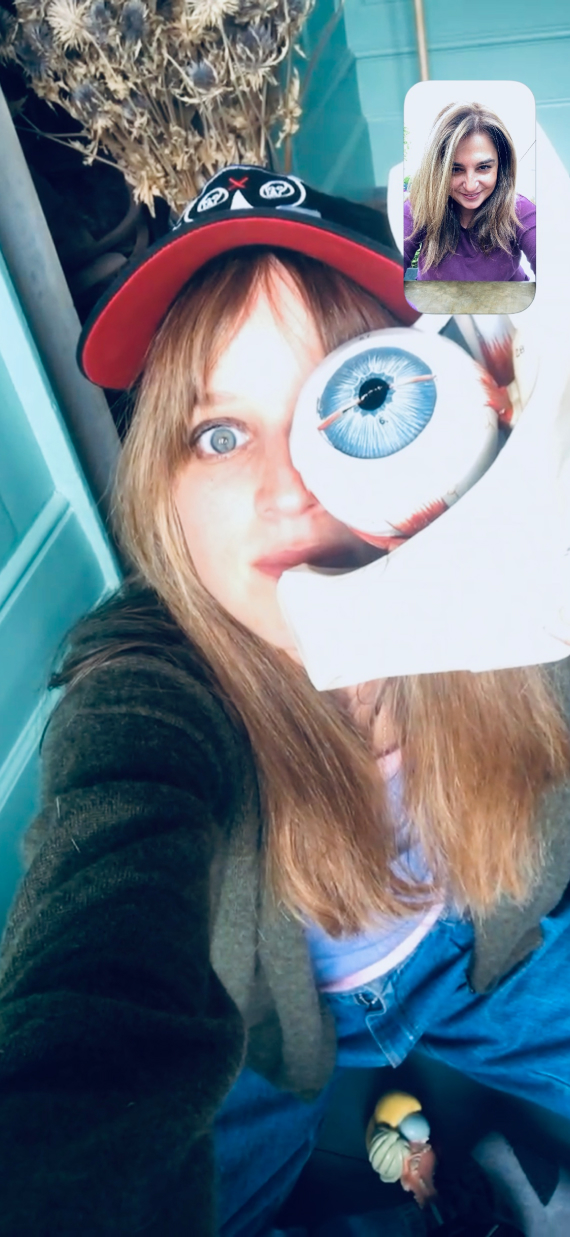
Charlotte Colbert
April 13, English countryside, Home
HUMAN PATHOGEN
You’re it. Or is it me?
Who will cough you to your grave?
Twerking. Live-streamed.
Boils, locusts, gnats and memes.
Exodus, Netflix, Famine and Allergies.
Inequity of souls.
150, 525, 675, 1002, 10 000
Graphs and chickens, bats and ventilators,
Toilet paper politics,
Under the skin semantics.
Did I harm you with that kiss?
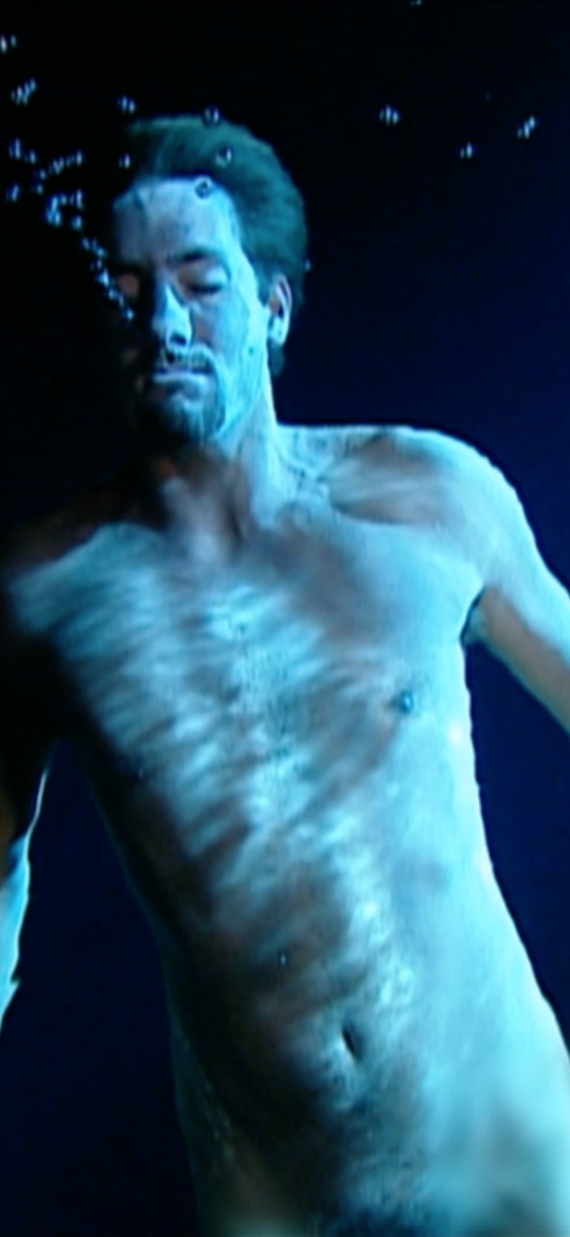
Bill Viola
April 13, California, Studio
The ARTIST OF TODAY represents invisible things.
The basis of my work is doubt, unknowing, loss of
self, and questions not answers.
This will create a sense of never arriving,
and therefore, freedom and liberation.
Bill Viola would like to show his support of the project by kindly providing a link to one of his films: The Messenger (1996).
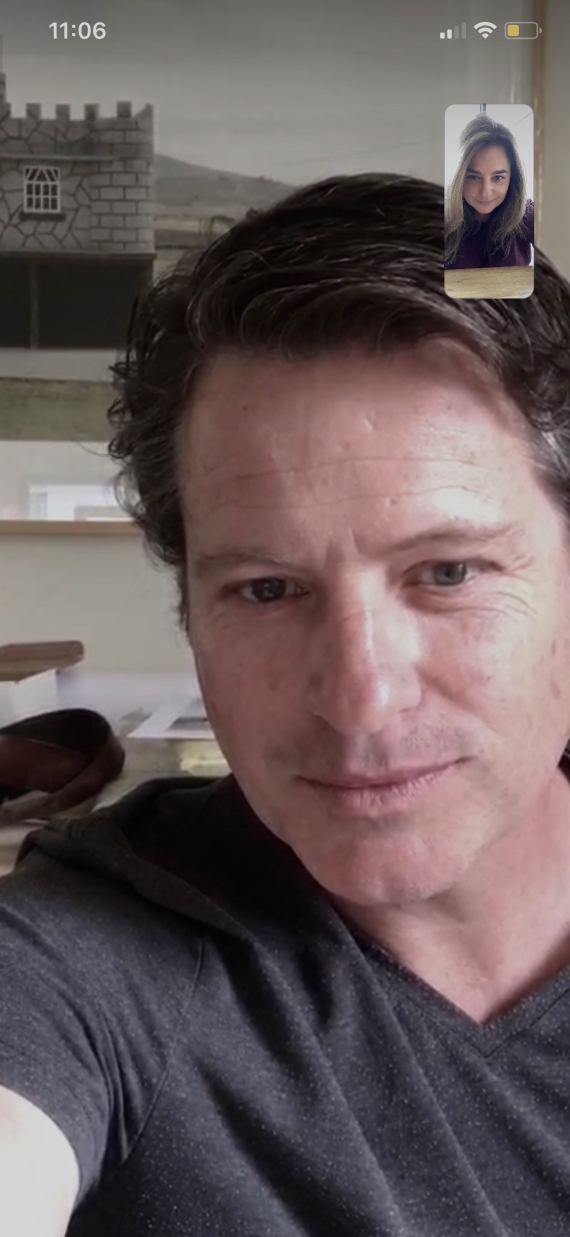
Adam Wiseman
April 13, London, Home
Although we are clearly not all in the same boat (some are much sturdier or in more privileged dwellings than others), we are all weathering the same storm. A storm which, for me, is only evident upon pause and reflection, where my day to day as an artist has suffered little disruption. It is a storm in concept whose effect will eventually seep into all our lives and most certainly make us all pause and reflect.
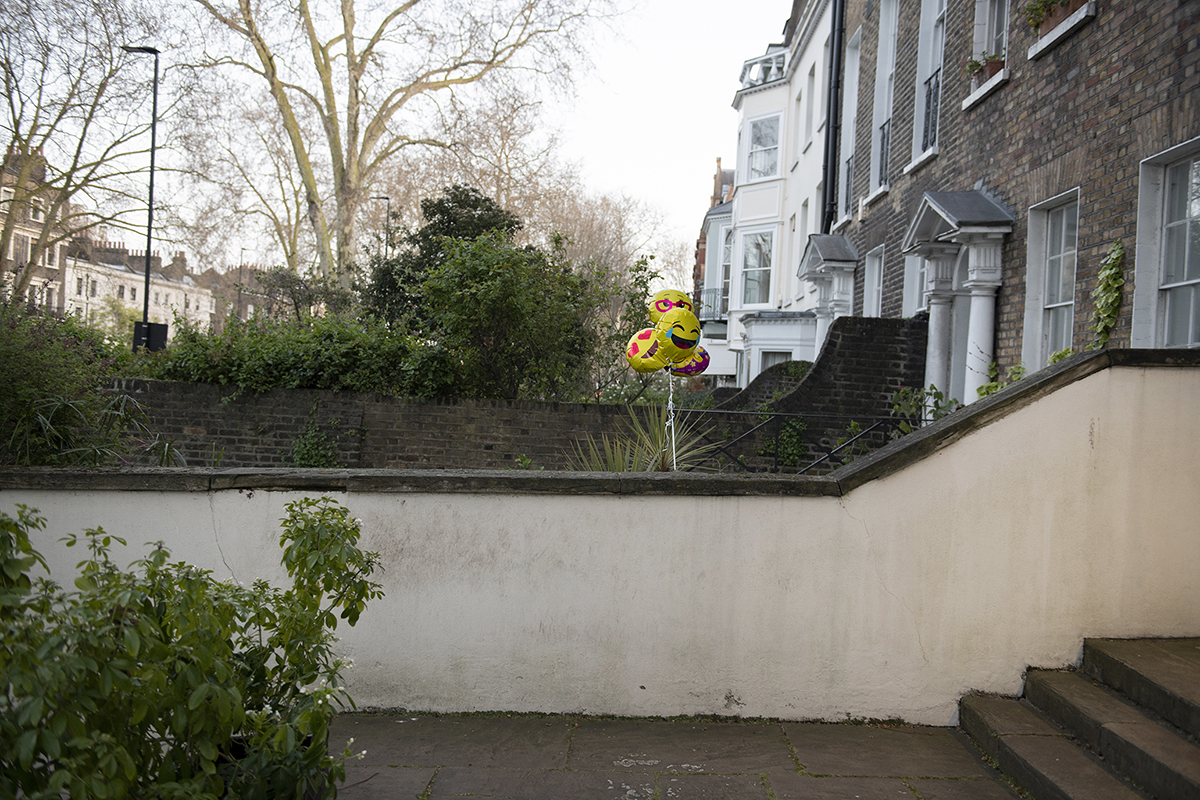
Here is the photo I shot, the first time visiting my sister… seeing anyone in about 1.5 months. It was shot from the front of her house. The muted celebration of a child’s birthday quietly representing our shared feeling of isolation.
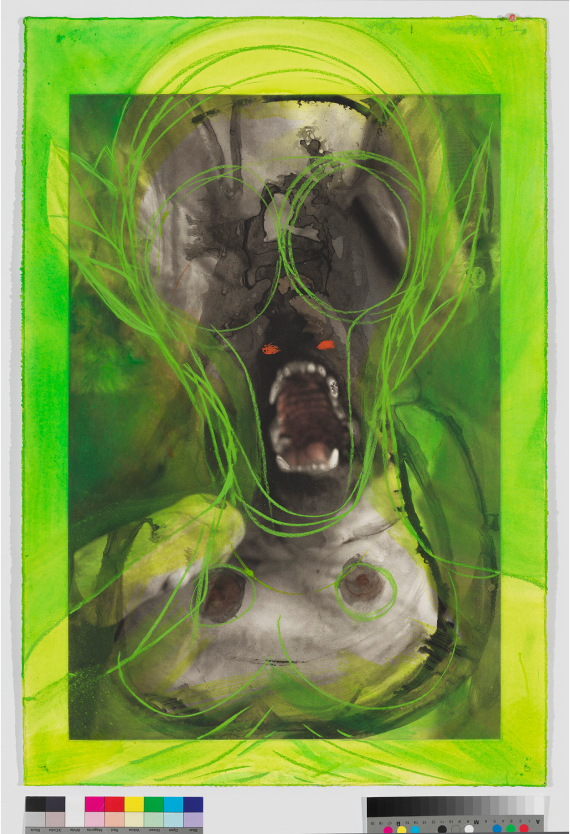
Huma Bhabha
April 13, Poughkeepsie, New York, Home
“…At least not until now — because now, in the era of the virus, a poor person’s sickness can affect a wealthy society’s health. And yet, even now, Bernie Sanders, the senator who has relentlessly campaigned for healthcare for all, is considered an outlier in his bid for the White House, even by his own party…Whatever it is, coronavirus has made the mighty kneel and brought the world to a halt like nothing else could. Our minds are still racing back and forth, longing for a return to “normality”, trying to stitch our future to our past and refusing to acknowledge the rupture. But the rupture exists. And in the midst of this terrible despair, it offers us a chance to rethink the doomsday machine we have built for ourselves. Nothing could be worse than a return to normality. Historically, pandemics have forced humans to break with the past and imagine their world anew. This one is no different. It is a portal, a gateway between one world and the next. We can choose to walk through it, dragging the carcasses of our prejudice and hatred, our avarice, our data banks and dead ideas, our dead rivers and smoky skies behind us. Or we can walk through lightly, with little luggage, ready to imagine another world. And ready to fight for it.” – An extract from Arundhati Roy: ‘The pandemic is a portal’ published by the Financial Times on 3 April 2020
Opposite artwork:
Huma Bhabha
Untitled, 2019
Medium: Ink, pastel & acrylic on paper
Dimensions: 23 1/2″W x 34 5/8″L
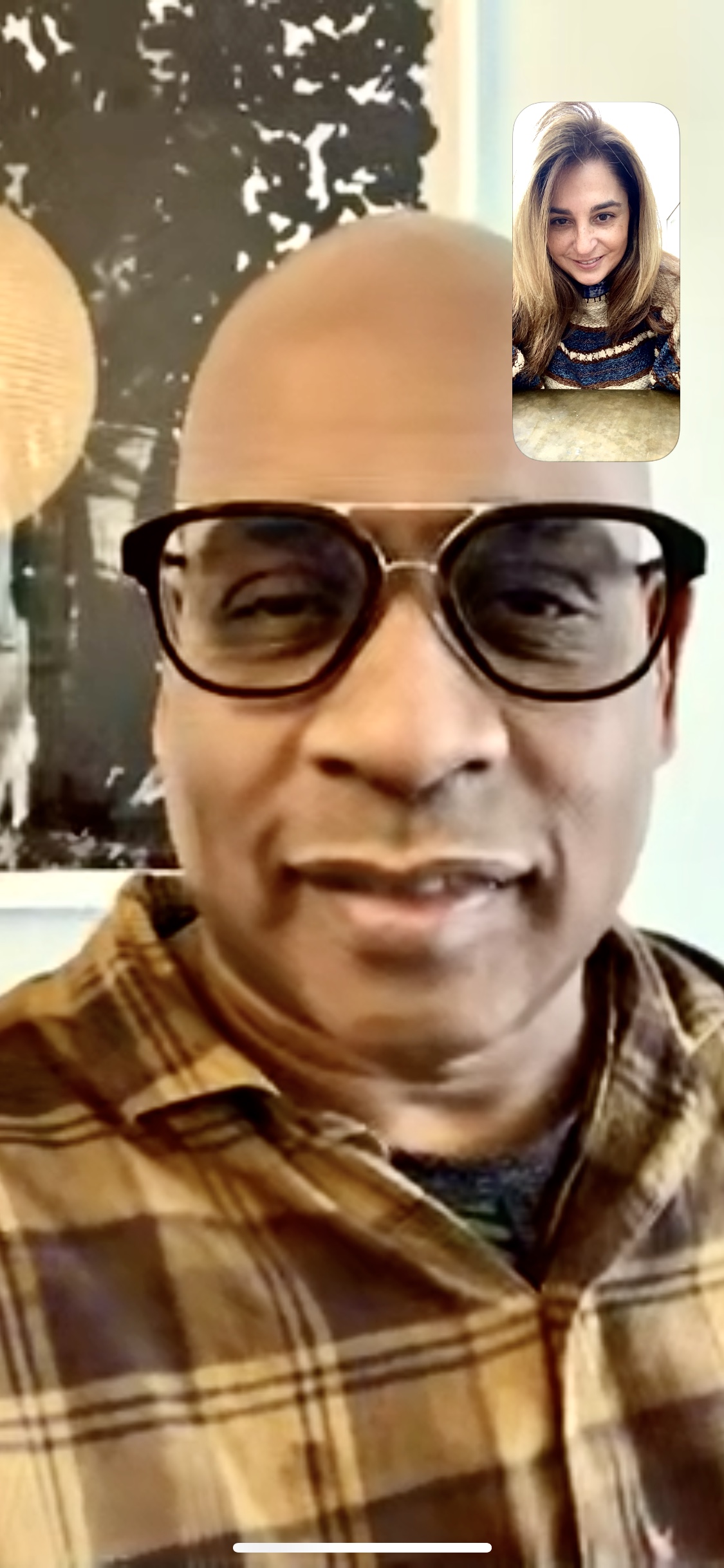
Glenn Ligon
April 13, Hudson Valley, New York, Home
Since I live alone and have been sheltering in place, I have had to learn how to cook for myself.
The surprising thing is that making meals has become the highlight of my day.
Cooking has taught me that even in the middle of a pandemic one has the capacity to learn things, to experiment, to improvise and—dare I say it—experience joy.
This spirit has spilled into the studio, where I am making work that looks nothing like I have ever made before.
Whether it is rubbish or not is irrelevant: what matters is that in response to a new world, one has to develop new skills.

Glenn Ligon, ‘Untitled (I Feel Most Colored When I am Thrown Against a Sharp White Background), 1992. Soft-ground etching, aquatint, spit bite, and sugar lift, Courtesy of Davis Museum, Wellesley College
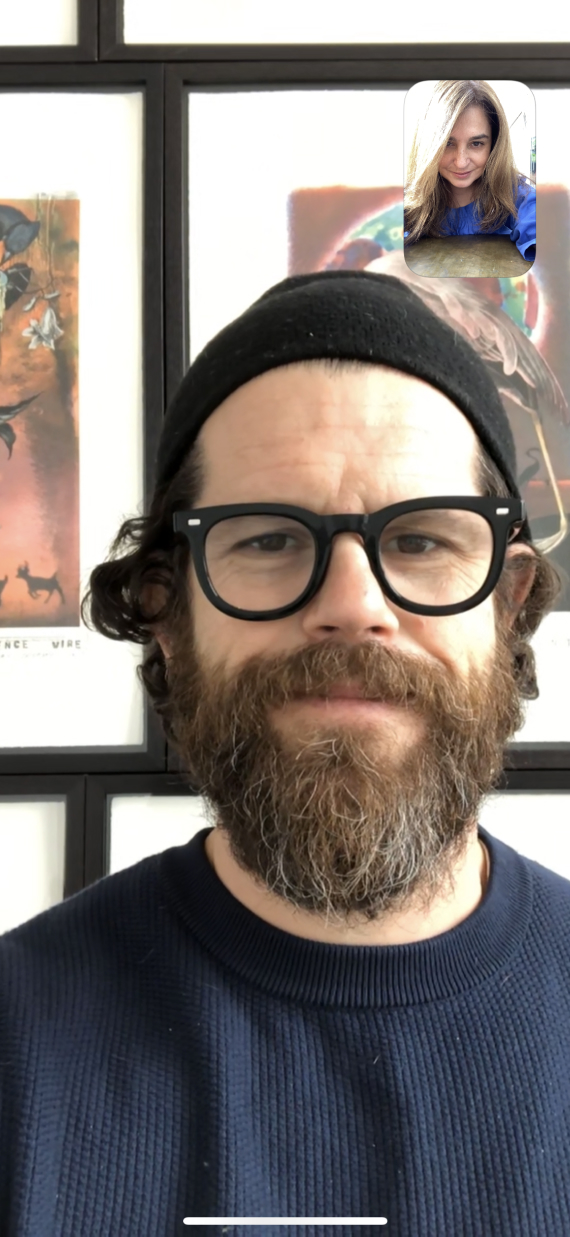
Matthew Day Jackson
April 12, Brooklyn, New York, Home
I am trying to pay attention to the things I will miss when we are all able to see each other again.I consider myself so lucky to know that there will be a great many things. Artists are working and there will be great things to show from this moment and some less great, this much I can guarantee.
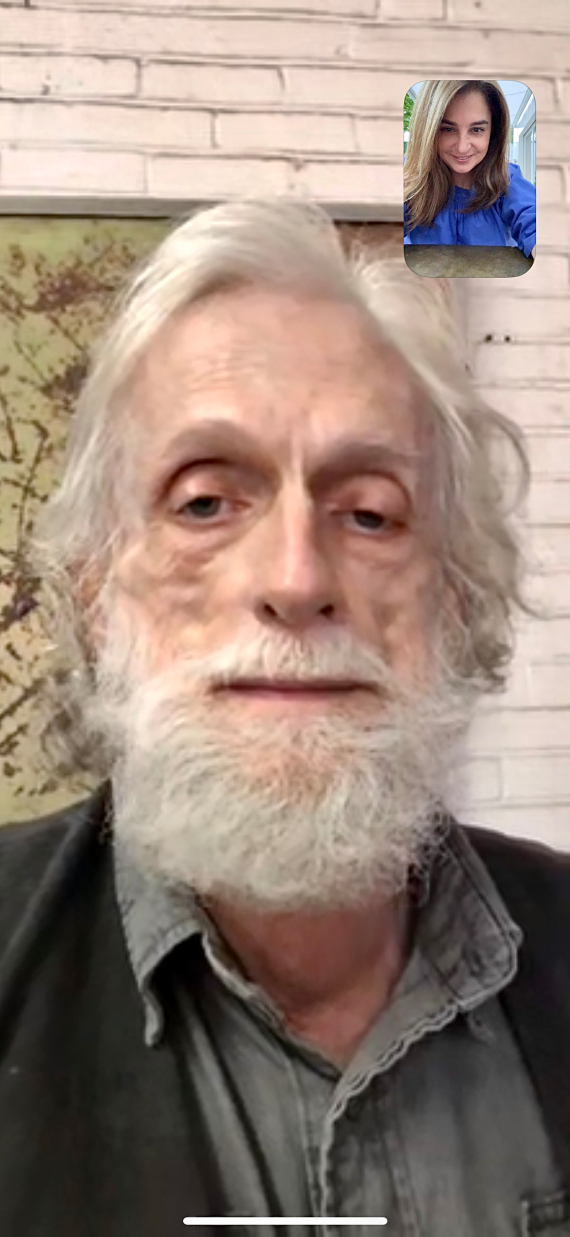
James Magee
April 12, El Paso, Texas, Studio
One rightfully long sentence:
Of course, with the coronavirus upon us, I am afraid if our small crew of four old comrades, including myself, stumbles at this late stage in the game, that is, after nearly over 40 years of working out at the Hill, we might have difficulty finishing the fourth building; and I am worried, too, about the all too mortal voices of family and friends—I could not bear loosing any of them—and so, with a strange sort of silliness, I now find myself embedding colourful glass marbles into the trunks of old trees.
Thanks to Cinco Puntos Press, publisher of Letters to Goya: Poems, Titles and Letters to the Dead.
Written and performed by James Magee, Directed by Edgar Picazo, Commissioned by the Rubin Center for the Visual Arts at The University of Texas at El Paso. Poem copyright of Cinco Puntos Press
‘Paradise Overcast’ – This is an old title attached to a relatively old piece of sculpture, which is in the background of your photo of me. It takes place, figuratively and literally, in a field of alfalfa outside of town. Louie, who is referred to throughout, clearly has gone quite mad, but he sees the wonder of life all about him in his field and, in his own way, rejoices while sitting on his tractor, which may or may not be in good running condition.
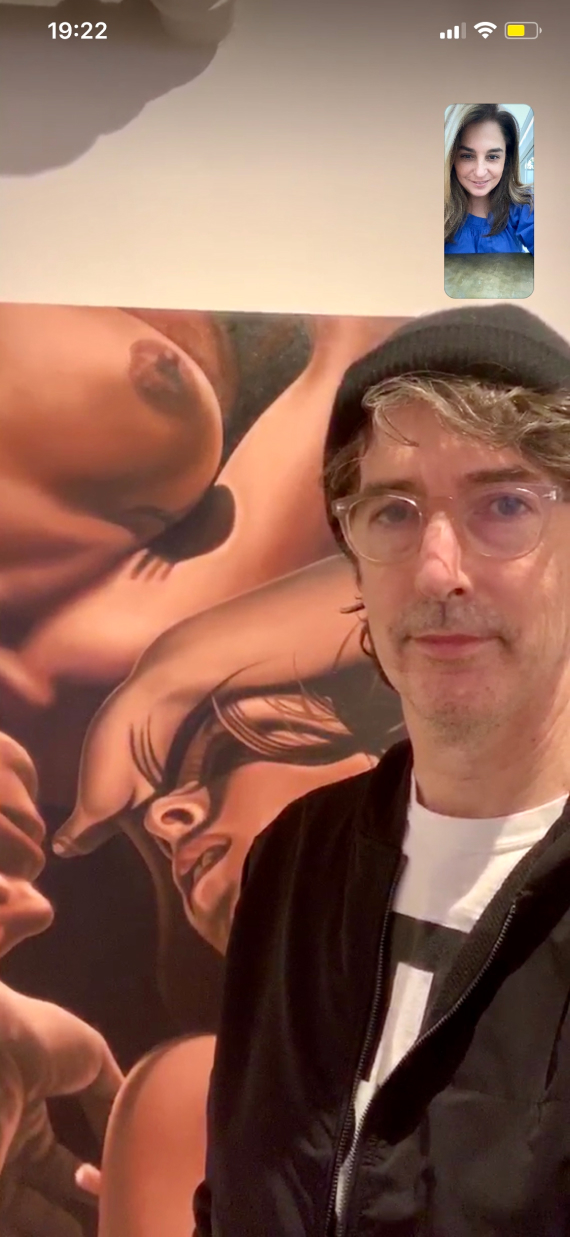
Richard Phillips
April 12, Brooklyn, New York, Studio
I am writing today from New York City where it was announced that more than 10,000 people have died from Covid 19. I have lived in New York City since the summer of 1986 and there is simply no reference to work with in attempting to describe what is happening here. As Covid 19 is now cresting with hospitals stretched beyond their limits with inadequate equipment and preparation, seriously ill people are being turned away who later come back in critical condition. Doctors and nurses are working in dire conditions 24 hours a day, helping the many who are stricken. The streets and parks are nearly empty with only the constant echoes of sirens filling the spaces once inhabited by the gathering of humanity that was New York. Online one reads about the ineptitude of Government at the top level and the struggle that local authorities are having getting critical supplies and funding. Yet, daily there are constant signs of the strength and resilience of those who are here for the duration…Those who are working to keep New York fed and operational on every level from local delis to neighbourhood urgent care to EMT’s Fire and Police…Those wearing masks doing essential work, and those self quarantined and social distanced making sure the curve is flattened. Art seems far away hidden behind passwords in exclusive virtual viewing rooms, or languishing in inboxes filled up with notices and invitations to non-existent art fairs. Having personally spent the last four weeks with the persistent symptoms and ups and downs of a comparatively mild Covid 19 case, while caring for my girlfriend whose had a moderate case, I know that this virus is unlike any I have seen or experienced. It is scary in that once it starts one does not know how bad it will get. I am grateful that it has not so far been bad for me though it’s been quite difficult at times for my girlfriend. We are recovering while in quarantine watching films and cooking all meals at home. Wearing gloves and masks, I walk the dog through desolate neighbourhoods. Runners go by with sunglasses and designer cloth face shields and police cars patrol with LEDs that remind everyone to maintain their distance. Invisibility fragility selflessness and bravery are everywhere and nowhere at the same time.
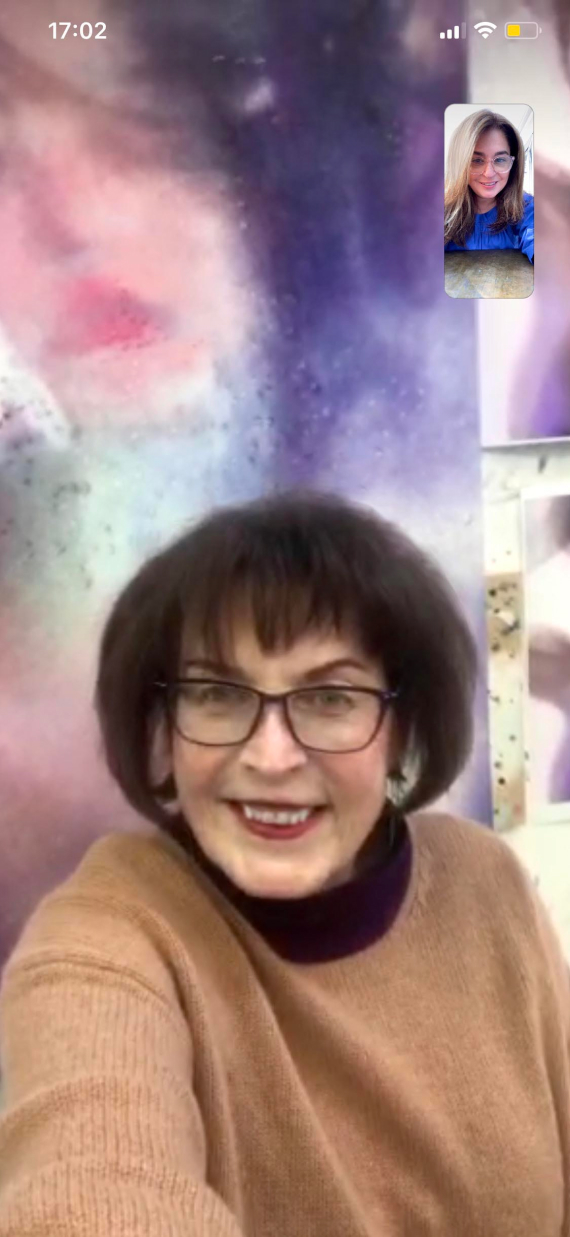
Marilyn Minter
April 12, Upstate New York, Home/Studio
I made this image in Photoshop, it’s called Quarantine — I’m about to start a painting of it. It mirrors what I’m feeling these days about the precariousness of our situation. We just have to take it a day at a time.
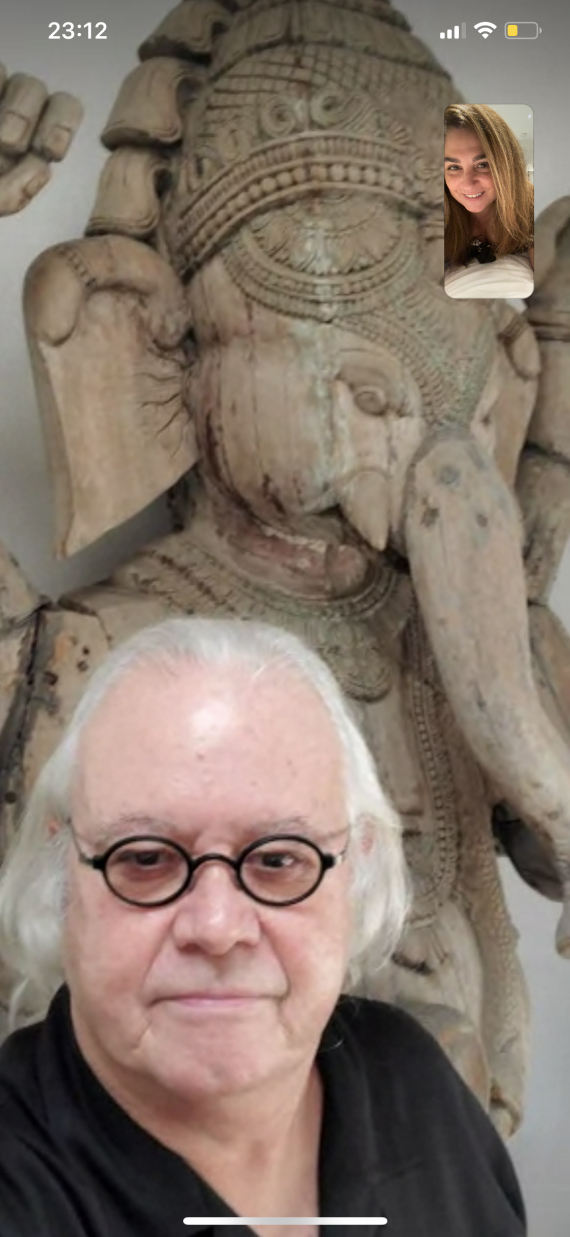
Peter Shelton
April 11, Los Angeles, Home
These blurry weeks have brought a slowly descending dark blanket nestling around my shoulders. My innocence and denial have shifted to trying to keep my head above this suffocating shroud. Emotions magnify exquisitely like looking through the lens of a mist laden spring morning. I’ve always walked around my tiny house talking to myself but lately, I have taken to listening to myself. I am shocked! ‘What? You did what? Peter, that is weird! No! Yes maybe.’ But beyond the gentle nuzzlings of my cats Mickey and Martin Friedman, I’ve received messages from the distant past…a friend or two…could be twenty years ago or fifty. They want to tell me that I mattered to them back then. And still do now. It makes me get up, throw off my black cloud coat, walk outside and stand up in my walled garden. I don’t even bother to put on my pants!
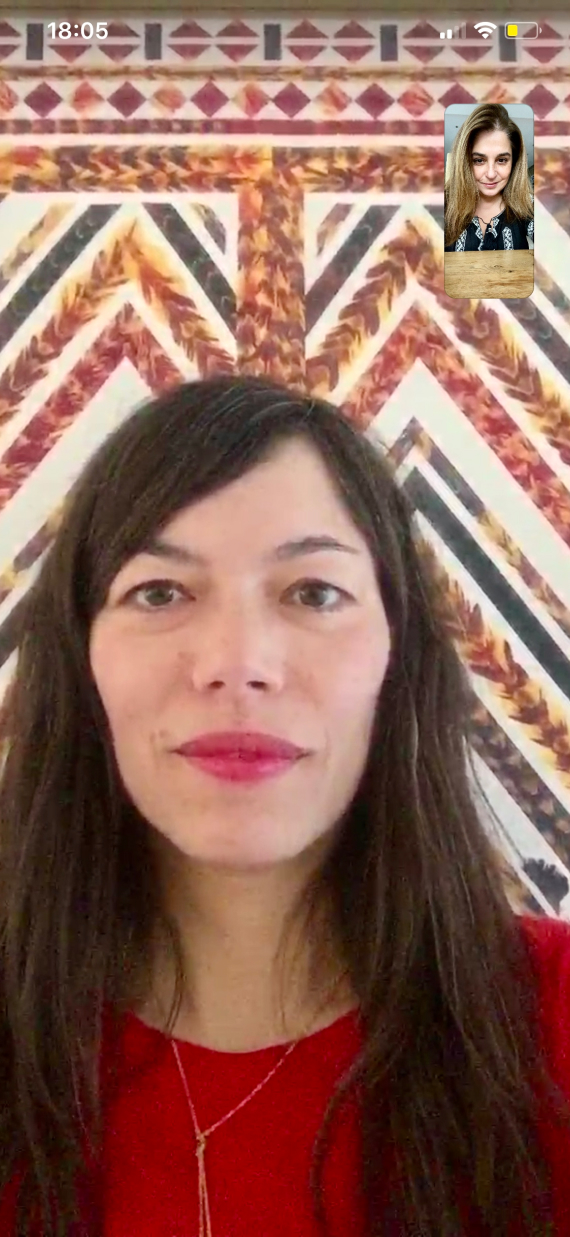
Jennifer Tee
April 11, Amsterdam, Home
The past few weeks I’ve spent at home with my husband and daughter in Amsterdam. We are just trying to do our share by staying home and we hope to contribute by not allowing the virus to spread too fast. I think a lot about my studio, and I hope I can get back to work in some way or another soon. I keep thinking about this sentence from a poem: ‘we are in this with each other, the way the night geese in migration need the stars.’
be well, be better, wherever you are.
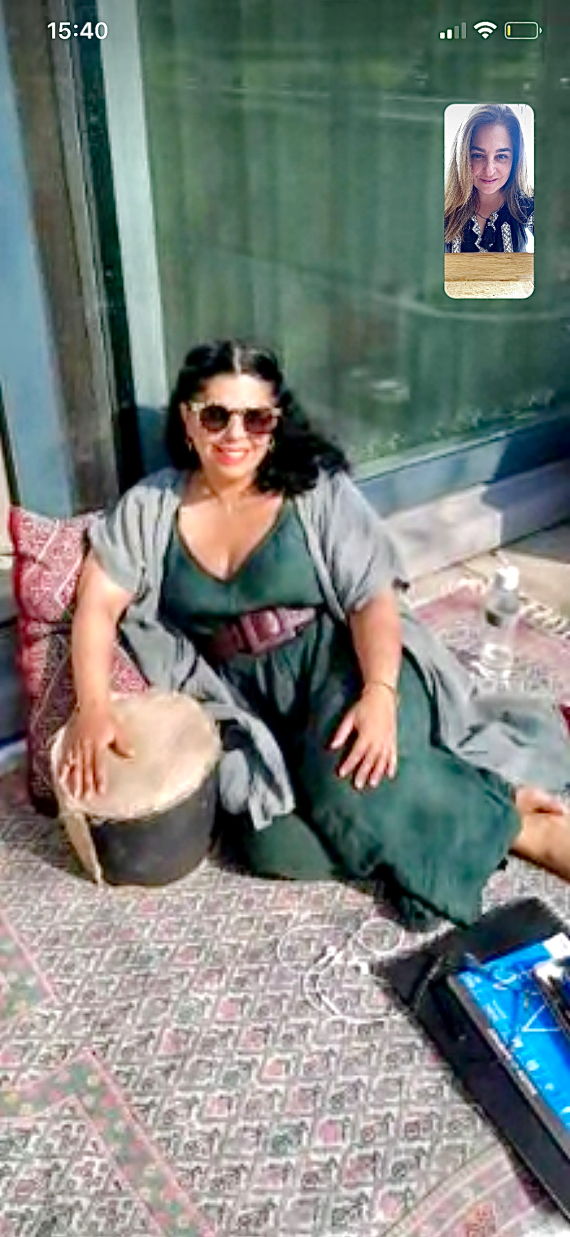
Manal AlDowayan
April 11, London, Home
I have struggled to be creative in isolation, not because of the imposed alone time (I have done residencies that placed me on isolated islands for months). No, what I am talking about is the continuous shifting of timelines, events and fear levels. It is hard to find stillness long enough to create. I hang on to the thought that art will always survive, with or without the “systems” that support it today. I am slowly absorbing that constant adaptation and change will be our new reality. In the meantime, I am focused on staying home, staying healthy and taking care of my family.
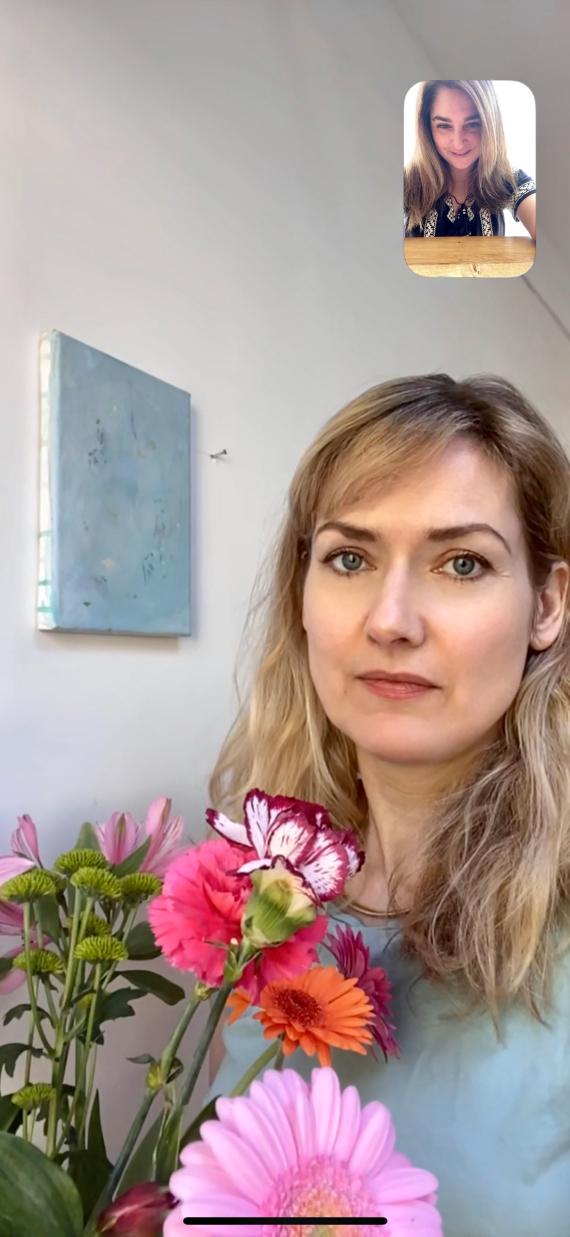
Maaike Schoorel
April 11, Amsterdam, Home
I’m participating in the ‘Biennial of Painting’ at Museum Dhondt-Dhaenens in Belgium this summer. The title of the Biennial, ‘Binnenskammers’, addresses interior spaces – from the psychological to the (a)social, the artist studio to institutional spaces of confinement. In a strange twist, this theme, chosen long ago, now has added relevance in the midst of the pandemic.
The current confinement has two faces: it’s scary, sad and can feel like we’re all stuck in a strange sci-fi movie. At the same time, on a personal level it also brings a much needed pause and allows me to focus on what is truly important. I have more time to walk with the dog, work in the garden, have wonderful phone conversations and notice beautiful details in nature. It creates room and space for ‘inward’ looking. Creativity is often born out of a crisis (on a large, or personal scale).
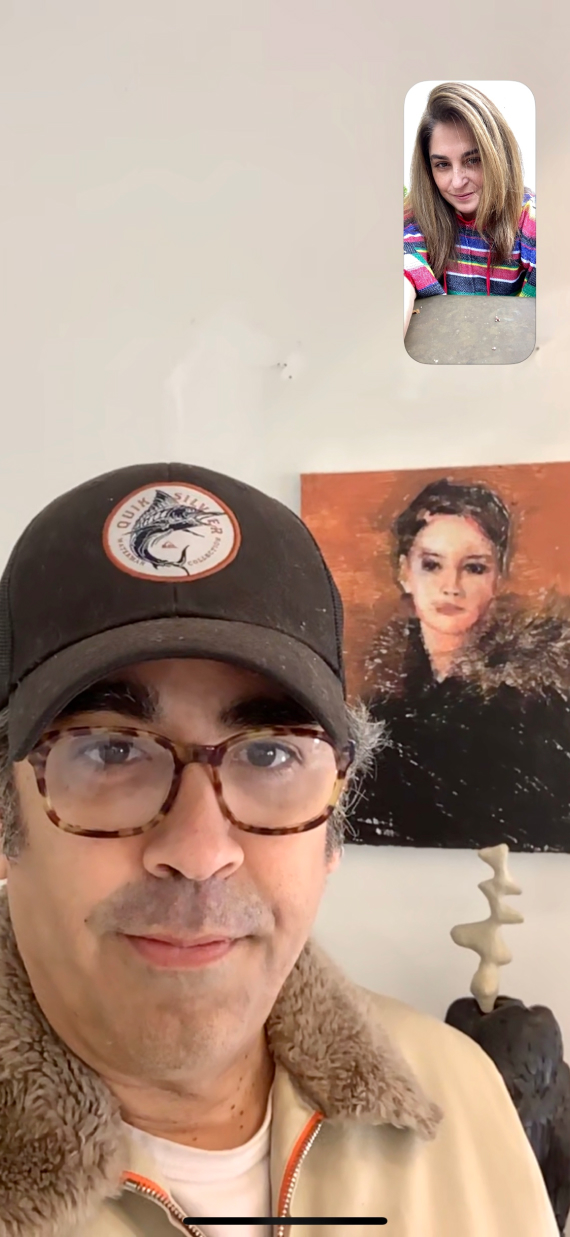
Enoc Perez
April 10, East Hampton, Long Island, Home
I am in self quarantine with my family in East Hampton. Everything is different for us, as for the rest of the world, and we don’t know what’s next, but we are together and that’s our strength. I wish that everyone, but especially those in positions of power would be respectful of science. Listening to the scientists and intelligence experts is paramount for our survival. I also think that the earth is demanding the respect that it deserves. It feels to me like this is a moment of truth. We are witnessing the best and the worst of humanity in real time. Essential workers risking their lives, some for maybe $7.50 an hour. Doctors, nurses and hospital staff are our heroes. Grotesque daily briefings and the false narrative that id promoted… In the middle of a plague! It feels like a very long night. Ignorance, hatred, natural disasters and lies. For me, life goes on; I paint. I make my mark and hopefully, bring that love to others. As for myself, I have all the love right here at home. And I hope that humanity comes out triumphant and better after this.
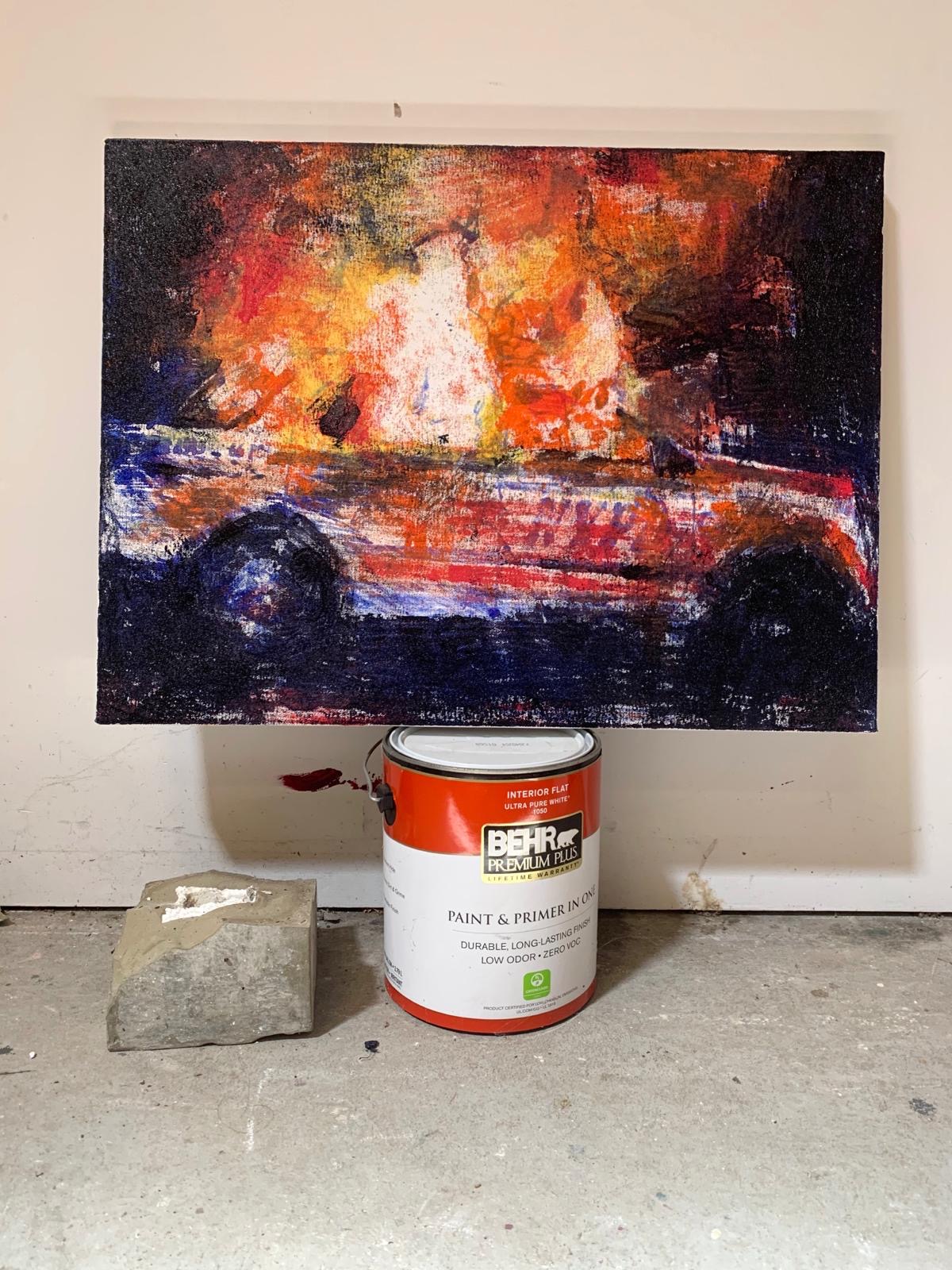
June 2020. Oil on canvas.
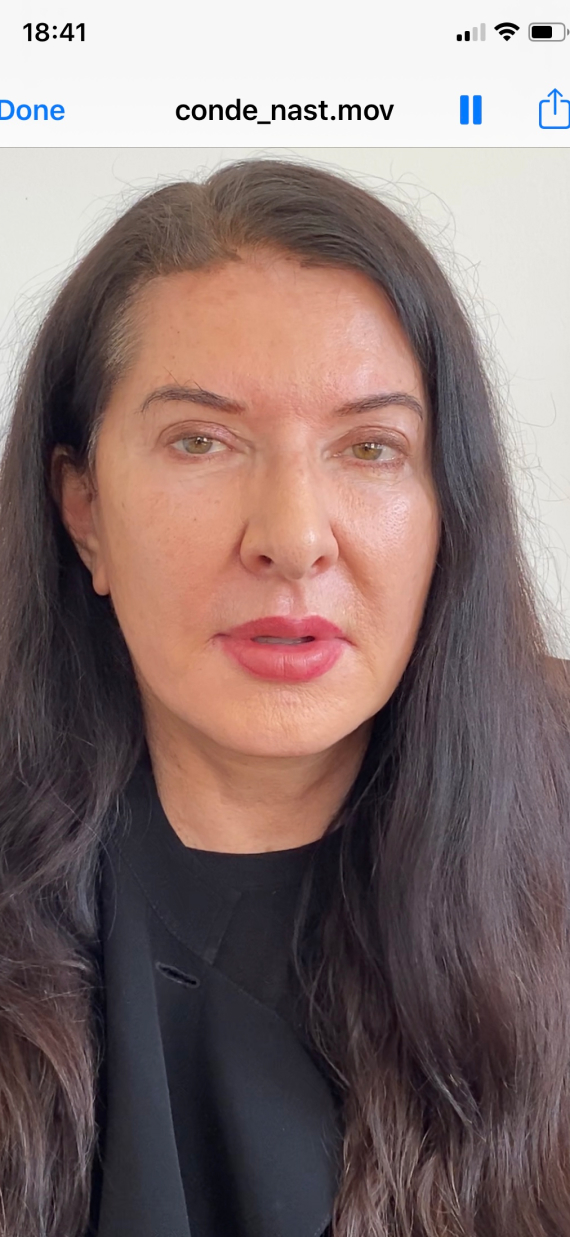
Marina Abramovic
April 10, Munich
Only to change the consciousness of individuals, of every one of us, we can change the world. This is the moment, this is our chance.
Marina has expressed her support of this project by sending a special video message:
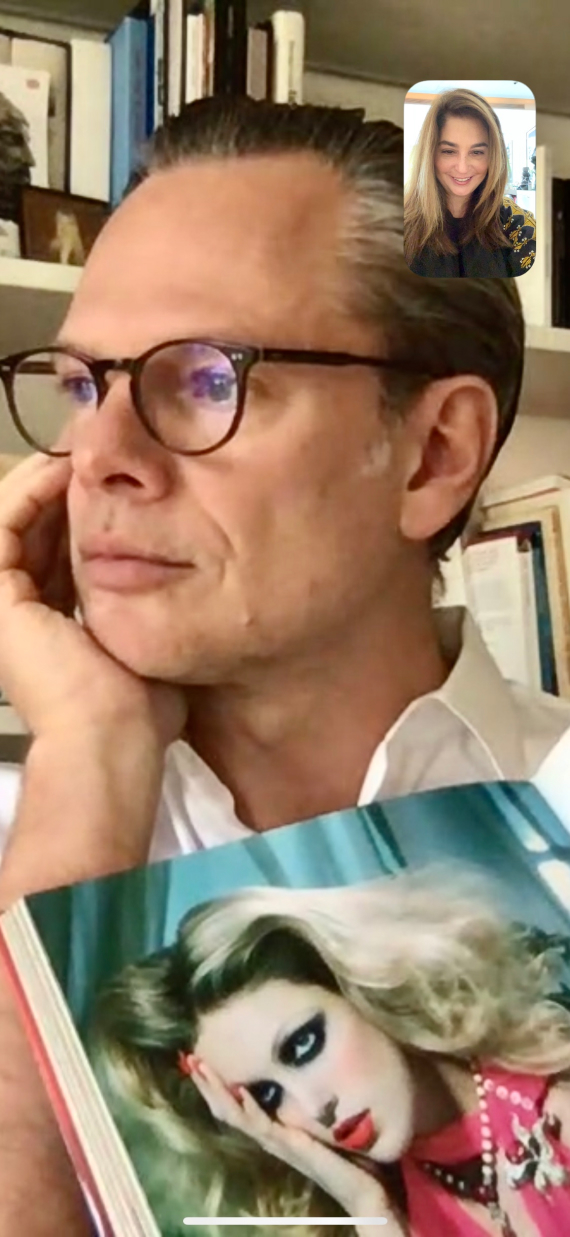
Miles Aldridge
April 9, London, Home
Boredom — Boredom — Boredom
This lockdown is boring. That much was expected when the government announced we would be imprisoned in our homes for the foreseeable future, but what is surprising is how much I have enjoyed being bored. These past days, weeks and soon a whole month, have rolled by in a pleasant and uneventful way; reminiscent of my 1970s childhood where there was never anything to do and nothing on telly. But then, as now, boredom has led to starting a drawing or a book, picking up the guitar, combing one’s hair a different way and thinking new thoughts. As I watch Ocado vans, ambulances and empty buses run up and down the hill outside my window, time itself feels different to life before the virus. The clock is running faster and slower simultaneously.
Miles Aldridge
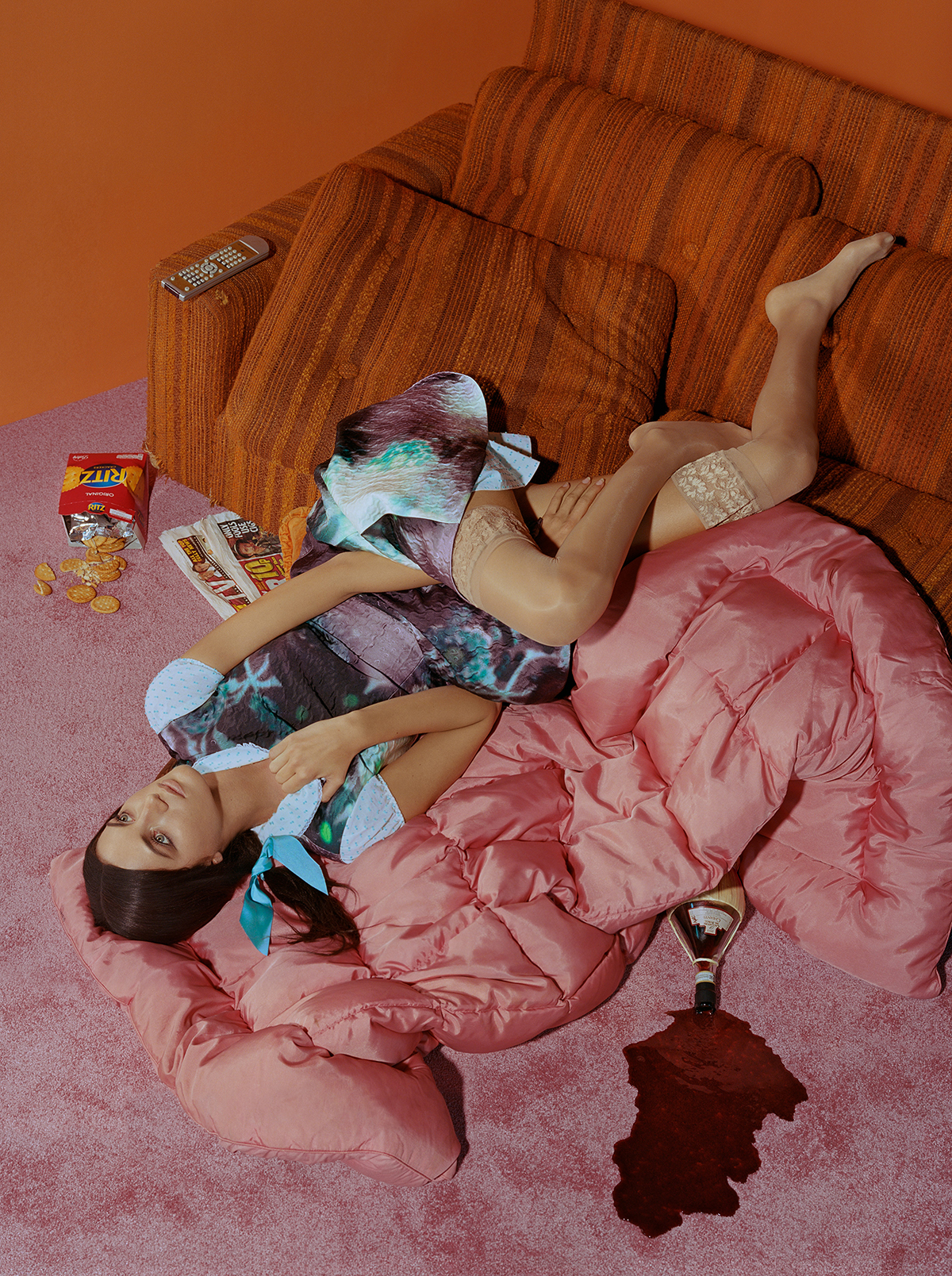
‘Afternoons #1’, 2018, Chromogenic print, Edition of 6 + 2 APs
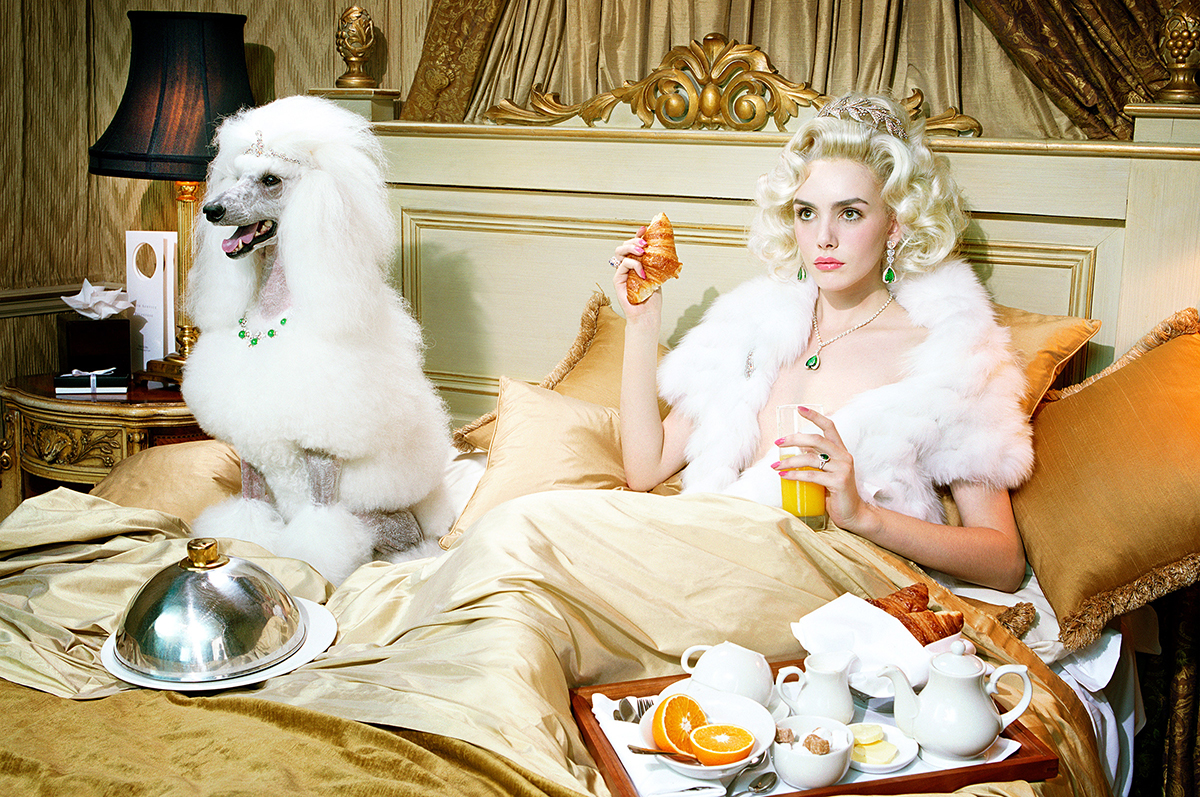
‘Dog Lady #2’, 2009, Chromogenic print, Edition of 10 + 2 APs
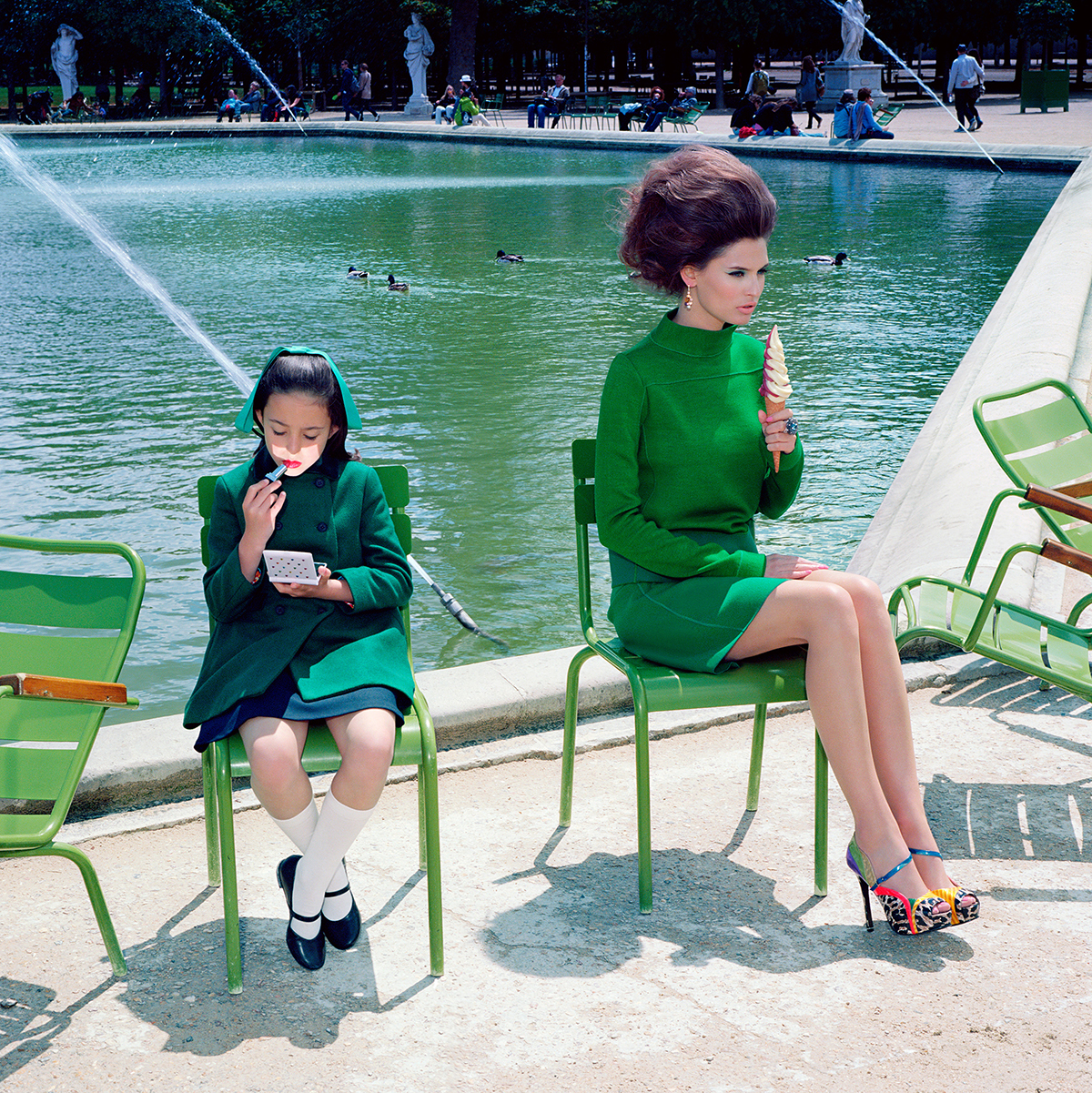
‘A Family Portrait #13’, 2011, Chromogenic print, Edition of 6 + 2 APs
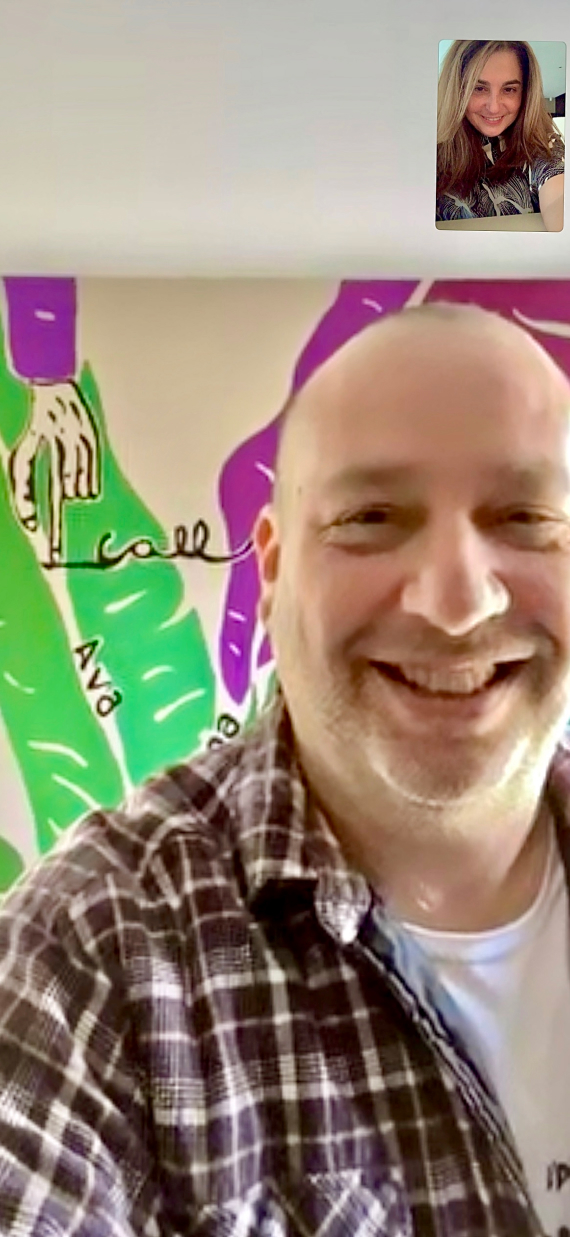
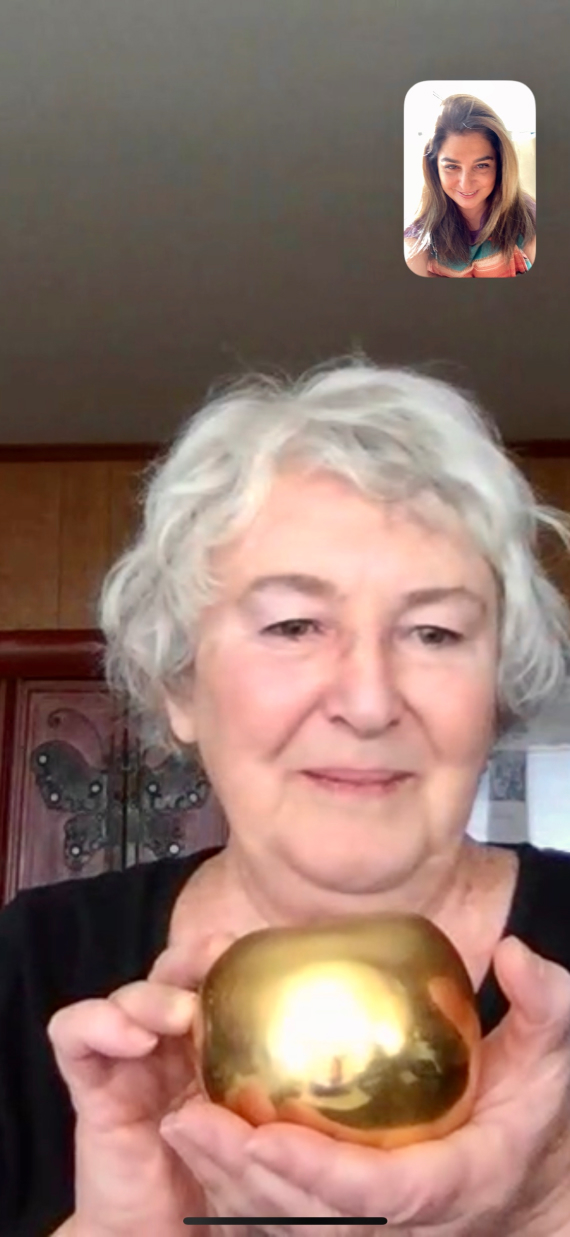
Ilya and Emilia Kabakov
April 8, Long Island, Home
Looks like we all entered the ancient times, sitting in the caves; the enemy is everywhere. These feelings of helplessness, the fears of the unknown are strong, but, surprisingly, not dominating.
We are very comfortable in our “caves”.
And we even have a visual communication with the whole world.
And this communication, the feeling of community, of solidarity with others, makes us stronger, and fills us with hope, instead of despair.
We are all trying to find ways to help people who need help; we bring them food, send donations, do everything we can to lessen the burden of isolation.
We are all in this together, in The Boat Of Tolerance – The Boat of Our Lives.
We share our feelings, our fears, our sense of humour and we know that as long as we are showing this UNITED FRONT to our invisible enemy – we will win.
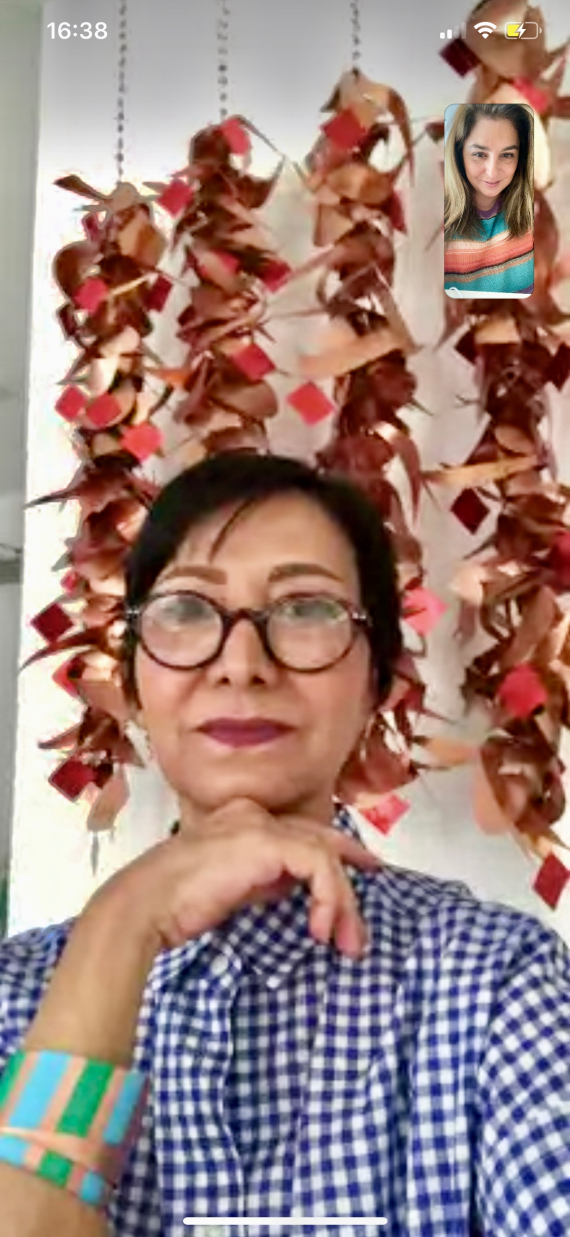
Pouran Jinchi
April 8, Brooklyn, Studio
I work from a studio in Brooklyn, NY. As an artist, my work is solitary. But the isolation now is different from the days before Covid-19, with the separation from loved ones and the loss of any human interaction. And now there is this sense of anxiety and fear with the blurring sound of sirens filling the air as I work. A constant reminder that a life is in danger. The sound keeps me mindful of so many essential workers that are helping us get through this crisis. They don’t have the luxury to stay safe in isolation. These days, I am working on a series of drawings called “SOS,” because we can not forget their sacrifice. My wish for the future beyond this pandemic is to learn to live more than ever with gratitude and respect for humanity and nature.
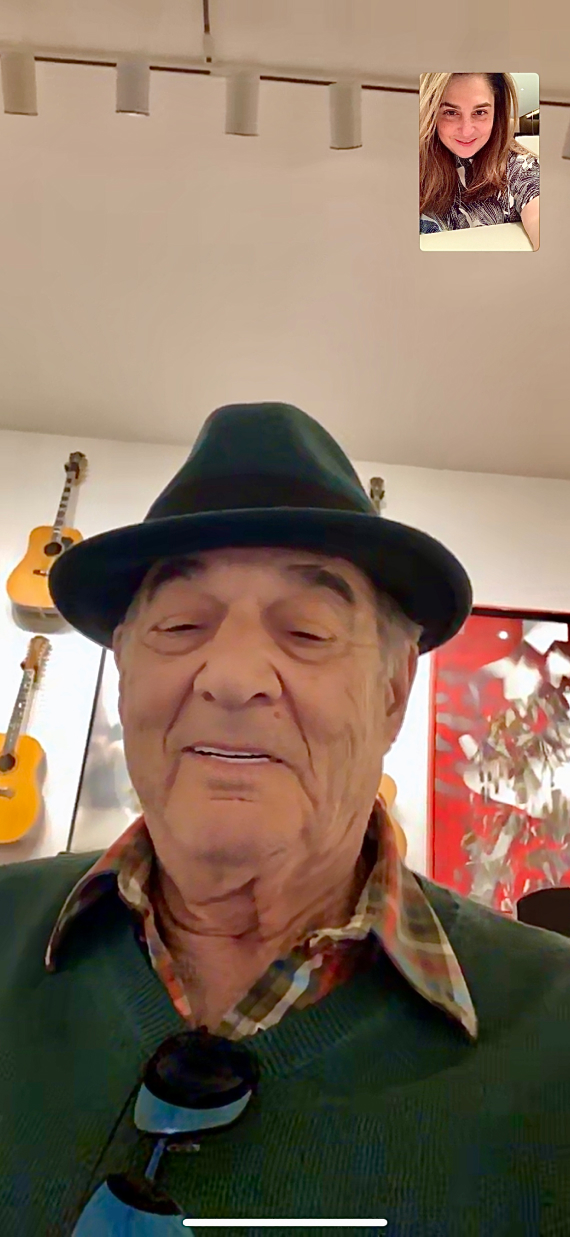
Larry Bell
April 8, Venice Beach, California, Studio
‘In these dreary times, look for sunny days.’ If you are an artist: Keep on Truck’n! If you are not an artist, keep the faith in what you do that is creative. I remember reading on the wall of a public restroom on Interstate 40 in Oklahoma: ‘Have Faith in God-zilla’. The first part was written with a marker, ‘zilla’ was carved in and added with a knife. Which one was more meaningful? Like Charles Dickens’ first sentence in A Tale of Two Cities: ‘It was the best of times; it was the worst of times.’ We are all in this together.
Peace and Love.
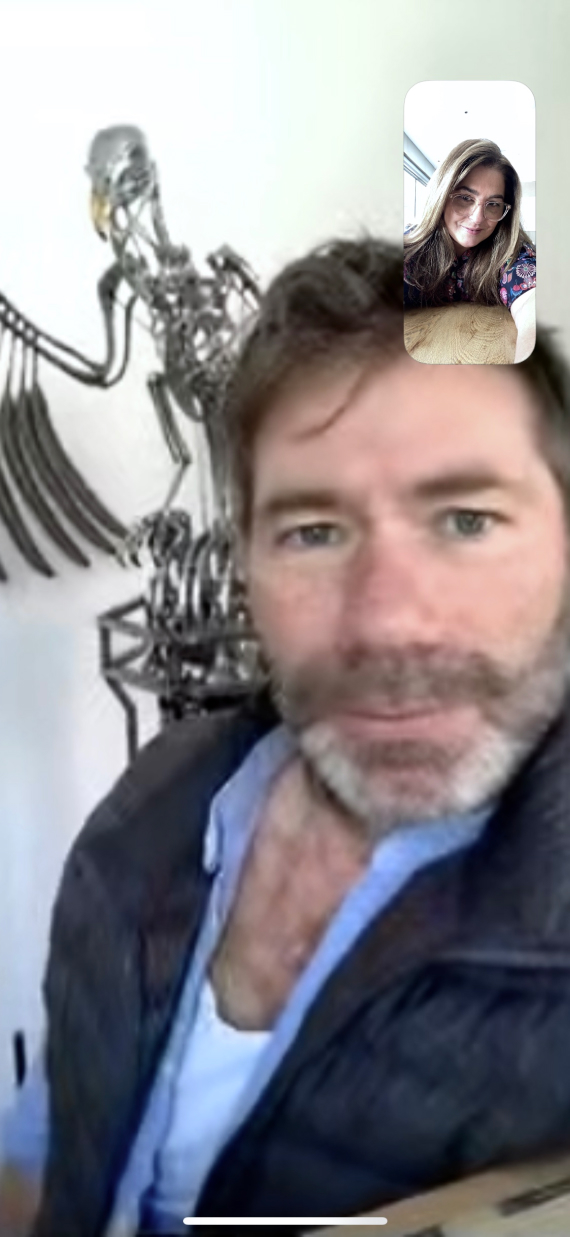
Mat Collishaw
April 7, London, Home/Studio
Before Covid 19 bought a halt to most work, I was art directing a film to accompany Faure’s Requiem. Now, as other planned exhibitions and events grind to a halt, I’m left with this to edit. It is a film set to a Requiem, featuring elderly people fitted with oxygen masks in their final moments of life, more appropriate now than ever, or is it an unsavoury pursuit considering the gravity of things? Whether to proceed is the question I’m grappling with while others with more important jobs do the hard work outside. I can only keep honing as best I can, weaving brutality and tenderness from the inner city, with sublime and barbarous elements from the natural world, and hope the results resonate rather than appall.
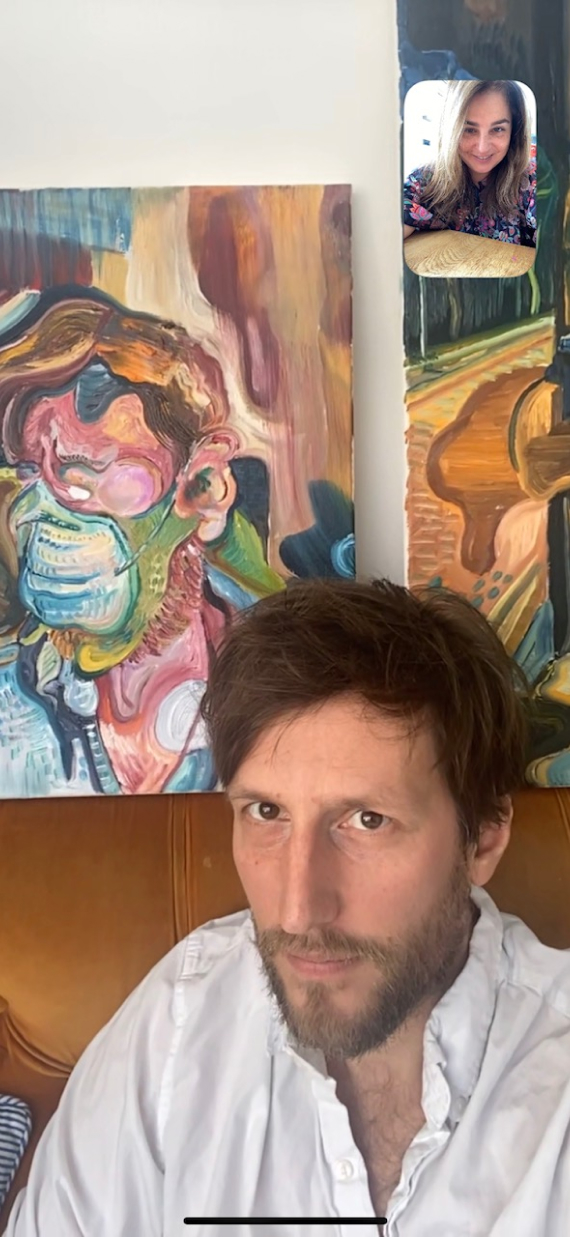
Henry Hudson
April 7, Roman Road, London, Home
I’m painting (or iPad painting) one painting every day, inspired by my one walk a day, in my local neighbourhood in east London. It’s not only a diary of our time, and a very personal one at that, but a way of processing the anger, the sadness, the frustration and the general anxiety that has consumed me and all of us. I now look simply at the people (from a distance) , places and things I have seen every normal day, but now, I look at them with new meaning. I can find some solace and comfort in the immediacy of oil paint, it gives me a direct response and consequently a direct confrontation with the viewer. Only time will tell the latter part. In the meantime, there is no time to stop and think. Only time to work.
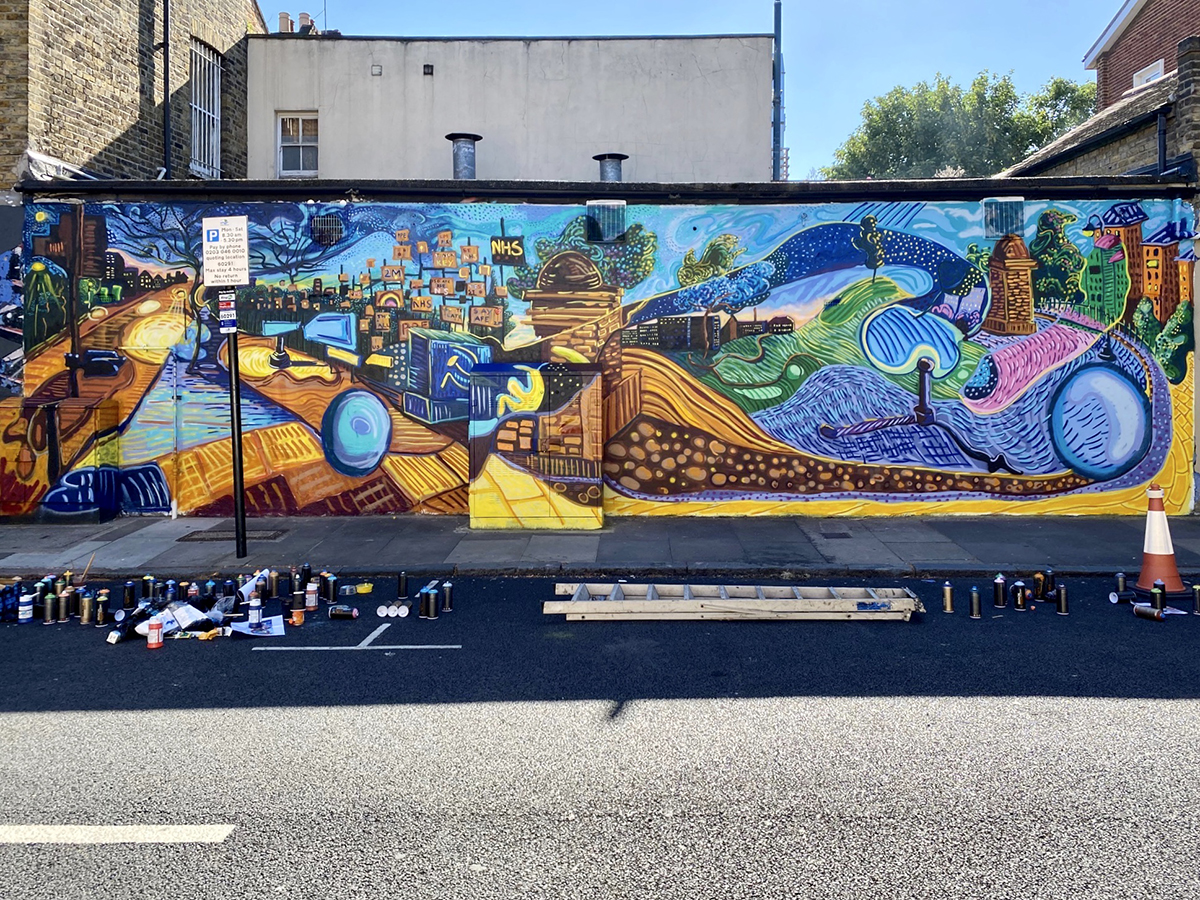
13 meter x 3 meter mural on Zealand road, E3. It depicts at the centre the art work by Peter Liversidge that stood on the corner of Roman road and Grove road. On the eve of April 9, 2020, Peter Liversidge started posting a series of hand painted signs at the entrance to our local park, honouring health care workers fighting COVID-19 and raising awareness around safe practices. I myself during this Lockdown period had been making oil on canvas works inspired by the local area, making note of signs, protests, council blockades, medical guidelines and street art. Notably around the park as that was my refuge during my once -a -day allowed walk in nature. I didn’t know Peter was the artist until I started working on this mural, so I planned to keep his message alive…a little longer.
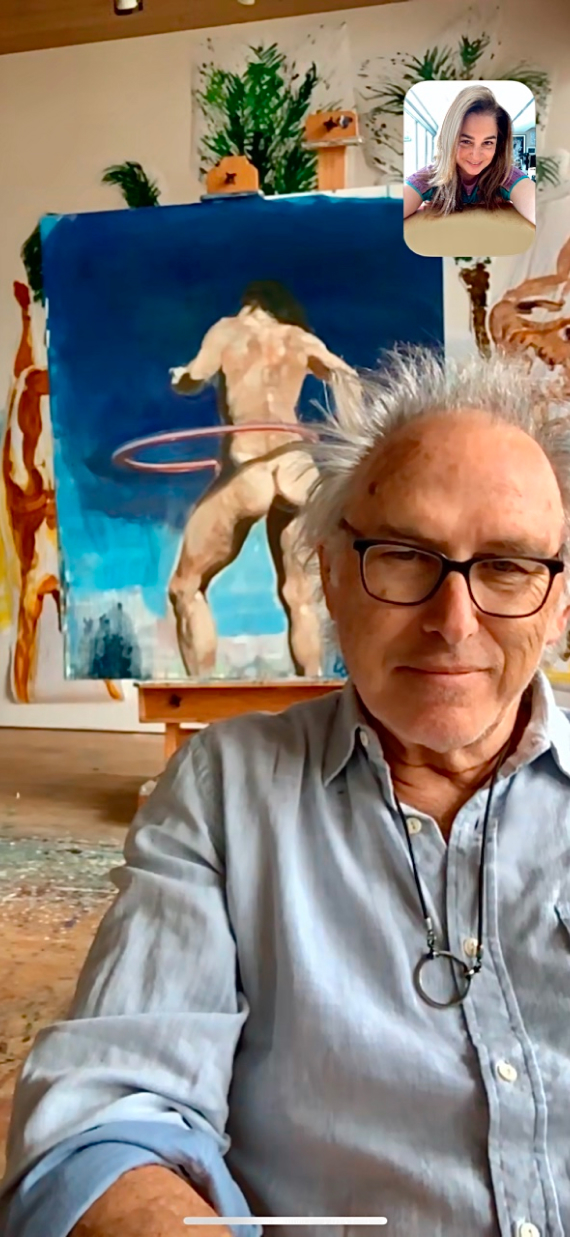
Eric Fischl
April 7, Long Island, Studio/Home
Because I’m used to spending time alone in my studio, quarantine has not presented too big a disruption. However, what enters the studio while I’m working or daydreaming are phantoms of a different sort. They are the demons of Hope and Despair, and they are wreaking havoc. Hope shows up as a two-headed monster: Sentimentality and Nostalgia. Despair slips in with his sidekick, Inertia. The days go by and even progress. My paintings start out light and grow darker. I try to retrieve what light I can without being dishonest. The truth is, no one wants to be where we are right now, but we are here and I believe this is where art and artists must stay, facing forward, dug in and willing to bear witness to our fears, vulnerability, bravery and resolve.
Paul Simon once wrote that sentimentality was aiming for the heart and missing.
Alberto Manguel wrote that entertainment was a second-hand experience of the world; learning without action and fulfilment without accomplishment.
This is the wisdom that is guiding me now.
Eric Fischl
Stay healthy. Stay safe. Stay away from me

Sheree Hovsepian
April 7, East Hampton, Long Island, Home
So many decisions are made for us these days. We have to learn to surrender and live within these confines for the sake of self-preservation. I am not feeling particularly creative or in a working mode. I am bearing witness, and that is enough.
Sheree Hovsepian
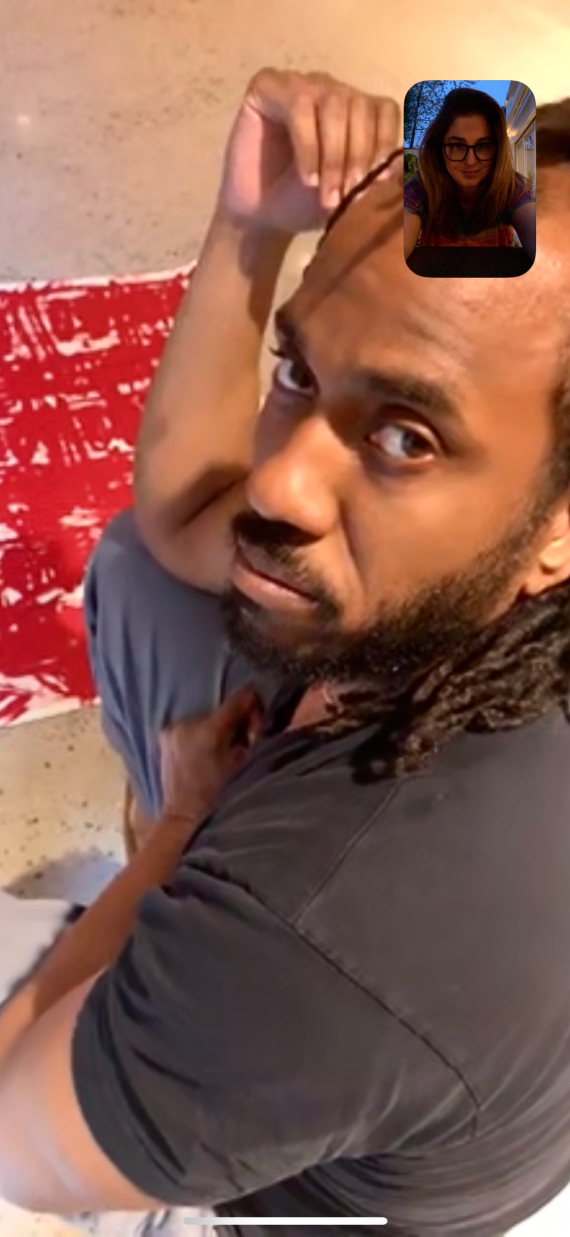
Rashid Johnson
April 7, East Hampton, Long Island, Home
A current state of mind.
I am feeling anxious but I am also feeling optimistic. I don’t want to be motivated by fear. My preference is to be motivated by love. I want to send that love out to all those who are sick and suffering.
Rashid Johnson
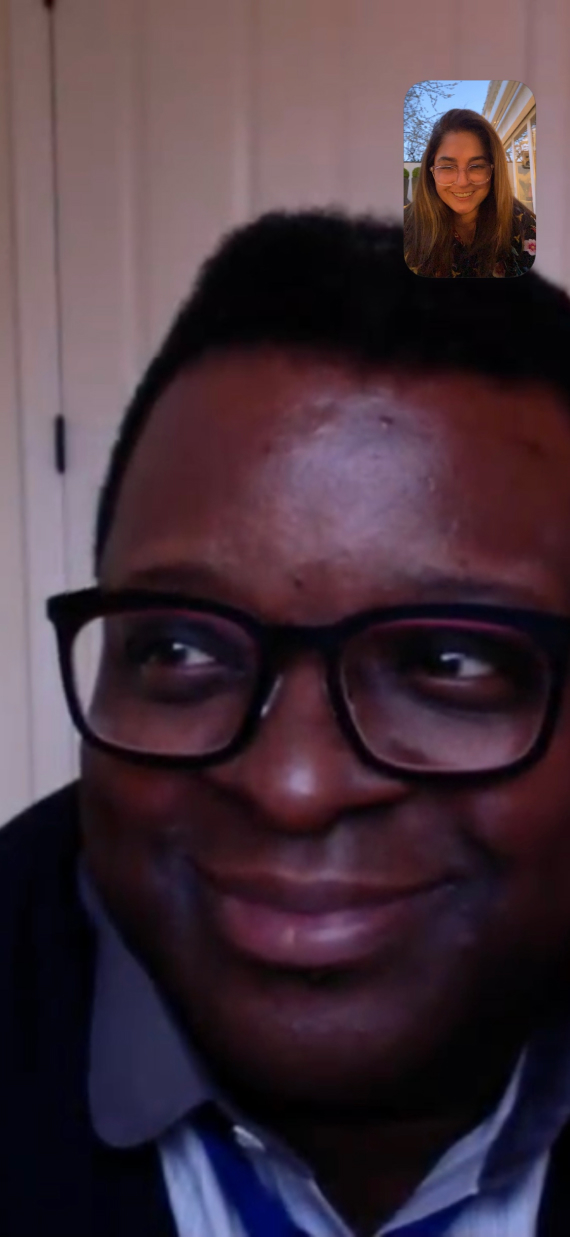
Isaac Julien
April 6, Santa Cruz, California, Temporary Home
These are challenging times and the future is abstract. What is for certain is that there will be radical shifts across the board, the art world included. And it is our responsibility as artists to take measured steps in order to make sure that the art world does not collapse. The key is to support our museums, the principal holders of our collective cultural memories and to ensure their sustainability as well as the preservation, conservation and circulation of our mutual practices. And for that, it is critical for us all to stay connected. The activist in me will make sure that I will fervently contribute my part to this endeavour.
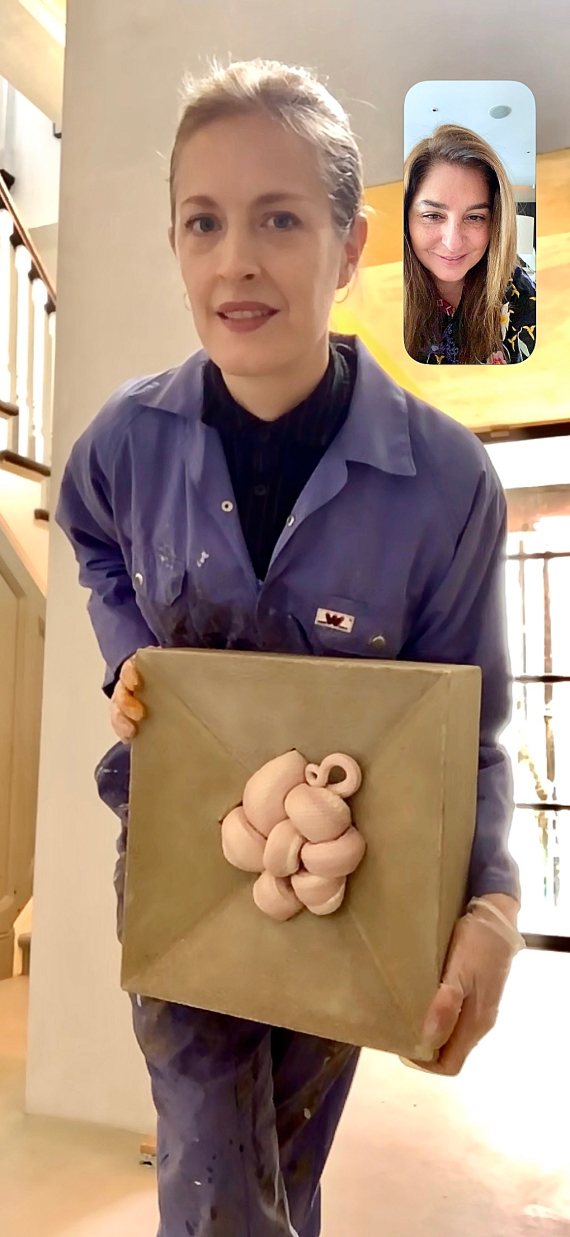
Polly Morgan
April 6, London, Home
I have the right profession to thrive in lockdown. Being an artist is the closest thing to training for self isolation you are likely to find. So I’m feeling very fortunate, to have a studio full of materials to entertain two restless tiny children and the imagination to do so. If this is the new currency then suddenly I am rich.
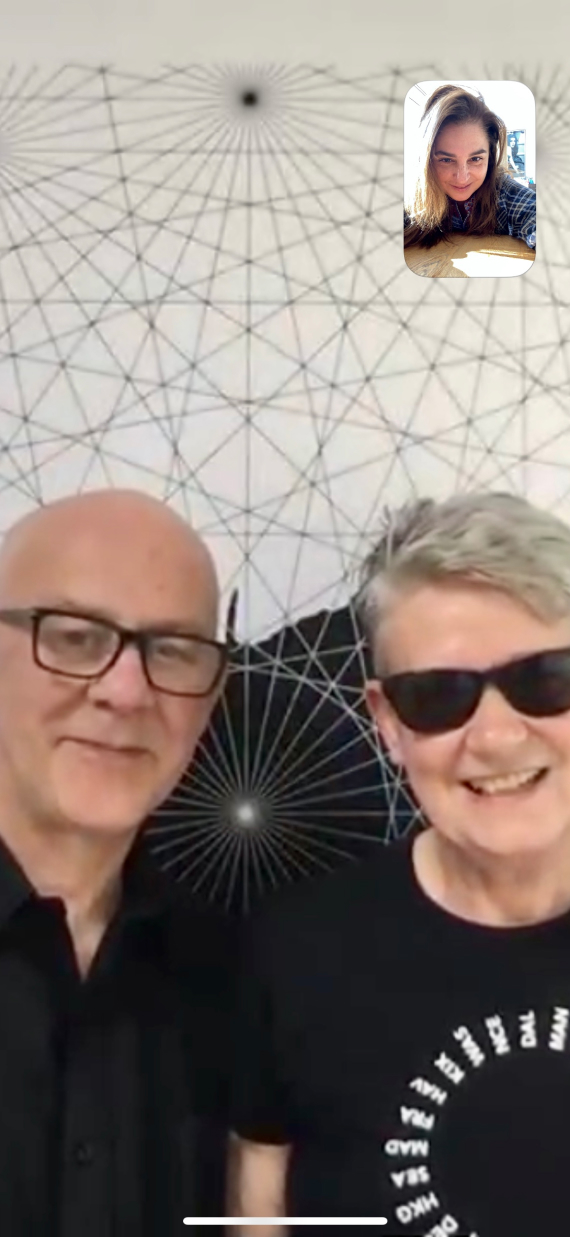
Langlands & Bell
April 5, London, Home/Studio
Globally, we’re in this pandemic together, but it’s different for each of us. It underlines how interconnected and interdependent we all are and reminds us of the true value of human connection. We really need each other, not just to survive, but also to have a meaningful life.
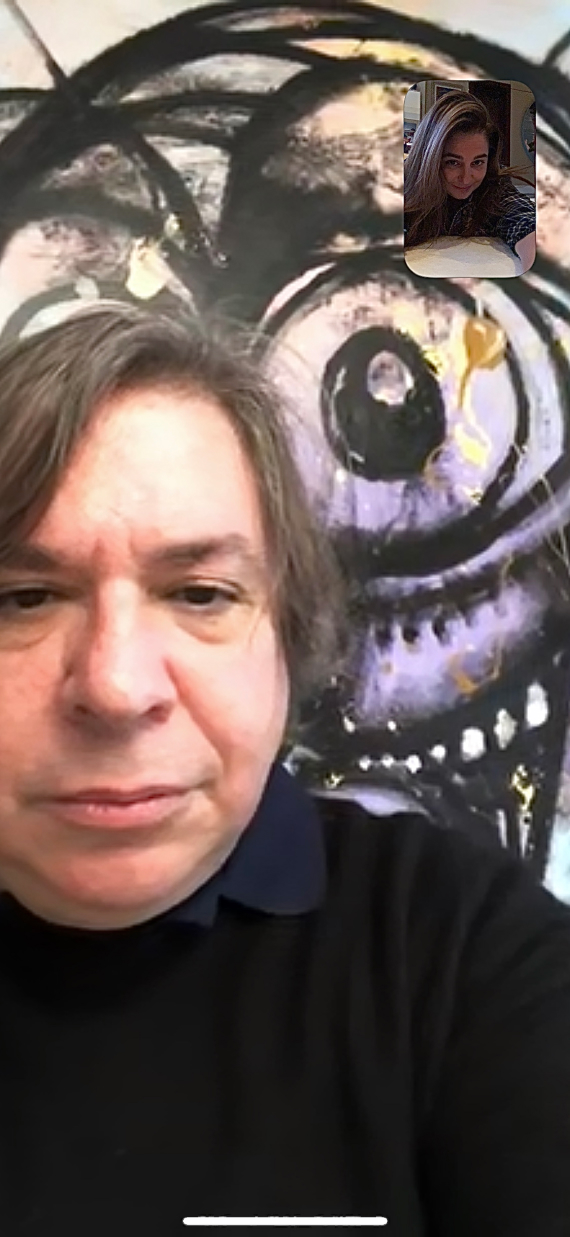
George Condo
April 5, East Hampton, Long Island, Home
Reflections on the way the world never was and never should be, lent itself to inventing a new one. This new world is an existential cage brought on by the fear of a contagion. Unless you turn the contagion into a creative device and think back to when you could just be left alone to yourself…no iPhone, no email..a house line and a stereo system, some paint, pencils, paper and canvas, only the best of friends and deep emotional feelings that you could share intimately …you will go mad with anxiety…now, it is about putting those feelings and memories in a safe place, and hoping for recovery to all who have been struck by the virus…and to pray to something that will keep the health workers and everyday people safe and alive. Art heals, but it has not yet cured cancer or any other disease… it’s something to experience in various intangible ways, but has not proven to have a medical impact on pandemics that I know of… Regardless of that, I still believe it can save lives in other ways…it can be an awakening from the void into a new reality that stays with you forever.
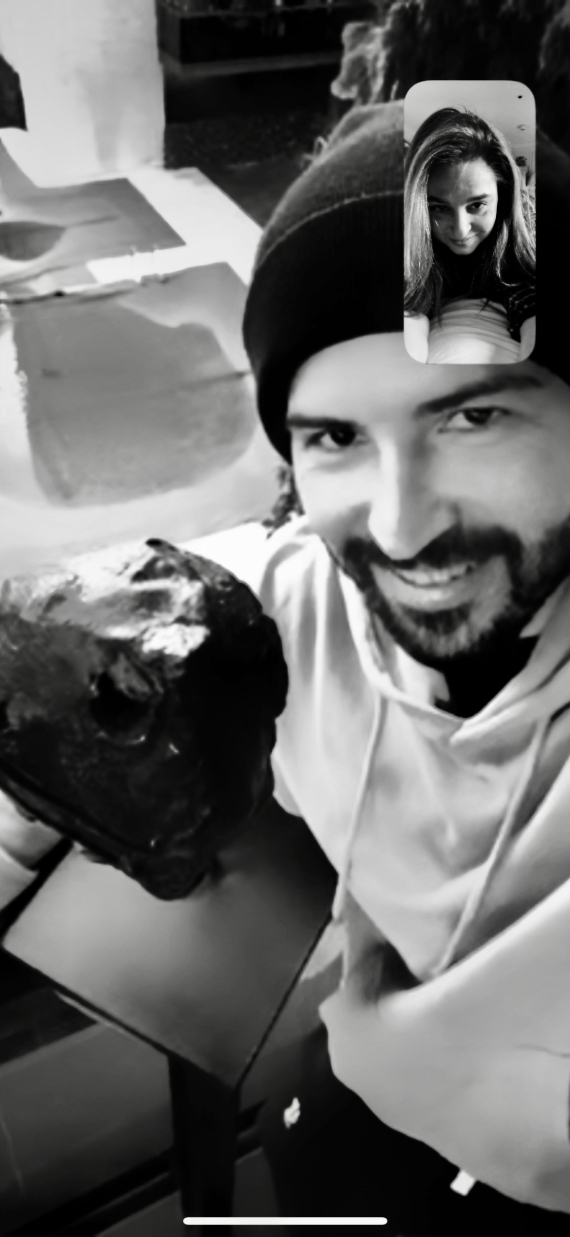
Secundino Hernandez
April 5, Madrid, Home
Obviously it’s a weird feeling.
What I really appreciate is the silence these days. So unusual in this messy city…
Any everyday gesture is amplified. Scrutinised. There is no time for window shopping.
They (the government) don’t allow me to go to the studio but instead, I can work in my cave, with my kids running around me, all day.
I have no choice but to accept my frustration of having to restrain my emotions and remain neutral.
Priorities are no longer those of the past: a candle on the kitchen floor, a painting (or the shadow of) on the wall.
There’s only one thing left to do: and that is to look out the window and simply wait.
Courage to all! is what I say.
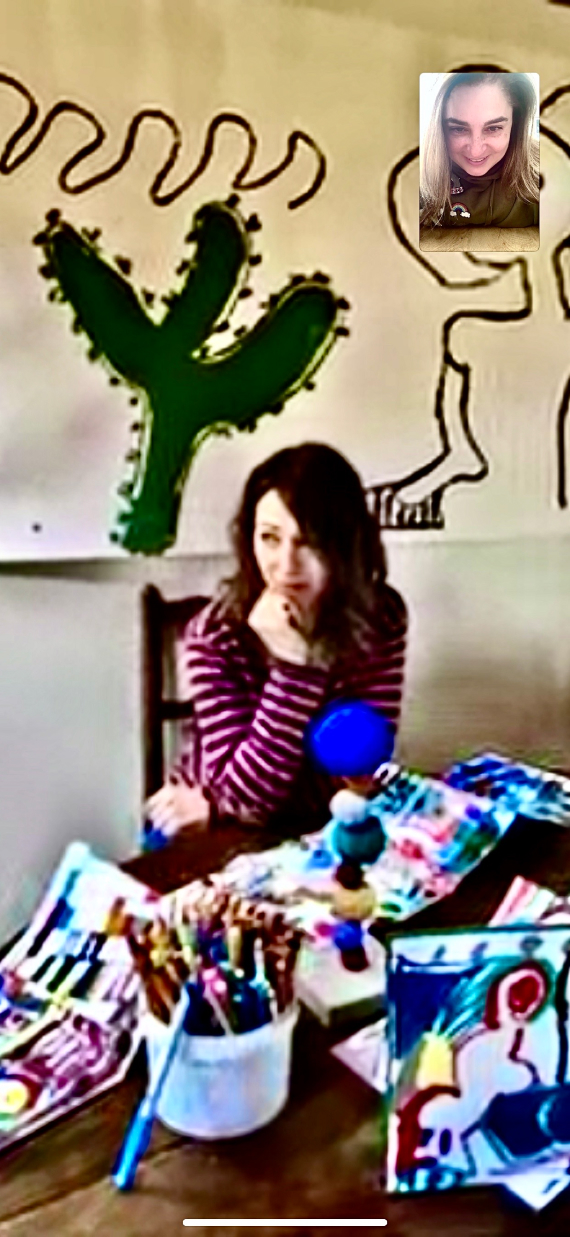
Annie Morris
April 4, English countryside, Home
I have been drawing and painting every day which has helped to take my mind away from the news. My children have been a great distraction. We play more than ever and do the things I always say I will do but never have time to do with them. I say to myself each morning: ‘Today could be better or even good.’
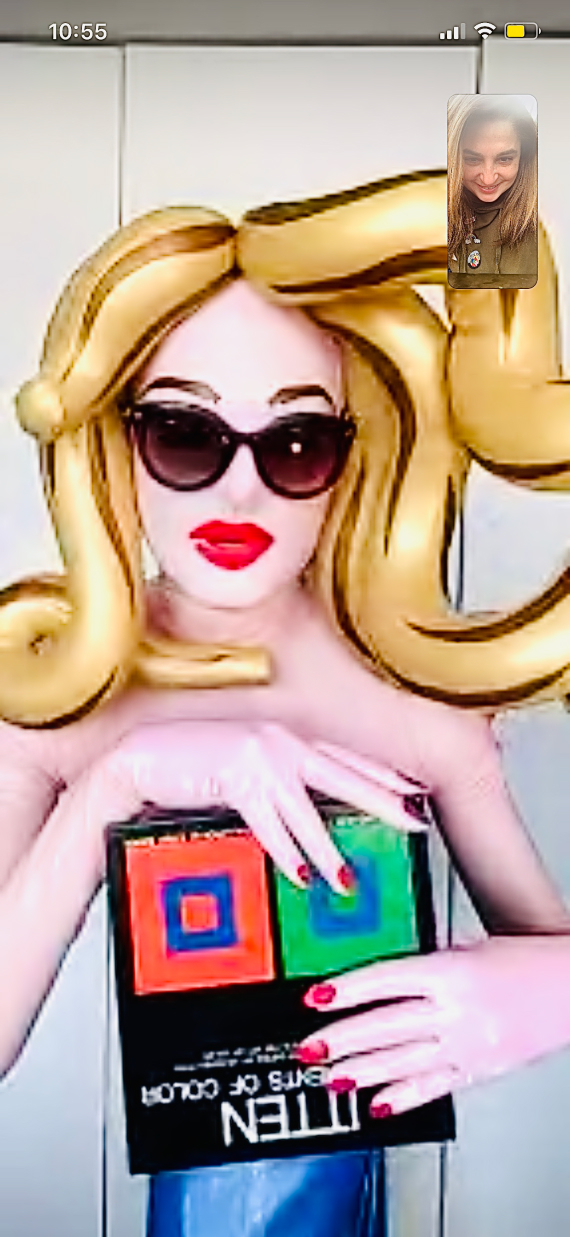
Pandemonia
April 4, London, Studio
From my perspective, the world has been turned on its head. Normally I spend my time in self-isolation thinking and creating work. Now everybody else wears the masks and does the self-isolation, and I am stuck with family unable to think.
But seriously, at this time, we should all be thinking about what kind of future we want because this is a defining moment for all generations. The big question is whether this pandemic is going to bring the world together or drive more conflict. When the current lockdown phase is over there will be more unbalanced globalisation and more restrictions on the flows of people around the world. Already the pandemic has shown how important the digital and the virtual have become. As we move irreversibly into the digital, who owns the technology will be the next political front. We have already seen this issue at hand with the 5G rift between Hawaii and the USA.
Being in central London, I can see the pollution levels dropping and more wildlife returning. Hopefully, we will all consider what kind of future we want and how it will affect the environment and the new economic and political landscapes.
Pandemonia
In the studio with Pandemonia:
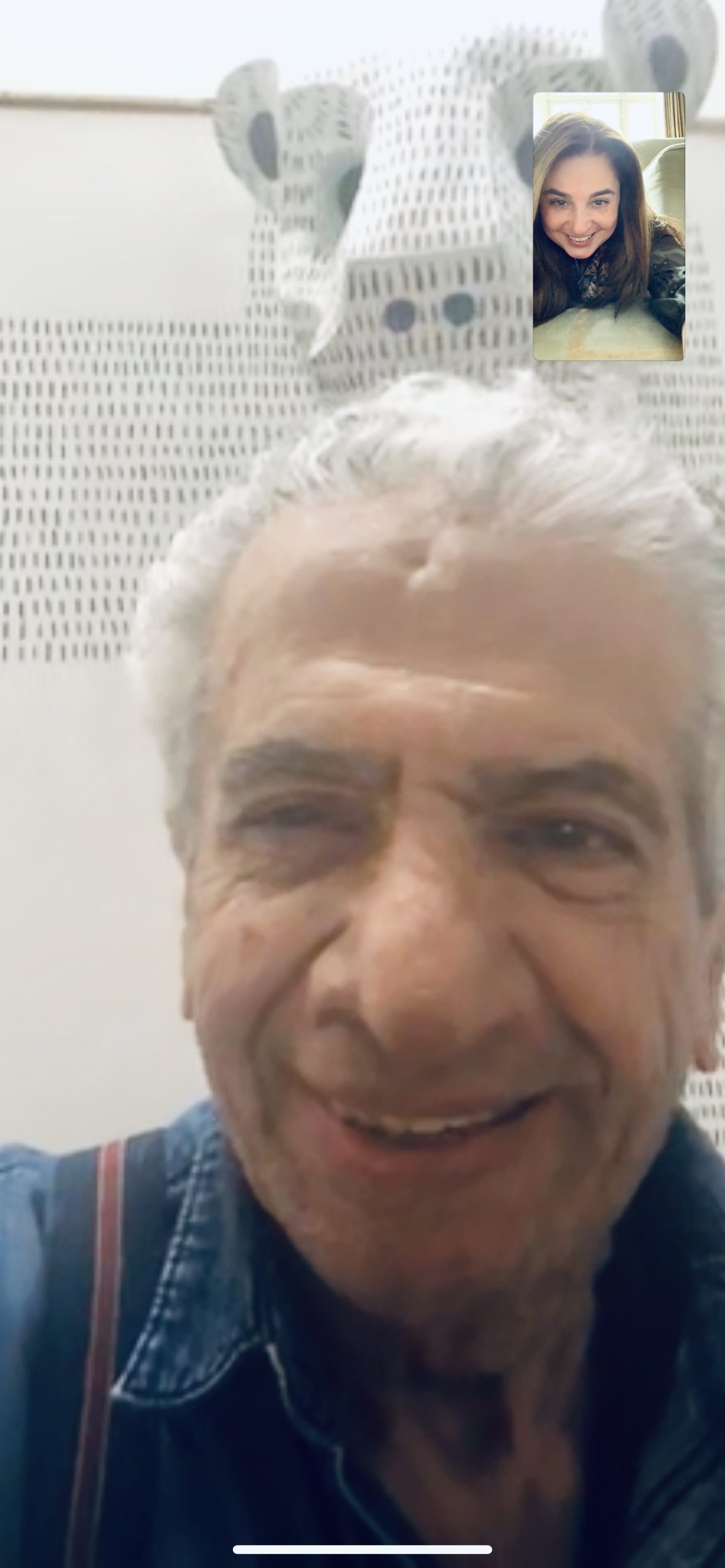
Parviz Tanavoli
April 4, Vancouver, Home
This virus is like a clarion call from Mother Nature. She is warning us that if we continue to neglect her, the worst is yet to come. As the great poet Rumi told us, our existence on this earth is nothingness.
‘Oh you who is less than nothing
Do not twist yourself around nothingness.’
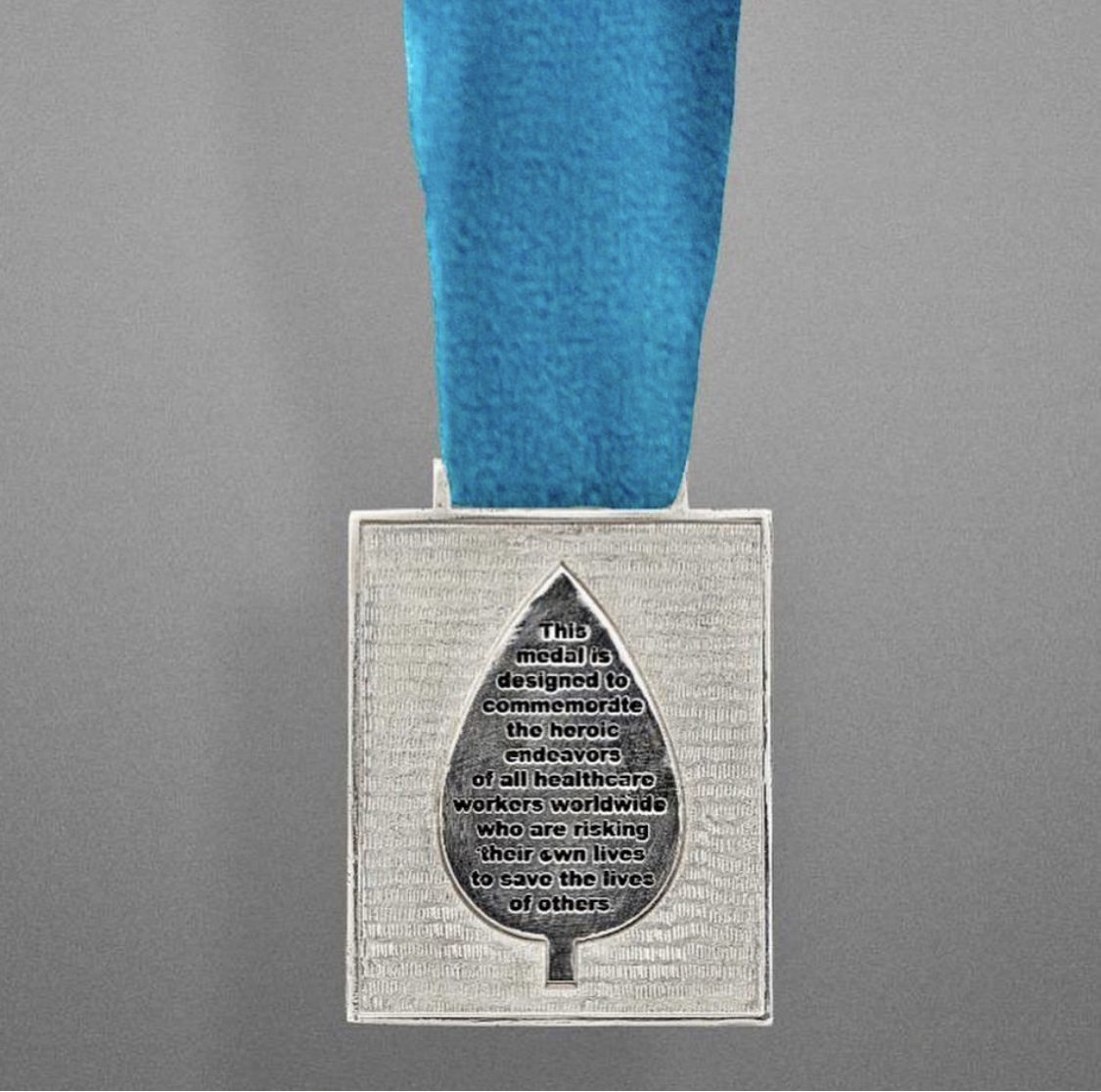
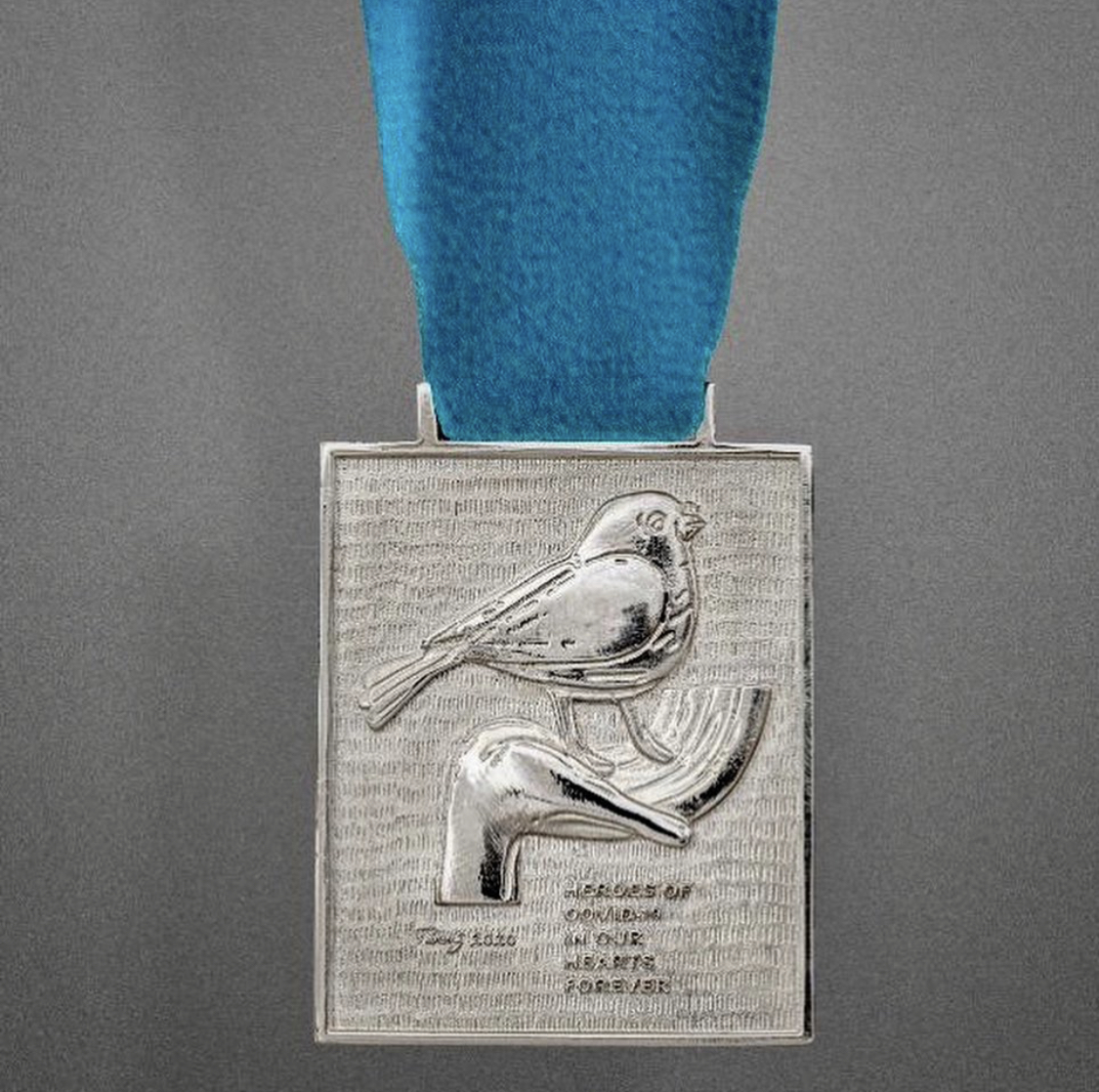
The Tanavoli Museum in Tehran is holding a fundraising campaign through the sales of these medals, and will be donating all of the proceeds to help support the healthcare workers in providing relevant hospitals with essential equipment in Iran
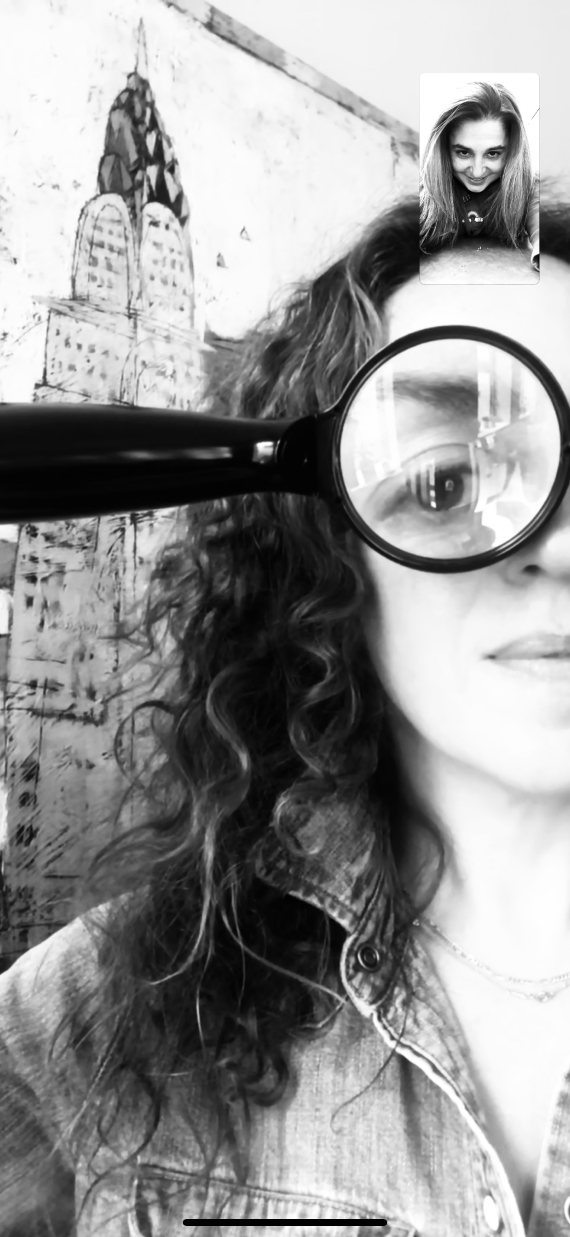
Melanie Dunea
April 3, New York City, Home
After our tears dry.
I believe
We will walk hand in hand down the street
Lounge on the grass together.
Admire paintings in a crowded museum.
Raise a glass and toast.
Share a meal and maybe exchange a bite.
We will kiss and it won’t feel dangerous.
Sleep will come soundly.
Laughter will tumble easily.
I believe we are strong and we shall survive.
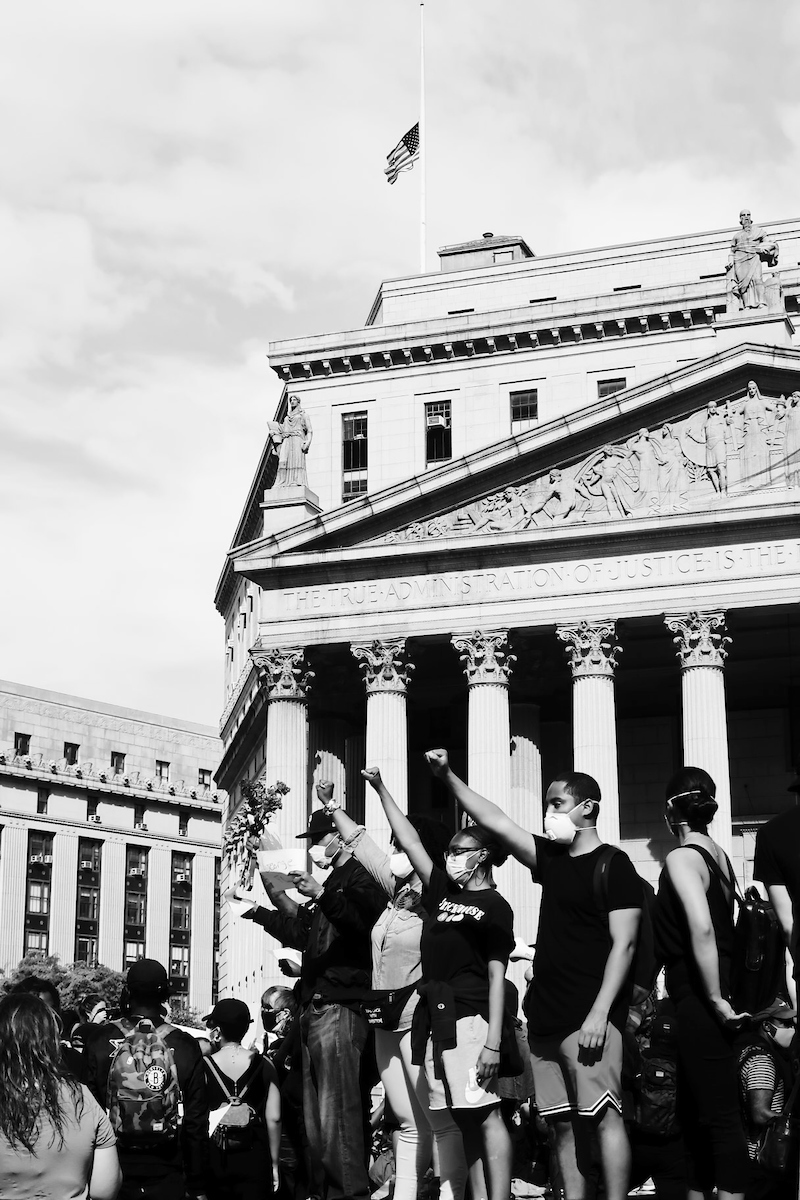
NYC gathers to protest the unjust killing of George Floyd in downtown Manhattan. They stood in the shadow of the American flag already flying at half staff to commemorate the 17,000 + New Yorkers who have died from the Corona Virus. The protesters arms stretched long and high pays homage to the Tommie Smith and John Carlos, American Sprinters, historic moment in 1968 at the 1968 Olympic Games.
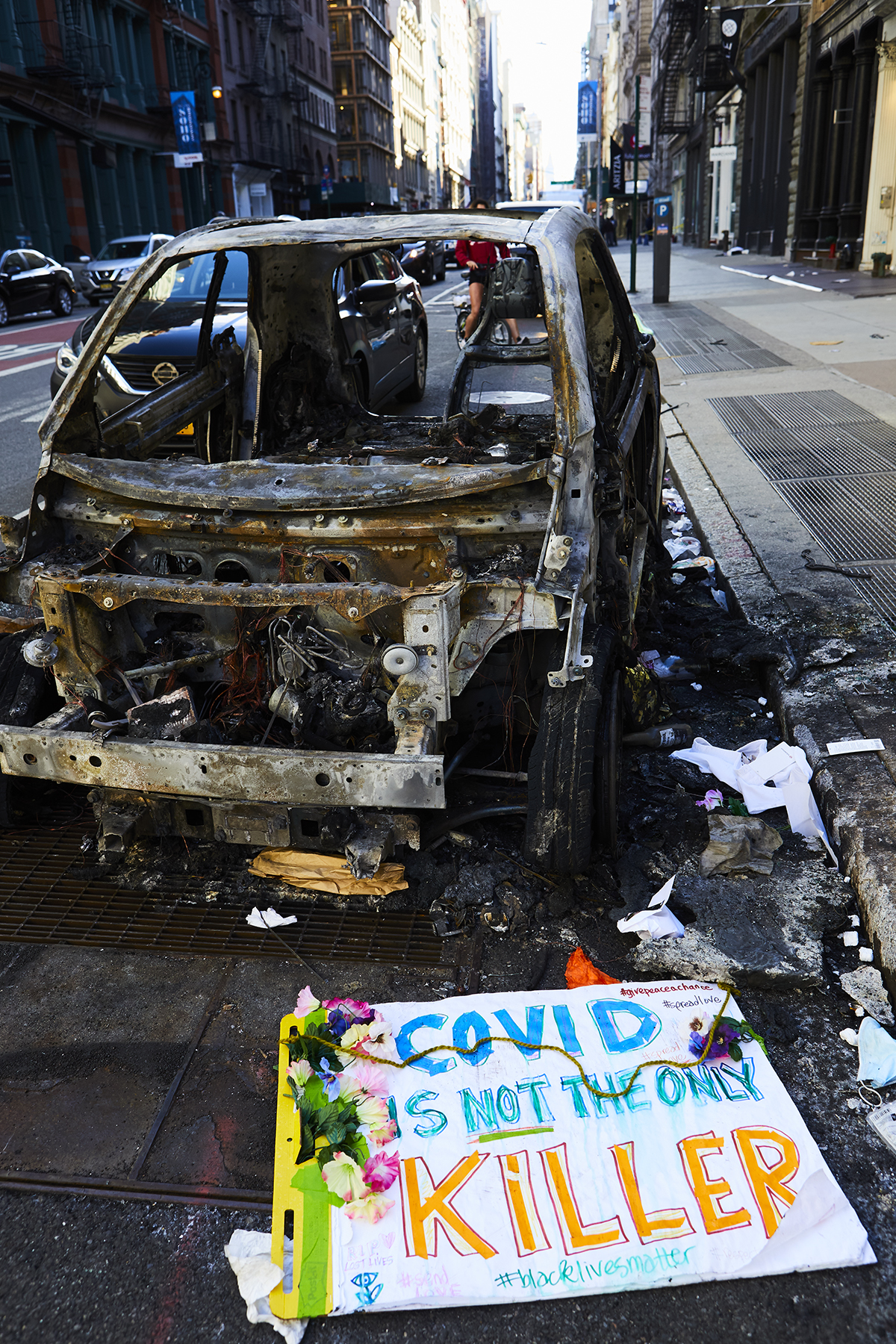
The SoHo neighbourhood of NYC once an enclave inhabited by artists and writers has undergone a metamorphosis and to some has morphed into symbol of wealth and exclusivity. Five days after George Floyd was killed in Minneapolis, crowds took to the streets to protest. When the police officers were not charged for kneeling on Mr. Floyd’s neck for 8 minutes and 40 seconds, many frustrated protests turned into violent riots. The skeleton of this burned out police car was found in front of the iconic American shop Bloomingdales June 1st, the day after SoHo was looted.
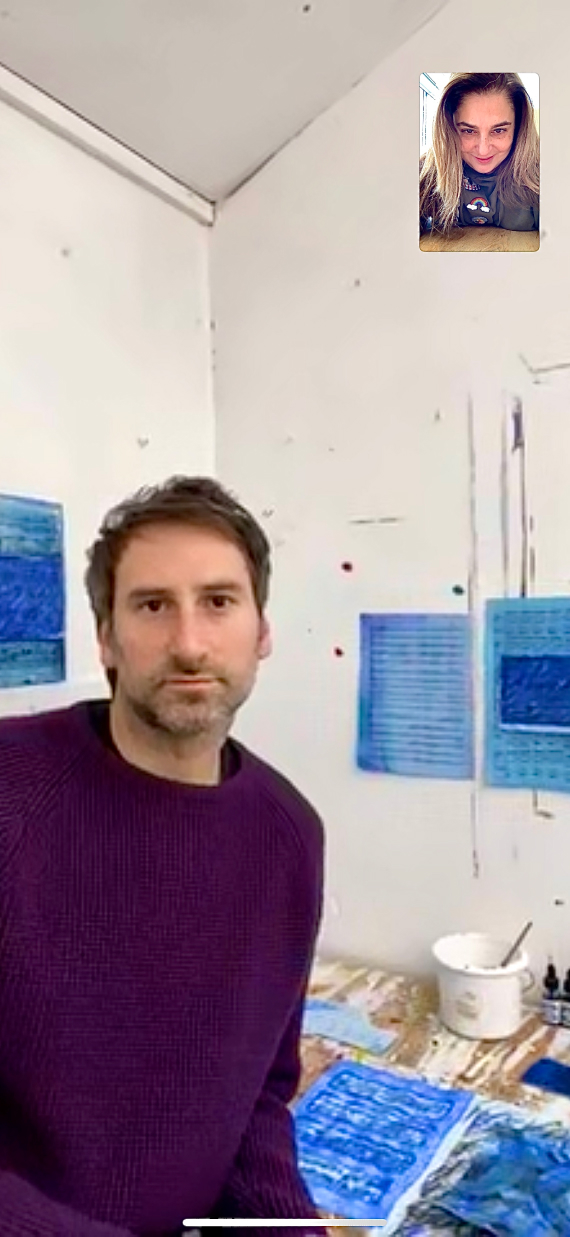
Idris Khan
April 3, English countryside, Home
I find myself,
reading repetition.
Writing it down
over and over again.
Birds’ beaks hammering at the window,
Leaves flickering as a shadow.
The way
hope builds
a house.
Idris Khan
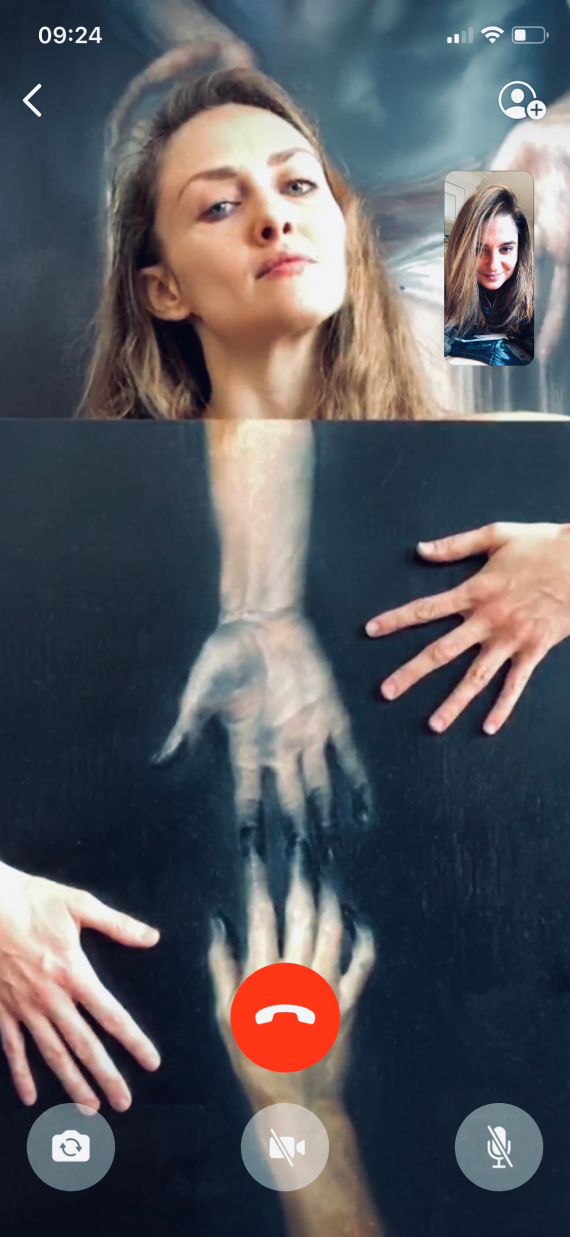
Maria Kreyn
April 3, Brooklyn, Home/Studio
I just keep painting, breathing and paying attention–to the patterns of the outside world, and those of my mind. We’re all so painfully isolated yet profoundly connected; singular nodes in a collective universe; islands in an archipelago with minds as megaphones and antennae, signalling to each other through words and hearts and art.
Yet the challenge isn’t simply to be content in our fortress of solitude. Beyond the privilege of our confinement is a world pressing us to rewrite a violent, broken ideology of privatising gains and socialising losses.
‘Sit, be still, and listen,
because you’re drunk
and we’re at
the edge of the roof.’
– Rumi
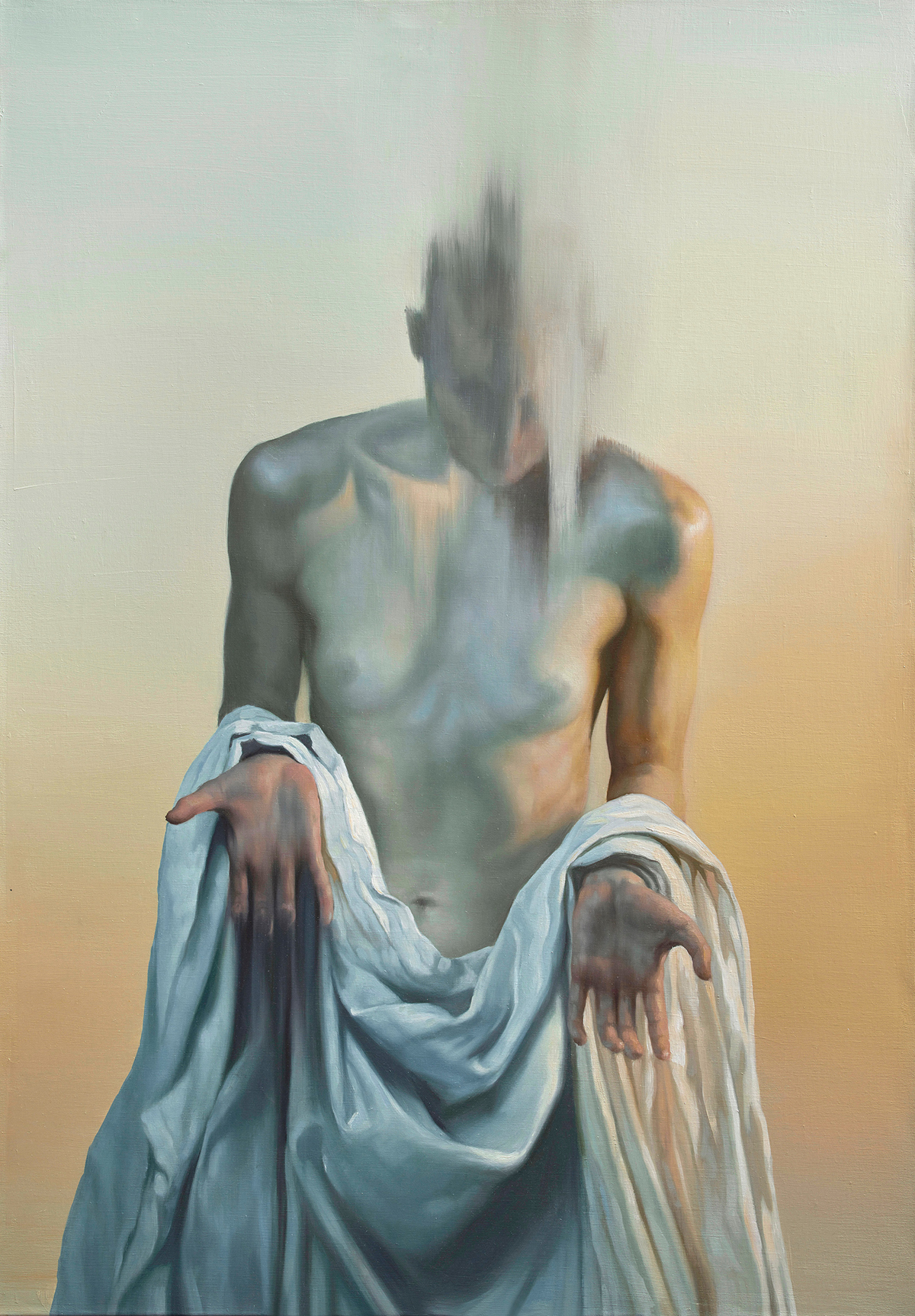
‘The Sieve’, oil on linen. 42 x 60 inches
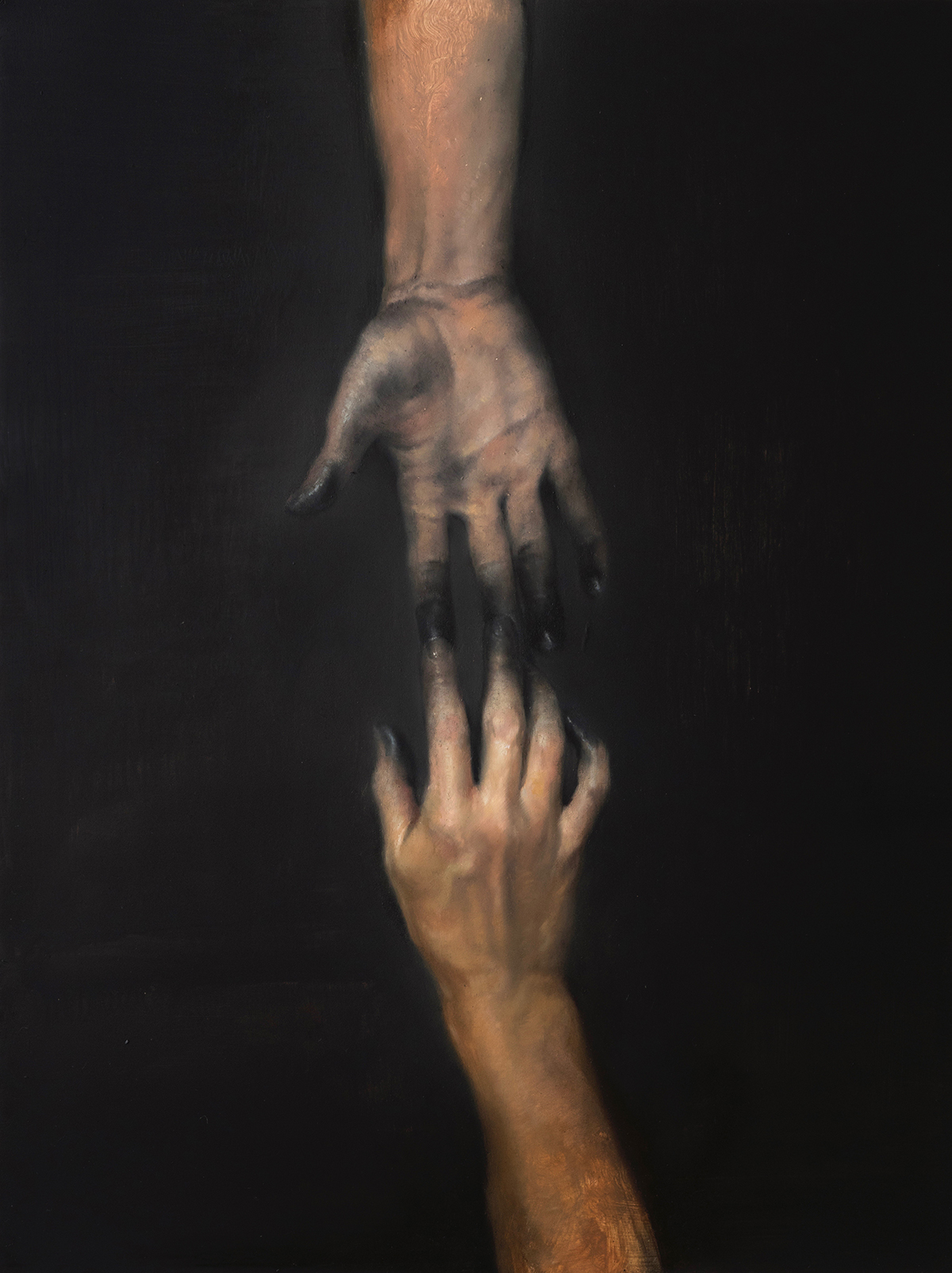
‘Where are you?’, oil on panel. 18 x 24 inches
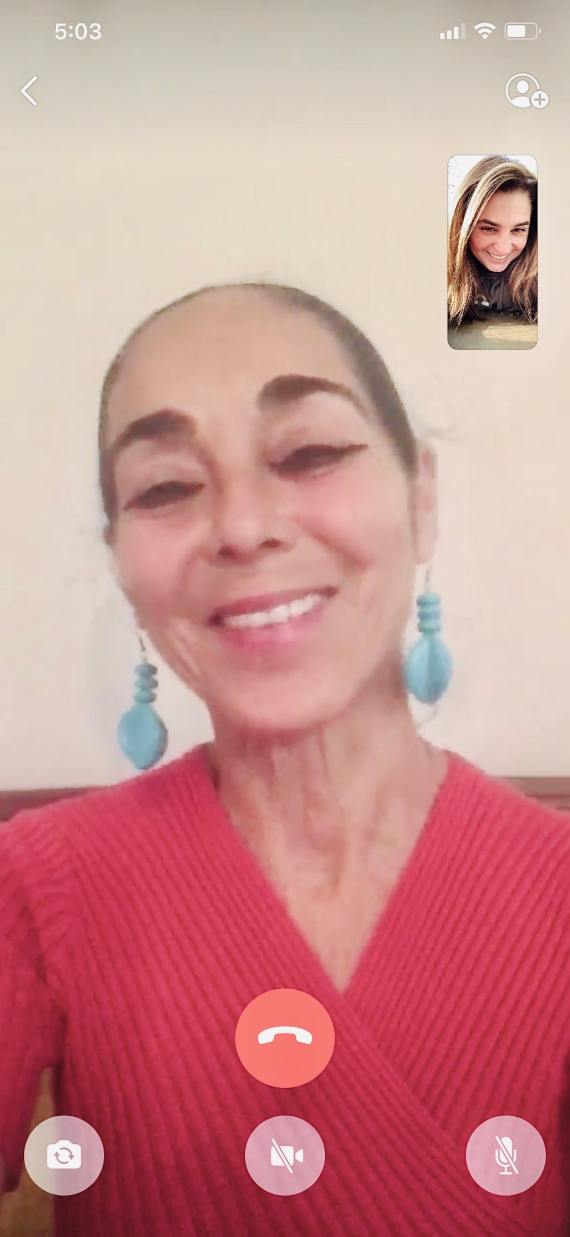
Shirin Neshat
April 3, Upstate New York, Home
We tried to change the world; now the world is changing us, everything about us, including how we work as artists! Living in isolation has made us face ourselves and everything that we have escaped or overlooked in life. Now at ground zero, with our plans postponed or cancelled for good, there is a terrifying yet liberating feeling in the air. While the future is uncertain, we might just be embarking on a new beginning, on both individual and collective levels, with an eye on our shared humanity and a long deserved respect for nature.
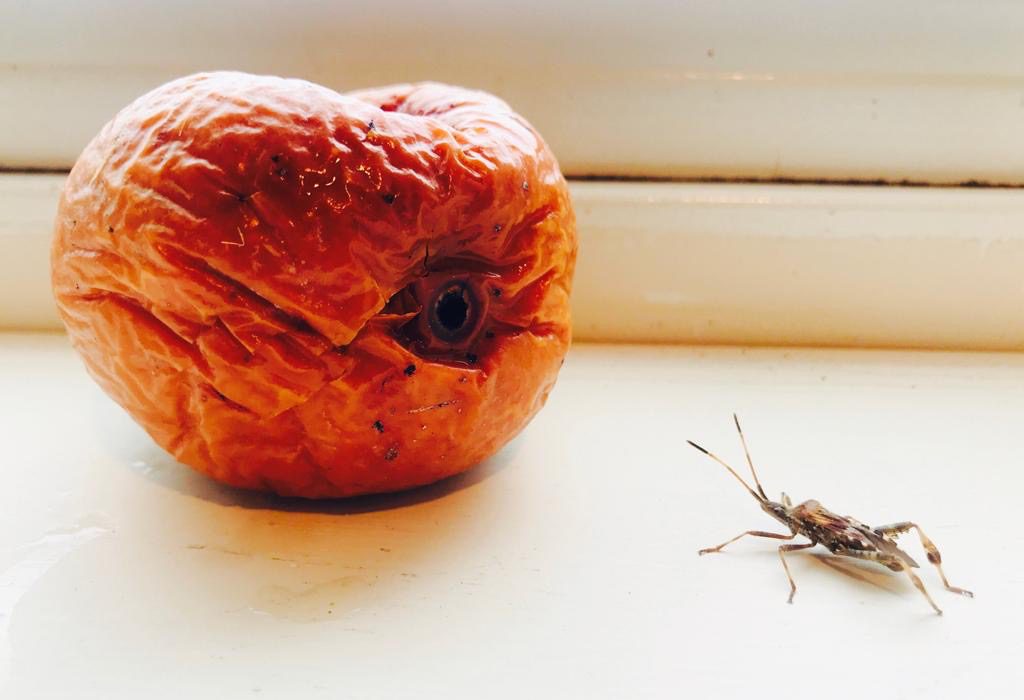
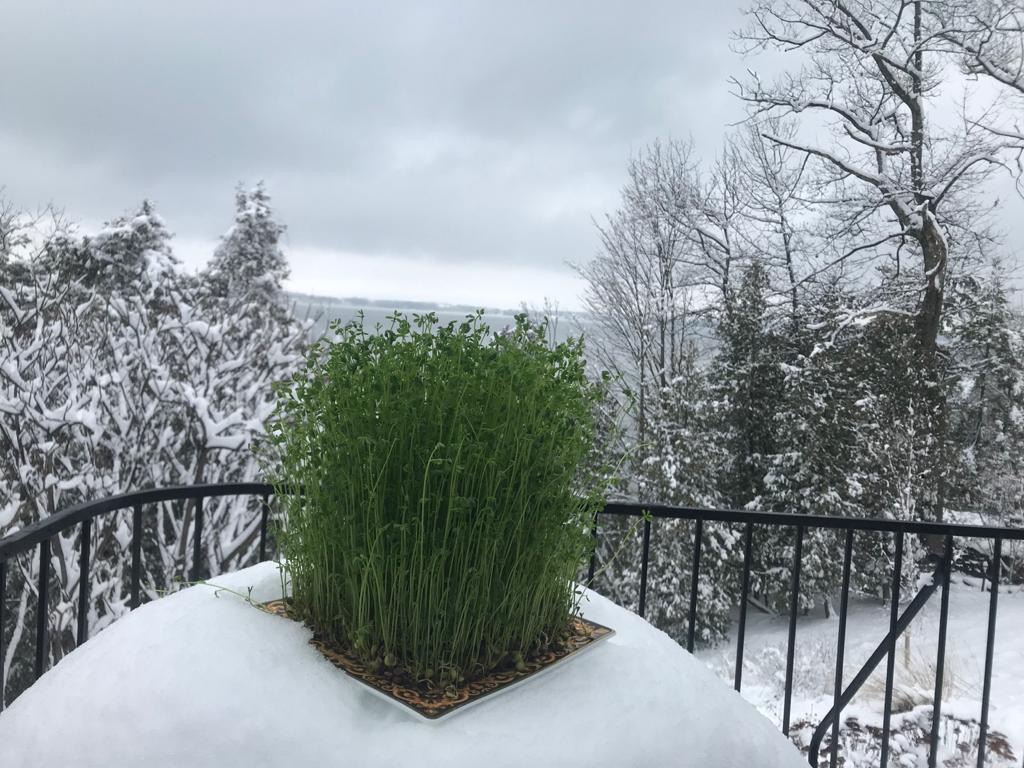
“Waiting for Spring!”
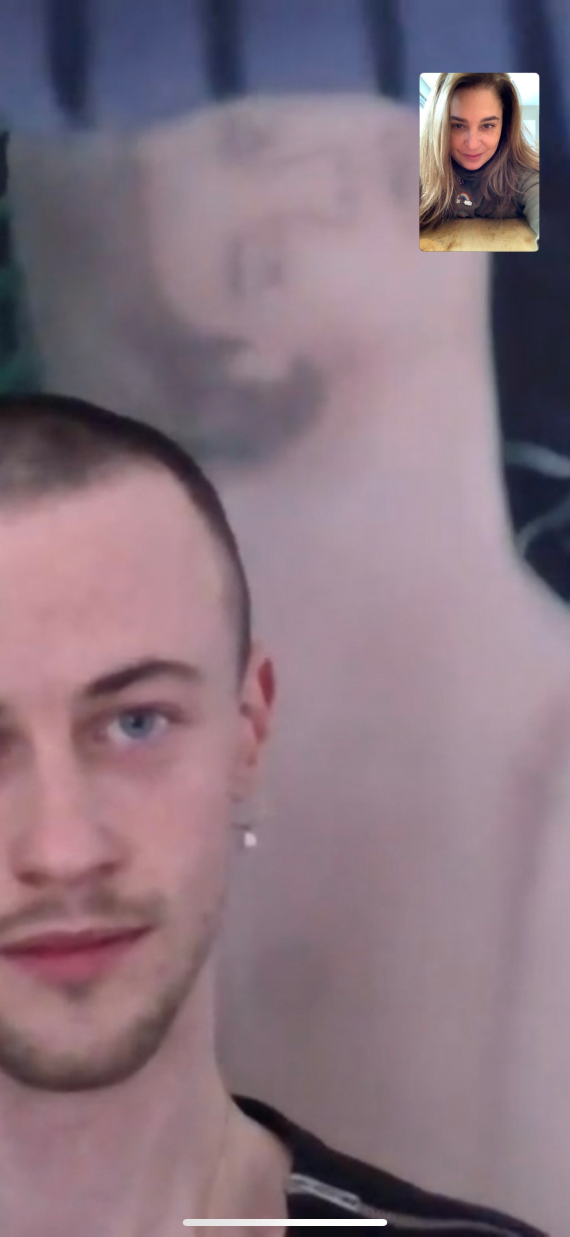
George Rouy
April 3, London, Studio
In this moment of social flux the figure in mass feels distant and the aspect of touch taboo. Instead, I am drawn to the quiet moments of companionship, the playfulness of silence and comfort in the abstract.
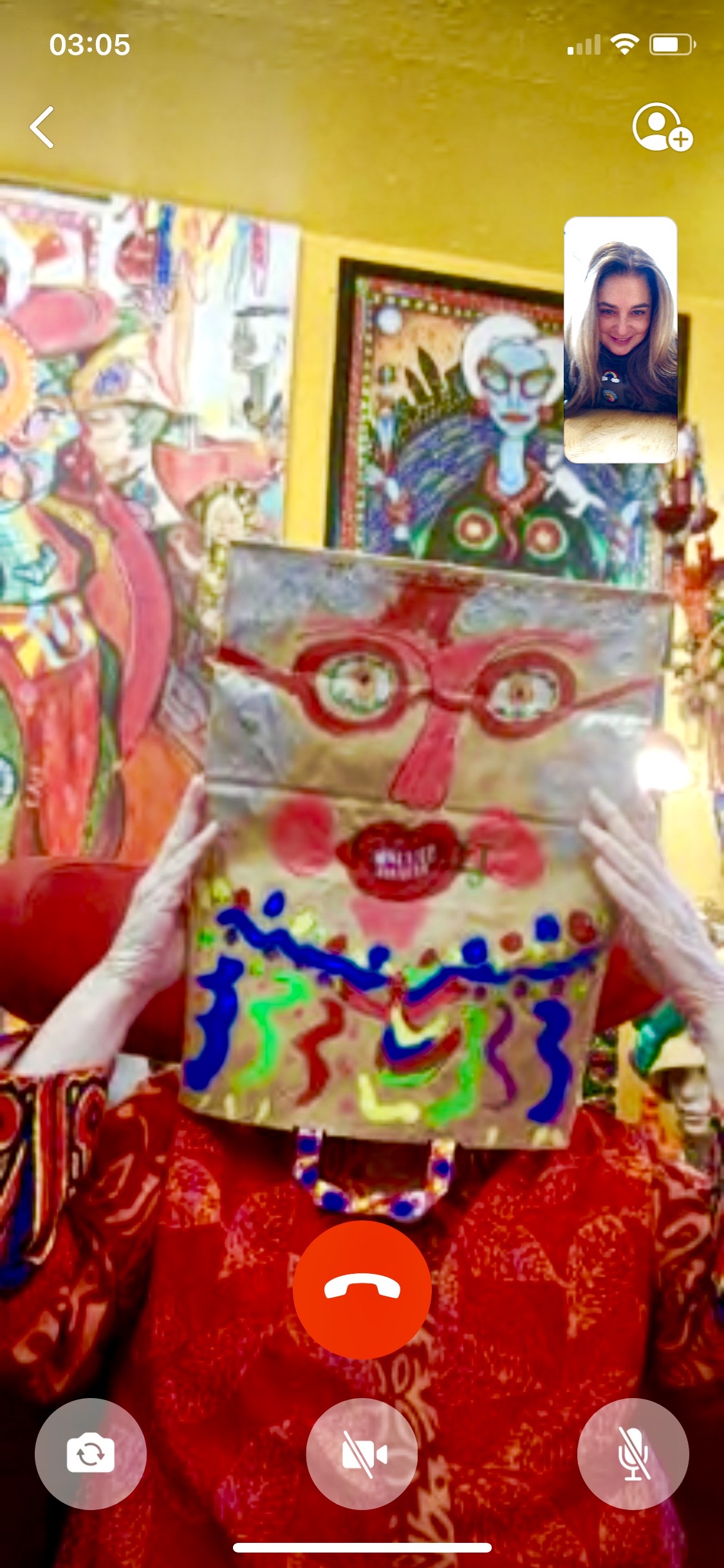
Sue Kreitzman
April 3, East London, Home/Studio
If you are an artist and sequestered somewhere with your art supplies you are very lucky indeed. Make things. Silly things, small amusements, big projects, profound things. Don’t work to a brief. Or overthink it. Just let it flow. Make art like no one is watching. Then post it on social media like every-one is watching. Make your isolation memorable.
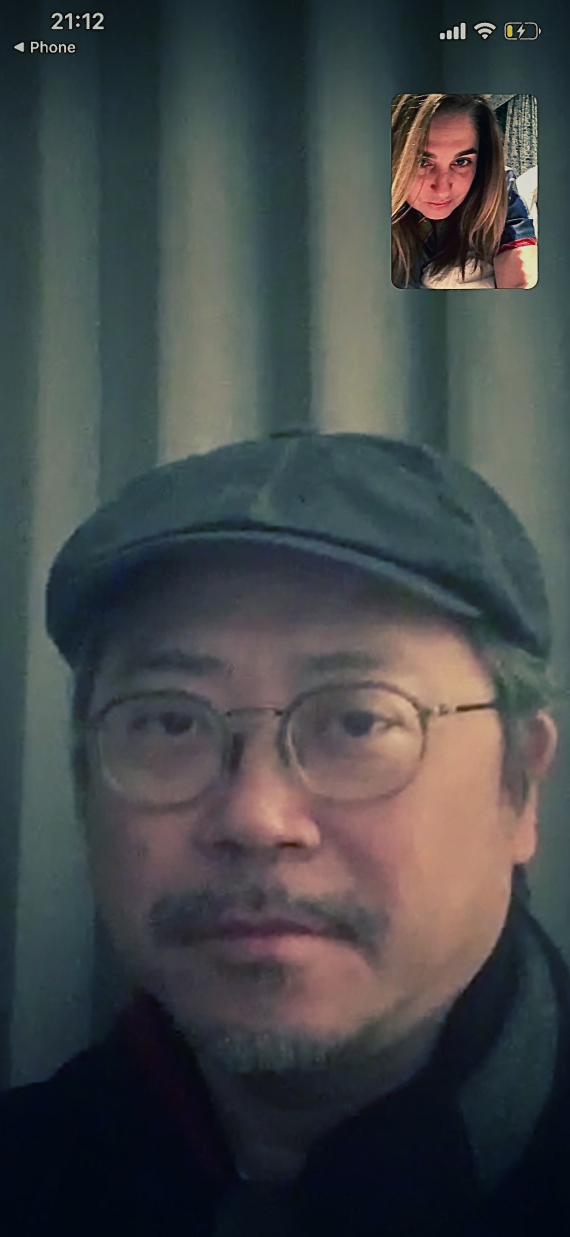
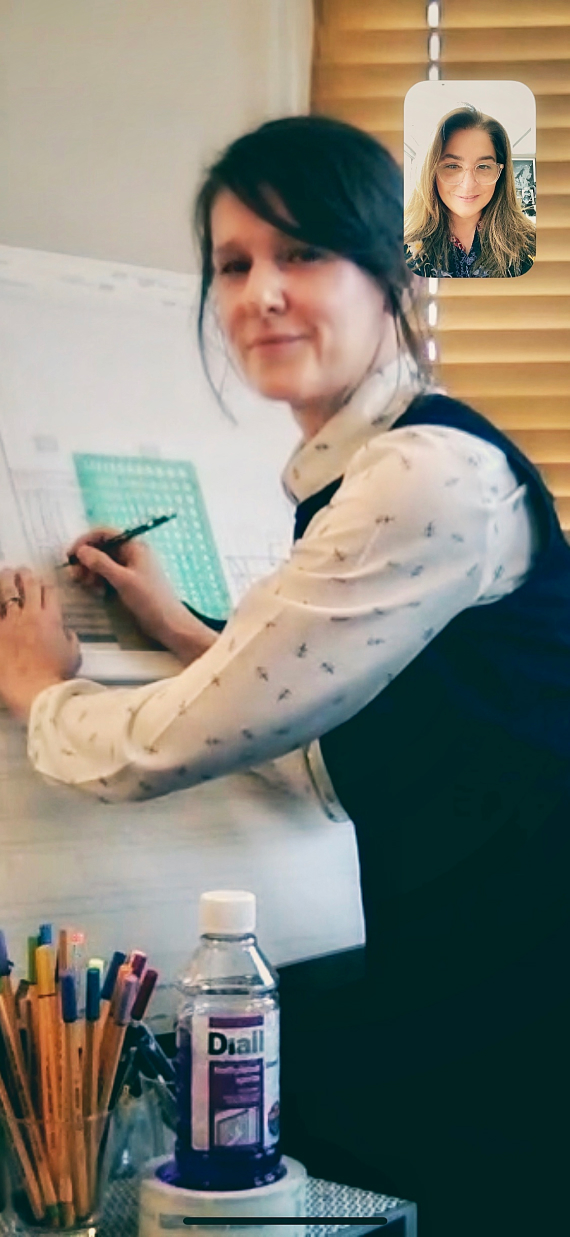
Lucy Williams
April 2, London, Home
‘It is good to be solitary, for solitude is difficult; that something is difficult must be a reason the more for us to do it.’
– Rilke
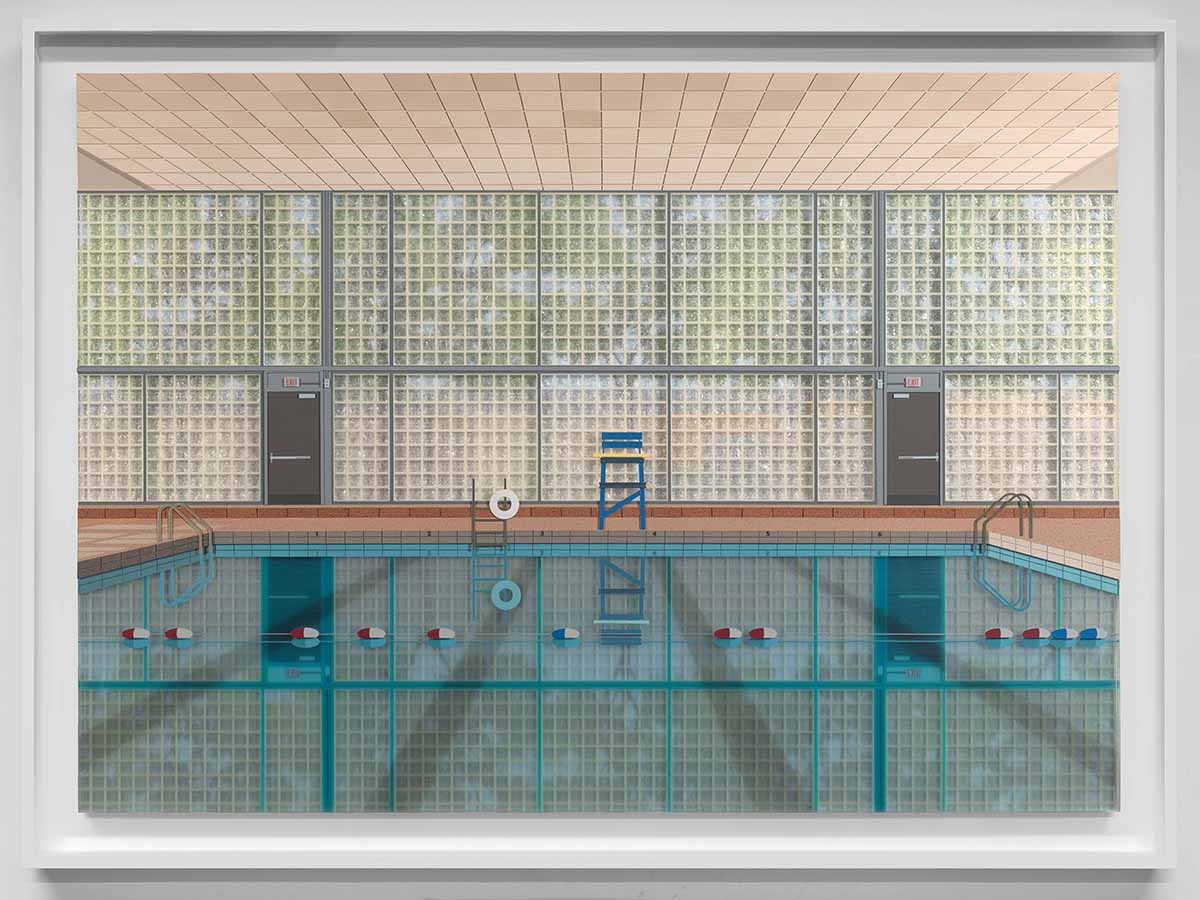
‘Community Pool’, 2016. Mixed media , 75 x 106 cm. Courtesy of the artist and Berggruen Gallery.

‘Library Viipuri‘, 2019. Mixed media, 60 x 123 cm. Courtesy of the artist and Berggruen Gallery
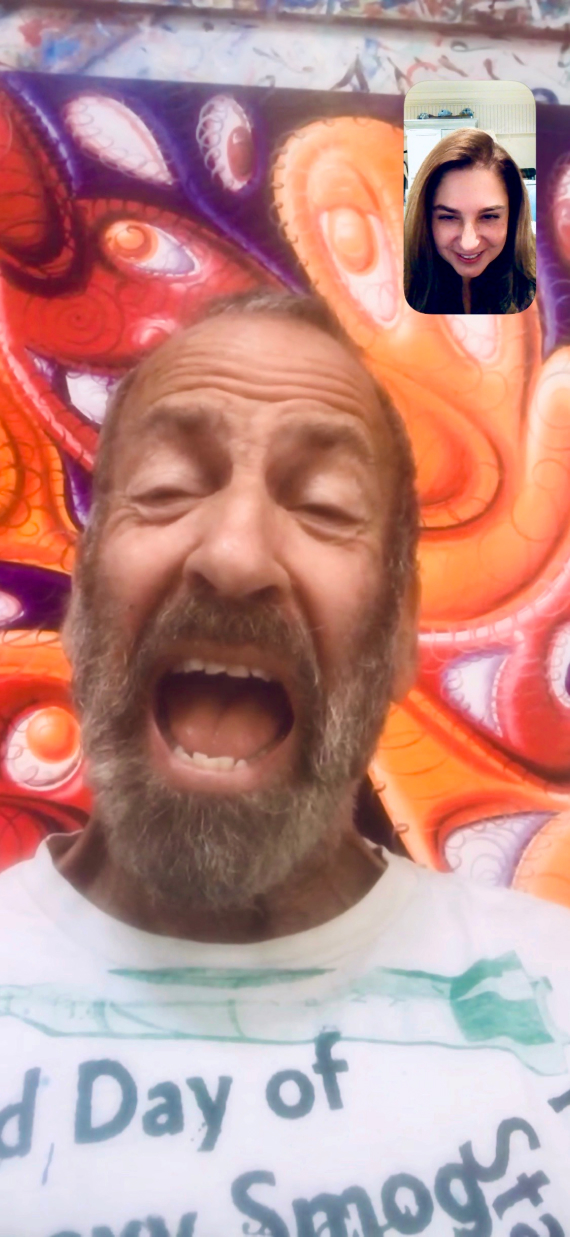
Kenny Scharf
April 2, Los Angeles, Home
A few months ago, I decided not to fly anymore. Being on a plane or at the airport was freaking me out so I stopped. I had a show in Korea, and I didn’t go. I kept repeating to everyone who would listen that we need to stop moving around, settle down and choose where we want to be and stay. I was very stressed about all of this, and now I can see why. The day everything shut down the air was noticeably cleaner, and I saw the birds looking happier than ever. Anything connected to nature is having a wonderful time right now. It really feels like we were on a speeding locomotive without any desire to slow down before going over a cliff! This pandemic has done what we were not willing to do. I hate that people are suffering and life is very difficult right now, but I would sacrifice my health and the economy for the planet. Also as soon as this happened, I got very hopeful that this would be the thing to finally take Trump shit down. I keep praying that people in the middle of this country will wake up and see what a wretched individual he is. Unfortunately, it takes something this harsh to make people think about things differently. I hope so.
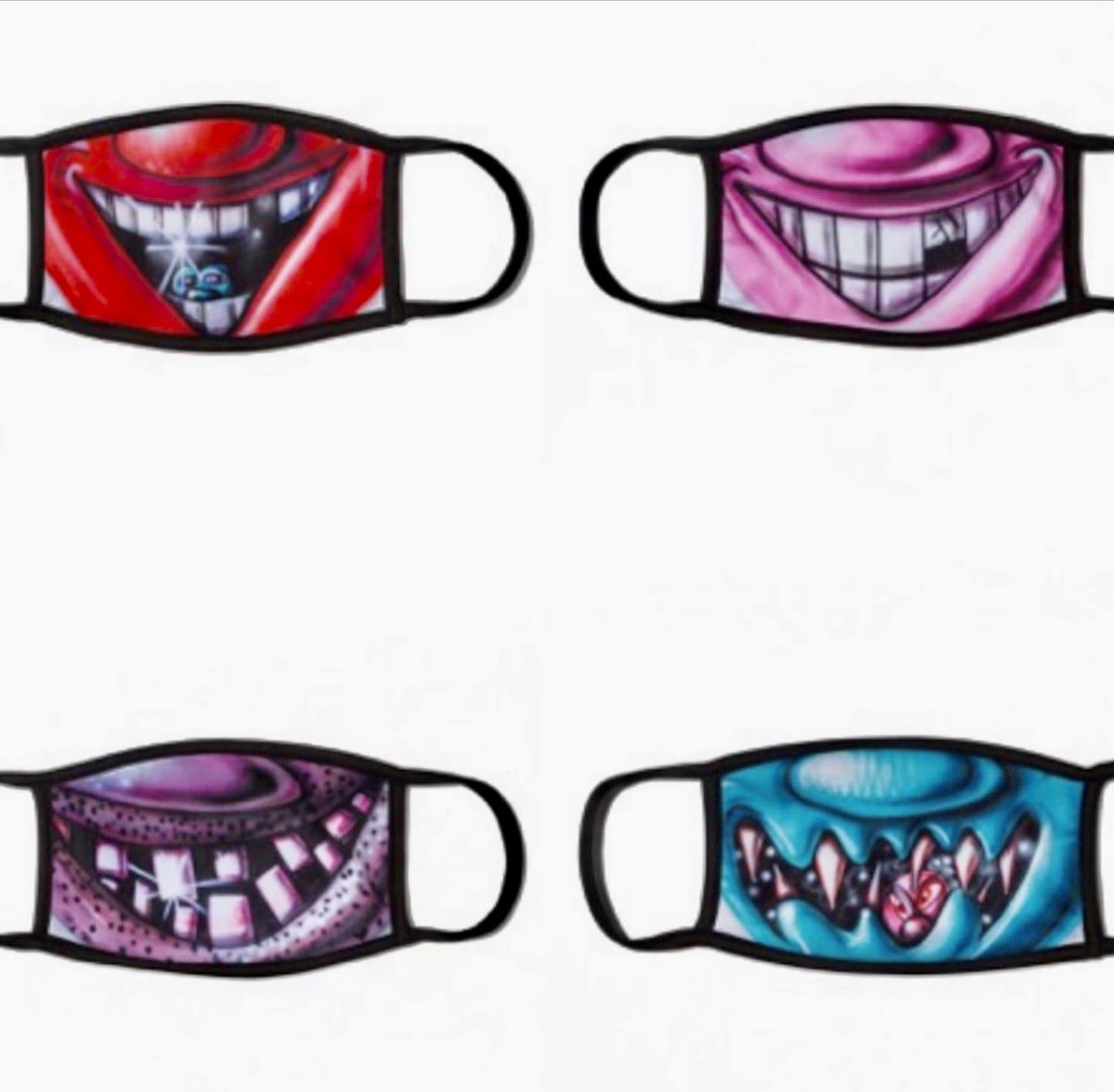
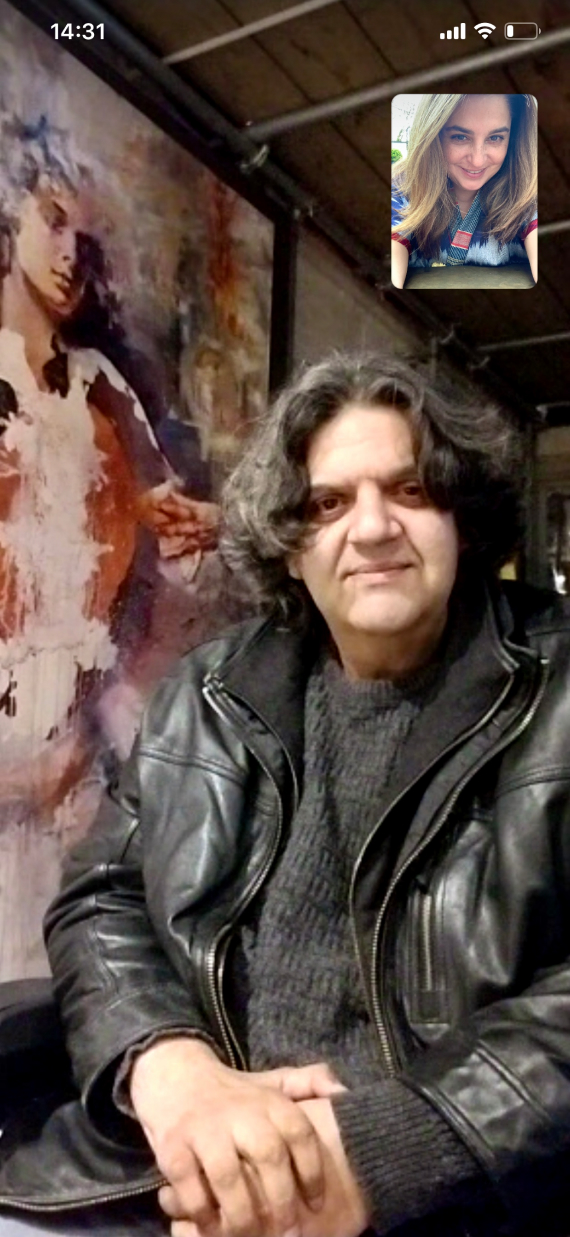
Ash Naghouni
April 2, London, Studio
Fear is as detrimental to society’s sanity as it is to an artist’s creativity. We will survive the virus but the bigger test is to survive ourselves, to come out on the other end of it, with our humanity intact. I would like to believe that we will.
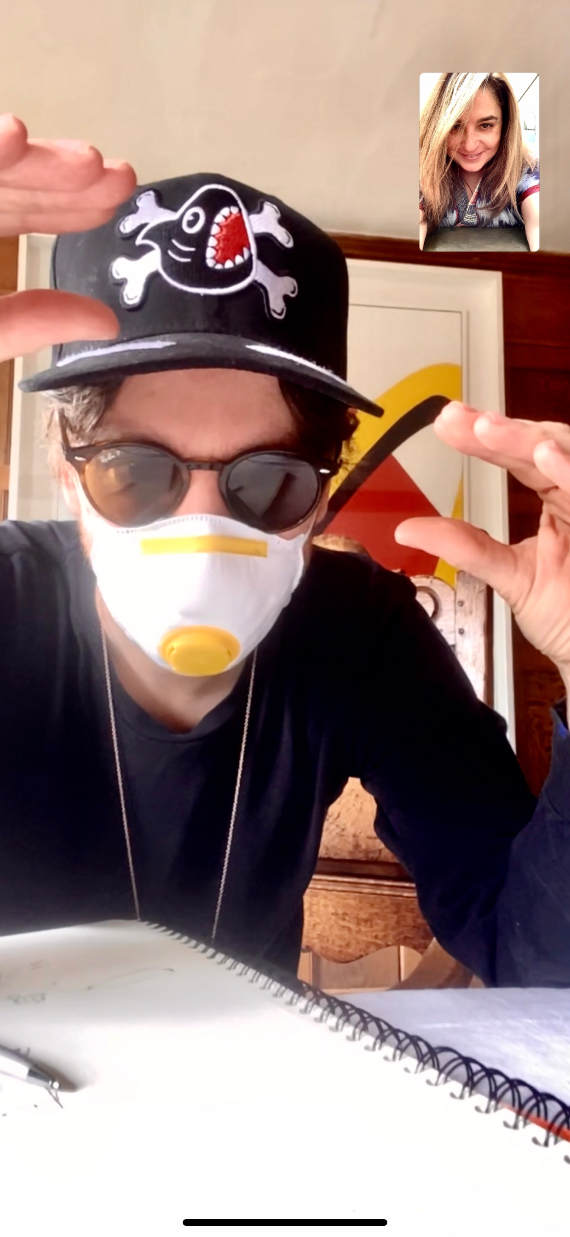
Philip Colbert
April 2, English countryside, Home
I set up a studio at home and have been obsessively reading books on Graham Sutherland; I think it’s because I’m isolating in the countryside and his work was so much about nature. He was very close with Bacon in the 40s and their works have strong similarities, but Sutherland’s painting is much more nature orientated. In my work, I have created a project called ‘Art against the Virus’ that will be released worldwide to raise money for charities fighting the Covid-19 virus. As part of this, have been developing a series of films, for this is where my lobster persona is at war with the virus monsters who have invaded Lobster Land.
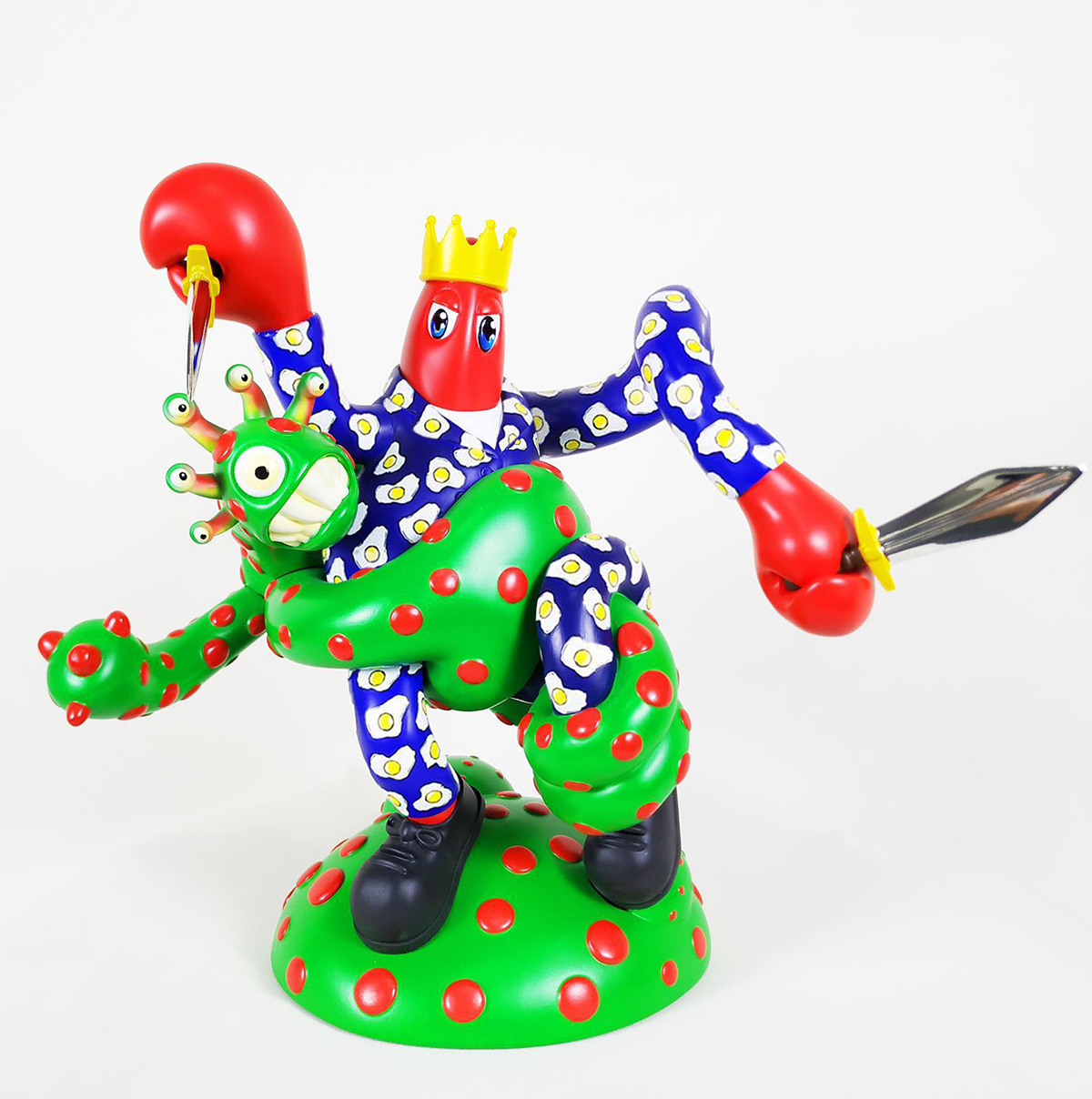
HUNT sculpture limited edition with @apportfolio worldwide release for 🦠❌Art Against The Virus ⚔️100% profits for @rescueorg 🌈 30cm High, Edition of 300.
🦞Art Against The Virus – Episode 1 🦠
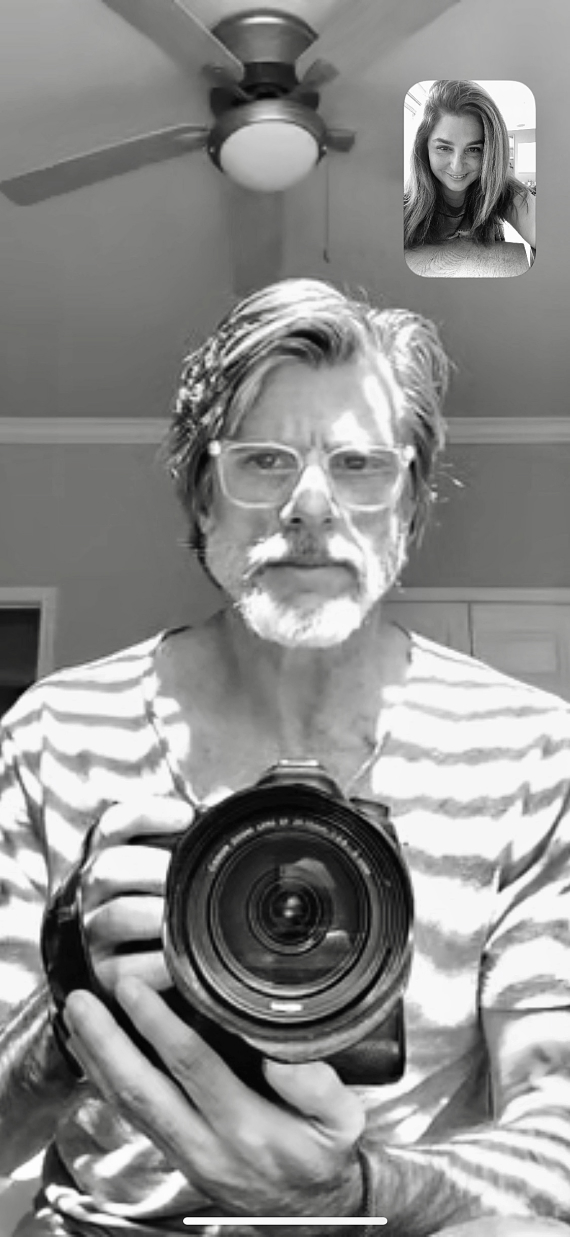
David Taggart
April 1, Dallas, Home
Humanity went to sleep one night in one world and woke up in another… to an enemy who does not distinguish race, culture, age or ethnicity. One that transcends borders. A pathogen that knows no socioeconomic class, does not discriminate against gender, sexual orientation, political party or educational background. If it catches you, it does not care about the size of your bank account or that of your house, or the make of your vehicle. What can this virus teach us? Can this virus actually reveal our humanity? What if it showed us how to see the world as we actually should? What if it educated us that race, ethnicity, borders and socioeconomic background just don’t matter… that we are in fact one race… the human race, bound together by what we have in common, not our differences… that we all come from the same Wheel of Life, and belong to a universal Republic of Humanity?
19 has unarguably shown us that our Wheel of Life is part of a much larger one. That we are inextricably connected to other species… to nature. That we have to learn to respect mother earth with the same vigour as we learn to respect one another.
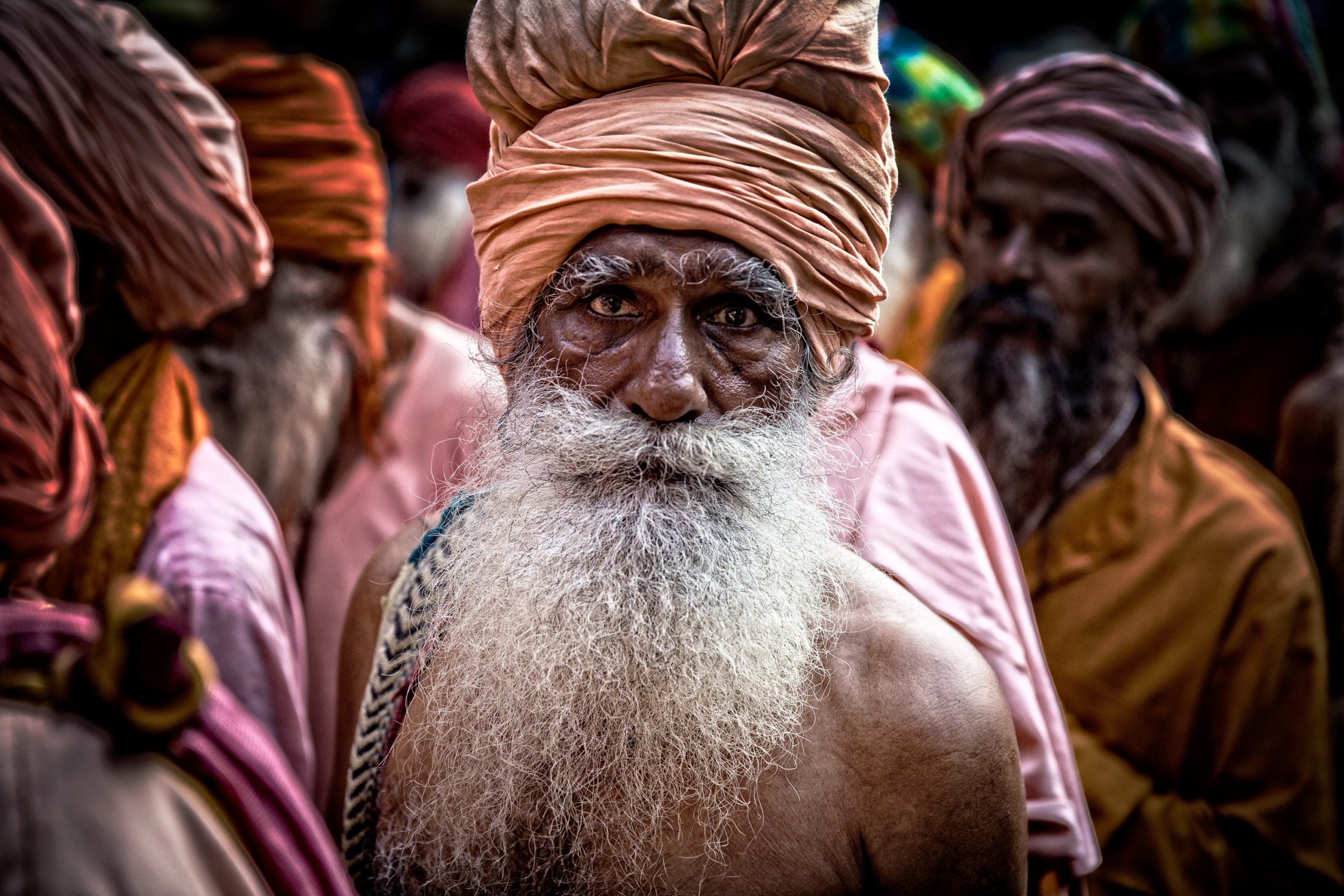
Worshiper, Kumba Mela Festival, Nashik, India
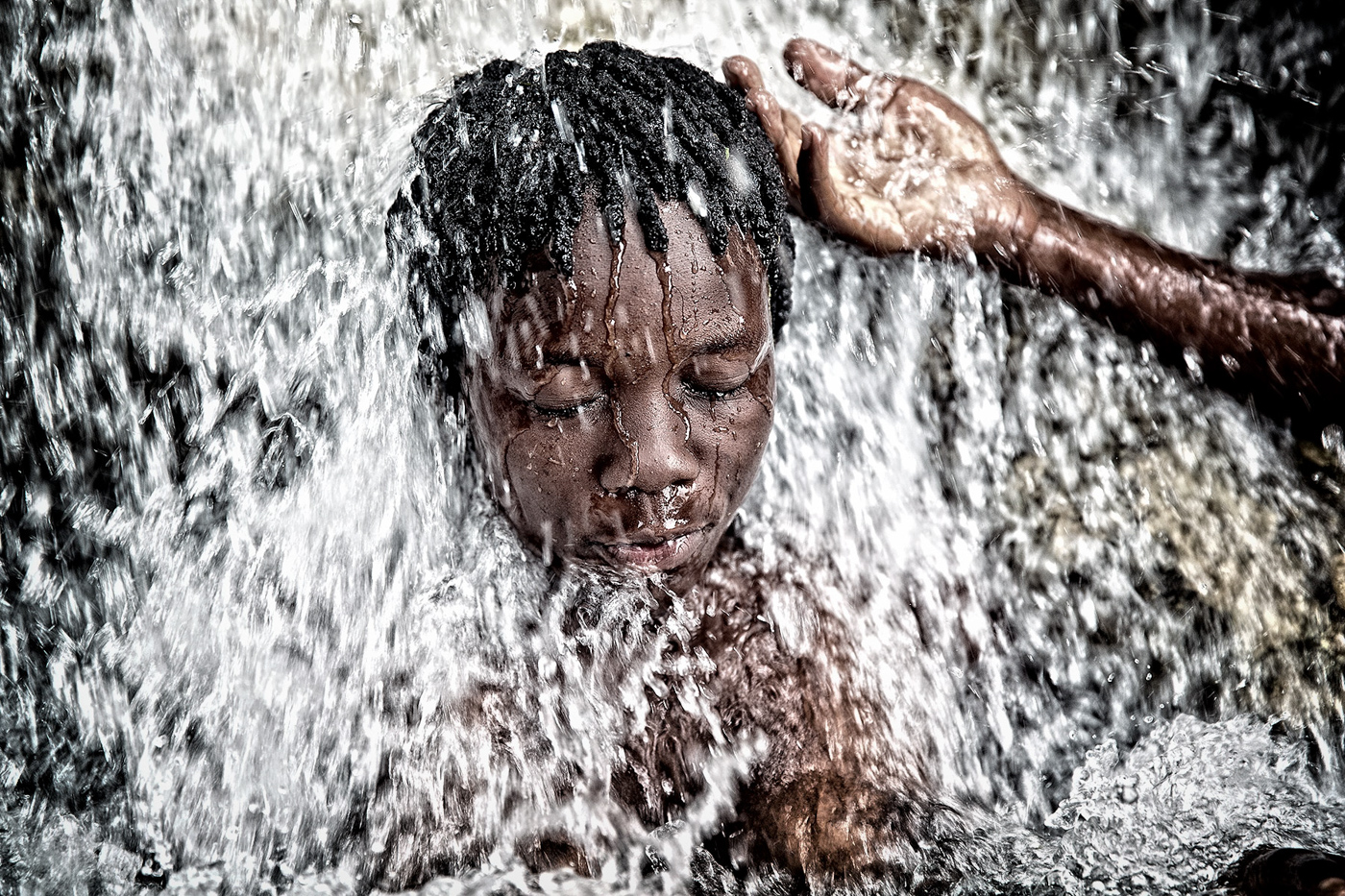
Voudouisant, Saut d’Eau, Mirebalais, Haiti
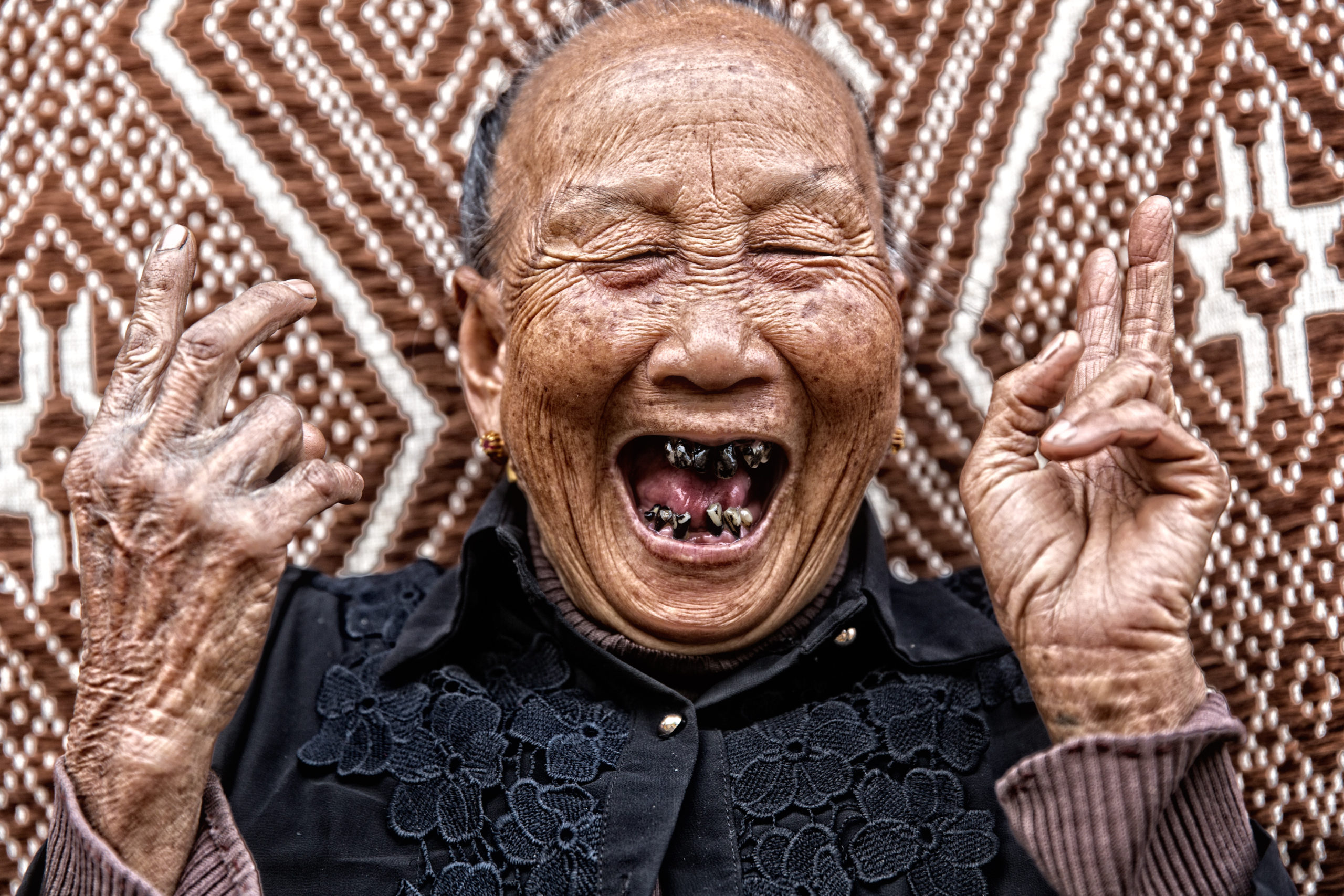
Village Woman, Outskirts of Luang Prabang, Laos
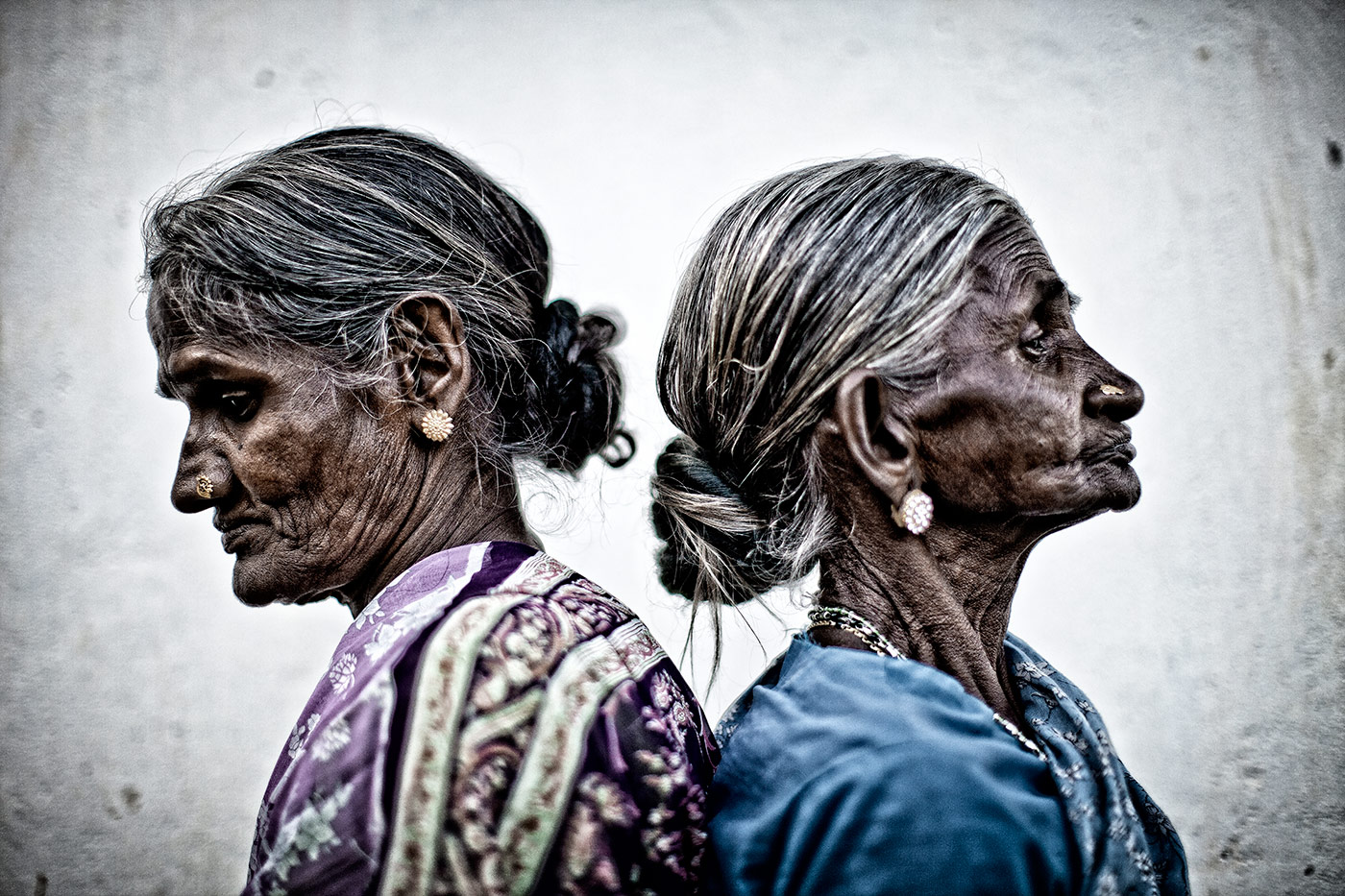
Sisters, Cylon Tea Trails, Outskirts of Bogawantalawa, Sri Lanka
Kindly supported by Tristan Hoare, Photo London & Artnet
Acknowledgements
Maryam Eisler and LUX would like to thank the following artists for their kind participation:
Marina Abramovic, Diana Al-Hadid, Manal AlDowayan, Miles Aldridge, Alia Ali, Hurvin Anderson, Flavie Audi, Jonathan Baldock, Ali Banisadr, Larry Bell, Langlands & Bell, Katherine Bernhardt, Walead Beshty, Huma Bhabha, Mahi Binebine, Edward Burtynsky, Faiza Butt, Nancy Cadogan, Rob Carter, Nick Carter, Gordon Cheung, Francesco Clemente, Anne Sophie Cochevelou, Charlotte Colbert, Philip Colbert, Mat Collishaw, Paolo Colombo, George Condo, Scott Covert, Edmund de Waal, Es Devlin, Camilla Douraghy, Melanie Dunea, Sharon Eyal, Mehdi Farhadian, Eric Fischl, Derek Fordjour, Ed Fornieles, John Gerrard, Azadeh Ghotbi, Wayne Gonzales, Dor Guez, Subodh Gupta, Rokni Haerizadeh, Ramin Haerizadeh, Hassan Hajjaj, Sam Harris, Fathi Hassan, Holly Hendry, Secundio Hernandez, George Holz, Sheree Hovsepian, Henry Hudson, Richard Hudson, Mustafa Hulusi, Luchita Hurtado, Aria Isadora, Alex Israel,Matthew Day Jackson,Pouran Jinchi,Chantal Joffe,Rashid Johnson,Lamia Joreige,Isaac Julien,Ilya Kabakov, Emilia Kabakov, Tilo Kaiser, Konstantin Kakanias, Idris Khan, Minjung Kim, Kimsooja, Meiro Koizumi, Sue Kreitzman, Maria Kreyn, Piotr Krzymowski, Chris Levine, Glenn Ligon, Daniel Lismore, Meihui Liu, Henry Lohmeyer, W.K. Lyhne, James Magee, Ibrahim Mahama, Michael Craig Martin, Jason Martin, Rania Matar, Tony Matelli, Mary McCartney, Peter McGough ,Joel Mesler, Antony Micallef, Yan Pei Ming, Marilyn Minter, Nandipha Mntambo, Mohau Modisakeng, David Montgomery, Polly Morgan, Mariko Mori, Sarah Morris, Annie Morris, Mohamed Mourabiti, Youssef Nabil, Ash Naghouni, Timo Nasseri, Cathleen Naundorf, Adam Neate, Jimmy Nelson, Shirin Neshat, Erwin Olaf,Tony Oursler, Pandemonia, Fahamu Pecou, Enoc Perez, Thania Petersen,Richard Phillips, Jack Pierson, Jonathan Prince, Maria Qamar, Marc Quinn, Hesam Rahmanian, Edel Rodriguez, Miguel Soler Roig, George Rouy, Michal Rovner, Tom Sachs, Prem Sahib, Kenny Scharf, Maaike Schoorel, Jim Shaw, Conrad Shawcross, Hofesh Shechter, Peter Shelton, Ketaki Sheth, Mary Sibande, Ali Silverstein, Laurie Simmons, Dayanita Singh, John Stezaker, David Taggart, Parviz Tanavoli, Jennifer Tee, Mickalene Thomas, Caragh Thuring, Fred Tomaselli, Gavin Turk,Raquel van Haver,Bill Viola,Michou von Beschwitz, Mary Weatherford, Ai Weiwei, Richard Wentworth, Lucy Williams, Robert Wilson, Hugo Wilson, Adam Wiseman, Richard Woods, Karolina Woolf, Erwin Wurm,Tim Yip, Jonathan Yeo, Osman Yousefzada, Akram Zaatari
Maryam Eisler and LUX would also like to thank the following individuals and organisations for their kind collaboration on the project. Very special thanks go first and foremost to:
Artnet, Martine d’Anglejan Chatillon, Melanie Clore, Fariba Farshad, Peter Fleissig, Hauser and Wirth gallery, Linda Grosse, Tristan Hoare, Photo London, Yasufumi Nakamori, Sophie Neuendorf, Azu Nwagbogu, Maya Rasamny, Thadaeus Ropac, Andrea Schwan, Per Skarstedt, Graham Steele
Thanks also to:
Philly Adams, Sharis Alexandrian, Hannah Barry, Julia Zaouk Baumhoff, Dorothy Berwin, Elena Bortolotti, White Cube gallery, Lisson gallery, Levy Gorvy gallery, Richard Taitttinger gallery, Josh Lilley gallery, Victoria Miro gallery, Stephen Friedman gallery, Thaddaeus Ropac gallery, Ben Brown gallery, The Approach gallery, Hamiltons gallery, Aphrodite Gonou, Antonia Grosse, Tim Jefferies, Dina Nasser Khadivi, Sara Khalifa, Simon Lee gallery, Harper Levine, Patricia Low, Stephanie Manasseh, Peter McGough, Paige Nelson, Timna Rosenheimer, Paula Sankoff, Carrie Scott, Yvonne Senouf, Alia Senussi, Shobha Shamdsani, Robert Suss, Isobel Thomas, Mary Weatherford, Ali Hue Williams, Robin Woodhead

